

England or Ireland? Where to go on your next trip
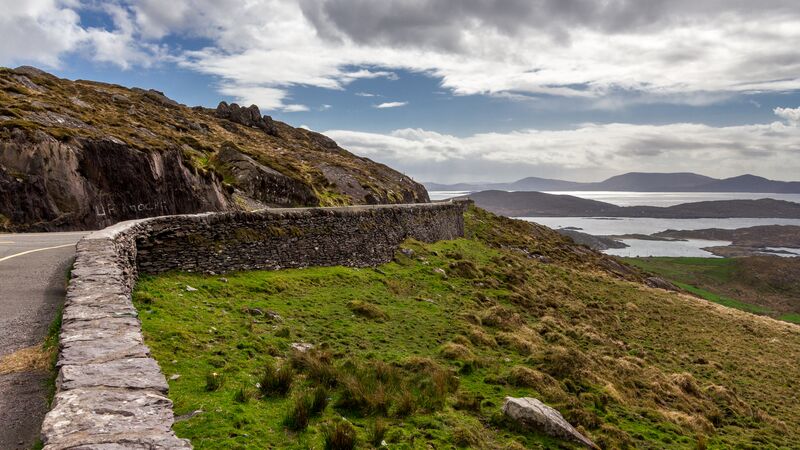
Because sometimes spinning a globe and travelling to whatever country your finger lands on just doesn’t work.
No one can say the British Isles don’t make for incredible travel destinations but what happens if you only have time to explore one country? Yes, England has the beautiful, ancient city of London with its royal family and iconic structures, but Ireland has emerald scenery that stretches for days and a fondness for Guinness you’re sure to love so which country should you actually travel to?
As much fun as pulling either one of these countries out of a hat would be, we’ve put together a guide on which country takes out the top spot when it comes to landscapes, cities, cuisine, history, and activities so you can start planning the English or Irish holiday of your dreams.
Best for landscapes
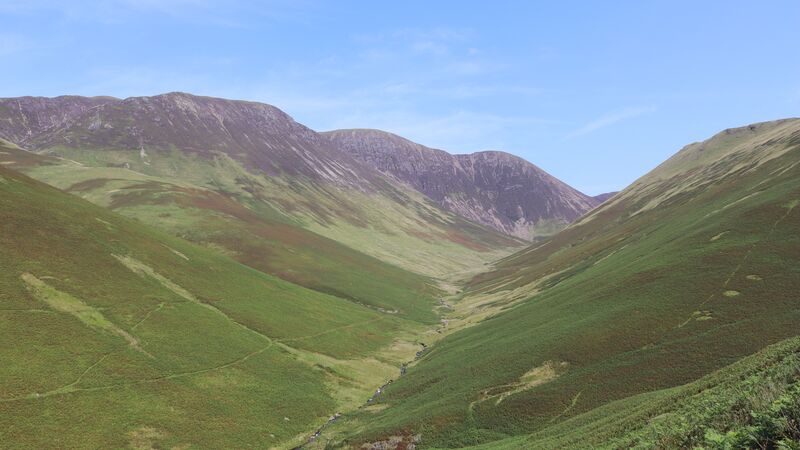
England isn’t short on beautiful places to discover, in fact, it boasts some of the best natural landscapes in all of the United Kingdom. Here us out. From the extraordinary and undeniably pretty Jurassic Coast region in Dorset to the romantic Lake District that inspired literary giants such as William Wordsworth and Beatrix Potter, you’ll easily fall in love with what lies outside England’s city walls.
And while you’re out exploring some of Mother Nature’s best work, you have to make time for a wander through the Peak District a scenic destination that encompasses the counties of Derbyshire, Cheshire, and Yorkshire, as well as England’s first national park. Your camera will thank you for it.
EMBARK ON OUR WALKING IN THE LAKE DISTRICT TOUR
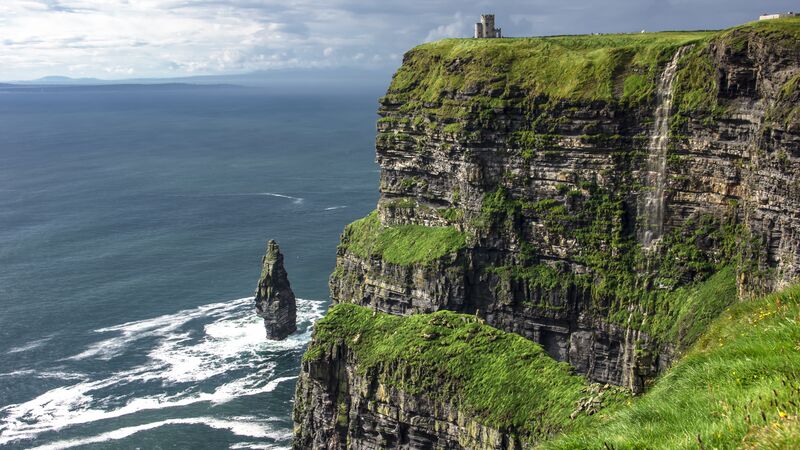
If green isn’t your favourite colour then you might have a slight problem with Ireland but when it comes to landscapes, this country is hard to beat – after all, it didn’t get its nickname as the Emerald Isle for nothing. Bursting with grassy landscapes, rolling hills, and uniquely formed cliff structures (Cliffs of Moher, we’re looking at you), you’ll never run out of beautiful things to look at and take photos of.
With natural landmarks that’ll make nature-lovers stop and swoon from the towering figures of the Twelve Bens in Connemara to the scenic views along the 130km long Wicklow Way, spending time outside in Ireland has never been easier or more enjoyable.
RELATED: SCOTLAND OR IRELAND?
Best for cities
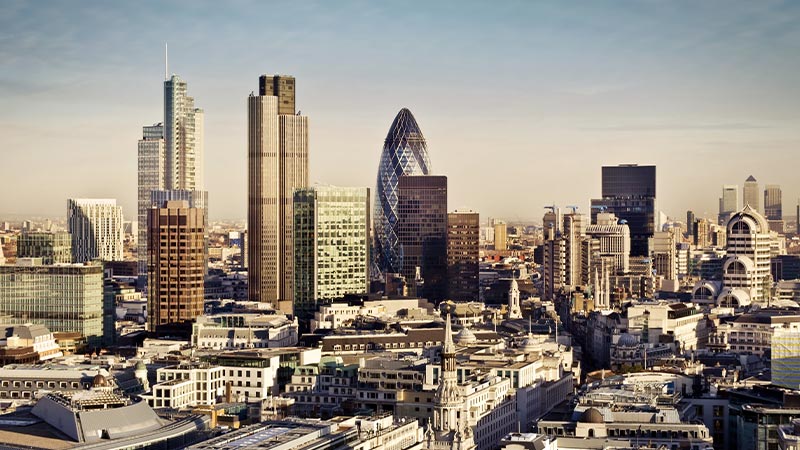
When it comes to English cities, you’d be forgiven for automatically thinking of London, but what you might not realise is that this country is actually spoilt for choice when it comes to concrete jungles. There’s Cambridge with its prestigious university and hundreds of years of history, Manchester with its mesmerising architecture and capital city feel, and York with its ancient ruins and love of sweet-tasting treats.
But we can’t forget about the breathtaking city of Bath. Affectionately known as England’s prettiest city, Bath is not only surrounded by naturally healing hot springs, but also boasts some of the best Georgian architecture you’ve ever seen. A quick wander along picturesque streets flanked by elegant townhouses and catching fleeting glimpses of mansions fit for the royal family themselves will be enough to steal your heart.
RELATED: 8 FUN THINGS TO DO ON THE RIVER THAMES
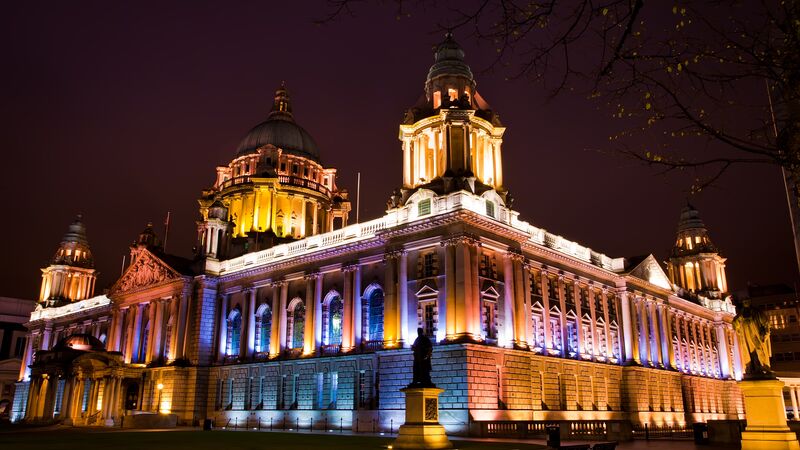
If you thought Ireland couldn’t get any more captivating, the country’s most popular magical cities – Dublin, Galway, Belfast, Limerick, and Kilkenny – are here to prove you wrong. Offering a nice contrast to Ireland’s natural beauty, these urban areas are full of historic landmarks, restaurants serving traditional food, and a certain Irish hospitality that’s guaranteed to make you feel right at home.
Wander the pebble-stoned pathways, get an up-close look at ancient buildings constructed centuries ago, and soak up as much Irish culture as possible (simply sipping on a pint of Guinness in a local pub might do the trick) in these spectacular cities for a glimpse of the real Ireland.
EXPLORE BELFAST ON OUR NORTHERN & SOUTHERN IRELAND TOUR
Best for cuisine
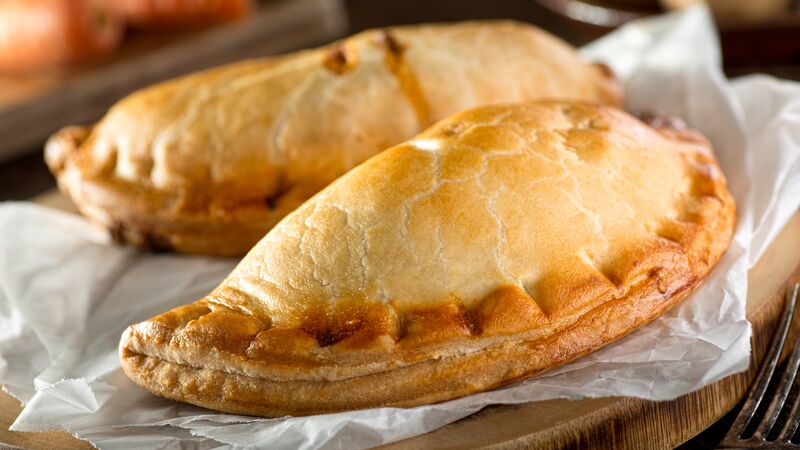
One thing England does extremely well is food, and you only have to walk into a classic pub or restaurant to see menus bursting with traditional meals your stomach is bound to love. From an old-fashioned steak and kidney pie with its tender filling and golden pastry to Cornish pasties full of peppered steak, potato, and carrot, re-fuel the right way and dig into some of England’s tastiest national dishes.

It makes sense that after all that exploring, you’d need a big, heaping plate of traditional food to help your body recharge for the adventures ahead and Ireland is one of the best destinations when it comes to pleasing your tastebuds. Ireland’s cuisine is best described using another ‘c’ word – carbs. Yep, feast on carbs, carbs, and more carbs as you eat your way through the country’s best restaurants.
Whether you fancy munching on the sometimes-sweet, sometimes-salty soda bread, can’t wait to dig into a steaming bowl of Irish stew complete with premium beef and fresh root vegetables, or you’re salivating at the thought of tasting some potato pancakes (also known as boxty), the cuisine in Ireland is sure to satisfy even the most insatiable of cravings. Don’t forget to wash your meal down with a pint of Guinness for the true Irish feasting experience.
DRINK GUINNESS ON OUR IRELAND: KILKENNY & SURROUNDS TOURS
Best for history
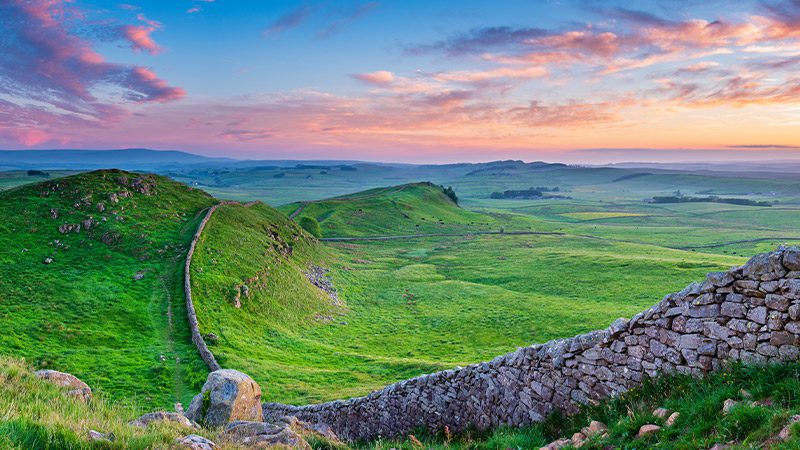
You’d think that a country that’s approximately 800,000 years old would have a lot of history, and you’d be right. While you can go pretty much anywhere and discover an ancient building or two and the fascinating story that goes with them, one of the best places to go in England if you’re craving some history, is Stonehenge.
Not only is it one of the most iconic and instantly recognizable sites but it’s also shrouded in mystery as no one really knows why it was built in the first place.
If that’s not enough history for you then you could always check out Hadrian’s Wall with its dramatic Roman ruins – a staggeringly 84-mile-long procession of abandoned garrisons, forts, towers, and milecastles. Guaranteed to transport you back over 2000 years, witnessing this unique and ancient example of control and order up close is one for the bucket list.
RELATED: 6 UNMISSABLE SIGHTS ALONG THE HADRIAN’S WALL
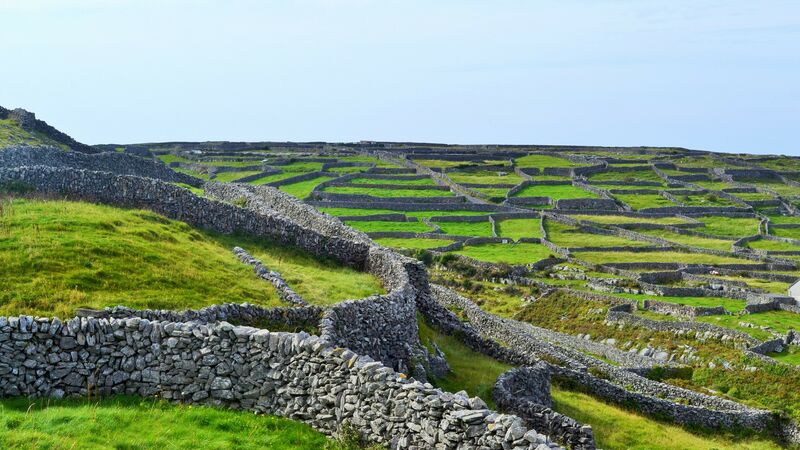
There’s fascinating history wherever you turn in Ireland from ancient castle ruins to mythologies and legends thousands of years in the making. Whether you want to wander the grounds of Glendalough, a monastic site founded in the 6th century by St. Kevin, and marvel at the roofless structure of the Cathedral of St. Peter and Paul or take in the extraordinary sight of the Rock of Cashel as it sits atop a mountain of grey limestone, this country’s riveting past is bound to sweep you away.
LEARN ABOUT HISTORY ON OUR IRELAND: RING OF KERRY & DINGLE PENINSULA TOUR
The verdict
The decision of whether you should visit England or Ireland is a tough one, especially since both countries offer plenty of cultures to learn about, traditional food to eat, and beautiful landscapes to explore. But, if we simply had to choose one, we’d go with Ireland by the length of a tiny leprechaun.
VISIT THESE FASCINATING NATIONS ON OUR UNITED KINGDOM TOURS
Feeling inspired?
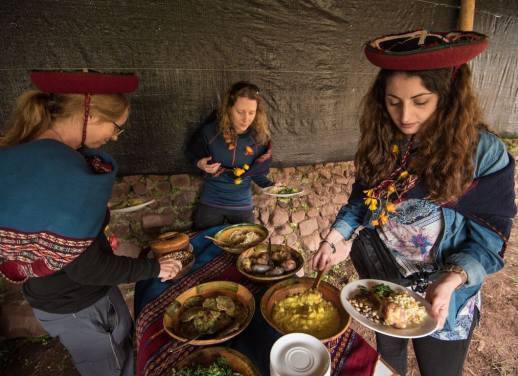
Kate Gazzard
When I was 11, my parents asked me whether I wanted a pool for the house or a trip to Fiji. I chose Fiji, and I've made travelling as much as I can a priority ever since.
You might also like
All aboard the rail renaissance: 7 reasons to..., the undeniable benefits of slow travel, explore these 7 tea rituals from around the..., why travellers are choosing the galapagos off-season, over 20 years of the intrepid foundation: a..., tips and hacks for train travel in europe, why train travel is the one experience you..., everything you need to know about a night..., mind your manners: dining etiquette around the world, 5 places to escape the crowds in italy..., is australia safe everything you need to know.
- Travel Planning Guide
A Travel Price Comparison for Families, Couples, and Backpackers the UK vs. Ireland for Museums & Attractions, Families, Food, and Nightlife

- Pros & Cons
- Museums & Attractions
- Culture & History
- Small Towns
- Christmas Markets
- National Parks
- Adventure & Outdoor Activities
- Watersports
- Outdoor Activities
- Backpackers
- Transportation
- More time in the UK or Ireland?
- Which is Cheaper, the UK or Ireland?
- What are the cheapest places in the UK or Ireland?
- How can you save money in the UK or Ireland?
- When to Visit the UK or Ireland?
- Weather: the UK vs. Ireland
Should you visit the United Kingdom or Ireland?
Which is cheaper to visit which is more expensive for vacation.
If you're trying to decide where to visit between the UK or Ireland, this travel comparison, which includes costs, can help. The overall cost of travel is usually a consideration when deciding where to go next, and the cost comparison down below can help you decide based on the average prices from other travelers along with your own travel budget.
We'll start with a quick overview, and below we will go into all of the details.
With jaw-droppingly beautiful countryside, award-winning beaches and a whole lot of character, it is no wonder that England tops everyone's must-visit bucket list. In fact, England, Scotland, Wales and the Offshore Islands all offer great holiday destinations with something for everyone, whether you are travelling alone, as a couple, or with your family. You won't find anywhere as peaceful as the English countryside and its beautiful lakes will take your breath away. Rocky coasts, castles, green hills and charming pubs, all that is England; without forgetting energetic, majestic and ambitious London, steeped in iconic landmarks, world-class museums and royal parks and one of the world's greatest cities. The UK's cities and towns also have a lot to offer visitors, from the hip, indie scene of Manchester to the amazing Balti food of Birmingham, from the dreaming spires of Oxford and medieval passageways of York to the lively art scenes of Glasgow. It may be small in size, but England is rich in tradition, complex in culture, endlessly diverse and has a lot to offer when it comes to fascinating history. There are lots of unique historic buildings that you can visit, including the awe-inspiring Tower of London, the atmospheric ruins of ancient castles, prehistoric Stonehenge or the Victorian village of Saltaire. The United Kingdom offers lots of delicious food for everyone. So you shouldn't have any issues whatsoever when it comes to finding cuisine that you will thoroughly enjoy.
There's a lot more to Ireland than Guinness and pubs, although for some, this may be the best part. Ireland has a rich history which dates back to prehistoric times. Its many museums, magnificent houses and historical sites make it a top destination for ardent historians. With its scene-stealing natural beauty and multitude of things to see and do, Ireland is a dream tourist destination. Looking for cliffs, beaches, national parks, forests and 100 shades of green? Ireland has it all. Green is the islands emblematic color. From vast mountains to pebbly beaches, rural bog lands to inland waterways, tourists can sample a feast of natural attractions. Located in the Burren region in County Clare, the Cliffs of Moher are said to be the biggest natural tourist attraction in Ireland drawing over million people each year. The view from the 200 metre high cliffs is breathtaking and many that visited it will agree that this is a must-visit in Ireland. A visit to Ireland's buzzing capital city goes without saying. Dublin is a super friendly city with a youthful, creative vibe. It has free museums to explore, architecture to gawp at and a more than lively pub scene. If you go during St Patrick's Day, an Irish festival celebrated and known around the whole world, your stay will be unforgettable. The biggest festival is held, of course, in Dublin, and the celebration lasts for several days. Finally, don't leave Ireland without trying their shellfish, Irish stew, colcannon and champ, boiled bacon and cabbage, smoked salmon, black and white pudding, coddle, bambrack and soda bread. You might not think of Ireland as a Gourmet Destination, but the food here is world class.
United Kingdom
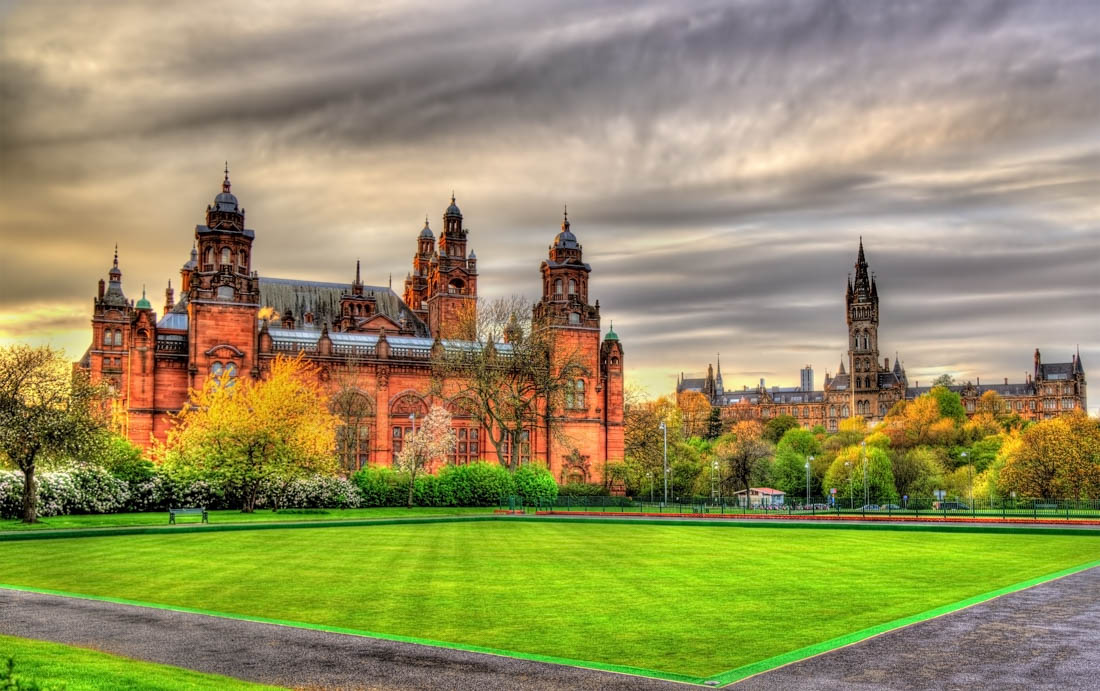
The UK is a beautiful, historic, and traditional country. The beauty of this spot is also one of the main reasons why visitors come. Visitors also love the history and culture, nightlife, live music, and food.
The United Kingdom, also commonly referred to as Great Britain, offers visitors a diverse set of experiences and attractions throughout the large cities, small town, and countryside. Consisting of England, Scotland, Wales, and Northern Ireland, travelers can explore a deep and rich history and culture along with modern attractions and beautiful, diverse landscapes. From cities such as London, Edinburgh, Cardiff, and Belfast, it's easy to get out into the smaller towns and countryside to explore the mountains, coastline, and agricultural regions of this island nation.
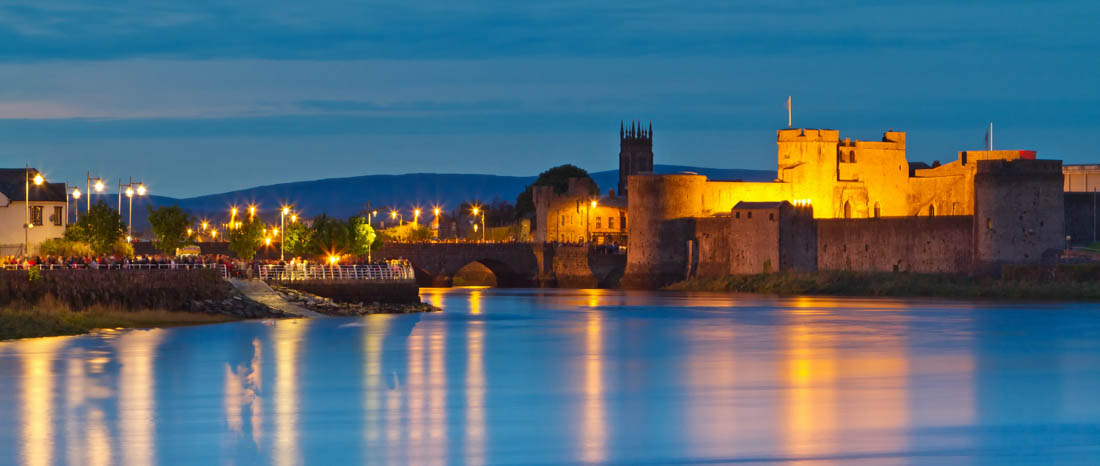
Ireland is a cultural, proud, and green country. The famous beauty of this place is one of the main draws. Other popular activities here include museums, adventure travel, national parks, and history and culture.
Ireland is a unique country with a deep historic culture, a beautiful countryside with rolling green hills, exciting cities, and friendly people. You'll find good food, interesting natural landscapes such as the Giant's Causeway, terrific hikes through the countryside, surfing at the beach, and cultural experiences in the cities.
UK and Ireland: Pros and Cons
- Popular museums and historical sights
- Great culture, history, and arts
- Numerous theater shows
- Good music scene
- Good for hiking
- Great road trips
- Family-friendly
- Good for couples and romance
- Good for backpackers and budget travelers
- Good for students
- Impressive beauty
- Less attractive beach
- Not as many national parks
- Less adventure activities
- Beautiful national parks
- Not as many big cities
- Less theater options
- Less active music scene
- Less popular for students
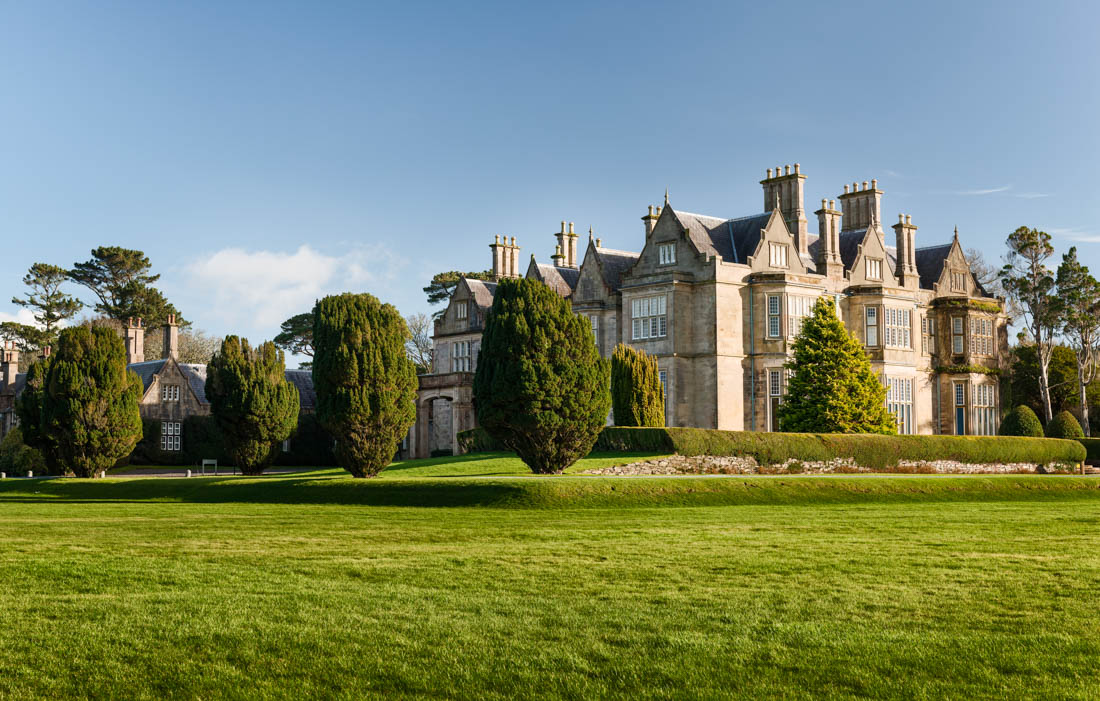
How is the UK different from Ireland?
Which is better for a holiday.
Below we will examine the differences and similarities between the UK and Ireland. With this information, you can decide for yourself which place is better for your next trip.
Are the Museums and Historical Sights Better in the UK or Ireland?
Both Ireland and The UK offer a variety of museums and places of interest, but The UK generally has more to choose from.
The museums and tourist attractions in The UK are world-renowned. Visitors will find some terrific museums not just in London, but all over the country. For starters, the British Museum is world famous, but York also has the Railway Museum. The smaller town of Bath has its Baths, and you'll find plenty of art galleries all over such as Kelvingrove in Glasgow or the McManus in Dundee.
London : The city has so many iconic sights that we can't list them all, but some of the most famous include the Tower of London, Buckingham Palace, St. Paul's Cathedral, Westminster Abbey, Big Ben, and the British Museum. You can fill many days exploring the treasures found at each of the venues.
Edinburgh : The most famous sights include the Edinburgh Castle, the Palace of Holyroodhouse, and the National Museum of Scotland. There are also kid-friendly museums like Camera Obscura.
Bath : The main draw to Bath is the rich history and most sights are focused on the area's spa city past. The Roman Baths are a highlight of a trip to the city, but other not to be missed places include Bath Abbey, the Royal Crescent, and Pulteney Bridge.
You'll find a good number of museums and monuments packed into Ireland. Visitors will find a variety types of museums all across the country. History, science, art, and kid-friendly museums are everywhere, showcasing the culture, history, and life of the Irish people. A few of the best in Dublin are the Little Museum, the National Museum of Ireland with its multiple branches, the Irish Whiskey Museum, the Kilmainham Gaol, Dublinia, and the Jeanie Johnston Tall Ship and Famine Museum, among others. If you're visiting Galway, check out the Galway City Museum, Lynch's Castle, Monkey Business Children's Museum, or the Fisheries Watchtower Museum. Also, in Cork, the Cork City Gaol and the Crawford Art Gallery are visitor favorites, although there are many more.
Is the UK or Ireland Better for Culture, Arts, and History?
The UK and Ireland both offer great history and culture to travelers.
The UK offers world-famous historcal and cultural sights and attractions. This is one of the main reasons why so many people come here every year. Thousands of years of history is on display all over the U.K. With historical destinations such as London, Stonehenge, Edinburgh, Cardiff, numerous castles, and historical small towns, history lovers will find plenty to do here.
See also Free and Cheap Things To Do in Belfast , and The Castles of Scotland .
With a long list of famous historical and cultural attractions, Ireland brings in many visitors. Plenty of historical attractions are popular destinations for visitors, especially the castles, small historic towns, and huge monuments. At the Rock of Cashel, you can see the ruins of this historic and beautiful castle from the 12th century. Reginald’s Tower in Waterford is said to be the oldest building still standing in Ireland, and can be toured while also exploring the surrounding city. Glendalough is the home of a monastery and famous tower, as well as stunning natural landscapes. And at Newgrange, you can see this ancient 5000 year old megalithic cemetery. The Blarney Castle is home of the Blarney Stone, and is one of the most famous sites in the country. In Dublin, don't miss the Dublin Castle, the St. Patrick's Cathedral, or the Kilmainham Gaol, all of which showcase a selected period of Irish history. No matter which area of the country you visit, Ireland offers historic sights and attractions of all types for every age.
Is the UK or Ireland Better for Big City Activities?
The UK is considered to have more larger cities than Ireland.
Travelers will also find plenty of sights and attractions in the big cities of The UK that attract lots of visitors. London is the first name that comes to mind when thinking of large cities in Great Britain, and rightly so as this huge global city attracts visitors from everywhere because of its history, museums, theatre, nightlife, food, and monuments. After London, the U.K. has many large cities with their own atmosphere and cultural experiences to offer. Liverpool, Manchester, Cardiff, Edinburgh, and Belfast all have terrific attractions, nightlife, and cuisine for visitors.
See also 1 Day in London On A Budget , and The Best Things to Do in Glasgow .
Ireland also has some big cities with many activities. Dublin and Cork are the largest cities in Ireland, followed by Limerick and Galway, but even these last two have small populations compared to other cities in Europe. In Dublin you can find plenty of restaurants, cafes, museums, universities, and historic sights. Outside of this city, it's hard to find the same urban vibe. The rest of the country has smaller cities and towns and plenty of rural areas with stunning landscapes, but lacks the large city environments.
Is the UK or Ireland Better for Small Towns and Villages?
Ireland offers more villages and small towns to explore than The UK.
Ireland also offers a huge number of beautiful small towns with plenty of sights and activities. A few of the smaller towns in Ireland are some of the country's most popular travel destinations. Kilkenny has a nearby castle, abbey, a gorgeous cathedral, and a historic medieval area of town. Kinsale has a quaint harbor and colorful houses. Tralee on the southern coast has beautiful seaside views and stunning cliffs. And the ring of Kerry offers even more stunning coastal views and small towns such as Portmagee. Exploring the small towns of Ireland is an absolute requirement for any itinerary, as here you'll find the true local culture and history of the island.
See also 10 Easy and Ambitious Day Trips from Dublin Ireland .
The UK is a great destination to visit small towns and villages just waiting to be explored. Some of the most popular and scenic small towns in England include St. Ives, Bath, Castle Combe, Bibury, and Shaftesbury. And in Scotland, don't miss Tobermory, Anstruther, Linlithgow, St. Andrews, and others. In Wales, you'll find beautiful scenery in Tenby, Solva, Rhossili, and others. Outside of Belfast in Northern Ireland, you'll find small town charm in Bangor, Kilkeel, and Portstewart. All of these towns across the nation offer that traditional quaintness that visitors seek from a typical town in the countryside. You'll find pubs, historic architecture, the occasional ruins of castles and churches, farms, and more.
Is the UK or Ireland Better for Theater?
With more venues to choose from, The UK is more regarded as a theater destination.
The theater and performance venues in The UK draw crowds from around the world. The London theatre scene is world famous, and when visiting, seeing a show is a must. But venture further into the rest of the country for even more. Stratford-upon-Avon is the birthplace of Shakespeare, after all. You'll find even more theatre experiences in Manchester, Edinburgh, Brighton, Cardiff, and more.
London : The West End theater district is where you'll find the most popular musicals. Famous theaters include Apollo Theatre, Palace Theatre, and Piccadilly Theatre. There are often Wednesday matinees that are a bit cheaper than the evening shows. You may also be able to get discounted last minute tickets if you're visiting during the less touristy times.
Stratford-Upon-Avon : Shakespeare enthusiasts must check out a Shakespeare play at the Royal Shakespeare Theatre. There are often tickets available the day of for a reduced price.
Visitors can also check out a show in Ireland. Local theaters with community productions can be found in many smaller cities. In Dublin, if you're looking for a show, check out the Abbey Theatre, the Gaiety Theatre, the Smock Alley Theatre, or the Olympia Theatre. Elsewhere in Ireland, make sure to visit the National Folk Theatre in Kerry (Siamsa Tíre), or the Druid Theatre in Galway.
Is the Food Better in the UK or Ireland? Which Country Has the Best Restaurants?
Foodies will appreciated the dining options available in The UK a bit more than Ireland.
The UK has a huge number of terrific restaurants. In the last few decades, the food scene in Great Britain has taken off as world-class chefs have opened restaurants featuring menus from all corners of the globe. When visiting the U.K., you'll be pleasantly surprised by the quality and creativity of the food. That being said, traditional British food itself is not particularly famous. Fish and Chips, meat pies, black pudding, bangers and mash, and "toad in the hole" (sausage in batter) tend to be first on people's lists of interesting foods to try when visiting. But they are not the final say in modern British cuisine anymore.
York : Meat pies, fudge, and fish and chips are just some of the culinary experiences you'll find here. The Shambles Market has vendors that sell a wide variety of cuisines. There are also food trucks throughout town that offer affordable and delicious meal options.
There are plenty of up and coming restaurants around Ireland. Traditional Irish foods can be found at many restaurants around the country. One of the most popular dishes includes various forms of Irish stew that use meat, potatoes, and vegetables. Shepherd's Pie takes this stew and adds a layer of mashed potatoes to the top. Colcannon and Champ is a form of mashed potatoes that mixes in cabbage, onions, and sometimes bacon. If you're tired of potatoes, salmon in various recipes is also common and popular. Also try the black and white pudding, which is actually blood sausage and not dessert. Other popular dishes include vegetables cooked into stews with local herbs. Of course, the local beer is quite popular, too. And don't miss the more interesting forms of Irish soda bread as well.
Kinsale : For such a small town, it really has an impressive food scene and many people consider it to be the culinary capital of Ireland. The food scene includes Michelin starred restaurants and local cafes.
Is the UK or Ireland Better for Nightlife?
For nightlife, head to The UK instead of Ireland.
The nightlife in The UK has something for everybody. London is one of the most popular cities in the world for nightlife. From bars and clubs to theatre shows, the activity in the city is always pulsing. Liverpool, Manchester, Edinburgh, Belfast, and other large cities also have plenty of nightlife options, too, with active nightclubs, varied music scenes, and theatre productions.
London : Some of the best neighborhoods for nightlife are Camden, West End, Soho, and Shoreditch. There are many festivals, concerts, and shows worth checking out and the nightlife scene is diverse enough that there really is something for everyone.
Glasgow : The city has some of the best nightlife in the entire country. There are clubs, bars, techno warehouses and more. Some of the best clubs include Sub Club, The Berkeley Suite, and The Garage.
See also London's Party Hostels .
If you're looking for night time activities Ireland has a few options to choose from. Dublin and Galway, as the two largest cities, are the obvious choices for nightlife. Dublin claims to be one of the party capitals of Europe, and offers a variety of venues from bars and pubs to undergrounds nightclubs, as well as theater, fine dining options, and relaxed bars and cafes where you can have a drink with friends. Galway has a similar scene with a mix of bars, pubs, and nightclubs, many with live music and plenty of dancing. In Cork, much of the nightlife scene is dominated by the student population of the area, as large universities are nearby. Check out SoHo and the other spots on the Grand Parade. Plenty of other towns and smaller cities offer an array of pubs, bars, and clubs, too.
Dublin : Temple Bar is where you'll find the greatest concentration of pubs and nightlife. The city is among the friendliest and most welcoming, and this is seen even in the vibe around town at night.
Is the UK or Ireland Better for Music?
The UK is more popular choice to experience the music scene.
The UK has a thriving music scene. London is the obvious choice if you're looking for live music, as it hosts nightclubs, bars, theatre shows, DJ events, and more. But other cities around Great Britain also have their own music scenes, especially Liverpool, Manchester, and Belfast. From family-friendly theatre productions to raving dance-filled nightclubs to intimate venues, there is something musical for everyone.
London : Famous music venues include Dominion Theatre, the Roundhouse, and Dublin Castle.
Birmingham : The city has long been a haven for musical creativity, and its influence over the global music scene is apparent. Popular music venues around town include Ghetto Golf, Digbeth Dining Club, and the Sunflower Lounge.
Glasgow : Known to some as "the city of music", you'll find a wide range of music venues, live shows, festivals, and even a great underground music scene.
Liverpool : Known as the birthplace of the Beatles, the city has been established as a rock and pop capital since the 1950s.
Edinburgh : In addition to a wide range of live music venues, there are also a number of music festivals held in town.
While it's not known for it's music scene, Ireland has some options for casual listeners. Dublin has many pubs, bars, and clubs featuring a variety of live music. Some of the places showcase new artists and popular dance music, while others host traditional Irish music. Galway, Cork, and other cities are similar in that many pubs host local artists as well as touring musicians. The larger cities also host touring concerts as you would expect in any large city, too. Generally, seeing live music is easy and accessible in Ireland, and quite fun if you're looking for something to do in the evenings.
Is the UK or Ireland Better for Beaches?
Both The UK and Ireland have great beaches worth visiting.
The beach in The UK is worth checking out. The southern coastline of Britain has a variety of beach areas, some with wide sandy beaches lined with restaurants, boardwalk shops, and other fun activities. While the water is generally cold, the summer months are still quite popular. Some of the more visited spots include St. Ives, Brighton, Newquay, Bournemouth, and West Wittering. This is just a few, and many more areas are favorites with locals, too.
Ireland is a good spot to see the beach. With a huge amount of coastline, this island nation has plenty of beaches. Some are in protected coves, while others are more exposed and have large waves popular with surfers. Despite the colder temperatures, the beaches here can still be fun because the natural scenery is beautiful. Some of the beaches are in natural coves surrounded by cliffs, rocks, and epic views. Swimming is very possible and popular in the summer months with locals and visitors alike. A few of the most popular beach areas include Inchydoney Beach in County Cork, Dog's Bay near Galway, Strandhill near Sligo, Silver Strand in Country Donegal, and Portmarnock Beach near Dublin. However, there are many more to explore.
Is the Shopping Better in the UK or Ireland?
The UK often provides a better shopping experience than Ireland.
The UK is well-known for its shopping. London offers plenty of shopping experiences all over the city, and has various neighborhoods with different styles, trends, and vibes. Other large cities also have their own shopping districts where locals and travelers alike can find anything they want from clothes to gifts to locals artisan crafts.
London : With so much iconic shopping around town, it's hard to decide where to go. Head to Oxford Street, Regent Street, or Piccadilly Circus for a quintessential British shopping experience.
Plenty of visitors enjoy shopping while in Ireland. While the larger cities and towns such as Dublin and Galway have more variety of shops such as clothing boutiques, souvenir shops, and local galleries, even the smallest towns have nice shopping options. Some of the more popular local arts and crafts for purchase include tweed fabrics in Donegal, Aran Wool clothing items, and hand-crafted pottery. In Dublin, visitors can find several large shopping malls such as Dundram Centre, and more shops in George's Street Arcade, Liberty Market, and Cow's Lane.
Is the UK or Ireland Better for Christmas?
The Christmas season is more busy in The UK than Ireland.
The UK is a very popular destination during Christmas. While London is an easy choice for the holiday season, as it decorates major landmarks and offers fun winter activities, plenty of other locations around the country are also worth visiting. Edinburgh has a festive atmosphere as well with large trees, festivities, and decorations. Bath, Cardiff, York, and Bournemouth all put on their own activities, too.
London : There's Hyde Park Winter Wonderland, outdoor ice skating, and beautiful Christmas lights throughout the city. You can also listen to Christmas Carols in Trafalgar Square or see a classic Christmas show.
Plenty of visitors enjoy Christmas activities while in Ireland. Dublin, Galway, Cork, and many of the other towns and cities put on huge light displays during the holidays. The public squares and town centers have Christmas trees, markets, festivals, and other activities. There's even a polar swimming plunge in Dublin. Some of the famous castles and manor houses also have holiday decorations and festivities which bring in large crowds. The local pubs in many small towns become the center of activity as people gather in the warm and brightly decorated establishments. Also, many of the hotels and smaller B&B's decorate their grounds and have special dinners and parties. For the best Christmas markets, head to Cork or Galway, or even Belfast in Northern Ireland.
Is the UK or Ireland Better for Christmas Markets?
The UK provides a more festive Christmas market atmosphere than Ireland.
The UK has some Christmas markets worth visiting during the holidays. Visitors over the holidays can find Christmas markets in London, Bath, Bournemouth, Cardiff, and Edinburgh, among others. In addition to shopping, many of these markets offer fun activities, ice skating, shows, Santa encounters, and delicious holiday cuisine.
London : The city has many Christmas markets. There is Winter Wonderland Christmas market, Southbank Centre Winter Market, and Selfridges Christmas Market, among many others.
Ireland has some Christmas markets for those that seek them out. The best Christmas markets can be found in Cork and Galway, although many other small towns offer fun festivities, too. Dublin offers a few different holiday markets around the city, such as at Dublin Castle and Guiness Storehouse.
Is the UK or Ireland Better for Hiking?
The UK provides a better hiking experience than Ireland.
Many visitors go to The UK for the hiking trails. Hiking and "walks" are very popular ways to experience and explore the beautiful landscapes of the U.K., as a number of long routes weave their way through the countryside and along the coastline. It's quite popular to do a multi-day walk with stopovers in quaint towns, especially as many of these walks are on routes with easy elevation and clearly defined paths with good signs. Some of the more popular routes include the Hadrian’s Wall Path, The Cleveland Way, Norfolk Coast Path, and Cotswold Way. If it's more strenuous mountain hiking that you're after, definitely visit one of the national park areas such as Cairngorms, Peak District, Lake District, or Snowdonia, as they all offer mountain trails with gorgeous scenery.
Isle of Skye : Hikes on the island range from family-friendly to some of the most challenging in Scotland. The setting is dramatic and beautiful and the hikes are a varied as the landscape. Some of the most popular hikes include the Fairy Pools, the Old Man of Storr, Neist Point Lighthouse, and the Quiraing.
Snowdonia National Park : There are approximately 1,500 miles of walking paths and hiking trails in the area. You can hike to waterfalls, along beaches, or to the top of Mt. Snowden. Aber Falls is a popular trail or you could explore lakes and try to see wild ponies along the Llyn Idwal Trail. For a particularly strenuous and adventurous trail, head to Glyder Fawr or The Snowdon Horseshoe Circular Walk.
Outer Hebrides : The islands offer some of the area's best hiking. You'll pass by stunning beaches, see unique wildlife, and enjoy a remote and tranquil setting. Follow the Hebridean Way, which covers the full length of the archipelago. It spans 156 miles and goes through 10 islands with 2 ferry trips.
Lake District National Park : There's a huge selection of hikes to choose from in the area, ranging from easy strolls to more strenuous climbs. The park offers some of the best hiking in the country and you can spend days exploring. Some of the favorite hikes in the area include Scafell Pike, Helvellyn, and Catbells.
Plenty of visitors go hiking around Ireland. The rolling mountains and beautiful green countryside provide stunning hikes in all parts of the country. From the cliffside walks with epic views to the peaks in the interior of the island, there's a trail for everyone. Some of the most popular routes include the treks around Glendalough where you'll see the Spinc cliffs, waterfalls, and distant views of the lake. If you're looking for a mountain to hike, Diamond Hill in County Galway, Carrauntoohil in Kerry, or Slieve Gullion all provide stunning views, physical challenges, and plenty of wilderness opportunities.
Connemara : The landscape is considered to be some of the most beautiful in all of Ireland and there are many walks and hikes that let you experience it. Some of the best hikes are The Cong and Clonbur Forest Trail, the Claddaghduff Quay to Omey Island Walk, and Mount Gable Walk.
Is the UK or Ireland Better for its National Parks?
Ireland usually beats out The UK for its wide range of national parks.
Many visitors go to Ireland to see the national parks. The 6 national parks here offer stunning beauty and a variety of sights and attractions both within the parks and nearby. Five of the parks are along the western coast, and it might be best if you had your own vehicle to see some of all of them. Killarney National Park is part of the Ring of Kerry and was the first park. You can find historic manor houses, the largest mountain in the country, and a variety of wildlife. Wicklow Mountains National Park is on the eastern side, and in the area you'll find Powerscourt Gardens, Glendalough with its famous round tower, and the beautiful Glenmacnass Waterfall. In all of the parks, you'll find hiking trails, epic views, camping, castles, gardens, local wildlife, and other activities such as bird watching, horseback riding, and more.
The UK is a good destination to visit the national parks. A few of the most popular national parks in the U.K. include Snowdonia, Peak District, Lake District, Cairngorms, and Loch Lamond. Most of these parks offer beautiful mountain scenery, rivers, camping, lakes, and outdoor experiences for the whole family.
Is the UK or Ireland Better for Adventure Travel?
Ireland generally offers more adventure travel options for travelers than The UK.
Ireland has some adventurous travel experiences that often attract visitors. Some of the most popular adventure activities here are sea kayaking, mountain biking, horseback riding, orienteering, hiking, caving, and more. Many of these activities are found in the countryside and coastal areas of the country, or around the 6 national parks. It's common for travelers to book a single-day tour to do some of these activities, as the guides or outfitter companies make it easy and accessible.
The UK is a good destination for those who seek adventure travel experiences, as there are a few options to explore. Some of the more popular areas to participate in adventure sports are in the more wilderness regions and national parks of the nation. Zip lines, rock climbing, kayaking, paragliding, river rafting, and canyoning are all popular in the mountainous areas. Surfing is sometimes found along the coast, too.
Is the UK or Ireland Better for Visiting the Mountains?
Both The UK and Ireland offer a similar amount of great mountain activities for visitors.
The UK does have some mountain areas to explore. Many of the national parks in Britain offer gorgeous mountain scenery with hiking, horseback riding, adventure sports, camping, and more. Snowdonia, Peak District, Lake District, Cairngorms, and other parks have plenty of mountain adventures waiting for visitors. Also, the northern areas of Scotland are rugged and mountainous. The Hebrides for example, offer amazing natural landscapes where the mountains meet the sea to the north.
Ireland is a good destination to visit the mountains, as there are some fun activities. While not too high in elevation, the mountains in Ireland still offer great views, terrific hiking opportunities, and plenty of outdoor activities such as camping, horseback riding, and more. The highest peaks are found in the MacGillycuddy Reeks range in County Kerry, and visitors here will find plenty of natural beauty along with outdoor activities and hiking trails. Wicklow Mountains National Park and the surrounding area is another very popular destination as it also combines mountain views with historical sights, hiking, waterfalls, and more. Killarney National Park is another area worth visiting due to the beauty of the lakes and mountains.
Is the UK or Ireland Better for Watersports?
While The UK and Ireland both have plenty of watersports, overall Ireland is considered to be better for travelers seeking these activities.
Ireland has some watersports activities that attract many visitors. With a huge stretch of coastline, many visitors here participate in a variety of activities despite the relatively cooler weather. As long as you have the proper equipment for the activity, there's no reason why you can't enjoy the stunning beauty of the water. Surfing is very popular on the beaches, as the waves can be consistent and strong in many areas. Kayaking both on the coast and inland is also a great way to see Ireland from a different angle. Stand-up paddle boarding is another good option for areas with calmer waters. And many of the bays and harbors have clear waters with unique marine life, which makes wild swimming , scuba diving, and snorkeling a fun activity after putting on a thick wetsuit. Wind surfing and kite surfing are also possible. As with many other activities, you'll find plenty of surf shops and tour providers that can take you to the right places with the right equipment.
The UK is a good destination to participate in watersports, as there are some fun activities. Surfing is popular in some areas of the coastline such as Cornwall and in Snowdonia National Park. It's also possible to find a few river rafting outfitters around the country, too. Kayaking, fishing, and boating are all quite popular along the shore, too.
Is the UK or Ireland Better for Outdoor Activities?
While The UK and Ireland both have plenty of outdoor activities, overall Ireland is considered to be better for travelers seeking outdoor adventures.
The outdoor activities and experiences of Ireland attract many visitors. As Ireland is a fairly sparsely populated country with wide open spaces and beautiful landscapes, visitors will find plenty of outdoor activities of all types. The national parks are a good place to start, as you'll find hiking, camping, horseback riding, climbing, and more. And along the lengthy coastline, visitors can experience kayaking, surfing, swimming, hiking along the cliffs, and perusing gardens and castles. Visiting farms and the other agricultural regions are also quite popular. There's no shortage of outdoor activities in Ireland, so make them part of your itinerary.
The outdoor activities and attractions of The UK are worth exploring. Outdoor activities in Great Britain include hiking, horseback riding, kayaking, adventure sports, camping, and more. It's easy and accessible to get out into nature here from the big cities, and a diverse array of activities can be found.
Is the UK or Ireland Better for a Road Trip?
The UK and Ireland both offer a wide array of great road trip possibilities for your next trip.
Taking a road trip through The UK is very good way to see the countryside and smaller destinations. The roads in the U.K. are great, and with plenty of small villages, national park areas, seaside destinations, and historical sites, a road trip is a great way to see the country.
Ireland is an extremely popular destination for those that want to take a road trip. The numerous small towns, natural scenic spots, castles, agricultural areas, and other out-of-the-way places make Ireland a terrific place for a road trip. In fact, in many ways it's easier to get around this country by car than with public transit if you're planning to visit many of these smaller sights and attractions. Many visitors make a large loop around the country from Dublin, stopping off at cliffside viewpoints, beaches, castles, small towns, and national park areas with mountains and hiking. The Ring of Kerry is a very busy area for a road trip for obvious reasons - it combines natural beauty with historical towns. The Dingle peninsula is another popular drive for similar reasons. Rental cars are generally easy to hire in Dublin or Galway, so planning a road trip through Ireland is quite easy.
Is the UK or Ireland Better for Families?
The UK and Ireland are both great destinations for the whole family.
The UK is an amazing family-friendly country to visit. From the big cities to the countryside, if you're traveling with kids you'll find something great to do. London has family-friendly museums and attractions such as science museums, the Tower of London, and amusement parks. Plenty of beach resort areas are found along the coastline, too, such as in Blackpool, Cornwall, the Isle of Wight, or Paignton. Head north to Snowdonia for hiking and watersports, or to Scotland for the lakes, historic railways, and castles. Kids of all ages, and parents also will love if.
London : Whether you do a Harry Potter Tour, take a ride on the London Eye, or enjoy afternoon tea, there are plenty of activities for kids around town. The Harry Potter Studio Tour is fun for everyone, but should be booked well in advance as it sells out. Theatre enthusiasts will enjoy catching a musical in West End and sampling dim sum or a hot pot in Chinatown. There are often Wednesday matinee showings that are perfect for kids with early bedtimes.
York : The city does an amazing job bringing history to life in a way that kids will enjoy. The JORVIK Viking Centre transports visitors back in time and introduces them to a fully immersive viking experience. The York Dungeon is great for older kids as long as they don't scare easily. Actors and special effects offer a terrifying and entertaining visit through a York dungeon. Harry Potter fans will enjoy exploring the potion shops and broomstick stores along the iconic Shambles, which is said to be an inspiration for J.K. Rowling's Diagon Alley.
Ireland is an extremely popular country to visit for families. Long cliff walks, castles, stunning beaches, gardens, lighthouses, and terrific museums are all some of the best things to do with families in Ireland. In Dublin, you'll find the Imaginosity Childrens Museum, the Dublin Zoo, the Natural History Museum, and Dublin Castle to name a few. Not far from Dublin you can find more castles, the Medieval Museum in Waterford, and Viking history. On the west coast, don't miss the cliffs of Moher, with their epic views, or the ancient stones of the Burren. And the small towns of the Ring of Kerry and Dingle Peninsula are fun for everyone, too.
Is the UK or Ireland Better for Couples?
The UK and Ireland are both great to visit as a couple.
The UK is a good country for couples to visit. Plenty of destinations in Great Britain are great for couples. London for starters has many nice hotels, restaurants, and romantic spots around town. Or, head to the countryside of Scotland or Wales for castles, beautiful natural scenery, lakes, and more. If you're looking for an active trip, check out some of the national park or wilderness areas such as Lake District, Snowdonia, or Cairngorms. Also, many of the beach destinations have nice resort areas for couples, too.
London : With every type of entertainment that you can imagine, this city is the ultimate couple's getaway. There are world class musicals, evening concerts, and restaurants of every style, cuisine, and budget. It's easy for couples to fill days in this vibrant city.
Bath : With its beautiful architecture and fascinating history, this city is perfect for couples. Take a canal cruise or wander through the scenic areas to enjoy a romantic trip.
Snowdonia National Park : Explore the beautiful outdoor scenery by taking one of the many hikes in the park. There are many diverse walking routes or you can head to the top of Mt. Snowden. There are also waterfalls and castles that couples can explore.
See also Hostels in Liverpool for Solo Travellers, Groups, & Couples .
Ireland is a nice destination for couples. The larger cities as well as the countryside offer plenty of romantic places such as Powerscourt Gardens, the famous and well-photographed Wicklow National Park, the many castles and manors around the island, and the fine dining restaurants and theaters of the cities. Many of the small towns are very picturesque and have plenty of activities for couples, not to mention the quaint bed and breakfasts and walking trails out into the countryside. Don't miss Ashford Castle, Adare Manor, or the Latin Quarter of Galway full of boutiques and cobblestone alleyways. Whether you're on a honeymoon in Ireland or just looking for a romantic weekend getaway, you'll find plenty of romantic opportunities here.
See also Hostels in Galway, Ireland for Backpackers, Couples, and Groups , and Hostels in Killarney for Solo Travellers, Couples, and Small Groups .
Is the UK or Ireland Better for Backpackers and Budget Travelers?
The UK and Ireland are great places to visit for backpackers and budget travelers.
The UK is a very popular country for backpackers and budget travelers. The overall price of travel in the U.K. can be quite high, so backpackers and budget travelers will need to plan ahead to find affordable accommodations and entertainment options. London in particular offers plenty of hostels and budget accommodation options, but they are still priced higher than in many other cities. Smaller cities, towns, and destinations in the countryside can usually be more affordable. Prices aside, the overall amenities and infrastructure for budget travelers and backpackers are everywhere and very frequent. It's easy to find lower-priced options everywhere, along with plenty of free and cheap activities, so don't let the overall costs dissuade you from visiting.
London : Although the city is very expensive, it has tons of hostels, affordable restaurant options, and great public transit. There's a huge backpacker network here and it's easy to meet other travelers. The nightlife scene is also second to none.
Edinburgh : The city has some good hostels and an active nightlife, so it's not hard to find other travelers to hang out with. It's a well visited city with many areas that attracted younger travelers or students.
Lake District National Park : There are plenty of camping options throughout the park with a range of hookup facilities to meet everyone's needs. Waterfront campsites are also available.
See also Hostels for Solo Travellers, Female Travellers, & Couples in London, England , London's Party Hostels , and London Hostels Near Kings Cross .
Ireland is very popular with the backpacker crowd. Ireland can be a very affordable destination for budget travelers and backpackers due to the large number of lower-cost accommodations, affordable public transportation, and variety of cheaper food options. Hostels are common, especially in the larger cities and towns, as are budget-friendly hotels. Also, many of the sights and attractions are outdoors which means that they are often free or have cheaper entrance fees. Many of Ireland's best attractions are the cliffside or wilderness hikes such as those at the Cliffs of Moher (around €10), Glendalough in Wicklow Mountains National Park, or the Howth Cliff Walk loop. For food, if you eat your meals at a pub or small sandwich shop, you can save plenty of money. Many pubs also have a set menu as an early dinner which is cheaper if you arrive before 6:00 p.m. The trains and buses are also very affordable, especially since the country is not so large that every destination is just a few hours away at the most.
See also Dublin Hostels Near Temple Bar , Social Hostels in Dublin, Ireland , and Hostels for Groups in Dublin, Ireland .
Is the UK or Ireland Better for Students?
Most students consider The UK to be the better destination than Ireland.
Many students frequent The UK . Students will find not only a huge number of universities in the U.K., but also a large support network on top of affordable travel opportunities. Many of the major universities around the country are in locations with fun activities, vibrant nightlife, and affordable sights and attractions.
London : The city has a number of universities and is a popular study abroad destination. It's also a very diverse city, so international students will feel right at home.
Birmingham : With world class academic institutions and a very diverse and international population, this is a popular place for international students to study.
Oxford : At its heart, Oxford is a college town and students are at the heart of the city and its culture.
Cambridge : The town is home to more than 25,000 students who come from 140 different countries. This is one of the most iconic university towns in the world, and there's really no better place for students to visit or reside.
St. Andrews : At its heart, this is a university town with a long standing history in teaching. You'll find the town's population doubles when students are in town.
See also Hostels in Glasgow, Scotland for Students, Backpackers, and Solo Travellers , Hostels in England for Backpackers and Students , and Hostels in Scotland for Backpackers and Students .
It's common for students to visit Ireland. With a variety of affordable accommodation options and active student neighborhoods featuring nightlife, cafes, and activities, it's easy to see why Ireland offers a lot for students. Various universities around the country draw large number of students both from Ireland and around the world. Dublin, Galway, and Limerick all have multiple universities and active student scenes.
See also Hostels in Ireland for Students and Backpackers .
Is the UK or Ireland Easier for Transportation? Which is Easier to Get Around Without a Car?
The UK has better transportation options to get you around the region.
The UK has an effecient and thorough public transportation system which can take you anywhere in the country. Public transit in the cities, combined with the national railway system makes it very easy for travelers to move around the country without their own car. London as well as other major cities are also hubs for airlines with connections abroad. Also, as an island nation, a huge number of ferry services connect Britain to Ireland as well as mainland Europe. The smaller islands just offshore are also connected by regular ferry routes, too.
- Traveling by train is extremely popular.
- It's possible to travel by bus.
- It's possible to travel by car.
- Travel by airplane is possible.
Public transit in Ireland is fairly effecient and thorough. The train system in Ireland can take you almost anywhere you want to go, and fairly quickly and efficiently too. The bus system is also great, and can get you to many more destinations if the trains can't. The prices are affordable and the trains are safe and clean, just as anywhere else in Europe. The roads are also very good and it's easy to rent a car to get around the country. In fact, if you're planning to visit many of the smaller towns along the coastline, such as in the Ring of Kerry, having a car is necessary because of a lack of transit options. Some of the national parks are also difficult to visit without a car, too. Otherwise, every larger city and town is accessible with trains or buses.
- It's very easy and convenient to travel by train.
- It's fairly easy to travel by bus.
- It's possible to travel on ferry boats.
- Travel on cruise ships and excursions is possible.
- It's quite common to get around if you join an organized tour.
- It's quite common to travel by car.
- It's possible to travel by airplane.
Is the UK or Ireland more Comfortable for a Trip?
The UK and Ireland are both modern and comfortable places to visit.
Generally, The UK is considered to be a comfortable and luxurious place to visit. Whether you're traveling on a budget or looking for higher-end luxurious accommodations, Great Britain offers a high-standard of living and travel for visitors. As a modern, affluent nation, tourists will find comfortable amenities at any price point along with an extensive network of transportation to get around the country. Nice restaurants, delicious food, and an abundant supply of professional tour operators and entertainment venues make a trip to the U.K. very easy, convenient, and comfortable.
People often come to Ireland because it is such a comfortable and luxurious destination. Ireland is a modern and prosperous country with a high standard of living. So, as a traveler you can expect plenty of modern comforts no matter your price range, as even budget hotels will have clean, modern facilities and nice amenities. The public transportation network as well as the road are of high quality and are very efficient. Visitors will find plenty of infrastructure for tourists such as tours, taxis, hotel concierges, and more. And of course, plenty of luxury hotels and tour providers are also available if you seek a higher level of comfort.
Is the UK or Ireland more Touristy?
The UK generally has a more touristy vibe than Ireland.
Plenty of tourists come to The UK every year, as it's a popular destination. London, Edinburgh, various castles, seaside resorts, and some of the national parks can be heavily touristy, especially in the peak summer months. Some of the smaller popular cities and towns for visitors also include Stratford upon Avon, Bath, Cambridge, Inverness, Stonehenge, and more. Despite the number of tourists, these destinations are still very manageable if you're on a trip and wish to see everything. It's also quite easy to avoid the crowds by escaping the larger cities or travel during non-peak seasons.
Ireland is somewhat touristy. Most visitors arrive in the summer months when the weather is warmer, but even then, the tourist crowds are not too bad. Even so, visiting in the shoulder season or in the winter will lead to a trip with less crowds. The most popular tourist attractions are the Cliffs of Moher, the Ring of Kerry, Glendalough, Powerscourt Gardens, The Rock of Cashel, Killarney and its surroundings, and the Blarney Castle. In Dublin, some neighborhoods can be quite busy such as Grafton Street, as well as the museums, Trinity College, and the Kilmainham Gaol. And while all of these places do see plenty of visitors, it's still manageable and accessible during the busy summer months.
For some great organized tour ideas, see The Best Family-Friendly Tours to United Kingdom , The Best Hiking & Trekking Tours in United Kingdom , The Best Historical Tours in United Kingdom , The Best One Week (7-Day) Tours in United Kingdom , The Best 3-Day Tours in United Kingdom , The Best 2-Week Tours in United Kingdom , The Best Bicycle Tours in United Kingdom , Tours for Outdoor and Nature Lovers in United Kingdom , The Best Coach Bus Tours in United Kingdom , The Best Adventure Tours to United Kingdom , The Best Sightseeing Tours in United Kingdom , The Best Romantic Tours for Couples in United Kingdom , The Best Luxury Tours to United Kingdom , The Best Budget Tours to United Kingdom , The Best Tours for Seniors to United Kingdom , The Best 3-Day Tours from Edinburgh , The Best 3-Day Tours from London , The Best One-Week (7-Day) Tours from London , The Best One-Week (7-Day) Tours from Edinburgh , The Best 10-Day Tours from London , The Best 10-Day Tours from Edinburgh , The Best 2-Week Tours from London , The Best 2-Week Tours from Edinburgh , The Best Family-Friendly Tours to Ireland , The Best 10-Day Tours in Ireland , The Best One Week (7-Day) Tours in Ireland , The Best 2-Week Tours in Ireland , The Best Coach Bus Tours in Ireland , The Best Adventure Tours to Ireland , The Best Sightseeing Tours in Ireland , The Best Romantic Tours for Couples in Ireland , The Best Luxury Tours to Ireland , The Best Budget Tours to Ireland , The Best Tours for Seniors to Ireland , The Best 3-Day Tours from Dublin , The Best One-Week (7-Day) Tours from Dublin , The Best 10-Day Tours from Dublin , and The Best 2-Week Tours from Dublin .
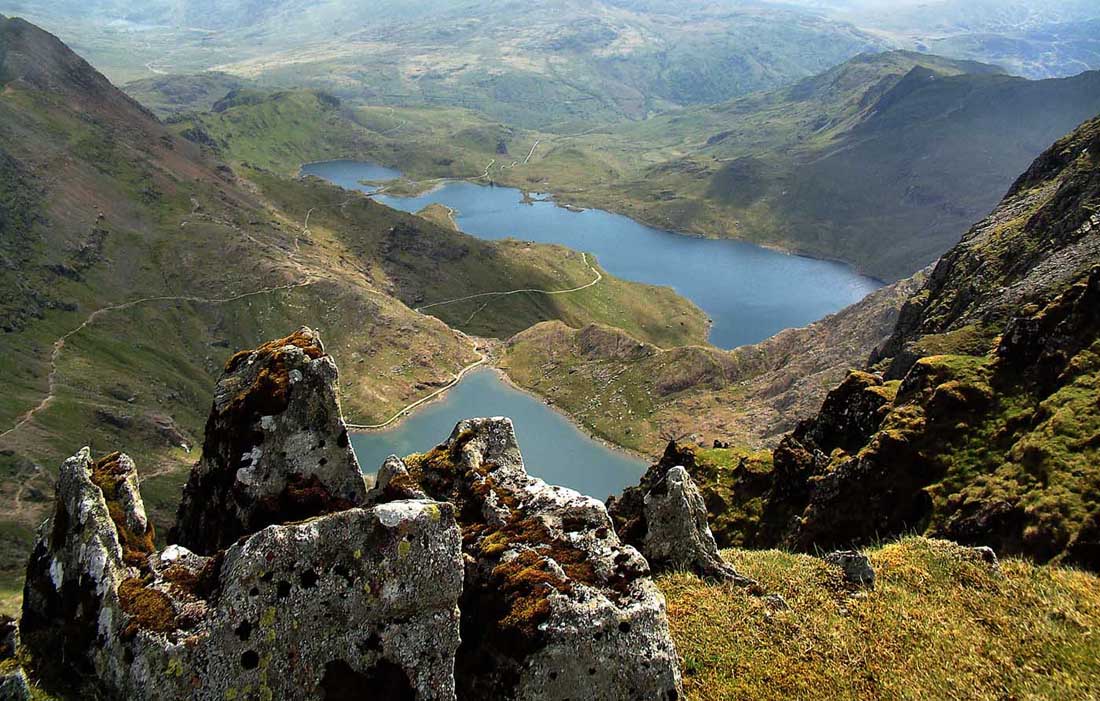
Should I spend more time in Ireland or the UK?
How long in the uk or ireland.
the United Kingdom and Ireland both offer a nice selection of activities for visitors. In our opinion, the United Kingdom has more to see and do, so we recommend that you spend more time in the United Kingdom than Ireland . However, 5-14 days is a good amount of time to spend in either destination.
Couples should spend more time in the United Kingdom than Ireland. You'll find plenty of romantic sights and fun activities in the United Kingdom that are great for a weekend getaway or a longer couple's trip.
Backpackers and budget travelers should spend more time in the United Kingdom than Ireland if your budget allows for it. With a larger number of budget-friendly sights, good nightlife, and active things to do, anyone traveling on a budget would have a good time in the United Kingdom.
- How many days should I spend in the UK or Ireland? Ideal Length of Stay --> UK 5-14 Ireland 5-14
A weekend in the UK or Ireland?
In the UK, you'll find live music, food, and hiking. The length of your trip often depends on your style of travel. Hiking can easily take up a good amount of your time here, too. Since there is so much to do in the area, a weekend is probably not enough for all of it.
Ireland is a great place to explore. Don't miss the history and culture, as that's what most people do. With so much to do, a weekend is probably not enough time to see everything. Your budget might influence how long you stay.
Five days in the UK or Ireland?
The UK is a great place to explore. It is common to spend five days here. Hikers are also drawn to this area. Five days is a great amount of time to relax and see the many things that the UK has to offer. Anyone can find something fun to do here.
It's hard to know how much time to spend in Ireland. Don't miss the history and culture, as that's what most people do. For many, it makes a great getaway for five days. With all of its activities, you can easily fill five days here. It has many unique tourist attractions and fascinating things to do.
A week in the UK or Ireland?
It's hard to know how much time to spend in the UK. In the UK, you'll find hiking, shopping, and museums. Many visitors also spend a good bit of time hiking. With all of its activities, you can easily fill one week here.
Many travelers enjoy the food, water sports, and hiking when visiting the historic destination of Ireland. This country offers a variety of activities to choose from. If you have one week, this is a great place to go. This would be the perfect place to spend one week, as it has just the right amount of activities.
Two weeks in the UK or Ireland?
It's hard to know how much time to spend in the UK. In the UK, you'll find hiking, shopping, and museums. Many visitors also spend a good bit of time hiking. Two weeks is a great amount of time to relax and see the many things that the UK has to offer.
Many travelers enjoy the food, water sports, and hiking when visiting the proud destination of Ireland. This country offers a variety of activities to choose from. If you have two weeks, this is a great place to go. With all of its activities, you can easily fill two weeks here.

Which country is cheaper, Ireland or the UK?
These are the overall average travel costs for the two destinations.
- UK Prices Ireland Prices
- Average Daily Cost Per person, per day UK £ 153 Ireland £ 121
The average daily cost (per person) in the UK is £153, while the average daily cost in Ireland is £121. These costs include accommodation (assuming double occupancy, so the traveler is sharing the room), food, transportation, and entertainment. While every person is different, these costs are an average of past travelers in each country. What follows is a categorical breakdown of travel costs for the UK and Ireland in more detail.
Accommodation
- Accommodation Hotel or hostel for one person UK £ 76 Ireland £ 57
- Accommodation Typical double-occupancy room UK £ 152 Ireland £ 114
Compare Hotels in the United Kingdom and Ireland
Looking for a hotel in the United Kingdom or Ireland? Prices vary by location, date, season, and the level of luxury. See below for options and compare which is best for your budget and travel style.
Hotels in the United Kingdom
Hotels in Ireland
Kayak helps you find the best prices for hotels, flights, and rental cars for destinations around the world. Compare prices for multiple destinations when planning your next trip.
Local Transportation
- Local Transportation Taxis, local buses, subway, etc. UK £ 29 Ireland £ 21
Typical Local Transportation prices in the UK
Here are some examples of typical transportation prices from actual travelers in the UK:
- Taxi Ride £ 15
- Heathrow Express £ 18
- Luggage Storage £ 8.00
- Local Bus £ 3.60
- Rail to Airport £ 11
- London Map £ 1.29
- Oyster Card £ 36
- 24 Hr Bus Passes (for 2) £ 20
- Ferry to Isle of Wight £ 16
- Parking £ 2.00
- Toll Way - Mersey tunnel £ 1.70
- City bike hire Liverpool £ 6.00
Hired Cars and Shuttles in the UK
Some specific examples of transportation prices in the UK:
- Southampton Cruise Terminals: Private Transfer to London: $1,303
- Heathrow Airport: Bus Transfer to/from Stansted Airport: $1,263
- London: Stonehenge Private Transfer with Optional Guide: $1,062
- From Glasgow: Private Day Trip to Edinburgh with Transfers: $836
- London Luton Airport (LTN): Transfer to Southampton Port: $831
- Private Transfer: Heathrow to Southampton Port + London Tour: $822
- Southampton Port Transfer with Stonehenge stop-over included: $795
- Bristol Airport (BRS): Transfer to Southampton city hotels: $782
- From Edinburgh: Loch Ness Private Day Tour with Transfers: $759
- Giant's Causeway Private Tour by Five Star Luxury Transfers: $759
- Bath: LHR to Bath Executive SUV Transfer: $746
- Scenic Transfer - Belfast to Derry via Giants Causeway Coast: $727
Typical Local Transportation prices in Ireland
Below are a few samples from actual travelers for transportation costs in Ireland:
- Rental Car for a Day £ 13
Hired Cars and Shuttles in Ireland
Also for Ireland, here are a few examples of actual transportation services:
- Arrival Transfer Dublin Airport to Dublin City by Van or Minibus: $109
- Arrival Transfer: Dublin Airport DUB to Dublin in Luxury Van: $117
- Belfast: Dublin Coach Transfer: $13
- Chauffeured Transfers from Ennis to Galway: $262
- Child Friendly | Dublin Airport Transfer: $169
- Collon House & Garden To Dublin Airport Or City Private Chauffeur Transfer : $298
- Cork Airport Private Transfer: Killarney to Cork Airport: $282
- Cork Private Transfer from Cork Airport to City centre: $72
- Cork Private Transfer from central Cork to Cork Airport: $72
- Departure Private Transfer by Business Car from Dublin to Dublin airport DUB: $82
- Departure Transfer Dublin to Dublin Airport by Van or Minibus: $109
- Departure Transfer: Dublin to Dublin Airport DUB in Business Car: $108
Is it cheaper to fly into the UK or the UK?
Prices for flights to both Ireland and the UK change regularly based on dates and travel demand. We suggest you find the best prices for your next trip on Kayak, because you can compare the cost of flights across multiple airlines for your prefered dates.
- Food Meals for one day UK £ 37 Ireland £ 35
Typical Food prices in the UK
Below are a few samples from actual travelers for food and meal costs in the UK:
- Lunch at Starbucks £ 13
- Tea £ 6.00
- Morning Tea £ 2.50
- Ice Cream £ 3.00
- A Quick Snack £ 4.00
- Dinner £ 22
- Breakfast £ 8.50
- Dinner at Filling Station £ 10
- Afternoon Tea at Fortnum & Mason £ 39
- Lunch £ 14
- Morning Tea £ 6.35
- Pastry £ 5.00
Food Tours and Cooking Classes in the UK
Also, here are some specific examples of food and dining related activities in the UK.
- Borough Market Food Tour - Self Guided: $6.58
- London: Borough Market Self-guided food tour: $7.20
- Dinner and Live DJ at A Fancy Restaurant: $17
- (Thur 7pm) Comedy Magic Show includes 1x Pizza & 2 glasses of Prosecco: $26
- Manchester: Hard Rock Cafe with Set Menu for Lunch or Dinner: $30
- Edinburgh: Hard Rock Cafe with Set Menu for Lunch or Dinner: $32
- Hard Rock Cafe Manchester with Set Menu for Lunch or Dinner: $33
- London: Hard Rock Cafe with Set Menu for Lunch or Dinner: $35
- Picadilly Circus: Hard Rock Cafe Set Menu Lunch or Dinner: $36
- Hard Rock Cafe London Old Park Lane with Set Menu for Lunch or Dinner: $38
- Traveling Spoon Nepalese Momos Private Online Cooking Class: $40
- Roast Dinner Cruise: $41
Typical Food prices in Ireland
Here are some examples of typical meal expenses from previous travelers to Ireland:
- Lunch for Two £ 27
- Fish & Chips Dinner £ 6.87
- Lunch Lynam's Pub £ 3.34
Food Tours and Cooking Classes in Ireland
For Ireland, here are some samples of tours and activities related to meals and dining experiences:
- Dublin 3-Course Dinner and Live Shows at The Irish House Party: $31
- Cork: Hysterical Histories, Comedic Dinner Theater Show: $56
- Hysterical Histories Cork Dinner Theatre Show: $57
- Belvedere Irish Night Show, Dance and Traditional 3-Course Dinner: $60
- No Diet Club - Best Food Tour in Dublin !: $61
- NO DIET CLUB - Best Food Tour in Dublin !: $62
- Cork Delicious Holiday Donut Adventure & Walking Food Tour: $65
- Dublin Delicious Donut Adventure & Walking Food Tour: $70
- Dublin: Grand Canal Cruise with Dinner: $72
- Killarney Jaunting Car Tour with Craft Brewery Beer & Pizza: $76
- Dublin: Delicious Walking Food Tour: $80
- Delicious Dublin Food Tour: $82
Entertainment
- Entertainment Entrance tickets, shows, etc. UK £ 27 Ireland £ 16
Typical Entertainment prices in the UK
Here are a few typical costs in the UK for activities, ticket prices, and tours that come from previous visitors:
- Two Tickets to a Concert £ 83
- Show Tickets £ 32
- Movie Tickets £ 8.00
- London Symphony Orchestra £ 34
- Movie Tickets for Two £ 12
- Donation for Storytellers £ 6.00
- Bike Rentals (for 2) £ 20
- Newspaper £ 0.85
- Luss Highland Games Entrance Fee (for 2) £ 12
- Two Bike Rental £ 34
- Thermal Bath Spa £ 35
- Warwick Castle (2) £ 59
Tours and Activities in the UK
Here are a few actual costs in the UK for available activities, ticket prices, and tours:
- An Evening in London. Panoramic night Tour by Executive Luxury Vehicle: $232
- Belfast A Music and StreetArt Experience. Small Gr Walking Tour : $26
- Belfast Taxi Tours Original Drivers who worked throughout The Troubles 2hrs: $139
- Belfast black cab 2hr private tour : $232
- Boogie Shoes Christmas Silent Disco Walking Tours London : $32
- Boogie Shoes Silent Disco Walking Tours Christmas Special: $32
- Canoe Paddle Tour from Totnes: $71
- David Bowie "Golden Years" Walking Tour of Brixton & Soho: $32
- Dorset Pint Glass Explore Breweries and Orchards Tour : $167
- Eclectic Belfast walking experience, along'The Marti Way': $28
- Edinburgh's Landscapes Tours with a Local Guide: Private & Personalized: $154
- Food Walking Guided Tour of Perth: $82
Typical Entertainment prices in Ireland
For Ireland, here are some examples of average entertainment and activity prices from previous travelers:
- Wild Wicklow Tour £ 22
- Guinness Brewery for Two £ 23
- St Pauls Cathedral £ 3.81
- Dublin Writer's Museum £ 5.33
Tours and Activities in Ireland
Also, here are some specific examples of entertainment, tickets, and activities for Ireland.
- Dublin: First Discovery Walk and Reading Walking Tour: $3.21
- Self Guided Tours Dublin With 100 Captivating Audio Stories: $3.26
- The Night Tour: urban legends & History of pubs: $3.27
- Dublin: Retracing Viking Origins on a Self-Guided Audio Tour: $4.61
- Dublin: Audio Guide Tour with 26 Attraction Visits: $4.99
- Dublin: Self-Guided Highlights Scavenger Hunt & Walking Tour: $5.14
- Dublin city tour: audio guide in your smartphone: $5.36
- Self Guided City Audio Tour in Dublin: $5.45
- Tarbert Bridewell Courthouse & Jail Museum Tour: $5.46
- Cork Highlights: A Self-Guided Audio Tour: $5.99
- Dublin: Escape Game and Tour: $6.43
- Dublin: City Exploration Game and Tour on your Phone: $6.96
- Alcohol Drinks for one day UK £ 13 Ireland £ 13
Typical Alcohol prices in the UK
Below are a few samples from actual travelers for alcohol and nightlife costs in the UK:
- A Couple Beers £ 9.00
- Beers at pub £ 5.40
- Beers at Pub £ 6.10
- Beers £ 5.00
- Beers £ 8.00
- Beer & Wine £ 14
- Drinks at the Pub (for 2) £ 7.55
- Pitcher of Pimms £ 15
- Drinks at the Walnut Pub (for 2) £ 10
- Bottle of Wine £ 12
- Ciders at Kilted Skirlie £ 3.50
- Half Pint at Tollbooth Tavern £ 1.65
Sample the Local Flavors in the UK
Here are a few nightlife and alcohol tours and activities from local tour providers in the UK:
- Bristol’s Best Brewery Taprooms: A Self-Guided Audio Tour: $5.99
- Self Guided Audio Tour in London Old Pub Crawl: $7.62
- Edinburgh: Pub Crawl with Free Shots & Discounts: $11
- Historic Pub Walking Tour of London: $13
- Brewery Tour & Tasting: $18
- Gin Tasting for Two at Judith’s, Shakespeare Distillery: $18
- Manchester: Guided Bar Crawl with Shots and Nightclub Entry: $19
- Cardiff Pub Crawl: Bar Crawl - Drink Deals & Free Shots: $19
- Edinburgh Bar Crawl: 5+ Venues, Free Shots, Free Club Entry: $19
- Guided Distillery Tour in South Wales: $19
- Belfast: Pub Crawl and Bar Walking Tour with Two Drinks: $19
- Tayport Distillery Tour & Tastings: $19
Sample the Local Flavors in Ireland
Also in Ireland, these are the prices for nightlife and alcohol related activities from various tour providers:
- Dublin: Authentic Brewery Tour: $11
- Dublin: Generation Pub Crawl: $15
- The Dublin Liberties Distillery: Tour with Whiskey Tasting: $18
- Dublin: City Pub Crawl Experience: $18
- The Dublin Liberties Distillery - Guided Tour and Whiskey Tasting: $19
- Dublin: Teeling Whiskey Distillery Tour & Tasting: $21
- Exclusive Brewery Tour and Tasting at Kildare Brewing Co, Sallins: $22
- Guided Tour to Shed Distillery of PJ Rigney in Leitrim: $23
- Dublin: Pearse Lyons Whiskey Distillery Experience: $24
- Traditional Irish Musical Pub Crawl: $24
- Pearse Lyons Whiskey Distillery: Trilogy Experience: $24
- Dublin: Roe and Co Distillery Cocktail Workshop Experience: $27
When we compare the travel costs of actual travelers between the UK and Ireland, we can see that the United Kingdom is more expensive. And not only is Ireland much less expensive, but it is actually a significantly cheaper destination. So, traveling to Ireland would let you spend less money overall. Or, you could decide to spend more money in Ireland and be able to afford a more luxurious travel style by staying in nicer hotels, eating at more expensive restaurants, taking tours, and experiencing more activities. The same level of travel in the United Kingdom would naturally cost you much more money, so you would probably want to keep your budget a little tighter in the United Kingdom than you might in Ireland.
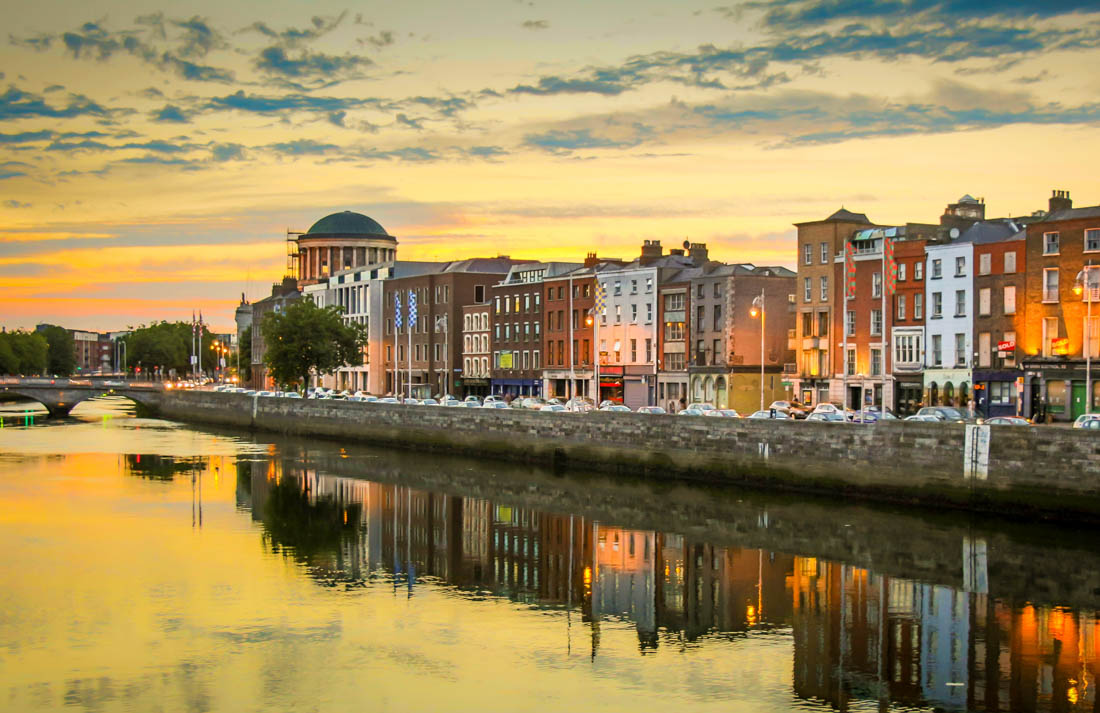
Why is the UK more expensive than Ireland?
The UK is well known as an expensive travel destination, even by European standards. The National Rail service is one thing citizens in this part of the world love to complain about, as it is very expensive. Unfortunately, restaurants will also not be friendly to your budget when you visit England so you might want to avoid eating out. You can find cheap food in England if you really pay attention. Fish and chips, kebabs, Indian and Asian food are only a couple of pounds. However do not expect to pay less than £15 if you sit-down at a restaurant. Cheap accomodation is also very hard to find in the UK and while some activities, such as a few museums, are free or cheap, castles and other attractions entrance fees are around £10 to £20. You'll find most other day activities, such as cycling, wine tours, tours to ancient ruins tend to be around 80 GBP.
Ireland, in general, is an affordable destination and with some insider knowledge, you can stretch your money further and have a fabulous upscale vacation there. In terms of accomodation, prices average 10-20 euros a night for a hostel dorm room. You can find private rooms that sleep two ranging from 35-60 euros. In the bigger cities, especially Dublin, expect to pay a bit more. You could also try Airbnb, which has shared rooms for as low as 16 euros per night and entire homes averaging about 50 euros a night. Fast food items start at around 4 euros, while a simple meal at a pub will cost you about 10 euros. A nicer meal, with a drink, will be upwards of 20 euros. If you go out early to lunch or dinner, you'll find many restaurants offer âearly birdâ specials where you can get good deals. Public transportation is first-rate in Ireland! Whether you're on a bus or train, expect free WiFi, friendly drivers, and timely departures. Bus trips around Dublin cost about 2 euros for a single journey. Longer bus journeys, such as Dublin to Belfast will cost around 17 euros. Taxis are expensive and, since most cities are extremely walkable, it is suggested that you avoid them. Most museum fees throughout the country cost about 10 euros.
What are the most expensive and cheapest cities and regions in the UK and Ireland?
Cities are more expensive than the countryside in the UK. A city break in London, Brighton or Edinburgh could cost you almost twice as much as the equivalent stay in Newcastle, Sheffield or Liverpool. St Andrews, Bath and Oxford should also be avoided if you are looking for a budget-friendly trip in the UK. However Exeter, Cardiff, Manchester and Birmingham are very affordable. A great city with affordable accomodation and food is York. It has a history dating back to prehistoric times and has been a backdrop for numerous influential political events. Cornwall is an incredibly popular destination in the UK and it turns out that cottages and food is fairly reasonably priced. Norfolk seems to have it all; clear coastline, interesting nature reserves, incredible wildlife, market towns, seaside resorts and remains a budget destination! For a cheap beach holiday in the UK head to Pembrokeshire, the most popular coastal destination in Wales. It boasts the Pembrokeshire Coast National Park, the only coastal national park of its kind in the United Kingdom. As for Dorset and the Peak District, finding budget food and accomodation is all about knowing the right places to visit, and going at the right time. While these are not the cheapest regions in the UK, affordable holidays are possible in the countryside if you book in advance or sometimes taking the risk and booking at the last minute also pays off.
Dublin has a reputation for being an expensive city and it certainly can be if you're not careful. Food and drink are going to be two budget killers. Luckily, attractions aren't too expensive and hostels/accommodation are reasonable. The countryside and smaller towns are way less expensive than the capital and, of course, slightly more affordable than any famous tourist spots such as Kinsale, Galway City, Cork, Kilkenny or Clifden.
How can you save money while visiting the UK and Ireland?
Bare in mind that many public museums and cathedrals offer free admission in most city throughout the UK. It's a great way to learn about the country's most influential artists, immerse yourself in the country's history, and waste a rainy day without paying a cent. Most major cities in England offer free walking tours as well. They usually last a few hours and are a great way to see the city. When in cities, rely on walking to get around. Private cars and taxis can ratchet up the cost of your trip significantly because fuel costs in Britain are high. You can also use public transport but when in London, use an Oyster card. Visitor Oyster cards and contactless payment cards offer the cheapest ways to travel in London. Using a Visitor Oyster Card is more than 50% cheaper than buying one-day paper Travel Cards or single tickets with cash. A good way to lower your food expenses is to stick to eating out during lunch only. Restaurants offer fabulous lunch specials where you can get multi-course meals for around 10 GBP. For good cheap and filling meals, visit the local pubs. Most serve good meals for less than 10 GBP and are a great way to meet the locals! Don't let the UK's reputation for expensive accommodations put you off visiting. For budget accommodation, look no further than London's friendly hostels, budget hotel chains, B&B's and Halls of Residence. If chilly days don't bother you, January is the cheapest month to take a vacation to Britain. The hotels have the lowest prices, and since tourism is usually weak, restaurants, theaters and museums offer deals to boost business.
Use your student discounts! A valid student ID will get you discounts, up to 50%, to many attractions, museums, and buses throughout the country. Also, Ireland's strong pub culture will hit your wallet hard so try to temper the cost by visiting happy hours, drinking at home, or skipping drinks altogether. For the best value food, head to the pubs for good, hearty local Irish food. Local meal, with local people, at local prices! For those of you that love to tour heritage sites, you should definitely get an OPW Heritage Card. It guarantees access to main attractions, including most of the castles throughout the country. The card is a must for people visiting multiple cities in the country as it only costs 25 euros for adults. For free accomodation, use couchsurfing! This app connects you with locals who will give you not only a free place to stay, but also a local tour guide who can introduce you to all the great places to see. If you're flexible in your schedule, you can also use the ridesharing service BlaBlaCar and catch rides with locals between cities. If you decide to hire a care, there are lots of different car hire sites, and you can compare deals but you should book your hire car in advance to avoid excessive fees.
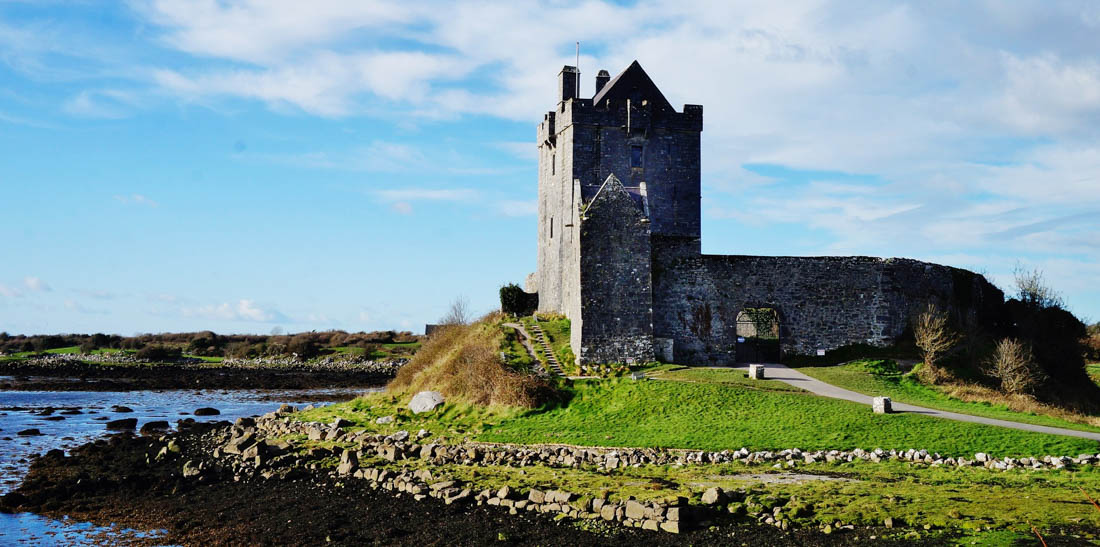
When is the best time to visit the UK or Ireland?
Both places have a temperate climate with four distinct seasons. As both cities are in the northern hemisphere, summer is in July and winter is in January.
As an island nation in the north, the U.K. experiences cold winters and mild summers. It's common for it to rain most of the year, although it's not usually a pour, but more of a drizzle most of the time. In Scotland and Northern Ireland in particular it can be more rainy than in the southern areas, but not by much. Despite the cold and rain, it does not snow very frequently except for in the mountain areas. When visiting, prepare for cooler weather and rain, even in the summer months.
Ireland can see its share of cold weather, especially on the coast during the wet winters. The summer months are mild with temperatures that are comfortable but not too warm. This makes it a great place to escape the summer heat from other destinations while taking in the country's history and culture. In fact, the weather can be wet at times and change suddenly, too. But it rarely snows in the winter, so don't be afraid to visit during the off season, too.
The United Kingdom can be visited at any time of year, as its climate is relatively temperate and, in general, doesn't experience extremes during either summer or winter. Bare in mind that no matter when you travel, you should always pack an umbrella, as the UK is notorious for experiencing misty days and showers year-round. Indeed, England has a bit of a bad reputation when it comes to weather, but one of the joys about the country is that, in fact, it does the seasons very well. Overall, spring, from March to June, and autumn, from September to November, are the best times to visit, as it is usually warm and dry. Spring is full of new life, with daffodils blooming and Easter egg hunts and autumn dazzles when the trees turn bright red and orange. However, England during summer is all about eating ice cream at the beach and picnics in the countryside and winter brings snow and cosy nights in front of a roaring fire. Late spring, along with summer is UK's high tourist season so hotel and flight prices reflect the surge. Although some attractions close in mountainous areas, and there's likely to be snow in the north during winter, the main cities remain fully open and will be quieter for sightseeing. December in London is also an incredibly popular place to be during the holidays, so expect the streets to be crowded with both English and international tourists.
Ireland has a mild, temperate climate and although at times rainey, you can visit at any time of year. However, depending on what you're looking for from your vacation, there could be better times than others to travel. During the months of March to May and September to November, the weather isn't as cold as during the winter months and the sites are not as crowded as during the summer months. The months of June, July and August are the warmest of the year, when Ireland's landscapes are at their most vibrant and days are extremely long. However, in summer, sites and roads are crowded and prices are higher. From late October some sites close, and temperatures drop. There's no avoiding the rain in Ireland no matter what time of the year you land on its shores but in terms of prices, opened sites and number of tourists, the mid-seasons are definitely the best time to visit Ireland.
Should I visit the UK or Ireland in the Summer?
The summer brings many poeple to the UK as well as Ireland. Many travelers come to the UK for the beaches, the hiking, the music scene, and the family-friendly experiences. Additionally, many visitors come to Ireland in the summer for the beaches, the hiking, the music scene, and the family-friendly experiences.
In the summer, London is a little warmer than Dublin. Typically, the summer temperatures in London in July average around 18°C (64°F), and Dublin averages at about 16°C (60°F).
In the summer, London often gets more sunshine than Dublin. London gets 195 hours of sunny skies this time of year, while Dublin receives 166 hours of full sun.
London usually gets less rain in July than Dublin. London gets 46 mm (1.8 in) of rain, while Dublin receives 50 mm (2 in) of rain this time of the year.
- Summer Average Temperatures July London 18°C (64°F) London 16°C (60°F)
Should I visit the UK or Ireland in the Autumn?
Both Ireland and the UK are popular destinations to visit in the autumn with plenty of activities. Many visitors come to the UK in the autumn for the hiking trails, the shopping scene, the music scene, and the natural beauty of the area. Also, most visitors come to Ireland for the hiking trails, the shopping scene, the music scene, and the natural beauty of the area during these months.
In October, London is generally around the same temperature as Dublin. Daily temperatures in London average around 12°C (53°F), and Dublin fluctuates around 11°C (52°F).
London usually receives more sunshine than Dublin during autumn. London gets 107 hours of sunny skies, while Dublin receives 97 hours of full sun in the autumn.
In October, London usually receives less rain than Dublin. London gets 58 mm (2.3 in) of rain, while Dublin receives 70 mm (2.7 in) of rain each month for the autumn.
- Autumn Average Temperatures October London 12°C (53°F) London 11°C (52°F)
Should I visit the UK or Ireland in the Winter?
Both Ireland and the UK during the winter are popular places to visit. Most visitors come to the UK for the museums, the Christmas ambience, the shopping scene, the theater shows, and the cuisine during these months. Also, the winter months attract visitors to Ireland because of the museums, the Christmas ambience, the shopping scene, the theater shows, and the cuisine.
London can be very cold during winter. London is cooler than Dublin in the winter. The daily temperature in London averages around 4°C (40°F) in January, and Dublin fluctuates around 6°C (42°F).
In the winter, London often gets less sunshine than Dublin. London gets 52 hours of sunny skies this time of year, while Dublin receives 56 hours of full sun.
London usually gets less rain in January than Dublin. London gets 52 mm (2 in) of rain, while Dublin receives 69 mm (2.7 in) of rain this time of the year.
- Winter Average Temperatures January London 4°C (40°F) London 6°C (42°F)
Should I visit the UK or Ireland in the Spring?
The spring attracts plenty of travelers to both the UK and Ireland. The spring months attract visitors to the UK because of the beaches and the natural beauty. Also, the beaches and the natural beauty are the main draw to Ireland this time of year.
In the spring, London is around the same temperature as Dublin. Typically, the spring temperatures in London in April average around 9°C (48°F), and Dublin averages at about 8°C (47°F).
London usually receives around the same amount of sunshine as Dublin during spring. London gets 147 hours of sunny skies, while Dublin receives 157 hours of full sun in the spring.
In April, London usually receives less rain than Dublin. London gets 45 mm (1.8 in) of rain, while Dublin receives 51 mm (2 in) of rain each month for the spring.
- Spring Average Temperatures April London 9°C (48°F) London 8°C (47°F)
Typical Weather for Dublin and London
Related articles for the uk, related articles for ireland.

More Destination Comparisons
Subscribe to our newsletter.
By signing up for our email newsletter, you will receive occasional updates from us with sales and discounts from major travel companies , plus tips and advice from experienced budget travelers!
Share This Page
Pin this page.
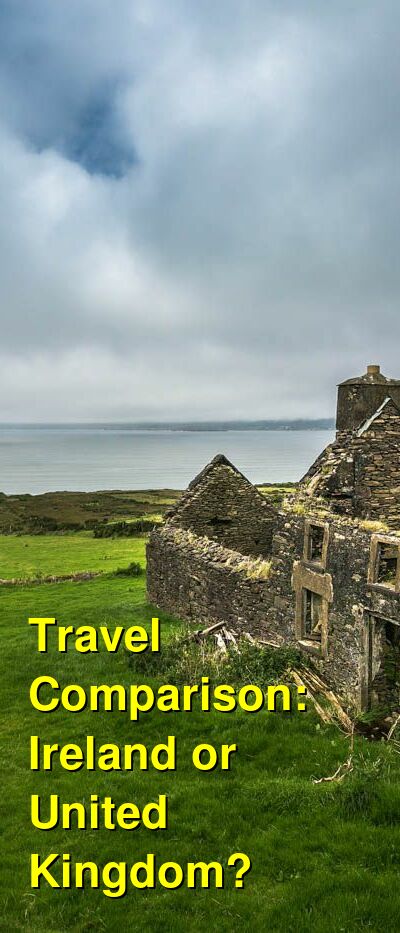
Some of the links on this website are sponsored or affiliate links which help to financially support this site. By clicking the link and making a purchase, we may receive a small commission, but this does not affect the price of your purchase.
- Privacy / Terms of Use
- Activities, Day Trips, Things To Do, and Excursions

The Ultimate London-Scotland-Ireland Itinerary
Last Updated on December 6, 2023
by Maggie Turansky
Disclaimer: This article contains affiliate links. That means if you click a link and make a purchase, we may make a small commission. As an Amazon Associate we earn from qualifying purchases. For more information, see our privacy policy.

Travelling through the British Isles is something many people want to do in their lifetimes. And it’s no surprise as to why. England, Scotland, and Ireland not only have a fascinating history that dates back thousands of years, but is home to both bucolic natural scenery and some of the world’s most vibrant and diverse cities. With so much to see and do in a seemingly small landmass, it can be hard to plan out the perfect London-Scotland-Ireland itinerary.
Luckily, I’m here to help. Read on to find out the best places to visit in Great Britain and Ireland and where you should spend your time!
Table of Contents
Planning a Trip to England, Ireland and Scotland
If you’re wondering about the best way to see England, Scotland and Ireland, then make sure to follow the tips and tricks outlined below.
Though it can be fairly easy to travel around this area, there are a number of logistical things and considerations to take into account in order to make the most out of your trip.
Everything from the time of year you visit to the mode of transport you use to get around can make an impact on your trip, so we’ve taken the time to outline all major options out there.
Best Time to Visit the United Kingdom and Ireland
Contrary to popular belief, it is not always cold and rainy in Britain and Ireland. The weather tends to be mild in the British Isles no matter what time of year, with no extreme variance between the seasons.
However, there are some seasons to travel to this beautiful corner of the world that are better than others which is important to consider when wondering how to plan a trip to England, Ireland and Scotland.
Summer is the most popular time to plan a trip. The days are long and the weather is as warm as it can be.
Highs in most of England and Ireland in the summer average around 20-22ºC (68-72ºF) and you can expect highs in Scotland to be about 15-17ºC (59-63°F). Though there are definitely rainy days, you can generally expect more sunshine this time of year than in other seasons.
While the weather is fantastic (for Britain) in the summer, it is also the busiest time for tourism. That means that the prettiest cities and towns will be filled with people and accommodation will book out well in advance. Prices are likely to be higher as well.
If you plan to go to Edinburgh, it is best to avoid the city during the month of August when its world-famous Fringe Festival is going on (unless you specifically want to visit for this occasion). Accommodation books out months in advance and it can be absolutely packed with people.
Autumn could arguably be the best time to visit Britain and Ireland because you get fewer crowds and decent weather. It doesn’t tend to get properly cold in the British Isles until November, so if you don’t mind a bit of rain and needing to wear a jacket outside , then autumn might be the best bet for you.

Along with the beautiful colours of the changing leaves, average highs in England and Ireland land somewhere around 10-17ºC (50-63ºF) and 8-14ºC (46-57ºF) in Scotland. Plan your visit for late September to early October and you very well might get some beautiful sunny days that are over 20ºC!
Spring in Britain and Ireland can be quite chilly still as the weather doesn’t start warming up properly until mid to late May and doesn’t consistently stay warm until June.
It can be quite rainy, windy, and miserable through most of the spring and even a bit dreary as the leaves don’t return to the trees until May. If you’re travelling in the spring, expect highs to be between 9-14ºC (48-57ºF) in England and Ireland and 7-13ºC (45-55ºF) in Scotland.
Winter is the coldest and darkest month in England, Scotland, and Ireland. While the majority of the isles don’t get a lot of snow, it does get dark quite early (around 3 or 4 PM depending on where you are) and it can be extremely wet and rainy.
Snow and sleet are common so make sure to pack accordingly. Average high temperatures in England and Ireland in winter clock in around 5-7ºC (41-45ºF) and 0-5ºC (32-41ºF) in Scotland.
Winter in Britain and Ireland can be miserable, however, many do like to travel around Christmas time in order to enjoy the decorations and markets scattered throughout the cities.
Cities like London and Edinburgh have wonderful Christmas markets and carnivals set up, but most major towns and cities all throughout this England-Scotland-Ireland itinerary will have something to fill you with holiday cheer.

How to Get Around
When it comes to planning a trip around England, Ireland, and Scotland, many people assume that it is easy to see a great portion of all three countries relying solely on the train. While the train network, especially in England, is extensive, it can be very expensive and they don’t always connect to smaller towns and more rural areas.
We recommend relying on the train and public transport systems while visiting England and then hiring a car once you arrive in Scotland and Ireland respectively if you’re following this itinerary. Both of the countries are noticeably more rural than England and don’t have as extensive of a train network.
The bus is also another option and there are more reliable bus connections within Ireland and Scotland than there are with the train.
Bus tickets can also be considerably less expensive than train tickets, however, it is almost always cheaper to book tickets for both at least a little bit in advance instead of on the day of travel. We suggest looking on Omio to book tickets for trains and buses in the UK
If you can drive, however, and your budget allows for it, then we would seriously recommend you hire a car in Ireland and Scotland . There are many places on this Ireland and Scotland itinerary that are much easier reached if you have your own mode of transportation.
Having a rental car not only allows you to get to more off-the-beaten-path and hard-to-reach areas, but it also gives you more flexibility. Nobody likes to be at the mercy of irregular bus timetables! You can browse car rental options here.
It can also be worth taking out an excess insurance policy with iCarHireInsurance to ensure you don’t need to pay a cent if you get into an accident. This will be significantly cheaper than taking out additional insurance from the car rental company.
It is worth knowing that the majority of rental cars available have a manual transmission. If you can only drive automatic, you need to expect to pay a little bit more for that! Also, this goes without saying, all three countries drive on the left-hand side of the road.
Finally, are you considering taking out a travel insurance policy before your trip? World Nomads offers flexible and simple travel insurance policies with coverage for more than 150 activities that you can buy or extend while on the road.

3-Week London-Scotland-Ireland Itinerary
In order to get a good feel for each country, we recommend you spend at least one week in each of them. Obviously, you could easily spend weeks exploring all three countries on their own, but then that is what future trips are for!
Week 1: England
London — the capital of the United Kingdom — is the most logical starting point for this itinerary. London is an absolutely massive city and while most visitors only spend a couple of days exploring, we would recommend that you spend the entirety of your week in England solely staying in London .
While there is certainly more to England than London, due to its central location as a transport hub, it is easy to visit other English cities as a day trip by train. And also a week in the city allows you to dig deeper and see beyond the main tourist draws and get a glimpse at how and where locals actually live in this diverse metropolis.
If you have never visited London before, then it is only understandable that you might want to spend a couple of days seeing everything that makes The Big Smoke so famous. Take the time to visit Buckingham Palace, Westminster Abbey, the Tower of London and the Houses of Parliament.
If you plan on visiting many paid attractions, then consider investing in a London Go City Pass that includes entry to several of the most popular places in the city and will save you money if you visit enough places!
Enjoy free entry into some of the best museums in the world like the British Museum, Science Museum, and the Victoria and Albert Museum. And, if you can, be sure to catch a West End show.

If these are the only things you plan on doing, then we suggest planning to stay in Central or West London (neighbourhoods like Soho, Kensington, and Knightsbridge) in order to avoid wasting valuable time sitting on the tube or bus.
Many first-time visitors to London grossly underestimate the city’s size and expect everything to be quite close to each other when, in reality, travel times in the city can take a very long time.
One benefit to spending one week in London, however, is that you will have time not only to do that traditional “touristy” things but also be able to get a little bit off the tourist trail and significantly reduce your overall London trip cost .
After you’ve spent your first couple of days exploring Central London and the museums, take a journey east and hang out with the hipsters in Shoreditch, walk along Regent’s Canal to London Fields, or see some live music in Camden.
London is much more than what is displayed in movies and in the media — it is easily one of the most multicultural cities in the world and has close to 9 million residents. Take the time to realise that London is not solely British and you won’t be disappointed.
Another benefit to spending one week in London is that it gives you the opportunity to take some day trips to other English cities. London is very different from the rest of the country, so it can be a really great experience to see how other cities function in England. Cities like Oxford , Cambridge , and Brighton are very popular day-trips from London and are all within about an hour’s train journey.
If you want to visit some less touristy cities that are still easy to do as a day trip, we would recommend getting up early and catching a train to Bristol or Bath in the west, which is a very cool and completely underrated city with an amazing craft beer and arts scene. Or, if you want to see a beautiful walled medieval city, head north to York , which can also easily be visited as a day trip from London.
If you don’t want to spend your entire week in England completely in London, then we would actually recommend spending five nights in the capital before spending two nights in York. There, you can spend one day exploring the city and another venturing out into the beautiful Yorkshire countryside.

Where to Stay in London
It really depends on what you want to do and see in order to find the best area to stay in London . These are our suggestions for some of our favourite areas of the city:
Z Hotel Soho – A cool boutique hotel located right in the centre of Soho. The rooms have been stylishly decorated and there are a number of great cafes, restaurants and bars nearby.
Astor Hyde Park Hostel – A great budget option in this area offering a mix of dorm and private rooms. The hostel has a brilliant common area, a large kitchen and a cheap breakfast available.
Eden Plaza Kensington – A mid-range hotel located just a few minutes walk from several major museums in the area.
Shoreditch:
Prime Backpackers Angel – This hostel is located in Angel, just a short walk along the canal to lively and bustling Shoreditch. They have a range of great dorm and private rooms available and come quite highly rated.
The Hoxton – A boutique hotel with funky and stylish rooms, located only a few minutes from Old Street Tube Station. Downstairs is a popular bar and restaurant that gets busy on weekends, however, rooms are completely soundproof.
Not quite what you’re looking for? Click here to browse other London hotels.
Week 2: Scotland
After spending one week in London and exploring England, it is time to head north to Scotland. You can reach Scotland either by taking the train — which is incredibly scenic, though expensive — or flying, which is often cheaper. If driving, there are a number of great stops between London and Edinburgh to check out!
Begin your adventures in Scotland by spending two days in Edinburgh , the Scottish capital. This beautiful city has an incredible history but it is quite compact and easy to get around — and it’s drastically different from London!
Take the time to walk the Royal Mile, tour Edinburgh Castle, swill some single-malt whiskey in a convivial pub, or maybe let your inner Harry Potter nerd run wild at Greyfriars Kirkyard!

After spending two days in Edinburgh, it’s time to venture into the Scottish Highlands and to explore the largest city there: Inverness. Inverness has the feeling of a small town and the main tourist appeal is its proximity to Loch Ness , however, it is very much worth exploring in its own right.
Spend one day in Inverness itself and another on a day trip from Inverness to Culloden Battlefield, Cawdor Castle, or the famous Loch Ness.
From Inverness, it’s time to get in the car and drive to one of the most beautiful areas of Scotland and a top place to visit in the country: the Isle of Skye . Though many people treat Skye as a simple day trip or stopover spot, it is quite large and really deserves to be explored fully.
That is why we recommend spending 2 full days here in order to see some of the main attractions while also getting a bit off the beaten path. There are some really fantastic hikes to do on Skye as well, so make sure you have proper boots!
After you have spent a wonderful two days exploring the beautiful Isle of Skye, head back to Edinburgh of one night before catching a flight to the Emerald Isle.
Where to Stay in Scotland
Apart from the traditional accommodation options listed below, you can find a number of private rentals in Scotland such as this contemporary cottage on the Isle of Skye or this charming riverside cottage in Inverness.
Edinburgh
Cityroomz Edinburgh — Located in the heart of the city, this small hotel had a number of rooms on offer and comes very highly rated.
Castle Rock Hostel — This small, centrally located hostel continues to be one of the highest-rated places to stay in Edinburgh. They have a number of rooms on offer, from dorm beds to privates, a friendly staff, and are a great option for both budget and solo travellers.
Torridon Guest House – a quaint bed and breakfast that is a great place to stay in Inverness. It is within a short walking distance of the city centre and a good option if you don’t want to stay in a hostel.
Black Isle Hostel – a great hostel offering dorms and private rooms that is a fantastic option if travelling solo and if you want to meet other travellers.
Isle of Skye
An-Airidh Bed & Breakfast Portree – located in Portree, this is a cosy bed and breakfast with plentyof great rooms, a hearty breakfast and friendly owners. Perfect for mid-range visitors.
Skyewalker Hostel — one of the top-rated hostels in all of Scotland, it’s excellently located, they have a number of different room options, a friendly staff, and they sometimes organise social events in the evening.
Not quite what you’re looking for? Click here to browse other Scotland hotels

Week 3: Ireland
Ireland is a country that fills many people with visions of rolling green hills, pastoral beauty, and incredibly friendly people — and upon visiting you will find that it certainly delivers!
While most people spend one week in Ireland going a pretty standard route from Dublin south to Cork and then following the coast up to Galway , we suggest that you venture on a path less taken when you get to this portion of the London-Scotland-Ireland itinerary.
It is easiest to begin your Ireland trip in Dublin, the capital of the Republic of Ireland. Dublin is a large and dynamic city with many layers, however, it can be quite expensive for tourists and there aren’t a plethora of things to do.
Two days in Dublin should be more than sufficient to see the main sites such as Trinity College, Temple Bar, and the Guinness Storehouse.

From Dublin, instead of following all too many tourists ahead of you and going south, it’s time to instead head west for the naturally stunning Connemara region in County Galway.
Situated on Ireland’s west coast, Connemara is famed for its rugged scenery, mountainous and boggy terrain, and unique Gaelic culture. Though Connemara is your eventual destination, there are a number of interesting stops you can make in the drive along the way.
Spending two days in Connemara will give you time to experience all of the fantastic things to do in this beautiful peninsula.
You can spend the day driving the famous scenic Sky Road outside of Clifden, explore charming fishing villages like Roundstone and Letterfrack, lie on the pristine white sand of Dog’s Bay Beach, and visit the gorgeous and historic Kylemore Abbey.
The final stop sees you in the wonderful Irish city of Galway. There are a number of great things to do here from exploring the main sites like the Spanish Arch and Eyre Square, whiskey tasting at Garavans Pub, listening to traditional Irish music in the trendy West End, and eating at some of Ireland’s top restaurants.
Spend two days exploring Galway city and one more day to take a day trip to one of Ireland’s most famous natural attractions: the Cliffs of Moher . These amazing cliffs are a popular spot for a reason: they are absolutely stunning. Avoid the tourist crowds by trying to get there early, you won’t be sorry!

Where to Stay in Ireland
Apart from the traditional accommodation listed below, you can find a number of private rental properties in Ireland including this stunning city-centre flat in Dublin or this lovely restored barn in Connemara.
Hotel 7 – This perfectly located boutique hotel is the ideal place to stay if you’re looking for a bit more comfort in Dublin. Situated within easy walking distance of some main attractions, they have a number of plush rooms available and a restaurant and bar on site.
Jacobs Inn – This centrally located hostel is a great place for solo and budget travellers. As one of the best-rated hostels in Dublin, they have a range of dorm rooms and privates available and they also organise social events.
Island View B&B – Located in the small seaside village of Roundstone, this B&B is the perfect base to explore all that Connemara has to offer. They offer a tasty and filling breakfast and the rooms were clean and comfortable. This is absolutely one of the best places to stay in Connemara.
Galway
The Stop B&B – This is a great bed and breakfast located in the Claddagh neighbourhood of Galway. Though the location is more quiet and residential, it was only about a ten-minute walk to the city centre and even closer to Galway’s vibrant west end. They also have a fantastic breakfast in the morning, included in the room rate.
Kinlay Eyre Square Hostel – Centrally located just off of Galway’s Eyre Square, this is one of the top-rated hostels in Galway City with both dorm and private rooms available.

Additional Information
If you have more time to devote to your itinerary, it can be worth adding a week onto all three countries or forgoing visiting one country altogether.
If you want to see more of England, consider spending a week in the beautiful southwestern region of Cornwall (there are a number of great stops from London to Cornwall to explore!) or heading north to the perennially popular Lake District. The latter makes more sense for an England-Scotland itinerary.
If you have more time and want to spend it in Scotland, consider adding on the Orkney Islands or driving all or part of the North Coast 500 route – this will allow you to see some of the most beautiful areas of the country where few tourists ever venture.
If you want to spend more time in Ireland you can head south from Dublin and spend time in Cork and the Ring of Kerry before tacking on Galway City and Connemara or alternatively head north from Dublin to Belfast and explore Northern Ireland!

Planning the perfect itinerary for England, Scotland and Ireland can be difficult as there is so much to see in each country. With these suggestions, however, you are sure to have the trip of a lifetime!
Are you trying to plan a trip to England, Scotland and Ireland? Have any questions about this itinerary? Let us know in the comments!

Related Posts:

9 Best Stops on the Dingle Peninsula Drive

9 Best Towns to Stay in Cornwall

13 Best Stops on the Inishowen 100 Drive

About Maggie Turansky
Maggie is a co-founder and writer for The World Was Here First. Originally from the US, she has lived in five different countries and has travelled to dozens more, both solo and with her partner, Michael. She particularly loves exploring Spain and spending time in the Caucasus and the Baltics. Read more about Maggie
what would it cost to make this trip
Hi Martin! We have detailed breakdowns of the cost of travelling in England , Scotland , Ireland and London . Hopefully this can help you plan and budget accordingly as the cost of your trip can vary dramatically on your own travel style and preferences.
Hello Maggie thanks for such an informative travel blog! We are planning a trip to Ireland, Northern Ireland, Scotland and England – is it possible to hire a one car for the whole of the trip, ie collect Dublin drop off London? Or do you recommend separate car hire?
Also, if we were to get the ferry from Belfast to Cairnryan, is there car hire or drop off at terminal or close by? Our searches were coming up blank.
Hi Cheryl, happy you’ve found this helpful! I think it’s technically possible to hire just one car for the entirety o your trip, but often it’s quite expensive to pick up in one location and drop it in another. It would depend on the specific car hire company you book through 🙂
I am a widower and solo traveller of 76 years old can you recommend a company that would cater to my age group to see england scotland and Ireland, would it be better to take a cruise on small ship or land tour. I want to spend some time in London as well. It’s been thirty years since Ive been there. I realize this may be too much for one trip but not sure I would ever get back. I am not one to organize tours on my own look forward to hearing from you martin taffel
Hello Maggie,
Hope you are doing great and thank you for having chat blog which would help travelers like us.
We are a family of three adults and fan of Manchester United. We are planning to travel in September/October to see or 2 matches of Man U then travel to Scotland and Ireland. . I also want to know how could travel to the three places, train or air would be better. We are coming from Singapore. Any tips and guidance for us would be good.
Thank you very much Seli
Hi Selvi, if you don’t want to drive yourself, I’d recommend taking the train from London to Manchester and the same onward to Scotland. Then it’s a quick flight to Ireland 🙂
Thanks for the ideas and feedback. This helps stop the head spinning.
One question as we are planning something in June or July 2024 ( I know need to get going), but it will be a family of 3 (2 adults and 1 14YR Old Son). Knowing all cool viewing points will not always be as fun for a 14 year old, any thoughts/suggestions for his consideration?
Hi Tom, maybe plan to spend more time in the cities rather than in the country? There are lots of things that could be of interest to a teenager depending on what your son likes!
Love your recommendations! We will likely visit England, Scotland and Wales in a three to four week trip. Any thoughts about a brief Wales tour? My ancestors are from Llanddulas and we’ve never been to Wales.
I saw you suggested Ireland and Scotland if you only plan to spend 10 days, but what do you think about Ireland and England? I’d love to know your thoughts.
Thank you so much for the great info! My husband and I just booked a trip in and out of London from 9/12-10/16. We plan to do 2 weeks in England and a week each in Scotland and Ireland. He has roots in County Cork so we definitely want to go there. Can you help with an itinerary? Since we’re flying in and out of London, do you recommend one week in the city and one week in the countryside? We definitely want to go to Bath. York, Cambridge, Oxford and maybe the Cotswalds? What do you suggest? Also, is there a ferry from Scotland to Ireland and how are the roads in the rural areas of these two countries? We’ve never driven on the UK side of the road. Will we need a car at all in England? Thank you so much! Debbie
Hello Maggie, I enjoyed your article. My wife and I are planning a Sept 2023 trip to Scotland/London area. Will spend 14 days or so. Wondering if we fly into a Scottish airport or London on a RT ticket from Seattle, WA? The only thing in England we want to see is Sudeley Castle (family relationship), then it’s off to Scotland for 11-12 days (focused on highlands), probably by train then rental car. We could do Sudeley on front end or back. Any suggestions? Thanks!
I am planning a 13 days trip to the UK in January.
I want to understand if I should do both Scotland and Ireland with london.
Please guide.
Thanks for your super helpful blog! I have just a couple of questions:
– Would you recommend separate car hires for Scottland and Ireland? – If you recommend separate car hires, would you recommend travel to Ireland from Scottland via ferry, or plane?
Hello Maggie,visiting Europe for the first time- London – Paris – Italy – would love some advise from you Is the Oliver plaza hotel a good choice to stay in London We are considering 3 to 4 days in London ( sight seeing the most famous sites) – traveling to Paris via the eurostar – 4 day stay in Paris- need advise on hotel close to normal sight seeing- then Italy Rome-pissa -Venice- any and all advise is welcome Thanking you in advance for your help! Adriana
Greetings Maggie! We have a reunion meeting in Belfast on 16-20 Sept 2022. I am flying from New York to Heathrow with connection to Belfast. After the reunion we want to explore Wales and Edinburg and Loch Ness (20-22 Sept) then back to London for return flight to NY. Would appreciate if you could recommend a good itinerary (I don’t drive manual so driving is not for me) taking the ferry from Belfast to Wales and maybe by air to Edinburg (pls suggest the best transport to take). Thanks in advance for your suggestions.
Wonderful information. I have a 1 week trip to London in August and want to spend 2 days in Ireland. My family is from County Fermanagh but I am not sure I can get that far in such a short time and still enjoy it leisurely. Any must do’s or suggestions?? I am not too interested in Dublin.
Spending 2 days in Ireland will definitely be a bit rushed, especially when you consider travel times. I would recommend planning to visit another time if you’re strapped for time on this trip 🙂
Hello Maggie we are 6 people from India all 60 plus of age want to visit London & Countryside in second half of June for around 12 nights what can be best ittenary for the same.My daughter living in London suggested Isle of Wright,Cotswold & Scotland
Hi Maggie- My son is graduating from college and we are planning to go to Ireland, Wales and London. We have approximately 2 weeks. We fly into Dublin and will finish up in London. I’m going home then and he’s heading over to the continent for another 10 days before he returns home to Chicago. I’m considering renting a car in Ireland so we can have more flexibility getting to more places “off the beaten path”. Any advice? Thanks!!
Hi Patrice – sounds like you’re planning a really memorable trip! I think that renting a car in Ireland (and in Wales, too) is a great idea as it will give you a lot more flexibility. Hope you have a great time!
I’m returning to the British Isles in April with my husband & son, as we will be visiting our older son studying in Swansea, Wales. Do you have any recommendations/links for a bed & breakfast or hotel in Swansea and for a bed & breakfast in Dublin, Ireland? Thank you for your kind consideration.
Hi there Maggie,
Thank you for this interesting read! I’ve actually been wanting to do a eng-sct-irl tour like this for quite a while (due in part to being a huge Harry Potter nerd), but I’ve never actually looked into it until now. Your itinerary guide has been really informative!
I know it’s almost impossible to say, BUT if you were to give a ballpark cost figure for the full tour for a single traveler hiring a car, what would it be?
Thanks again! And best wishes.
Thanks for your comment, Jason! We actually have a few cost guides that you might find helpful when coming up with a rough budget. England: https://www.theworldwasherefirst.com/england-trip-cost/ Scotland: https://www.theworldwasherefirst.com/trip-to-scotland-cost/ Ireland: https://www.theworldwasherefirst.com/ireland-trip-cost/
Great article, thank you. In terms of a budget for the three locations, do you have anything on this? Many thanks, Ken
Hi Ken! We actually have separate budget guides for England ( https://www.theworldwasherefirst.com/england-trip-cost/ ), Scotland ( https://www.theworldwasherefirst.com/trip-to-scotland-cost/ ) and Ireland ( https://www.theworldwasherefirst.com/ireland-trip-cost/ ). To help you even further we also have budget guides specifically for London ( https://www.theworldwasherefirst.com/london-trip-cost/ ), Edinburgh ( https://www.theworldwasherefirst.com/prices-in-edinburgh/ ) and Dublin ( https://www.theworldwasherefirst.com/prices-in-dublin/ ). Hope this helps!
Dear Maggie, thank you so much for putting this information out. 6 of us (3 couples family) want to plan a vacation to these locations in June 2022. This really helps us. My mother in law was from England and my husband and siblings want to see it all again. Fingers crossed. Thank you, Barbara
Thanks for your comment, Barbara! Really hope you’re able to have a fantastic trip 🙂
Dear Maggie, This is wonderful information. Thank you so very much. I along with 3 other nurses who have worked off and on together for over 30 years are planning a 6 week trip through England, Wales, Ireland and Scotland. Your tips have helped me with the planning of this trip. Thank you again,
Thanks for your comment, Terry! So happy that we’ve been able to help you plan your trip and I hope that you’re able to have an unforgettable adventure.
Hello, we are considering a 4 week trip for our family of 5, and I was wondering how your 6 weeks went? I am starting to think 4 weeks isn’t enough time
I am planning a trip to the U.K next year. I’m planning on moving to the U.K from Maryland. Where are the best location to settle down. It’s just me and no kids.
Hi Felicia, thanks for your comment! Where you plan to live in the UK really depends on what you’re after. There’s quite a lot of options so make sure to do some research and see where you like the most when you’re visiting next year 🙂
My husband and I are hoping to travel next year to London, Scotland and Ireland. This was a very informative and helpful article. We unfortunately will only have two weeks and not three to do this trip so we may leave off Ireland. Any suggestions on how to spilt the 3 of them in a 2 week period or do you suggest skipping one for a later time date by itself? Thank you
Hi Vicki, thanks for your comment! If you only have two weeks, I think the right move is to only concentrate on England and Scotland and leave Ireland for another trip. It is way better to visit fewer places and actually get to see and experience them then feel as if you have to rush through too many places and not really get the most out of them. Hope this helps and you’re able to have a great trip in the future!
Thanks for your tips etc on visiting Scotland/Ireland. A question can I rent a car in Scotland go over to Ireland leaving the car behind and pick up another car with the same rental company. Thus saving Ferry costs for the car. Whick port do you advise to use?
Regards Sakkie
Hi Sakkie, I’m not aware of any particular companies that you could do this with — you’ll need to contact a few yourself. Hope you have a great trip!
hello maggie,me and my wife are leaving USA,first time for our 30th anniversary.taking 2 1/2 weeks.wanted to visit all 3 places plus amsterdam,and normandy.was planning on flying to all of them,we heard it was the less expensive and doing small day tours in each.3 days in each,London,Edinburgh,dublin,amsterdam and normandy,all in may 2021.think too much?trying to plan a headstart.
Hi Jeffery, I think if you want to visit all of these places in 2.5 weeks it’s going to be a bit too much. Personally, I would limit yourself to just England and Scotland and maybe Ireland and save continental Europe for another trip 🙂 I think you will be able to enjoy the places you visit more this way.
Wondering what the best itinerary would be for 17 day trip. We would fly into the suggested city and rent a car for sure. Looking to get all 3 in and definitely want to see all the highlights. Any recommendations ?
H John, if you have 17 days, I would follow the 3-week itinerary that I’ve lined out and just pick one or two places that don’t interest you in order to meet your time constraints.
Dear Maggie, Thanks for the great information I’m planning for my short vacation (one week ) trip to London . North iceland and Scotland. Do you have any idea or suggestions for this short period ?? Regards Joanne
Hi Joanne, that is a lot of places to pack into one week! I would honestly only suggest sticking to the capital cities (London, Edinburgh, Belfast) and maybe take a day trip or two from them. That would allow you to get a good feel for the places without cramming too much in. Hope you have a great time!
Wonderfully insightful and helpful information on traveling the British Isles. I am planning an 18 day trip next September for my wife and I. Following your suggestions, I think 3 days in London would be enough for us to see many of the important and historic sights there. Then we would take the train to Edinburgh and stay for 2 or 3 days (maybe a short trip to St. Andrews one of those days). Then off to Inverness and the Isle of Skye for 2 days. I’d like to know if you think Glasgow is a must see. If not, we will simply head to Ireland and have a few more days to spend there.
I like the idea of Air BnB sites, but have no experience with them and want to make sure there is no concern necessary. I am a bit cautious at this point.
I’m looking forward to your response and any further/additional suggestions for helpful information.
Best regards, Pat
Thanks for your comment, Pat! I’m glad you’ve found this information helpful and it sounds like you’re planning a great trip. A lot of people tend to skip Glasgow when visiting Scotland (I, myself, have never been) as I don’t believe it has the same kind of beauty and historical sites that you can find in Edinburgh or elsewhere in the country. It is pretty up and coming, however, and there is a great music scene (so I’ve heard), so it all depends on what you’re after.
As for Airbnb, I have stayed in many many Airbnb properties all over the world and have never once had any sort of safety issue. It is actually my preferred kind of accommodation and I use it more often than not. All I would say is make sure you read the reviews of whichever property you want to stay in so you know what to expect. But there isn’t anything to worry about 🙂
Hope this helps!
Maggie, I really enjoyed your discussion and suggested itinerary. I is a great start for us. We are planning a five week trip to England, Scotland and Ireland (hopefully including Northern Ireland). A bit of Wales if we can fit it in would be nice. We are deciding between May and September. Do you have any recommendation/preference? I was thinking September since we would be heading pretty far north in Scotland. Also, do you have any thoughts on additional places to add for a trip of this length. We would likely limit our time in London to two-three days max. Both my wife Sue and I have visited London multiple times, but that is the extent of her travels to Britain. I have seen a fair share of the West Country and South Wales, but would appreciate any thoughts from an expert on how to expand your suggested itinerary. FYI, I have been no further north than the Cotswolds and have not seen Oxford/Cambridge/York and only limited places in Kent/Sussex/Hampshire/Dorset. Thanks in advance.
Thanks for your comment, Bob. I think that planning to go in September is a better bet, the weather is more consistently warm then — May can be really cold throughout Britain. If you’ve already been to London, then I would recommend spending some time in Cambridge and York. The Lake District could be a good option for you, as well, especially if you like nature. I hope you have a great trip!
Thank you so much for such informative articles (I’ve read several of them tonight)!
My husband and I are celebrating our 40th anniversary this December. We never had a honeymoon, so we have been planning a trip to Ireland and Scotland in March/April of 2020.
After reading this article, however, I’m thinking we might be better off to wait until Fall of 2020. ?
I have been looking into tour group trips, but none of them seem to be what we really want. After waiting all this time to go on a trip we’ve dreamed all our lives, I want it to be as special as can be. You have given me the courage to try and plan a trip myself and even hire a car! ?
Thank you again for the insightful advice.
Hi Lorrie, thanks so much for your comment and I am so happy that I’ve inspired you to travel independently for your 40th anniversary “honeymoon!” I’m sure you and your husband will have an amazing time! If you have any questions regarding your trip, please don’t hesitate to get in touch 🙂
we plan to travel to London 14 days on 19dec2019 onwsrds for Christmas celebration n New year 2020 and knowing that daylights short..about 4pm will b dark..
We don’t plan to drive.. can u recommend which date shall we stay in London ? will like to travel to Paris, Scotland or any better suggestion.
Regards Amie
Hey Amie, you can stay in London on any of these days but keep in mind that virtually everything shuts down on Christmas (25 Dec), including all public transport. Other than that, I’m sure you will have a great time — there are lots of markets and fun, festive things to explore that time of year. Just make sure to pack warm clothes!
We are planning a 10 days trip to London Scotland and Ireland.Please suggest an itinerary.
10 days in all three of London, Scotland, and Ireland is going to be too rushed. I would suggest concentrating on either London and Scotland or Scotland and Ireland depending on what interests you most. Hope you have a great trip!
Hi Maggie, Planning a 2.5 week trip and a friend has offered for me to use her vehicle (starting point West London). Would this be a good option or will I be wasting time driving long distances?
Hi Stephanie, if you have the option to borrow your friend’s car for the trip, I would definitely recommend it! Driving in London can be a nightmare, but otherwise, you will have so much more flexibility on your itinerary without being beholden to bus and train timetables. The UK is a small country, so no drives are really that long, either. And you can always find somewhere great to stop along the way!
Hi Maggie! We are looking for a 2 week trip to all 3 places. London we only want to do a few days and see the highlights. Then Scotland and Ireland. We want to stay a night in a castle in Scotland. Ireland we have to kiss the Blarney Stone. Touristy stuff as we have never been. Guinness and Jameson yours too! Ideas?
Hey Maureen, sounds like you’ve got a great trip planned! Hope you have a great time 🙂
Dear Maggie, Read your wonderful and infomative blog. Planning a trip to England, Scotland and Ireland in Mid September for family of 4 adults , a 4 years child and a 8 months baby.
We have only 2 weeks to spend. Please recommended some suggestions and an itinerary. Would like self driving in Scotland and Ireland.
Glad you found the information helpful! While the above itinerary is 3 weeks long, it is entirely possible to cut it down to 2 weeks if you just decide to skip some of the destinations that don’t interest you. For instance, you can only spend a couple of days in London, and skip one destination from each Scotland and Ireland and you will be able to plan to perfect 2-week trip. Hope you and your family have a great time!
Dear Maggie, Happy New Year! Your information is great but I was wondering if you have info on just navigating travel to these beautiful cities via train or other types of transportation between your suggested cities What is your opinion of taking a ferry to one of our selected city? I will be traveling with my 16-year-old daughter and will not be renting a car. I would be too freaked out and make our trip unbearable. We have been to London but never to Scotland or Ireland. We are traveling from Los Angeles and look for to making this a reality. Our travel will be in June of 2019. Great Article and look forward to reading more of your articles.
Happy New Year, Rosemarie! Thanks for your comment 🙂 Depending on where you want to go in Ireland/Scotland, renting a car isn’t entirely necessary, it can just make things more convenient if you want to visit more rural areas. Bus and train connections between the bigger cities in both countries are frequent and reliable, so you shouldn’t need to worry much about that. I’m not sure where you plan to take a ferry to, however, in my experience, the ferries are large, clean, and comfortable and tend to operate on time. If you’re not renting a car, you can also take day tours from all of the bigger cities/towns to visit more difficult-to-reach areas as well. I hope this helps you plan your trip! If you have any more questions, don’t hesitate to send us an email 🙂
Hi Maggie, my husband and I are planning a trip Oct 1-15 for his work to Tenby, Wales. He will have to work each day and I would love to see the UK, my daughter is planning on flying for one week of our stay and just wondering how we could see Ireland-Scotland-London in a 7 day period or is that too much to see in such a short time? Would love your suggestions!!
Hi Pam, thanks for your comment! I personally wouldn’t recommend trying to cram a visit to England, Scotland and Ireland into one 7-day trip – you’re likely not going to get a lot out of it and will spend more of your time travelling between places rather than actually seeing anything. I would recommend staying simply in England and Scotland (or just one of them) and then plan to visit Ireland some other time when you have enough time to properly dedicate to it.
Leave a Comment Cancel reply
8 Days in the UK and Ireland Itinerary
Ready to spend 8 incredible days seeing as much of the UK and Ireland as you can? I’ve put together this 8-day UK and Ireland itinerary that’s perfect for first-time visitors!
On our big trip to the British Isles, I had to put together an itinerary that showed Kevin as many iconic sites as possible for his first ever visit. Since I studied abroad in both England and Ireland, I pretty much know what was worth our time to see and what we could skip.
So if it’s your first trip to the UK and Ireland , this will be perfect for you! In this 8-day UK and Ireland itinerary , I’ll give you the rundown of everything we did on our vacation (and a few mistakes we made so you can avoid them!).
Post Contents
Day 1: London, England
We started out in London , England, arriving early on a Sunday.
After getting over a little jet-lag crankiness, we ventured out for some sightseeing. I gave Kevin a walking tour of London’s top sights: Westminster Abbey, Big Ben and the Houses of Parliament, Buckingham Palace, etc.
Make time to tour inside Westminster Abbey and see the Changing the Guard at Buckingham Palace.
To read my full London itinerary and see the mapped out route that takes you to many of London’s main sights, read my 2 Days in London Itinerary post . This post also has suggestions for Day 3 of our 8-day UK and Ireland itinerary.
Day 2: Stonehenge and King Arthur’s England
On Monday, we got away from the city and went on a small group tour to Stonehenge .
For a day trip to Stonehenge, most people are underwhelmed by only seeing Stonehenge. So I highly recommend booking a tour that sees other sites. Tours that include a trip to Bath , Windsor , or Oxford are popular. I’ve done a Stonehenge, Windsor, and Oxford tour before.
But for this trip, we did a tour of Stonehenge and King Arthur sights . It took us to sights of mystery and intrigue, most of which are associated with the King Arthur legend. We saw Glastonbury Tor, the Chalice Well, Glastonbury Abbey, and as a bonus, our tour guide took us to Avebury Stone Circle, the largest stone circle in Europe.
Read my King Arthur Tour from London post for more details about this day trip.
Day 3: London, England
We were back to wandering around London on Tuesday.
Our itinerary for the day included the Tower of London , the British Museum, and the National Gallery.
Read my 2 Days in London Itinerary post for more details on both Day 3 and Day 1 adventures in London.
And if you feel like you have time for more activities, read my Free Things to Do in London post for more ideas that won’t cost you a penny!
Day 4: Cardiff, Wales
Wednesday we took a train from London to Cardiff , Wales.
We only had a couple activities planned for Cardiff: Cardiff Castle and National Museum Cardiff. If we had taken more time in Wales, I’d have loved to see more of the city.
Read my 24 Hours in Cardiff post for more details on what to see in Cardiff, including places to eat!
Day 5: Dublin, Ireland
After a short plane ride on Thursday, we were in Dublin , Ireland.
Pro tip: Don’t schedule your Book of Kells tour tickets for the same time as your plane trip. No clue how we messed that up. We had more planned for our first day in Dublin, but due to the aforementioned scheduling conflict, we had to cut some things.
We managed to still see the Book of Kells and Trinity College, and then I took Kevin on a walking tour of Dublin’s top sights, including Dublin Castle , St Patrick’s Cathedral, Christ Church Cathedral, and Temple Bar.
If you plan better than us and have more time, I recommend taking a tour of Dublin Castle and St Patrick’s Cathedral. Christ Church Cathedral is also an interesting visit.
To read my full Dublin itinerary and see the mapped out route that takes you to many of Dublin’s main sights, read my 1 Day in Dublin Itinerary post .
And if you’re a much better scheduler and feel like you have time for more activities, read my Free Things to Do in Dublin post for more ideas of budget things to do!
Day 6: Blarney Castle, the Rock of Cashel, and Cahir Castle
On Friday, we took a guided Blarney Castle day tour around the southern counties of Ireland to see some castles.
Stops on this trip included the Rock of Cashel , Blarney Castle , and Cahir Castle . For anyone looking to get from Dublin to Blarney Castle to kiss the Blarney Stone, this is a tour I definitely recommend for one main reason: three castles in one day!
Blarney Castle and the Rock of Cashel are both well-known Irish castles, while Cahir Castle is a lesser known hidden gem.
Read my Blarney Castle Day Trip from Dublin post to learn more about this day tour and each of these castles.
Day 7: Edinburgh, Scotland
We were back on another plane on Saturday, this time flying to Edinburgh , Scotland.
The one thing on our agenda for Saturday was Edinburgh Castle , and after a backpack mishap (the castle doesn’t allow bags over 30L so we had to go all the way back to our hotel and leave our backpack), we explored the castle.
After that, we were free to wander the Royal Mile. Go shopping for authentic Scottish souvenirs here (like a kilt!), enjoy watching the buskers and street performers, and find a nice pub for dinner.
Read my 24 Hours in Edinburgh post for a full look at our Day 7 and Day 8 activities.
And if you, again, planned better than us and did not have a backpack mishap, you’ll likely have more time on your hands. In that case, read my Free Things to Do in Edinburgh post for plenty of free stops!
Day 8: Edinburgh, Scotland
On Sunday, our last day, we went out to Edinburgh’s “other castle” — Craigmillar Castle .
Craigmillar Castle is 3 miles south of the City Centre, but the castle is great because they let you have the run of the place, encouraging you to open any door that isn’t locked.
Our Edinburgh trip was split over two days, but you could easily do this itinerary in the same day. Read my 24 Hours in Edinburgh post for a full look at our Day 7 and Day 8 activities.
Once we explored the vast amount of rooms at Craigmillar Castle, we hopped on yet another plane, this time back to London. Then we spent the rest of the afternoon getting to our hotel and resting up for another big flight back to Atlanta.
And that ends our 8-day UK and Ireland itinerary!
8-Day UK and Ireland Itinerary Map
Ready to plan out your week-long adventure in the UK and Ireland? Use the map below to help you out.
I hope you found this UK and Ireland Itinerary helpful! Happy travels!
- 5 Best Pubs in Pimlico, London
- 10 Incredible Day Trips from London, England
- A Self-Guided WWII History Tour of London, England
- Dublin Statues and Their Notorious Nicknames
- 15 Things to See and Do In Dublin, Ireland
- 6 Amazing Day Trips From Dublin, Ireland
Ready to travel across the UK and Ireland? Plan your trip with these tips.
- Book Your Flight: Find the cheapest flights using Skyscanner , my favorite flight search engine.
- Find Accommodation: You can find top hotels in the UK and Ireland using Booking.com.
- Start Packing: Check out my packing list resources so you’re prepared for your trip.
Leave your UK and Ireland travel tips in the comments below!
Paige Watts is a travel expert and author of What's With Atlanta? , a guide to the quirks and charm of the ATL. A life-long traveler, Paige is dedicated to helping you discover the best things to do in the Southern USA and around the world. Her work has been featured in The Culture Trip, Matador, Newsbreak, MSN, NPR, and countless other interviews and podcasts.
Similar Posts
11 best atlanta hotels with rooftop bars [2024].
Elevate your stay in Atlanta by booking a hotel with a rooftop bar. These top Atlanta hotels provide guests with primary access to trendy rooftop bars.
14 Best Restaurants in Washington DC
Dining in America’s capital means a diversity of flavors! Here are the best restaurants in Washington DC, from casual to fine dining.
13 Chillingly Haunted Spots in San Antonio, Texas
San Antonio has a bloody past full of stories. Hunt up some ghosts at these chillingly haunted spots in San Antonio, Texas.
North Georgia Wine Tour from Atlanta: Perfect Girls’ Trip
Plan the perfect day out with the girls! A North Georgia winery day tour is the perfect girls’ trip from Atlanta, Georgia.
Top 5 Things To Do in Santorini, Greece (and How To Get Around)
Find out the top things to do in Santorini, Greece and how to navigate your way around this stunning island.
5 Best Restaurants in Chinatown DC
There is a ton of variety to choose from in Chinatown, and these are our suggestions of where to eat in Chinatown, Washington D.C.
Leave a Reply Cancel reply
Your email address will not be published. Required fields are marked *

When is the best time to visit the UK? (Seasonal & monthly guide)
By: Author Tracy Collins
Posted on Last updated: August 8, 2023
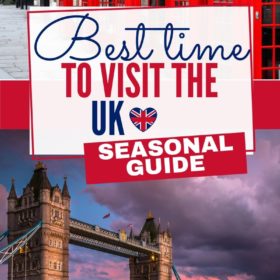
Are you planning a trip to the UK but unsure of the best time of year to visit? In this article discover what each season has to offer as well as a month by month guide to major events across the UK. Everything you need to know to help you make the right decision for your trip.
If you’re dreaming of having a spot of tea in England or envisioning a bagpipe serenade on the moors of Scotland, then it sounds like you’re on the verge of planning one heck of a British vacation. The question is, when is the best time to visit the UK?
There are many considerations to make when planning your trip , including the pros and cons of travelling “in season,” what types of activities you want to do and especially what kind of weather should you expect.
In this article, we will answer all commonly asked questions including
- what you can expect from the weather during each season
- the dates of school and public holidays – and the pros and cons of travelling during these peak times
- expected hours of daylight throughout the year and the impact this can have on your plans
- what (and when) major events occur throughout the year
- plus a guide to the best time to visit England, Wales, Scotland and Northern Ireland
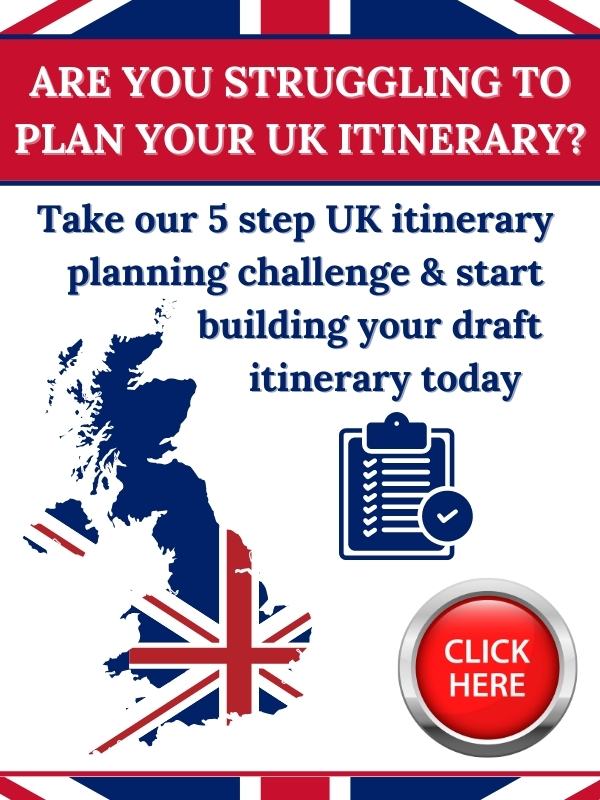
FAQ’s about the best time of year to visit the UK
Many questions about when is the best time to visit the UK invariably revolve around the weather. The only certainty about the UK weather is that is unpredictable.
- When is winter in the UK?
The winter months ranges from mid-November to early March.
- When is summer in the UK?
The summer months range from early June to the end of August.
- Can I see the Northern Lights in the UK?
For the best chance to see the Aurora Borealis (Northern Lights) head to to Northern Scotland.
- What is the rainiest month in the UK?
Although December to February are the months that tend to have the most rainfall in the UK (and often can fall as snow especially on higher ground) expect rain at any time of year.
- What is the hottest month of the year in the UK?
During the summer months expect generally warm to hot weather with July (on average) the month with the highest average temperatures.
- When is peak season in the UK?
Peak season in the UK is July and August. This also coincides with school holidays across the country.
- When is the shoulder season in the UK?
Shoulder season in the UK is May, June and September.
- When are the major public holidays in the UK?
In addition to Christmas, New Year and Easter holidays there are a number of public holidays (called ‘Bank” holidays) throughout the year including May Day Bank Holiday (first Monday in May), Spring Bank Holiday (last Monday in May – and yes there are two Bank Holiday weekends in May!), and the Summer Bank Holiday (last Monday in August)
- FAQ's about the best time of year to visit the UK
The weather
Pros and cons of visiting the uk during peak season, advantages of visiting the uk during shoulder season, pros and cons of visiting the uk during low season, impact of daylight hours, when is the best time to visit england, when is the best time to visit scotland, when is the best time to visit wales, when is the best time to visit northern ireland, essential guides, when is the best time to visit london, happy uk travel planning, when is the best time to visit the united kingdom.
Factors to consider when planning your trip
- Pros and cons of travelling during Peak Season, Shoulder Season or Low Season
- The impact of daylight hours
The UK is a small island divided into 4 separate nations — England , Wales , Northern Ireland and Scotland . Each has their own cultural identities and attractions to consider, not to mention their own weather idiosyncrasies.
Basically though, the entire UK has a temperate climate with warm summers that never get too hot and cold winters that never get too cold.
The UK weather is, however, famously unreliable and generally not the primary reason to visit the UK! Think about your many clothing options when packing— and don’t forget the umbrella (my UK packing guide for every season will help!)
The answer to the question, ‘When is the best time of year to visit the UK?’ really depends on what you’re looking for. The UK’s warmest weather is in the summer. Autumn and spring are charming but may be a little bit chilly for certain outdoor activities. Winter can be cold, blustery and damp, though it usually only snows around 24 days out of the year.
Spring in the UK begins in March and goes through to the end of May. The weather starts off cold and rainy but becomes more mild as the months progress. Finally, by the end of May and beginning of June, the UK starts to warm up. The average maximum temperatures are as follows:
- March, 12°C (54°F)
- April, 15°C (59°F)
- May, 18°C (64°F)
- June, 21°C (70°F)
Read – Complete Guide to visiting the UK in spring
The summer is generally very pleasant in the UK and tends to be dryer than in the autumn and winter months. The summer begins in June and ends in early September. The average maximum temperatures for the summer months are as follows:
- July, 23°C (73°F)
- August, 23°C (73°F)
- September, 20°C (68°F)
Read – Complete Guide to visiting the UK in summer
Autumn goes from September through to the end of November. Days change from crisp to blustery and then get downright cold. There tends to be a higher level of precipitation during these months as well. The average maximum temperatures for the autumn months are as follows:
- October, 16°C (61°F)
- November, 12°C (54°F)
- December, 9°C (48°F)
It can get rather bleak and cold in the UK during the winter months, which go from the start of December through to the end of February. The average maximum temperatures for the UK in winter months are as follows:
- January, 9°C (48°F)
- February, 9°C (48°F)
Read – Complete Guide to visiting the UK in winter
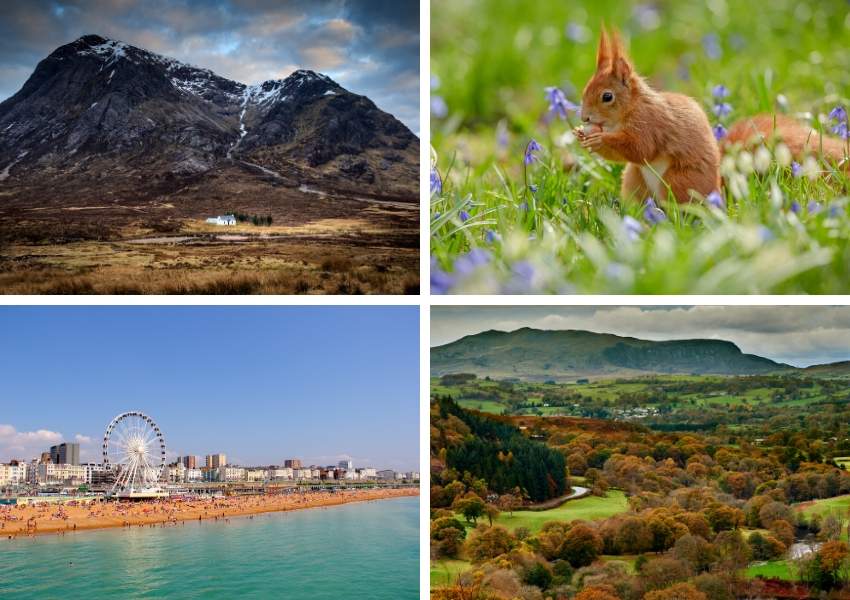
Peak season for travel in the UK are the summer months of July and August. These dates also coincide with the long 6 week summer school holidays (and hopefully sunny weather)
What are the pros of visiting the UK during peak season?
- The UK weather is generally at its best during these months.
- Hours of daylight are long which means more time to explore the sights.
- Some of the UK’s major events occur during July (Wimbledon) and August (Edinburgh Festival)
- Many historic sights have special events on especially for families e.g jousting at Warwick Castle.
What are the cons of traveling during peak season?
- It is the most expensive time of year to visit and prices for flights, accommodation and transportation can be sky-high.
- Main attractions across the country are busy – buy tickets ahead of time (skip the line tickets are worth the expense unless you enjoy wasting precious holiday time in a queue!)
- Restaurants and hotels are jam-packed.
- Roads are busy and traffic jams are common which can add to the stress if you are planning to hire a car for a road trip
Shoulder season in the UK is in May, early June, September and early October.
What are the pros of visiting the UK during shoulder season?
- Less expensive than peak season
- Better availability for accommodation
- Some of the UK’s most popular events occur during these months such as the Chelsea Flower Show (May), Trooping of the Colour (June)
- Less crowded (though the Bank holidays can be busy)
- There are 2 public (bank) holidays in May (first and last Mondays of May) and many popular historical sights organize events especially for families over these long weekends.
- Expect fewer crowds at popular attractions (though school groups may visit museums, art galleries, and castles during term time)
- Long daylight hours
November through to April is generally considered to be the low season for travel to the UK.
Note that some parts of the UK such as London and Edinburgh experience significant numbers of tourists during December and early January which can significantly impact costs.
Pros of visiting the UK during the low season
- Budget friendly
- Less crowded
- Enjoy special events over the festive period including Christmas markets, Christmas lights and decorations in major cities and New Year’s Eve celebrations.
Cons of visiting the UK during the low season
- Weather can be very cold (expect snow during the winter months)
- Daylight hours are reduced (it can get dark as early as 3.30 pm)
- Many popular attractions are closed over the winter months.
The amount of daylight you can expect fluctuates greatly across the year and can have a major impact on your plans.
The amount of daylight can also vary depending on your destination within the UK. The further north you travel the more daylight you can expect in summer and the less in winter.
Average hours of daylight in June (longest day)
London – 16 hours +
Scotland – 17 hours +
Average hours of daylight in December (shortest day)
London – 8 hours
Scotland – 7 hours
First of all, there’s no bad time to visit England , though travelling during every season has its advantages and disadvantages. You can, however, expect some seasonal variation in prices, crowd size and availability of activities.
The summer is the peak tourist season, which is from the end of May to early September. The daylight hours are at their maximum, up to 16 hours per day. The weather is usually delightful and kids are off school (July and August). The inevitable consequence is that everyone starts flocking to the tourist destinations and adding to the already long lines and crowds.
If you dream of gallivanting through the English countryside, add throngs of people sharing the roads and limited parking to your vision. Unfortunately, hotel rates and airfare are usually more expensive in the summer. Still, that charming weather can be a lure that outweighs all of those inconveniences.
If you travel in winter, it may be cold and bleak, and the daylight hours will have waned to just 8 to 10 hours per day. That’s the bad news. The good news is you won’t have to fight any crowds or struggle to get a dinner reservation. There will also be deals to be had on hotel rooms and flights. So if your itinerary contains a lot of indoor activities, maybe winter travel is right for you.
If you’re wondering when is a good time to visit London , it’s similar to travelling in the rest of the UK in terms of weather and seasonal availability. There are a few exceptions, however.
Christmas time in the capital city has been an incredibly popular destination for decades, what with the shopping, the decorations and abundant Christmassy charm.
If however you are a royal watcher, consider traveling in the summer when there are more opportunities to have a peek into the royal lifestyle . Many royal residences are open to the public during the summer because the royals themselves are away on vacation.
Taking all of this into consideration, if you want to know when the best time is to visit England, the answer is (if you can) spring or autumn. During these times the weather is favourable and the daylight hours vary from 11 to 15 hours per day, so there’ll be plenty of time for sightseeing.
Taking a road trip through the English countryside (the Cotswolds , Lake District , Peak District or Northumberland are just two suggestions) is gorgeous in the spring or autumn because either the flowers are blooming or the leaves are turning brilliant shades of orange and yellow. While there are crowds they are smaller and more manageable than in the peak summer season.
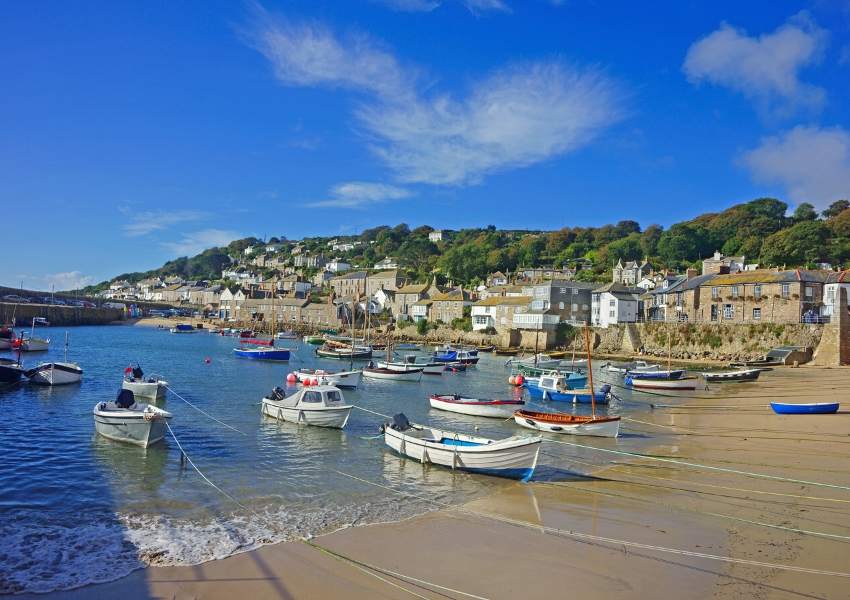
Just like it did for England, the timing of your Scotland trip depends upon what you activities have planned. The country’s winter may be more suited to hunkering down in an Edinburgh pub rather than hiking through the Highlands. The average temperature hovers around 0°C (32°F) and is likely to be even colder on the coast and in higher attitudes.
Like England, airfares and hotel rooms will generally be cheaper and you won’t have to fight the crowds in the cities or in the train stations. You will, however, need to be ready for the reduced daylight hours. In January, for example, the sun rises at 8:47 a.m. and sets at 3:53 p.m.
There is good news, though. Because of Scotland’s high latitude and particularly dark winter nights, there’s a chance that you will be treated to the aurora borealis or the northern lights — a dazzling and somewhat ethereal light show in the sky.
A summer trip to Scotland is defined by pros and cons.
The pros — you’ll have lovely weather, as it never gets too terribly hot in Scotland. Temperatures range from 15°C (59°F) to 17°C (63 °F). The daylight hours are also long. In August, for example, the sun rises at 4:22 a.m. and sets at 8:03 p.m.
There will be a lot to do, like hiking, camping, driving tours, beautiful train journeys , exploring the cities, islands and the countryside.There are festivals for every taste, such as the Edinburgh Fringe Festival and the Belladrum Tartan Heart Festival in Inverness.
Now for some cons — July and August are peak months for travel, and the crowds will be significantly larger and the prices will be higher. If you don’t mind competing for a little space and paying more for the privilege, then a summer trip may just be the perfect one for you.
As with England, visiting Scotland in the late spring/early summer or early autumn is ideal. By June, Scotland gets an amazing 17 hours of daylight. That combined with the spring’s pleasant weather, an average of 7°C (45°F) to 13 °C (55°F), and you will be able to conquer every outdoor activity there is to offer.
If you would prefer to spend your time in Scotland’s cities, the good news is that the summer tourists haven’t arrived yet, so lines won’t be as long and the prices will be more reasonable. The same thing is true for an autumn visit. Starting in November through middle December, airfares tend to be cheaper.
Early autumn is an ideal time of year to drive North Coast 500 , a spectacular 516-mile trip from Inverness along Scotland’s North Highlands that might be one of the most scenic drives in the world.
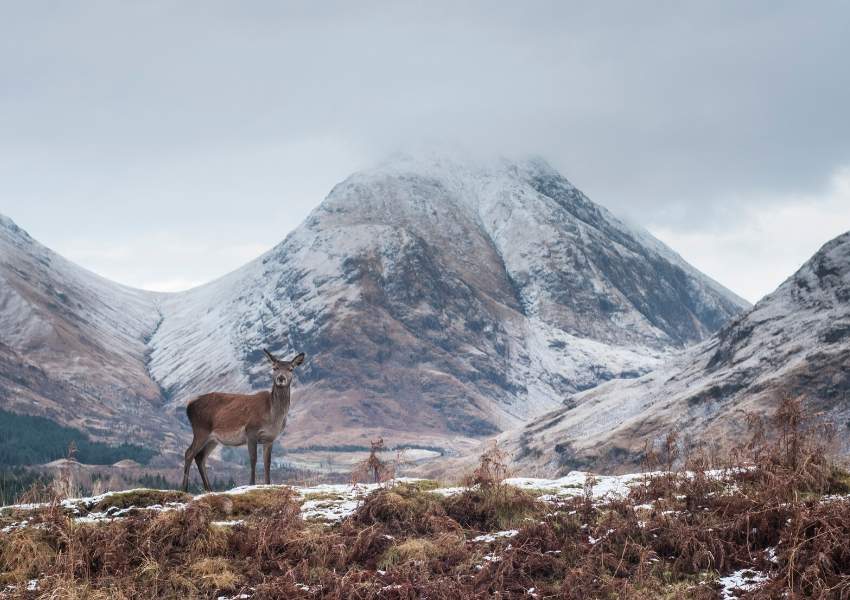
No matter when you visit Wales , remember, the weather can be unpredictable and you should pack well and be prepared for a variety of temperatures.
The temperature in winter averages 6°C (43°F), but compared to Scotland, there is a good amount of daylight — sunrise is around 7:40 a.m. and sunset is around 6:28 p.m. In spite of the cooler weather, daffodils have been known to make their cheerful appearance late in the winter.
Another plus, if you travel on or near March 1st, you can join the locals in celebrating St. David’s Day. The patron saint of Wales is feted with parades, traditional Welsh dress and plenty of delicious food, not to mention scores of daffodils and leeks.
The summer is a lovely time to visit, as the weather is very agreeable, although the region can get quite a bit of rain. There is between 15-16 hours of daylight during the summer. Temperatures average 16 °C (61 °F), so hiking and camping would be fantastic during this time, as would any coastal family trips.
If you wish to see the Atlantic Puffins take over the island of Skomer, then early July is the time to go, especially if you want to see them parenting their new chicks.
Summer is the busiest time of year, so expect higher prices and be prepared to book well in advance for hotels (and popular Welsh castle hotel stays ), air travel, restaurants and activities.
The late spring and early autumn are great times to go to Wales. There are between 13 and 16 hours of daylight during both seasons. The temperature usually hovers around 13°C (55°F). In May and June, flowers will be blooming in a riot of colors, making the already breathtaking scenery fully come to life.
The Wales Coast Path, an 870-mile long footpath that winds its way along the coastline, makes for a perfect hike during this time. For something a little different, check out The Laugharne Weekend in West Wales — a local, literary and arts celebration of Dylan Thomas and other writers, musicians and comedians who’ve come from Wales.
In the autumn, the mountains and valleys look to be on fire with all shades of gold and orange, and the nights begin to get crisp with a touch of chill. Places like Hay-on-Wye, a charming market town on the River Wye become even more magical in the autumn.
There will also be plenty of seasonal activities, such as at the medieval Powis Castle and Garden. Each year they create the Powis pumpkin trail, where kids can search for the carved pumpkins hidden throughout the garden.
If spending a night in a Welsh castle is on your bucket list why not book one of these amazing Welsh castle hotels ?
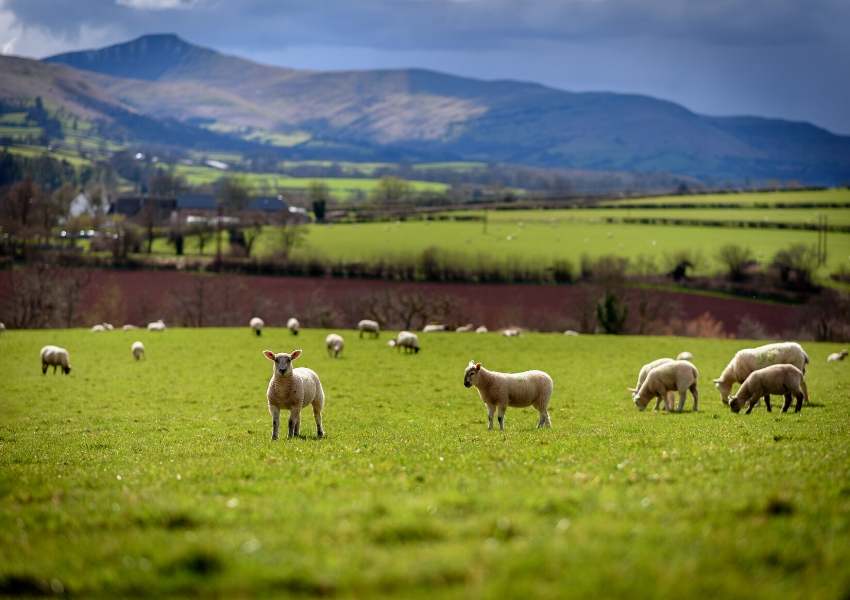
If you wish to visit Northern Ireland when the temperatures are at their warmest, then go during July and August. The average temperature in the summer is 17°C (63°F), but beware because summertime is also when the country’s rainfall is at its peak.
The summer in Northern Ireland has amazingly long daylight hours, 5:00 a.m. to 10:00pm, so you’ll be able to pack in a lot of activities. It is the peak season, which means you’ll be fighting the crowds as you see the sights.
Also, keep in mind, summer vacations for their school children start a few weeks earlier than they do in England, meaning the tourist sites may be more crowded starting at the end of June.
In winter, Northern Ireland is a little colder than England and has about 7-8 hours of daylight. That won’t matter too much if you seek out Belfast’s St. George’s Market, Northern Ireland’s last surviving Victorian market. In December, they offer twilight days for evening shopping. There will also be crafts from local artisans, delightful food and family entertainment.
Like with the other UK regions, you get the best of everything by visiting in the spring or autumn. By late spring, you’ll start to see lambs and calves in the pastures as the temperatures rise to between 10°C (50°C) to 16°C (60°F).
Visit Rathlin Island in the late spring and you’ll see all kinds of nesting birds and the area’s famous puffins. Also, for those festival fans, check out the two-day Bushmills Salmon and Whiskey festiva l held in early June.
In the autumn, as the leaves are changing colors, it’s a perfect time to visit the Glens of Antrim, or known locally simply as The Glens. It’s a region of County Antrim known for it’s astonishing natural beauty.
In October, the Glens Storytelling Festival is a five-day event for tourists and locals alike to experience the magic of this area’s story telling traditions. Expect family-friendly stories to have a touch of Halloween magic.
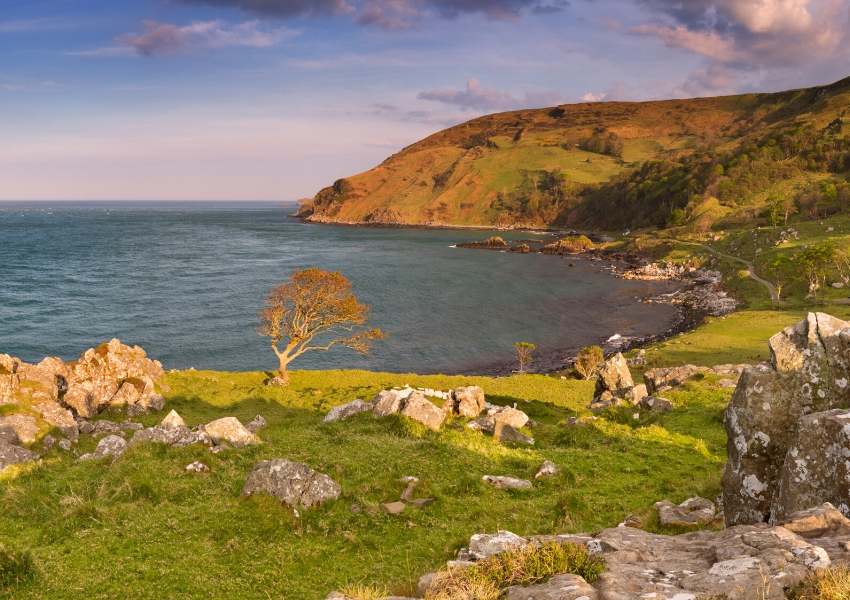
Which is the best month to visit the UK? Month by month pros and cons + guide to all the major events in the UK
❄️ Visiting the UK in winter
🌷 Visiting the UK in spring
☀️ Visiting the UK in the summer
🍂 Visiting the UK in autumn
🧣 Visiting Scotland in winter
January in the UK falls within the low tourist season, which creates some distinct advantages for travellers. Students return to school and the cold weather, gloomy skies and waning daylight translate into fewer people, cheaper hotel rooms and inexpensive airfare.
Also, the after-Christmas sales are in full swing, so bargain hunters will have a field day shopping. Theatre tickets and restaurant reservations will also be easier to get. A January trip is sounding better and better. Here are some fun things to do in January:
• New Year’s Day Parade in London —This is a fabulous, free and family-friendly parade in the city’s West End. It’s three and a half hours of music and revere that won’t soon be forgotten.
• Simplyhealth Great Edinburgh Winter Run— If you’re in Scotland and are a fitness buff, join 3000 other hardcore health nuts for this 5k of fun that also affords fantastic views of the city.
• Big Burns Supper in Dumfries Scotland— Part of the country’s Burns Night, this event occurs in the latter half of the month and offers all sorts of venues with everything from comedy to cabaret.
February in the UK falls securely within low season for travellers, but that doesn’t mean you can’t have an absolutely fantastic vacation if you choose to travel then. If you don’t mind cooler weather, the seaside towns should be virtually empty, for example.
Keep in mind that UK schools have a half-term break in February, which may cause unexpected crowds at tourist sites. Here are some fun things to do in February:
• V alentine’s Day in London —A visit to multiple artisan chocolate shops would definitely be in order, as would a romantic dinner for two in one of London’s many fine-dining restaurants.
• The Orchid Festival at London’s Kew Gardens —If you adore flowers and don’t want to travel all the way to Indonesia, then this show is not to be missed. There will be over 5000 species of orchids to admire.
• London’s Classic Car Show in Olympia Exhibition Centre —You’ll see some of the finest and most collectable vintage models in the world.
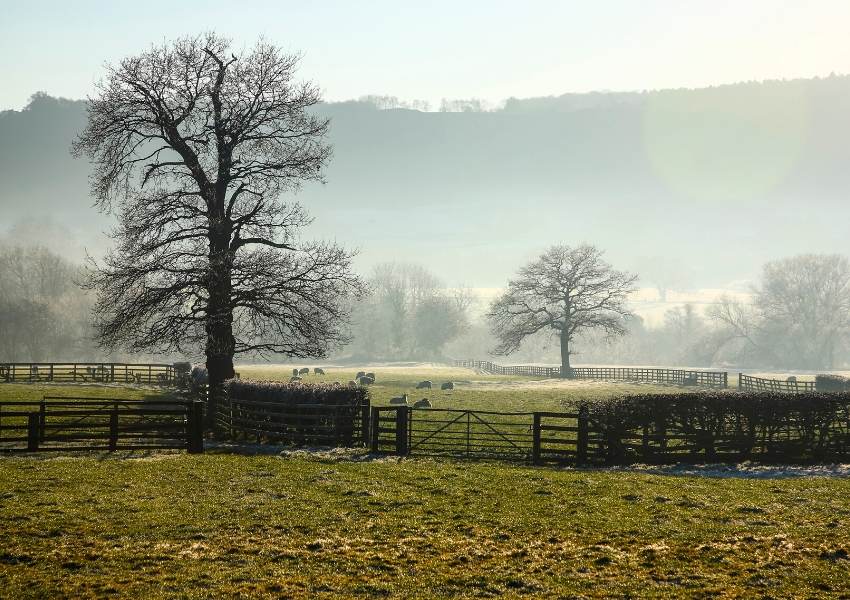
Flowers will be just beginning to bloom throughout the UK, a promise that spring is just around the corner.
March is a shoulder season for tourists, which means it’s not too busy and not too light. So you can throw on a coat and start taking advantage of some of the outdoor fun that the UK has to offer. Here are some fun things to do in March:
• Oxford and Cambridge Boat Race in London — When is the best time to travel to England? When there are 250,000 screaming rowing fans cheering on the edge of the Thames. This is one of the largest sporting events held in London and it’s free! (Sometimes this event happens in April, so check online to see.)
• Glasgow International Comedy Festival —Are you a comedy fan? In the latter half of March, travel to Scotland and see the funniest stars from all around the UK hit the stage in what is Europe’s largest comedy festival.
• St. Patrick’s Day in Northern Ireland —On March 17th, County Armagh and County Down host the annual Home of Saint Patrick Festival that consists of concerts, family-friendly activities and general fun.
Ah, April. The flowers are blooming and the days are getting longer. It’s a shoulder season, so it’s a pretty good time to enjoy the natural beauty that the UK has to offer without having to brave too many crowds.
Students in the UK have a school break around Easter, which usually falls in this month, so that may alter the tourist scene slightly. Regardless, there are also a lot of fun, local activities to choose from. Here are some examples:
• Isle of Wight Walking Festival —Fun for all ages and all fitness levels. Thousands of locals and tourists alike explore the island and take in its stark, scenic beauty.
• Shakespeare’s Birthday in Stratford-upon-Avon —Celebrate The Bard’s birthday by traveling to his birthplace for performances, music and all kinds of fun.
• Cardiff Flower Show —If you’re a gardener or a flower appreciator and are planning to be in Wales, you might want to visit the Royal Horticultural Society’s Cardiff Flower Show. There are countless exhibits and demonstrations to inspire and fascinate those with or without a green thumb.
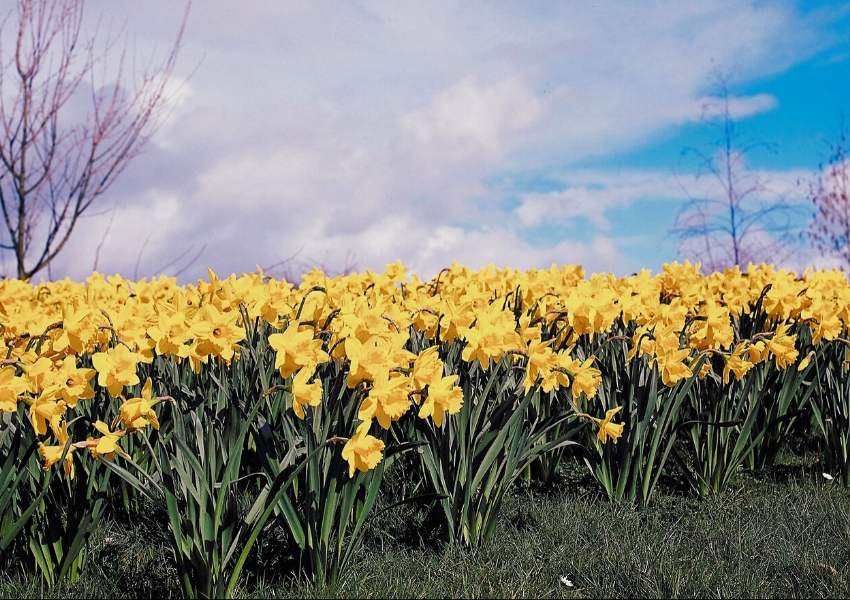
The weather is getting ever warmer and the days are getting longer in the UK, yet May is still a shoulder season, which means its an excellent time to visit. Things can get busy over the Bank holiday weekends with many Brits enjoying a spring staycation .
It’s also getting dryer, so rain may not be as much of an issue as it is in other months. Still, bring a few layers to wrap up in, just in case. Here are some fun things to do in May:
• Chelsea Flower Show – Since 1913, except during the two world wars, the famous Chelsea Flower Show has been a glamorous affair celebrating British flowers and garden design. It takes place on the grounds of the Royal Hospital in Chelsea and makes for a fun and historical activity whilst in the UK.
• Gloucester Docks Tall Ship Festival — Come see tall ships in all of their splendor along with fun and games for the whole family. There will be live stages with local bands as well as a food market
• Gordon Castle Highland Games and Country Fair – Join over 10,000 locals and tourists at Scotland’s only highland games and country fair. It’s at the magnificent Gordon Castle located near Fochabers in Moray.
The middle of June marks the beginning of peak season for traveling in the UK, so make sure you’ve got those reservations, tickets and bookings well ahead of time.
You have an excellent chance of pleasant weather and agreeable temperatures, so live it up! Here are some fun things to do in June:
• Glastonbury Festival — This world-famous five-day festival takes place in Pilton, Somerset, in the south west of England. It features big-name contemporary musical acts as well as dance, cabaret and theater.
• Gregynog Music Festival — Attention classical music lovers! In the gorgeous Welsh countryside in the village of Tergynon, you’ll find the oldest classical music festival in Wales, which attracts some of the world’s finest musicians.
• The Royal Highland Show — Scotland’s largest agricultural show put on by the Royal Highland and Agricultural Society of Scotland. Thousands of visitors come from all over the globe to see over 1000 exhibitors and scores of livestock. It’s in Ingliston, an area of West Edinburgh.

July is peak travel season with very long days and probably the best weather offered by the UK. Restaurants will be jam-packed and tourist sites will be overflowing with visitors.
Add in the students who have just been released from school on summer break and you will have a lot of people to contend with. No wonder there is a lot going on the UK during the summer! Here are some examples:
• Wimbledon — In a town called Wimbledon, there’s a little yearly tennis tournament. Actually, it’s probably the most major tournament in the tennis world.
Good to know – If you want to do it on the cheap, go outside the stadium to Henman Hill and buy a £30 ticket to watch the matches on a giant TV. If you want the real thing, then you’ll need to shell out quite a bit more, depending on which match you see.
• The Big Cheese at Caerphilly — History buffs, would you like to be sent back to medieval days at Caerphilly Castle ? See reenactments and battles, along with entertainment, food, period dance and a whole lot of fun.
The weather is warm, so that distracts you from the peak season crowds traveling throughout the UK. All schools are enjoying summer break, so expect to be shoulder to shoulder with locals and tourists alike at all the tourist sites.
Here are some fun things to do in August:
• Wilderness Festival —Located in Oxfordshire’s Cornbury Park, this festival offers easy-going music, theatrical productions, amazing food and really cool art, all in a gorgeous lakeside setting.
• Edinburgh Fringe Festival — If you like crowds, music and having serious fun, then try out the Edinburgh Fringe Festival, the world’s largest arts festival. It goes on for days and hosts so much talent, it takes hundreds of venues just to fit everything in. Check their website to see the list of performers.
• The National Eisteddfod — A festival celebrating all things Welsh . It’s in the first 8 days of August and there is food, music, arts and design.

The beginning of September is part of the summer peak season but with the end of summer and beginning of autumn, the rest of the month is a shoulder season.
Most students head back to school early in September, so vacationers return home and tourist sites will be less crowded. Here are some fun things to do in September:
• The Jane Austen Festival — Do you dream of spending a quiet evening with Mr. Darcy or Elizabeth Bennet? Travel to Bath and spend 10 days choosing from over 80 Jane Austen-related events. There’s even a Regency Costumed Masked Ball!
• Culture Night Belfast – For the past several years, in the second half of September, people hit the Belfast streets from City Hall to the Cathedral Quarter to enjoy a free celebration of art, language and history of Northern Ireland. There is something to do for all ages.
There’s a crisp autumn chill in the air and Halloween ghosts and goblins are just around the corner. The beginning of October is a shoulder season, and by the end, it slows down into low season. Still, there are lots of interesting things to tackle in the UK during October.
• Harwich International Shanty Festival – For those who can’t resist the call of that salty ocean air, sail on over to Harwich and sing an old song of the sea. There’ll be concerts and barge trips and crafts for the saltiest old sailors to the youngest of landlubbers.
• The Callander Jazz and Blues Festival — Who doesn’t enjoy jazz in a charming rural setting? In 2006, this festival was born and has grown larger every year. It’s a long weekend of all types of music in a variety of venues. You’ll see live blues, jazz, boogie and soul from a huge variety of artists.

This is the low season for travel in the UK. The weather is brisk and it’s best to remember to bring a bunch of comfy layers and a jacket in your suitcase. Here are some fun things to do in November:
• Guy Fawkes Night —This celebration marks the night back in 1605 when Guy Fawkes tried to blow up the Houses of Parliament. He did not succeed, and the anniversary has traditionally been remembered with a bonfire. Given that could easily get out of hand, most celebrations have switched to fireworks.
• Diwali on Trafalgar Square – Diwali is the festival of lights celebrated by Hindu, Jain and Sikh people all over the world. This one is the biggest in the UK and features amazing dancers in stunningly beautiful and colorful dress. Expect to see market stalls with amazing food, as well as crafts and fun activities for the whole family.
Yes, it’s pretty chilly in the UK during December, and the days have grown a wee bit short. There’s still a lot to love about this winter month. Keep in mind, that students in the UK usually have the final weeks in December off, so that could affect the crowd levels.
The weeks closest to Christmas are considered a peak tourist season, so there are many Christmas activities to choose from including festive markets all over the UK.
• Belfast Giants Ice Hockey — For something really different, grab the whole family, live like a local and check out an ice hockey game. Their website has all the information about tickets and times.
• Elfingrove at the Kelvingrove Art Gallery and Museum —This magnificent museum in Glasgow transforms itself and offers night-time tours along with local food and singing.
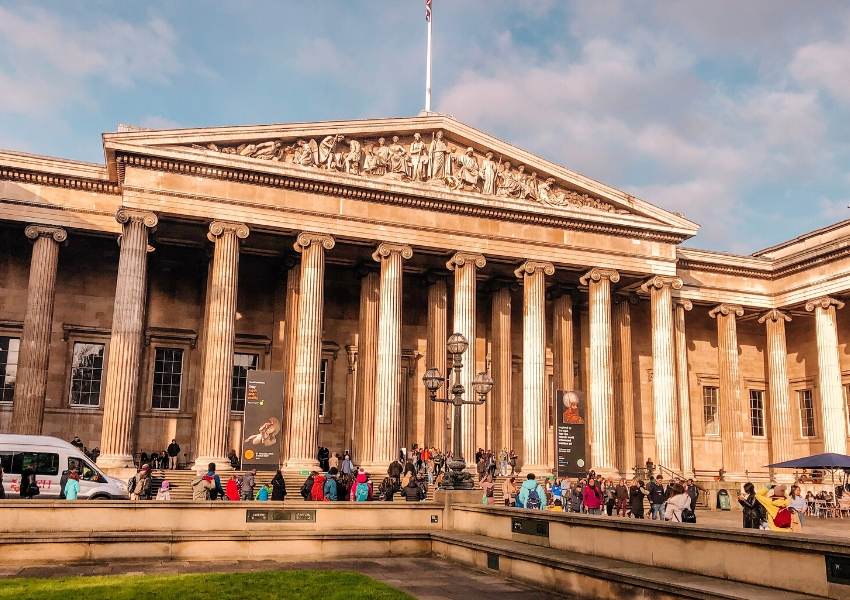
This is really a difficult question to answer and really deserves a post all of its own.
Many people insist that it’s Christmas. Trafalgar Square has a giant lit up Christmas tree dripping in ornaments and Christmas cheer. Carol singing and festive events occur all throughout London.
There are several London Christmas Markets that will surely take care of everyone on that Christmas list. There are also a number of festive events held annually around Christmas at many of the castles near London.
But in summer the hours of daylight are longer and exploring London’s attractions on a warm sunny day is also a wonderful experience.
To be honest for me deciding when to visit London is best answered with the words “it is always a good idea!”
Read more – Visiting London in winter | 21 Festive things to do and see in London in December | 29 Things to do in London in Spring | Guide to visiting London in Fall

So the only true answer to the question, “When is the best time to go to England, Scotland, Wales or Northern Ireland?” really does depend on your own interests and available time to go.
Once you have settled on the time of year to visit the UK you are now ready to start planning your trip itinerary.
My UK Trip Planner will help you to plan the perfect UK vacation in 10 easy to follow steps – I recommend starting there!
For UK inspiration my top 21 landmarks in England , 19 places to visit in Scotland , top 10 things to see in Wales , top 10 things to do in Northern Ireland and London bucket list articles are great places to start.
I recommend prioritising what you want to see and do. You can also take some virtual tours of London and UK landmarks and sights to help you plan.
Other useful resources to help you plan your trip:
- How much does a holiday in the UK cost? Read my UK travel budget guide to help calculate your budget!
- Choose from my selection of the best guidebooks for UK travel
- Click here for my recommendations of the best booking sites for travel to the UK
- Prefer an organised tour? Check out our recommendations of the best UK tours available for 2021 and beyond!
- How to get around the UK (Complete Guide to Transportation in the UK)
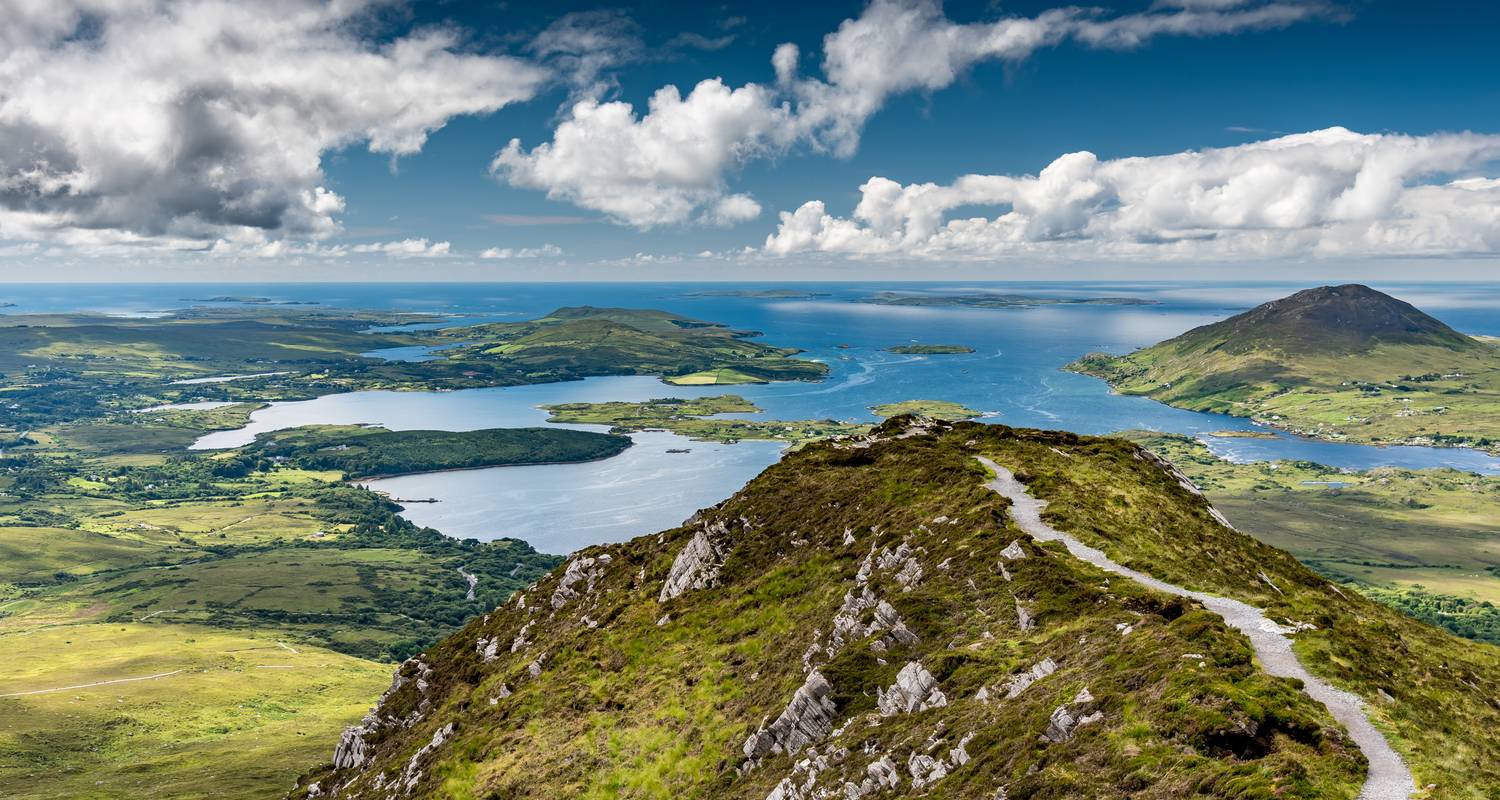
England and Ireland Tours & Trips
- Choose from 50+ England and Ireland tours
- 1,500+ verified reviews from TourRadar travelers
- 24/7 customer support
10 best England and Ireland tour packages
Compiled by

Nina England and Ireland travel expert at TourRadar
England, Scotland and Ireland end Dublin
Aonghus youth, essential britain & ireland, best of uk & ireland, wonders of britain and ireland (12 days), britain and ireland experience (12 days), britain and ireland panorama (16 days), the best of britain & ireland, romantic britain & ireland (classic, 18 days), from the shannon to the thames.

- In-depth Cultural
“As the one year anniversary approaches, I wish I could do this trip again!”

- Christmas & New Year
“Our Tour Guide Bella was fantastic, and our driver excellent. My only complaint would be that communication was poor prior to arrival.”
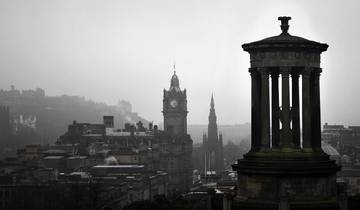
- Coach / Bus
- See the best of Ireland and Britain
- Visit the legendary Cardiff Castle and Edinburgh Castle
- Explore architectural remains and energetic cities
“They were organized, professional, intelligent, and approachable.”
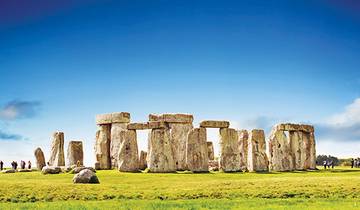
- Marvel at the Cliffs of Moher and the magnificent Giant's Causeway
- Tours of Belfast, Edinburgh, Liverpool and Dublin
- Drive through the iconic Scottish Highlands and visit the shores of Loch Ness
“The highest standard that would certainly not be matched. He used his knowledge together with fun explanations.”

- Gaze at the pristine natural beauty of the Lake District
- Fall in love with the rich medieval history of Edinburgh
- Admire the ancient stone circle at the Stonehenge
“First trip hard to compare. Suited us fine.”

- Explore the picturesque countryside of Britain and Ireland
- Visit the birthplace of the legendary William Shakespeare
- Marvel at the waters and mountains of the Lake District
“Greg made this a wonderful experience. He is one of the most organised, & factually correct guides we could have hoped for.”

“Everything about the trip was good, including the weather, and Greg even influenced that.”
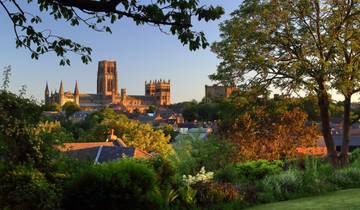
“A great way to see the highlights of Britain and Ireland.”
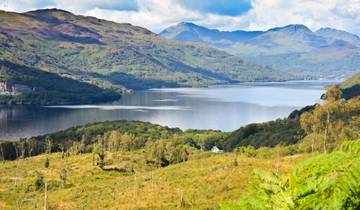
“The bus tour is the only way to see the sites we visited. Overall it was a very good tour.”
Discover TourRadar
Winter is here! Check out the winter wonderlands at these 5 amazing winter destinations in Montana
- Travel Destinations
How To Plan A Trip To England, Ireland, And Scotland
Published: December 2, 2023
Modified: December 28, 2023
by Eryn Dozier
- Plan Your Trip
- Travel Guide
- Travel Tips
Introduction
Planning a trip to England, Ireland, and Scotland is an exciting endeavor that promises breathtaking landscapes, rich history, and vibrant cultures. These three countries, each with its own unique charm and attractions, offer a multitude of experiences for both first-time visitors and seasoned travelers.
From the iconic landmarks of London to the rugged beauty of the Scottish Highlands and the enchanting landscapes of Ireland, this journey will immerse you in a world of ancient castles, bustling cities, picturesque villages, and awe-inspiring natural wonders.
Before embarking on your adventure, it’s important to conduct thorough research and make necessary preparations to ensure a smooth and enjoyable trip. From choosing the right time to visit to organizing transportation and selecting accommodations, proper planning will help you make the most of your time in these captivating destinations.
During your trip, you’ll have the opportunity to explore historic sites, indulge in local cuisine, participate in cultural events, and engage in a variety of outdoor activities. Whether you’re a history enthusiast, a nature lover, or a food connoisseur, there’s something for everyone in England, Ireland, and Scotland.
As you immerse yourself in the local culture, you’ll discover that each country has its own distinct character and traditions. From the friendly people of Ireland to the proud Scots and the cosmopolitan vibe of England, you’ll experience the warmth and hospitality that these nations are known for.
In this comprehensive guide, we will delve into vital aspects of planning a trip to England, Ireland, and Scotland. We will cover everything from choosing the right time to visit and getting around to must-visit destinations, outdoor activities, local cuisine, cultural events, and essential travel tips and etiquette.
So, pack your bags, set your itinerary, and get ready for a once-in-a-lifetime journey through the breathtaking landscapes and captivating history of England, Ireland, and Scotland.
Research and Preparations
Before embarking on your trip to England, Ireland, and Scotland, it’s essential to conduct thorough research and make appropriate preparations to ensure a smooth and enjoyable visit. Here are some key steps to help you get started:
1. Destination research: Begin by researching the main attractions, landmarks, and cities you wish to visit in each country. Consider the historical significance, natural beauty, and cultural experiences that interest you the most. This will help you create an itinerary that covers your preferred destinations.
2. Visa requirements: Check the visa requirements for your country of residence before traveling to England, Ireland, and Scotland. Ensure that your passport is valid for the duration of your trip and meets the entry requirements of all three countries.
3. Weather considerations: Take into account the weather patterns and seasons of the countries you plan to visit. Check the average temperatures, rainfall, and any extreme weather events that may affect your travel plans. Pack suitable clothing and accessories accordingly.
4. Budget planning: Determine your budget for the trip and research the costs of accommodation, transportation, meals, activities, and souvenirs in each country. This will help you plan your expenses and allocate funds accordingly.
5. Health and safety: Review the necessary vaccinations and health precautions for traveling to England, Ireland, and Scotland. Consult with your healthcare provider for any specific recommendations and ensure you have travel insurance that covers medical emergencies and trip cancellations.
6. Language and communication: While English is widely spoken in all three countries, it’s beneficial to familiarize yourself with basic greetings and phrases in the local languages. This will enhance your interactions with locals and contribute to a more immersive experience.
7. Currency exchange and banking: Research the local currencies and exchange rates for England, Ireland, and Scotland. Determine the most convenient and cost-effective methods for accessing money during your trip, such as using ATMs or acquiring a travel card.
8. Cultural etiquette: Familiarize yourself with the cultural etiquette and customs of each country. Learn about local norms, appropriate behavior, and dress codes to ensure you respect the local traditions and make a positive impression.
9. Travel documents: Ensure you have copies of your travel documents, including your passport, visa, and travel insurance. Keep both physical and digital copies in separate locations for extra security.
By conducting thorough research and making suitable preparations, you’ll be well-equipped to embark on your journey to England, Ireland, and Scotland. This will allow you to make the most of your trip and create unforgettable memories in these fascinating destinations.
Choosing the Right Time to Visit
When planning a trip to England, Ireland, and Scotland, choosing the right time to visit is crucial. Each country has its own unique climate, seasonal events, and tourist crowds that can greatly impact your experience. Here are some factors to consider when determining the best time to explore these captivating destinations:
1. Weather: The weather in England, Ireland, and Scotland can vary greatly throughout the year. If you prefer mild temperatures and longer days, consider visiting during the summer months of June, July, and August. However, keep in mind that these months are also the peak tourist season, so popular attractions may be crowded. Spring (March to May) and autumn (September to November) offer pleasant temperatures and beautiful scenery without the summer crowds.
2. Seasonal Events: Each country hosts a range of seasonal events and festivals that showcase their unique traditions and cultures. In England, you can experience the pomp and pageantry of the Changing of the Guard at Buckingham Palace or attend the renowned Wimbledon tennis tournament. In Ireland, you can immerse yourself in the lively atmosphere of St. Patrick’s Day celebrations or enjoy traditional music festivals like the Fleadh Cheoil. Scotland boasts the world-famous Edinburgh Festival and the Highland Games, where you can witness thrilling sports and traditional Scottish competitions. Research these events and factor them into your travel plans to make the most of your visit.
3. Outdoor Activities: If you’re interested in exploring the stunning landscapes and engaging in outdoor activities, consider the specific activities you wish to pursue. For hiking and exploring the countryside, the months of May to September offer longer daylight hours and milder temperatures. However, for winter sports enthusiasts, visiting during the winter months allows you to enjoy activities such as skiing in the Scottish Highlands or snowboarding in the Cairngorms National Park.
4. Budget: The time of year you visit can also impact your budget. Peak tourist seasons, especially during the summer months, often result in higher prices for accommodations, flights, and attractions. If you have a more flexible budget, visiting during the shoulder seasons or off-peak periods can provide potential cost savings.
5. Personal Preferences: Consider your personal preferences and interests when selecting the best time to visit. Are you drawn to festive holiday celebrations or do you prefer quieter periods with fewer crowds? Are you willing to brave unpredictable weather for unique experiences? Reflect on what matters most to you and plan accordingly.
Ultimately, the best time to visit England, Ireland, and Scotland depends on your individual preferences and priorities. Whether you’re seeking vibrant cultural events, mild weather for outdoor activities, or a quieter and more affordable travel experience, careful consideration of these factors will help you choose the ideal time to embark on your journey.
Getting Around
When traveling to England, Ireland, and Scotland, getting around efficiently and comfortably is essential for a successful trip. Here are some transportation options to consider:
1. Flights: If you’re coming from international destinations or prefer to cover long distances quickly, flying is a convenient option. Major cities like London, Dublin, and Edinburgh have well-connected international airports, making it easy to access different regions of each country. Domestic flights are also available to reach smaller cities or islands.
2. Trains: The train network in England, Ireland, and Scotland is extensive and efficient, providing a comfortable and scenic way to travel between cities. In England, the National Rail network offers high-speed trains connecting major cities like London, Manchester, and Birmingham. In Ireland, Irish Rail provides service across the country, while in Scotland, ScotRail offers connections from Glasgow and Edinburgh to other destinations.
3. Buses and Coaches: Buses and coaches are an affordable option for traveling within and between cities. In England, National Express offers coach services that cover a wide range of destinations, while Megabus provides budget-friendly options. In Ireland, Bus Éireann and Citylink operate bus services connecting major cities and towns. In Scotland, you can rely on the extensive bus network provided by companies like Stagecoach and Citylink.
4. Car Rental: Renting a car can give you the freedom to explore at your own pace and reach more remote areas. All three countries have well-maintained road networks, but it’s important to familiarize yourself with local driving regulations and remember that in the UK and Ireland, you’ll be driving on the left side of the road.
5. Ferries: If you plan to visit islands such as the Isle of Skye or the Aran Islands, ferries are a popular mode of transportation. Ferries operate between various locations, including mainland ports and island destinations. Consider booking in advance, especially during peak seasons, to secure a spot.
6. Public Transportation: Public transportation, including buses and trains, is readily available within cities and urban areas. In London, the extensive Underground (Tube) and bus network make it easy to navigate the city. Dublin and Edinburgh also have reliable bus and rail services, allowing you to explore these vibrant capitals efficiently.
It’s important to check transportation schedules, plan your routes in advance, and consider purchasing travel passes or cards that offer discounted fares for multiple journeys. Each country may have different options, such as the Oyster card in London or the Leap card in Dublin.
Remember to factor in travel time, especially when covering long distances. Consider spending a few days in each location to fully immerse yourself in the local culture and attractions.
By utilizing the various transportation options available, you’ll have the flexibility to explore the diverse landscapes and vibrant cities of England, Ireland, and Scotland, ensuring a memorable and hassle-free journey.
Accommodation Options
When planning your trip to England, Ireland, and Scotland, choosing the right accommodation is essential for a comfortable and enjoyable stay. From luxurious hotels to cozy bed and breakfasts, there are various options to suit different budgets and preferences. Here are some popular accommodation options to consider:
1. Hotels: All three countries offer a wide range of hotels, from budget-friendly options to luxury establishments. Major cities like London, Dublin, and Edinburgh have a plethora of internationally renowned hotels that provide top-notch amenities and services. Look for hotels located centrally or near public transportation for convenient access to attractions and dining options.
2. Bed and Breakfasts: Bed and Breakfasts (B&Bs) provide a more intimate and cozy accommodation experience. They are typically family-run establishments that offer comfortable rooms and a home-like atmosphere. B&Bs are particularly popular in rural areas, allowing visitors to experience the charm of the countryside.
3. Guesthouses: Similar to B&Bs, guesthouses offer a comfortable and personalized stay. They often have a limited number of rooms and are typically run by the owners, ensuring a warm and hospitable environment. Guesthouses can be found in both urban and rural areas, offering a quaint and local experience.
4. Self-Catering Accommodations: If you prefer a more independent and flexible stay, self-catering accommodations such as apartments, cottages, and holiday homes are a great option. These fully furnished accommodations come with kitchen facilities, allowing you to cook your meals and have a more immersive experience in the local community.
5. Hostels: For budget-conscious travelers or those looking to meet fellow adventurers, hostels are a popular choice. Hostels offer dormitory-style rooms with shared facilities, making them an affordable option for solo travelers or groups. Many hostels also provide private rooms for those seeking more privacy.
6. Unique Stays: If you’re seeking a more memorable and unique experience, consider staying in boutique hotels, historic castles, or quirky accommodations like glamping sites or lighthouses. These options provide a one-of-a-kind experience and are perfect for special occasions or those wanting to add a touch of adventure to their trip.
When choosing accommodation, consider factors such as location, amenities, and reviews from previous guests. Research popular booking platforms, local tourism websites, and review sites to find the best deals and compare options.
It’s advisable to book well in advance, especially during peak tourist seasons and for popular destinations. This ensures you secure your preferred accommodation and potentially benefit from early bird discounts.
With the diverse range of accommodation options available in England, Ireland, and Scotland, you can find the perfect place to relax and recharge after a day of exploring the stunning landscapes and vibrant cities.
Must-Visit Destinations in England
England is a country rich in history, culture, and stunning landscapes. From iconic landmarks to picturesque countryside, here are some must-visit destinations to include in your itinerary:
1. London: Start your journey in the vibrant capital city of London, home to world-famous attractions such as the Tower of London, Buckingham Palace, and the British Museum. Explore the bustling streets of Covent Garden, take a stroll along the River Thames, and immerse yourself in the diverse culinary scene.
2. Stonehenge: Journey to the mystical prehistoric monument of Stonehenge, located in Wiltshire. Marvel at the ancient stone circle and ponder its mysterious origins and significance. Visit the visitor center to learn more about its history and explore the surrounding landscape.
3. Bath: Explore the historic city of Bath, known for its Roman-built baths and stunning Georgian architecture. Take a dip in the thermal waters of the Roman Baths, stroll along the grand Royal Crescent, and visit the impressive Bath Abbey.
4. Oxford: Discover the world-renowned university city of Oxford, famous for its prestigious colleges and captivating history. Take a guided tour of the historic colleges, visit the Bodleian Library, and explore the charming streets lined with bookstores and cafes.
5. Cambridge: Visit the picturesque city of Cambridge, home to one of the world’s top universities. Explore the stunning college buildings, take a punting tour along the River Cam, and visit the remarkable King’s College Chapel.
6. The Lake District: Head to the Lake District National Park, a breathtaking region of mountains, lakes, and charming villages. Take a boat ride on Lake Windermere, hike through the stunning landscapes, and visit the homes of famous poets like William Wordsworth and Beatrix Potter.
7. Stratford-upon-Avon: Pay a visit to the birthplace of William Shakespeare in the picturesque town of Stratford-upon-Avon. Explore Shakespeare’s childhood home, watch a play at the Royal Shakespeare Theatre, and stroll along the idyllic River Avon.
8. York: Step back in time in the historic city of York, known for its well-preserved medieval walls and narrow cobbled streets. wander through the winding alleyways of the Shambles, visit the magnificent York Minster, and learn about the city’s Viking past at the Jorvik Viking Centre.
9. Liverpool: Immerse yourself in the vibrant music and cultural scene of Liverpool, the birthplace of The Beatles. Visit The Beatles Story museum, explore the historic Albert Dock area, and soak in the lively atmosphere of Mathew Street.
10. The Cotswolds: Experience quintessential English charm in the picturesque region of the Cotswolds. Visit honey-colored stone villages like Bourton-on-the-Water, stroll through the Cotswold Way, and enjoy traditional afternoon tea in a charming tea room.
These are just a few of the countless enchanting destinations in England. Whether you’re drawn to bustling cities, historic landmarks, or idyllic countryside, England offers a wealth of experiences that will leave you captivated and inspired.
Exploring Ireland’s Highlights
Ireland is a country of breathtaking landscapes, rich history, and lively culture. From ancient castles to stunning coastlines, here are some of the highlights to explore during your visit to the Emerald Isle:
1. Dublin: Start your Irish adventure in the vibrant capital city of Dublin. Explore the historic Trinity College, home to the Book of Kells, stroll along the lively Temple Bar area, and visit the Guinness Storehouse to learn about Ireland’s famous stout.
2. Ring of Kerry: Journey along the scenic Ring of Kerry, a 179-kilometer route showcasing some of Ireland’s most awe-inspiring landscapes. Marvel at the rugged mountains, pristine lakes, and picturesque coastal villages that dot the route.
3. Cliffs of Moher: Witness the dramatic beauty of the Cliffs of Moher, one of Ireland’s most iconic natural landmarks. Standing 214 meters above the Atlantic Ocean, the cliffs offer breathtaking views of the Atlantic coastline and distant Aran Islands.
4. Galway: Immerse yourself in the bohemian atmosphere of Galway, a lively city known for its vibrant music scene and charming streets. Explore the colorful Latin Quarter, visit Galway Cathedral, and stroll along the picturesque Salthill Promenade.
5. Giant’s Causeway: Head north to County Antrim and marvel at the geological wonder of the Giant’s Causeway. This UNESCO World Heritage Site features approximately 40,000 interlocking basalt columns, creating a surreal and awe-inspiring sight.
6. Killarney National Park: Venture into the stunning Killarney National Park, famous for its pristine lakes, majestic mountains, and ancient woodlands. Take a boat ride on the tranquil lakes of Killarney and explore the park’s diverse flora and fauna.
7. Dingle Peninsula: Take a scenic drive along the beautiful Dingle Peninsula, known for its rugged coastline and picturesque villages. Visit the charming town of Dingle, encounter ancient archaeological sites, and enjoy panoramic views of the Atlantic Ocean.
8. Belfast: Cross over to Northern Ireland and visit the vibrant city of Belfast. Explore the historic Titanic Quarter, learn about the city’s troubled past at the Titanic Belfast museum, and admire the stunning architecture of Belfast City Hall.
9. Connemara National Park: Discover the rugged beauty of Connemara National Park, located in County Galway. Hike through the scenic landscapes, visit the Kylemore Abbey, and take in the awe-inspiring views of mountains, lakes, and bogs.
10. Rock of Cashel: Visit the Rock of Cashel, a medieval fortress perched on a limestone outcrop in County Tipperary. Explore the ancient ruins, including the impressive Cormac’s Chapel and the round tower, and learn about its historical and cultural significance.
These are just a few of the countless highlights that Ireland has to offer. From its bustling cities to its scenic countryside, Ireland’s charm and beauty will leave you mesmerized and eager to explore more of this captivating country.
Discovering Scotland’s Charm
Scotland is a land of rugged landscapes, ancient castles, and rich traditions. From historic cities to breathtaking Highlands, here are some of the highlights that showcase the charm of Scotland:
1. Edinburgh: Start your exploration in the capital city of Edinburgh. Discover the imposing Edinburgh Castle perched on Castle Rock, stroll along the historic Royal Mile, and enjoy panoramic views of the city from Arthur’s Seat. Don’t miss the famous Edinburgh Festival, which takes place in August and celebrates art, music, and culture.
2. Isle of Skye: Venture to the Isle of Skye, known for its dramatic landscapes of rugged mountains, sparkling lochs, and fairy-tale castles. Explore the mysterious Fairy Pools, marvel at the iconic Old Man of Storr rock formation, and visit the enchanting Dunvegan Castle.
3. Loch Ness: Embark on a journey to Loch Ness, famous for its mythical monster, Nessie. Take a boat tour across the dark and mysterious waters, visit the historic Urquhart Castle, and soak in the scenic beauty of the surrounding Highlands.
4. Glasgow: Visit the vibrant city of Glasgow, known for its thriving art and music scene. Explore the Kelvingrove Art Gallery and Museum, stroll along the vibrant Buchanan Street, and enjoy the eclectic mix of architectural styles found throughout the city.
5. Stirling: Discover the historic city of Stirling and its impressive Stirling Castle, once home to Scottish royalty. Visit the National Wallace Monument, dedicated to the national hero William Wallace, and learn about Scotland’s pivotal role in its fight for independence.
6. The Highlands: Explore the majestic Scottish Highlands, where you’ll find breathtaking landscapes of mountains, lochs, and glens. Take a scenic drive along the North Coast 500, hike through the stunning Glen Coe, and enjoy the tranquility of the Cairngorms National Park.
7. Isle of Arran: Journey to the charming Isle of Arran, often referred to as “Scotland in Miniature” due to its diverse range of landscapes. Discover ancient castles, picturesque villages, and enjoy outdoor activities like hiking, cycling, and golfing.
8. Isle of Mull: Visit the beautiful Isle of Mull, where you can explore picturesque coastal villages, pristine beaches, and diverse wildlife. Take a ferry to the colorful town of Tobermory, visit the historic Duart Castle, and embark on a wildlife-spotting adventure to see eagles, seals, and whales.
9. The Cairns of Brodgar: Journey to Orkney and marvel at the prehistoric complex of the Cairns of Brodgar. Discover the stone circle and ancient burial mounds, and explore the fascinating archaeological sites that provide insights into Scotland’s ancient past.
10. Scottish Whisky Distilleries: Indulge in Scotland’s renowned whisky culture by visiting one of the many distilleries scattered throughout the country. Take a tour to learn about the whisky-making process, sample different varieties, and appreciate the craftsmanship behind this national drink.
With its captivating landscapes and rich history, Scotland offers a majestic adventure that will leave you enchanted by its charm and eager to discover more of its hidden gems.
Outdoor Activities and Sightseeing Opportunities
England, Ireland, and Scotland offer a plethora of outdoor activities and sightseeing opportunities for nature lovers and adventure seekers. From hiking through majestic landscapes to exploring ancient ruins, here are some of the top outdoor activities and sightseeing opportunities to consider during your trip:
1. Hiking: Lace up your boots and explore the numerous hiking trails that wind through the stunning scenery of these countries. In England, the Lake District and the Peak District offer breathtaking hikes, while Ireland’s Wicklow Mountains and Scotland’s West Highland Way showcase majestic beauty.
2. Coastal Walks: Immerse yourself in the dramatic coastal landscapes by embarking on scenic walks. From Ireland’s rugged Cliffs of Moher to Scotland’s picturesque North Coast 500 route and England’s stunning South West Coast Path, there are endless coastal vistas to discover.
3. Cycling: Rent a bicycle and pedal your way through picturesque countryside and charming villages. Explore the rolling hills of the Cotswolds, traverse the scenic Ring of Kerry in Ireland, or cycle along Scotland’s scenic lochs and glens, such as Loch Lomond and the Trossachs National Park.
4. Water Sports: Embrace the coastal locations by engaging in various water sports activities. Try your hand at surfing along Ireland’s Wild Atlantic Way, go sea kayaking in Scotland’s Loch Ness, or enjoy paddleboarding in the serene waters of England’s Cornwall.
5. Wildlife Watching: England, Ireland, and Scotland boast diverse ecosystems and abundant wildlife. Look out for opportunities to spot puffins on the Skellig Islands, dolphins in the Moray Firth, and red deer in the Scottish Highlands.
6. Archaeological Sites: Delve into the rich history of these countries by exploring archaeological sites. Visit ancient Stonehenge in England, the ancient city of Newgrange in Ireland, and the standing stones of Calanais in Scotland.
7. Castle Exploration: Journey back in time by visiting majestic castles. Explore the grandiose Windsor Castle in England, the historic Blarney Castle in Ireland, and the awe-inspiring Edinburgh Castle in Scotland.
8. National Parks: England, Ireland, and Scotland are home to stunning national parks that showcase the natural beauty of each country. Explore the enchanting forests of the New Forest in England, the serene landscapes of Killarney National Park in Ireland, and the wild and rugged Cairngorms National Park in Scotland.
9. Garden Tours: These countries boast beautiful gardens that are a delight for plant enthusiasts and nature lovers. Explore the world-renowned Kew Gardens in London, stroll through the stunning Powerscourt Gardens in Ireland, or wander the vibrant Royal Botanic Garden in Edinburgh.
10. Heritage Sites: Expand your cultural horizons by visiting UNESCO World Heritage Sites. Explore the historic City of Bath in England, the prehistoric sites of Brú na Bóinne in Ireland, and the Old and New Towns of Edinburgh in Scotland.
With a wide range of outdoor activities and sightseeing opportunities, these countries offer endless possibilities to immerse yourself in the beauty of nature, uncover fascinating history, and create unforgettable memories during your trip.
Local Cuisine and Dining Experiences
Exploring the local cuisine is an essential part of any trip to England, Ireland, and Scotland. From traditional dishes to contemporary fusion, these countries offer a wide array of culinary delights that will tantalize your taste buds. Here are some highlights of the local cuisine and dining experiences to savor during your journey:
1. Full English Breakfast: Start your day with a hearty Full English Breakfast. This classic dish typically includes eggs, bacon, sausages, baked beans, grilled tomatoes, black pudding, and toast. Vegetarian and vegan options are also widely available.
2. Irish Stew: In Ireland, savor a comforting bowl of Irish Stew. Made with slow-cooked lamb or beef, potatoes, onions, carrots, and herbs, this traditional dish is known for its rich flavors and wholesome ingredients.
3. Fish and Chips: Indulge in the quintessential British treat of Fish and Chips. Enjoy crispy battered fish, usually cod or haddock, served with golden fries. Don’t forget to add a sprinkle of salt and vinegar for an authentic experience.
4. Haggis: In Scotland, be sure to try haggis, a traditional dish made from minced sheep’s offal, oatmeal, onions, and spices. Enjoy it with neeps (turnips) and tatties (mashed potatoes) for a truly Scottish dining experience.
5. Roast Dinner: Sundays are synonymous with a traditional Roast Dinner in England. This beloved meal consists of roasted meat (often beef, lamb, or chicken), accompanied by Yorkshire puddings, seasonal vegetables, roasted potatoes, and rich gravy.
6. Irish Soda Bread: Sample the delightful Irish Soda Bread, a traditional quick bread made with simple ingredients like flour, buttermilk, baking soda, and salt. Enjoy it with butter or served alongside hearty stews.
7. Scottish Shortbread: Treat yourself to a taste of Scotland with buttery Scottish Shortbread. This crumbly and rich biscuit, made with butter, sugar, and flour, is perfect with a cup of tea or as a sweet snack throughout the day.
8. Pub Culture: Immerse yourself in the vibrant pub culture of these countries. Visit traditional pubs to enjoy a pint of locally brewed beer or cider, along with classic pub fare like Scotch eggs, ploughman’s lunch, or bangers and mash.
9. Whisky Tasting: Scotland is renowned for its whisky, so take the opportunity to visit distilleries and partake in whisky tastings. Learn about the different regions and distillation processes while sampling a variety of single malts and blended whiskies.
10. Farm-to-Table Experiences: Embrace the farm-to-table movement by visiting local farmers’ markets and farm shops. Sample fresh produce, artisanal cheeses, homemade jams, and baked goods, supporting local producers while enjoying the flavors of the region.
Throughout your trip, also keep an eye out for regional specialties and delicacies. From Cornish pasties and sticky toffee pudding in England to Irish Guinness stew and Scottish cranachan, each country has its own unique dishes and treats to explore.
Remember to make reservations in advance for popular dining establishments, especially in larger cities, to secure a table and avoid disappointment. Indulging in the local cuisine and dining experiences is not only a gastronomic delight but also a way to immerse yourself in the culture and traditions of these fascinating countries. Enjoy the flavors and savor every bite!
Cultural Events and Festivals
England, Ireland, and Scotland are renowned for their vibrant cultural events and festivals, offering a delightful mix of traditions, music, dance, and celebrations. Immerse yourself in the local culture by experiencing some of these exciting events during your visit:
1. St. Patrick’s Day (Ireland): Celebrated on March 17th, St. Patrick’s Day is a lively and colorful festival that honors Ireland’s patron saint. Experience parades, traditional music, dance performances, and vibrant street festivities in cities like Dublin, Cork, and Galway.
2. Edinburgh Festival (Scotland): Held during the month of August, the Edinburgh Festival is a world-renowned celebration of the arts. Enjoy a diverse range of performances, including theater, music, dance, comedy, and visual arts, filling the streets, theaters, and venues across the city.
3. Glastonbury Festival (England): Known as one of the world’s largest and most iconic music festivals, Glastonbury takes place in Somerset annually. Enjoy a lineup of renowned artists, immerse yourself in the vibrant atmosphere, and camp out for a few days of non-stop live music and entertainment.
4. Galway International Arts Festival (Ireland): Celebrating music, theater, visual arts, and street performances, the Galway International Arts Festival is a two-week extravaganza held in July. Experience a vibrant blend of local and international talent in one of Ireland’s most cultural cities.
5. Royal Ascot (England): Experience the excitement and elegance of Royal Ascot, one of the most prestigious horse racing events in the world. Dress in your finest attire, enjoy the races, and take part in the high-spirited atmosphere that permeates this iconic event.
6. Highland Games (Scotland): Witness the pageantry and tradition of the Highland Games, a series of events held throughout Scotland from May to September. Enjoy feats of strength, bagpipe music, traditional dance competitions, and spectacular displays of Scottish culture in locations such as Braemar, Crieff, and Inverness.
7. Notting Hill Carnival (England): Join one of the largest street festivals in Europe at the Notting Hill Carnival, held annually in London during the August Bank Holiday. Immerse yourself in the vibrant Caribbean culture with colorful parades, live music, dancing, and mouthwatering Caribbean cuisine.
8. Galway Oyster Festival (Ireland): Indulge in a celebration of seafood at the Galway Oyster Festival, held in late September. Enjoy oyster shucking competitions, culinary demonstrations, live music, and a lively atmosphere, all while savoring the finest oysters from Galway Bay.
9. Shakespeare’s Globe Theater (England): Experience the immortal words of William Shakespeare at the reconstructed Globe Theater in London. Enjoy a performance of one of the Bard’s plays in this iconic open-air amphitheater, where you can witness the plays as they were originally intended.
10. Burns Night (Scotland): Celebrate the life and poetry of Scotland’s national bard, Robert Burns, on January 25th at Burns Night. Enjoy a traditional Burns Supper, complete with haggis, poetry readings, live music, and Scottish dancing.
These are just some of the many cultural events and festivals that bring these countries to life throughout the year. Check local calendars, tourism websites, and event listings to plan your visit accordingly and immerse yourself in the rich cultural experiences that await you.
Essential Travel Tips and Etiquette
Traveling to England, Ireland, and Scotland offers a chance to immerse yourself in the vibrant cultures and stunning landscapes of these countries. To make the most of your trip, here are some essential travel tips and etiquette guidelines to keep in mind:
1. Respect Local Customs: Familiarize yourself with local customs, traditions, and etiquette. Respect sacred sites, follow dress codes when visiting religious or cultural sites, and always ask for permission before taking photos of people or private property.
2. Greetings and Politeness: When meeting locals, a polite greeting and a friendly demeanor are appreciated. In England and Scotland, a handshake is common, while in Ireland, a warm smile and a friendly “hello” are commonly exchanged. It’s always polite to use “please” and “thank you” in interactions.
3. Tipping: Tipping is customary in restaurants, bars, and for services like taxis or tour guides. In general, a tip of around 10-15% of the bill is appropriate. However, check if a service charge has already been included before tipping.
4. Public Transportation: When using public transportation, have the exact fare or use contactless payment methods whenever possible. Be mindful of priority seating for elderly or disabled individuals, and remember to queue politely while boarding buses or trains.
5. Driving: If renting a car, familiarize yourself with local traffic laws and signage. In the UK and Ireland, remember to drive on the left side of the road. Be courteous to other drivers and follow speed limits, especially in rural areas where narrow roads can be challenging.
6. Weather Preparedness: The weather in these countries can be unpredictable, so be prepared for all conditions. Dress in layers, carry an umbrella, and have a waterproof jacket handy. Check weather forecasts before heading out for the day to plan accordingly.
7. Currency: In England, the currency is the British Pound (£), while in Ireland, it is the Euro (€), and in Scotland, both Pounds (£) and Scottish Pounds (£) are accepted. Carry some cash as not all places may accept cards, especially in remote areas.
8. Health and Safety: Prioritize your health and safety by taking out travel insurance that covers medical emergencies. Carry necessary medications and have a copy of your prescriptions. Be mindful of your surroundings, especially in crowded areas, and take precautions to guard against theft or pickpocketing.
9. Wi-Fi and Connectivity: Many hotels, restaurants, and cafes offer free Wi-Fi, but be cautious when using public networks. Consider using a Virtual Private Network (VPN) for added security when accessing the internet through public Wi-Fi.
10. Conservation and Environment: Respect the environment by practicing responsible tourism. Leave no trace, dispose of waste properly, and follow designated hiking trails. Support sustainable tourism initiatives and opt for eco-friendly activities whenever possible.
Remember, travel is an opportunity to learn, appreciate, and connect with different cultures. By respecting local customs, practicing good manners, and embracing the unique experiences these countries offer, you’ll create lasting memories and positive interactions with locals along the way.
A trip to England, Ireland, and Scotland promises an unforgettable journey through captivating landscapes, rich history, and vibrant cultures. From the bustling streets of London to the ancient ruins of Scotland and the picturesque villages of Ireland, these countries offer a diverse range of experiences for every traveler.
By conducting thorough research and making necessary preparations, you can ensure a smooth and enjoyable trip. Consider the best time to visit, plan your transportation, choose suitable accommodations, and familiarize yourself with local customs and etiquette.
Throughout your journey, indulge in the local cuisine, from traditional dishes to modern fusion creations. Explore the cultural events and festivals that showcase the vibrant traditions and artistic talents of these countries.
Engage in outdoor activities and sightseeing opportunities to immerse yourself in the stunning landscapes, ancient ruins, and natural wonders. Whether you’re hiking in the rugged Highlands, exploring historic castles, or meandering through charming villages, there is something for every interest and adventure-seeker.
As you navigate through England, Ireland, and Scotland, remember to respect local customs, be mindful of your surroundings, and practice responsible tourism. By doing so, you’ll not only have a positive impact on the destinations you visit but also create meaningful connections with the locals.
With careful planning, an open mind, and a spirit of adventure, your journey through these captivating countries will be filled with unforgettable experiences, breathtaking beauty, and a deeper understanding of their rich history and culture.
So pack your bags, embrace the beauty of these countries, and get ready for an extraordinary trip through the enchanting landscapes of England, Ireland, and Scotland.

- Privacy Overview
- Strictly Necessary Cookies
This website uses cookies so that we can provide you with the best user experience possible. Cookie information is stored in your browser and performs functions such as recognising you when you return to our website and helping our team to understand which sections of the website you find most interesting and useful.
Strictly Necessary Cookie should be enabled at all times so that we can save your preferences for cookie settings.
If you disable this cookie, we will not be able to save your preferences. This means that every time you visit this website you will need to enable or disable cookies again.
Best Time To Visit UK & Ireland
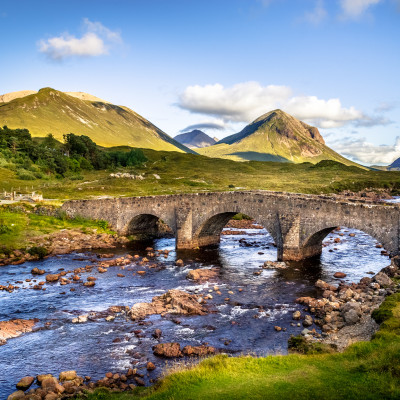
A handy guide to seasons in the UK & Ireland
It’s no secret that the British love to talk about the weather! Despite being a nation that can experience sun, rain and wind all in one day, it’s rare to see extreme conditions in the UK. A mild climate makes it possible to visit all year round, although summer is by far the most popular time.
What you hope to experience will likely influence when you book your trip. July through August is the busiest period, as it’s when locals are on vacation and when many big events and festivals take place. December is also one of the best times to visit the UK & Ireland thanks to festive markets and big New Year’s Eve celebrations in the cities.
Best Time To Visit
We recommend.
- Enjoy Edinburgh’s Hogmanay (New Years Eve)
- Celebrate Mark Burn’s Night in Scotland by eating haggis, enjoying a wee dram of whiskey and reciting poetry by Robert Burns
- Escape the chill at a spa retreat at Bath
- Celebrate St Patrick’s Day Festival on March 17 at Dublin, Ireland
- Witness the annual London marathon with 40,000+ participants
- Visit Ireland’s famous fortresses in Kilkenny and Killarney
- Sway to the rhythms of the Glastonbury Festival
- Witness outdoor theater performances and shows at the Greenwich and Docklands International Festival – London
- Watch the Wimbledon Tennis Tournament live in London
- Travel to Northamptonshire and watch the British Grand Prix
- Witness the Edinburgh Fringe Festival – the largest arts festival in the world
- See the sound systems and parade bands at the Notting Hill Carnival in London
- Witness the purple Scottish Heather blooms in the Highlands
- Sample authentic Scottish cuisine at Loch Lomond Festival
- Enjoy coastal walks and wild swimming in the Isle of Skye, Scotland.
- Celebrate Halloween in Derry with parades and fireworks
- See the night sky lit up on Guy Fawkes Day / Bonfire Night in England
- Witness the color, celebration, markets and fireworks at St Andrew’s Day Parade in Scotland
- Go ice skating at Somerset House in London, England
- Eat, drink and make merry at Christmas Markets
Climate in the UK and Ireland
Like most European regions, the UK – made up of England, Scotland, Wales and Northern Ireland – and Ireland, experience four distinct seasons. The warmest is between May and August when temperatures are usually around 70°F during the day. It’s possible for it to either be overcast or for there to be hot weather that lasts for several days. Spring is the most picturesque season, as you’ll see beautiful flowers blooming in fields and gardens across all five countries. Autumn is also a very colorful season and a pleasant time for a vacation, especially if the UK is having an ‘Indian Summer’, when the warmer weather lasts into September and October.
While the climate is similar throughout the UK & Ireland, there can be some differences depending on which region you choose to visit.
South England
London and England’s southern counties are typically warmer than the rest of the UK. They get some of the hottest weather during the summer and typically less snow in the winter.
Central and North England
As a general rule, it’s usually always cooler further north. Summers are milder and rain is common throughout the year. Fresh breezes are typical in coastal cities like Liverpool, while you’ll see snow in the middle of winter in more rural areas.
The smallest country in the British Isles is also a hotspot for hikers, thanks to its beautiful scenery and temperate weather. Temperatures never get too hot in the summer, but there can be a lot of rain around Snowdonia National Park .
Scotland typically has a cooler climate than the rest of the UK, however, you can still expect some warm days in the summer. It usually snows in the winter, especially in more mountainous regions. You’ll need to keep an eye on the forecast if you’re planning a trip to the Highlands or islands during this period.
In general, you’ll find Ireland has quite mild spring and autumn seasons, while winter brings icy conditions and often means many attractions are closed.
Northern Ireland
The weather here is very similar to neighboring Ireland, with July and August the hottest months. Summer can be quite humid, so late spring tends to be the best time to visit if you want fair yet comfortable weather. It can rain at any time in Northern Ireland cities like Belfast, although, due to coastal breezes, winters are usually mild.
What to Pack for UK and Ireland
If you’ve decided to visit the UK and Ireland in the summer, the slightly unpredictable climate means you should pack for every kind of weather just in case. Don’t forget sunscreen and a hat if you’re going to be outdoors, as the UV can be strong, even through clouds.
As rain can fall at any time of the year in the UK, make sure you bring a raincoat and an umbrella. Comfortable and sturdy shoes are essential, whether you’re exploring London, walking on the cobblestone streets of Edinburgh or in the rugged Irish countryside. In winter, you’ll want warm clothing, hats, boots and scarves.
If you’re still not sure what the best time to visit the UK and Ireland is for you, we’re always happy to help you decide. Discover the best of the UK and Ireland on a private and tailor-made tour with us.
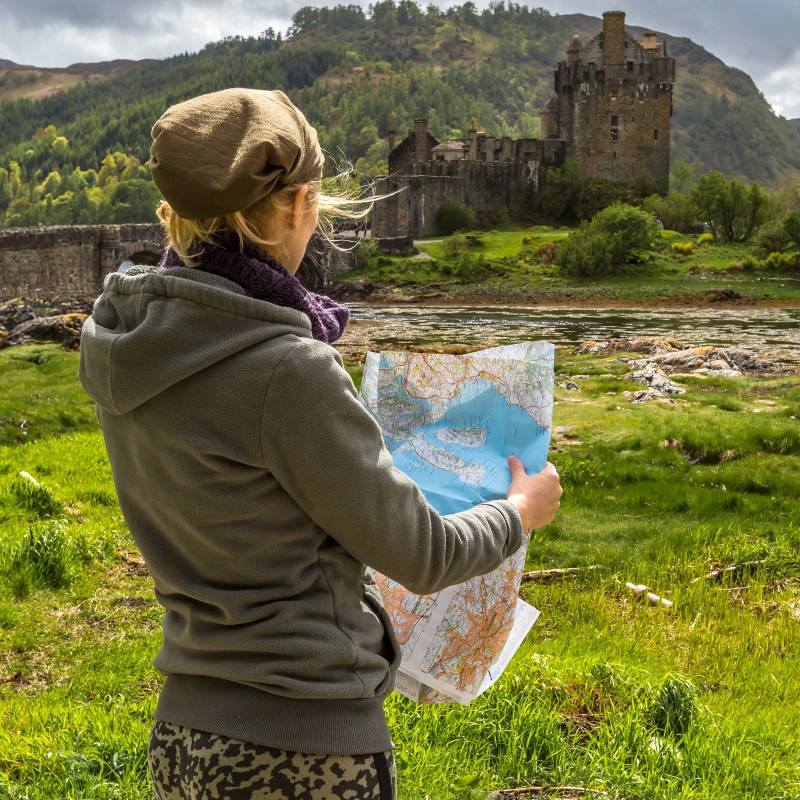
Popular Trips to the UK and Ireland
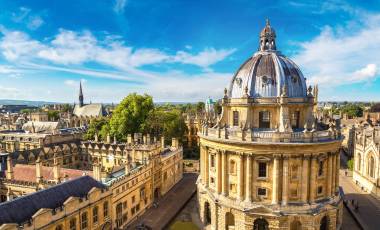
England and Scotland: Historical Cities
Go back in time as you soak in the history of seven iconic cities across England and Scotland. Unearth the hidden gems of the bustling city of London, admire the UNESCO-listed city of Bath on leisurely walking tours and stroll down the tree-lined avenues of Oxford and Cambridge. Delve deeper into the history of Scotland…
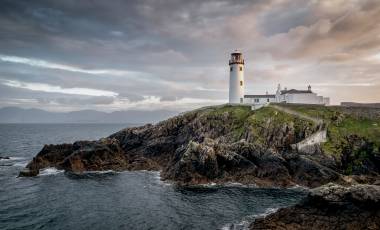
Grand Tour of Ireland
Embark on a comprehensive tour of the Emerald Isle! Beginning in cultural Dublin, take a heritage walk through its famous landmarks and take in a traditional dinner accompanied by live entertainment at a proper Irish pub! Discover Belfast’s blend of history and modernity as your zip through the city in your private black cab! Travel…

Scotland: Heritage Cities and Loch Ness
Explore Scotland’s largest urban sprawls and experience the countryside and famous Loch Ness on this private tour. In Edinburgh, acquaint yourself with Highland history as you walk down the Royal Mile and explore the Old Town. Take a tour of the surrounding countryside and discover medieval abbeys that date back to the time of the…
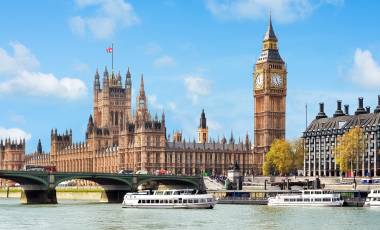
Classic England
Discover the classic highlights on this private and tailor-made England tour. Beginning in London, explore landmarks such as Big Ben, Buckingham Castle, the London Eye, museums, art galleries, and vibrant food and cultural scenes on privately guided tours. Explore Stonehenge with your own expert and then travel to the UNESCO-listed city of Bath, famous for…
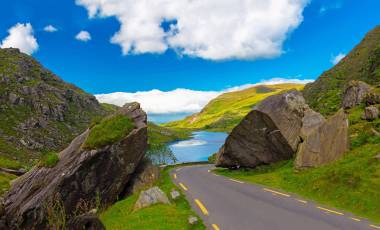
Road Trip: Highlights of Ireland
Explore the breathtaking landscapes and vibrant culture of Ireland at your own pace on this overland tour. Drive past dramatic wildernesses and majestic mountains, amble in the rugged islands and white sand beaches of the Wild Atlantic Way, hike in the hauntingly beautiful Connemara National Park, and discover lively festivals, pubs and authentic Irish culture…
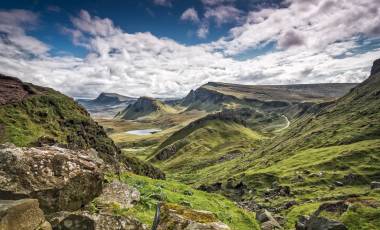
Road Trip: Highlights of Scotland
Experience the vibrant cities, quaint towns, rolling Highlands, and tranquil lakes of Scotland at your own pace. Discover ancient history and architecture, hike in the rugged Isle of Skye, see the iconic Glenfinnan Viaduct, and vast lochs as you drive through this spectacular land peppered with quaint rural villages, castles, forts and whiskey distilleries!
Best Places To Visit
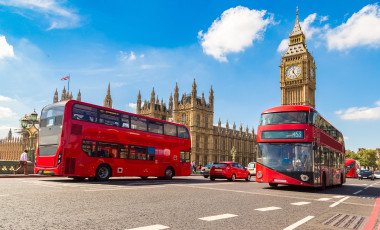
Images of grandeur, tradition, and pageantry take over the senses when you set foot in London. A dynamic cosmopolis, the city is, today, home to people of diverse ethnicities speaking over 300 languages!
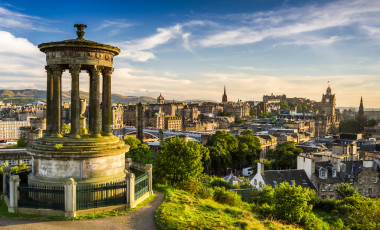
Known by a variety of unique sobriquets such as Old Smoky for the smoke cloud that seems to perpetually hang over it, the beautiful city of Edinburgh sits perched on a range of rocky hills with the sea in the distance.
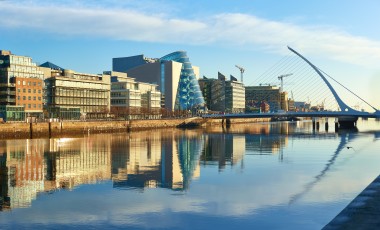
Dublin is a bustling cosmopolitan capital, straddling River Liffey on Ireland’s eastern coast. Step into contemporary galleries, admire street art, or cheer buskers as music fills the air.
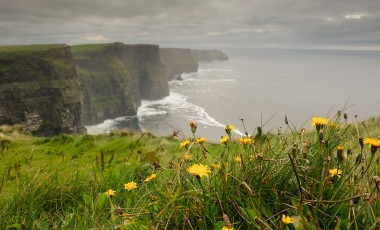
County Clare in western Ireland is known for its natural beauty and culture, from the showstopper Cliffs of Moher that features crashing Atlantic swells, to the lively Irish culture that reels you into intimate gatherings.
County Clare
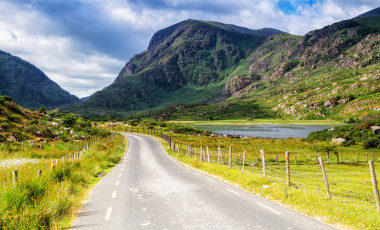
Discover Killarney, a vibrant town on the fringes of its namesake national park surrounded by heather-clad highlands in southwestern Ireland.
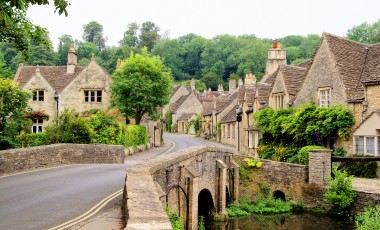
Celebrate the Cotswolds, a wonderful collection of rural counties in south-central England, designated as an Area of Outstanding Natural Beauty, best explored on historic walking trails and driving along the picturesque Cotswolds Romantic Road.
If you’re wondering whether the UK and Ireland are safe regions to visit, the answer is yes! Read our top tips for planning a safe and seamless vacation in the UK and Ireland.
Things To Do
With centuries of extraordinary history to discover and plenty of jaw-dropping scenery to admire, you’ll never be short of things to do in the UK and Ireland. Read more about the top things to see and do.
Travel guide
From preparing and packing for your vacation to important information you’ll want to be aware of during your stay, here are our essential Ireland and UK travel tips.
From the Blog

Must-see Festivals and Events in the UK and Ireland
Discover the must-see festivals and events in the UK and Ireland, from the Glastonbury Festival to Bloomsday, St. Patrick’s Day celebrations and more!
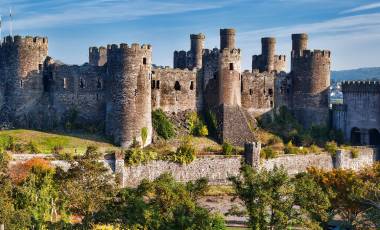
Discover the UK & Ireland through its Architecture
From charming cobbled lanes to impressive Victorian viaducts, there’s plenty of attractive architecture to be found in the UK and Ireland.
What Our Guests Say

The Enchanting Difference
Authentic & unique.
Our award-winning, licensed local guides provide incredible insights and exclusive experiences for you.
Personalized & Private
Our experts completely customize your private tour to match your interests and preferences.
High-Quality Experiences
All our accommodations and services are personally tested by our team.
Fully Supported Travel
You’ll have a personal and dedicated trip coordinator, backed by 24/7 support in case of emergencies while you’re traveling.
Financial Protection & Flexibility
Your booking is flexible and completely secure with us.
Safe & Secure
Your safety and well-being are our top priorities.
Do you have a vacation in mind? Personalize your itinerary with our Trip Builder.
- UK Package Tours from London (6-10 Days) >
England, Ireland, Wales & Scotland Tour - 10 Days
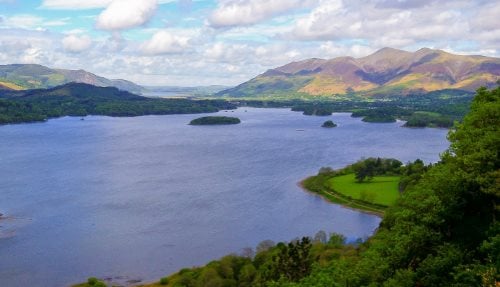
Our 10-day England, Ireland, Wales & Scotland tour gives you the opportunity to immerse yourself in the rich culture, history, and heritage of these ancient lands as well visiting historic villages, towns, and cities,
We’ll travel through the heart of the glorious English countryside, passing beautiful towns such as Shakespeare’s Stratford-upon-Avon and the Roman city of York and into areas of outstanding natural beauty, including The Lake District and the Yorkshire Dales. We also visit the capital cities of London, Edinburgh, Belfast, Dublin and Cardiff. This England, Ireland, Wales & Scotland Tour departs regularly throughout the year and includes carefully selected hotel accommodation with breakfast, some evening meals, and more.
what to expect:
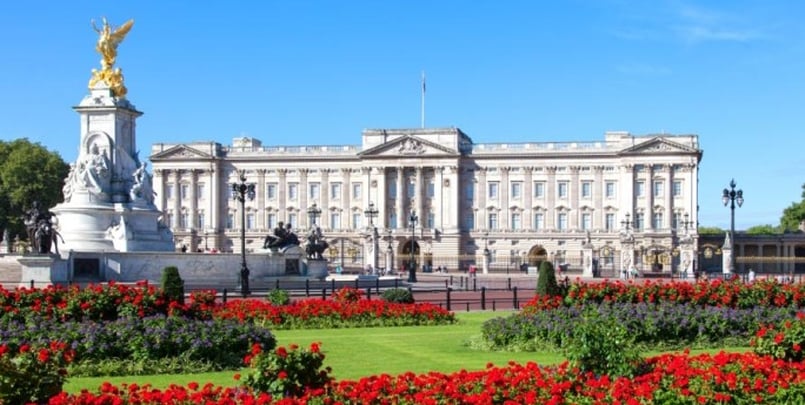
Buckingham Palace
Day 1 – London
Arrive in London, the capital city of the United Kingdom. You’ll have some time to explore the city, perhaps with a walk along the bank of the River Thames or a visit to one of the museums in Kensington. You might also feel like visiting one of London’s diverse neighborhoods, such as Covent Garden, Westminster, Mayfair, or Chelsea.
Hotel: Park Plaza Riverbank including breakfast
Day 2 – Stratford & York
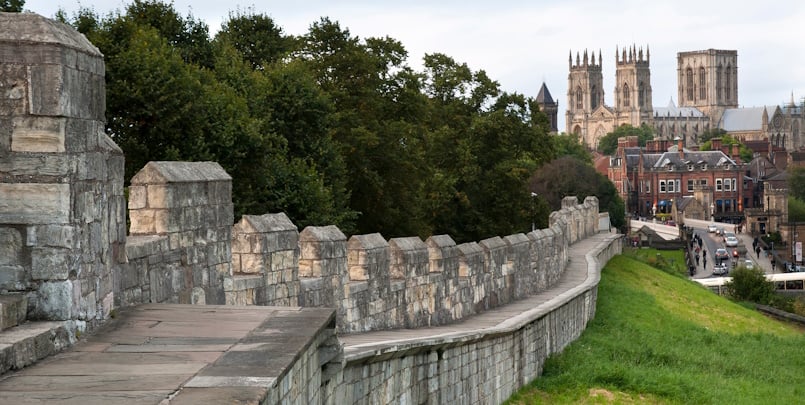
Roman Walls and York Minster
Leaving London, we’ll head right into the heart of the English countryside, known for its green rolling hills and beautiful landscapes. The first stop is the town of Stratford-upon-Avon, the birthplace of William Shakespeare. Visit the house where Shakespeare was born and grew up, as well as the nearby visitor center. Departing Stratford, we’ll head up north to the city of York. Enjoy an orientation walk passing the ancient Roman city walls, York Minster and the collection of ancient narrow streets, known as The Shambles.
The evening is spent in the spa town of Harrogate. Enjoy a traditional pub meal.
Hotel Crowne Plaza Harrogate including breakfast and dinner
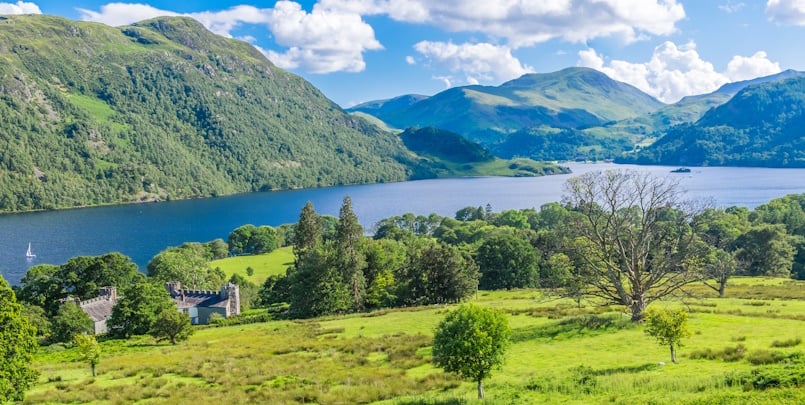
The Lake District,
Day 3 – Lake District & Glasgow
On day three of this England, Ireland, Wales & Scotland Tour we’ll slowly work our way further North. We’ll drive through the Yorkshire Dales and into the Lake District, a UNESCO World Heritage site and a beautiful part of England, known for its writers and poets. Enjoy an optional relaxing cruise on Lake Windermere. Alternatively, discover the charm of the local town Bowness-on-Windermere. We then continue traveling through the picturesque countryside, which inspired the English poet William Wordsworth and writer Beatrix Potter. The drive continues until we head into Scotland, passing Gretna Green, where couples used to elope and ‘tie the knot’. We continue on to Glasgow, the third largest city in the UK, with an orientation that passes many of the famous sites. In the evening there is an optional extra to dine at a traditional venue featuring Scottish entertainment.
Novotel Glasgow Center Hotel, including breakfast
Day 4 – Edinburgh
A full day to explore all that Edinburgh has to offer! This is the capital city of Scotland, perched on a hill with stunning views all around. Led by a local specialist, highlights of the day include visiting Edinburgh Castle and seeing the Royal Mile, the Palace of Holyroodhouse, the beautiful new Scottish Parliament building, and the exquisite Georgian architecture of the New Town. In the evening, we return to the Novotel Glasgow Center Hotel and will have a delicious meal at a local restaurant (included). Enjoy an optional trip to Rosslyn Chapel. This historic 15th-century building has a painted ceiling which includes a dove with an olive branch ( a symbol of the Knights Templar) popularized by The Da Vinci Code novel.
Day 5 – Belfast
We’ll head down the Scottish coastline and take a short ferryride across to Northern Ireland, arriving soon after in Belfast. Belfast is the capital city of Northern Ireland. Accompanied by a local specialist we’ll explore Belfast, including City Hall and the dock where the Titanic was built. From here, it’s straight to our hotel in Dublin. In the evening enjoy an optional meal at a local restaurant-pub where you will taste authentic Irish cuisine and experience the famous Irish hospitality
Ballsbridge Hotel or The Address Hotel Connolly, breakfast included for both.
Day 6 – Dublin
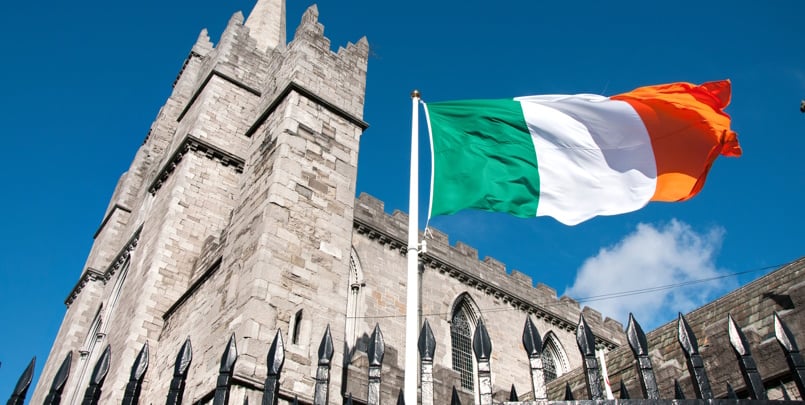
St Patrick’s Cathedral
A full day to explore Dublin, the capital city of Ireland. Joined by a local specialist, you’ll get to see many of the highlights of the city, including St Patrick’s Cathedral, the tallest church in Ireland, Trinity College, and the pretty Georgian squares. Visit the Guinness Storehouse in St James’s Gate. This is where the story of Guinness began in 1759. Learn how this once-small brewery has become one of the most popular beers worldwide. There will be time for tasting in the Gravity Bar which looks out over fantastic views of the city. Spend the rest of the day at your leisure soaking up the special and unique Irish culture.
Alternatively, enjoy an optional visit to Glendalough, once a glacial valley that became an early monastic site in the 6th century. Explore the remains, including the Round Tower.
In the evening, enjoy an optional traditional Irish cabaret experience famed for its Irish music, dance, songs, and humor.
Ballsbridge Hotel or The Address Hotel Connolly. Breakfast included.
Day 7 – Kilkenny and Waterford
Departing Dublin, we head to the Irish National Stud, world-famous for rearing thouroughbred racehorses. Enjoy a a guided tour, followed by a walk in the stunning Japanese Gardens, considered to be the finest in Europe. From here, admire the medieval Kilkenny Castle, built in 1260 AD, before some free time for lunch. We then head south to the Waterford Crystal Studios to watch the craftsmen produce their exquisite cut glass and visit the Waterford Crystal shop.
Enjoy either an optional guided tour of Waterford, the oldest city in Ireland. It is thought to have been founded by the Vikings in the 9th Century. Explore the city’s rich heritage with a local guide, followed by a visit to one of the city’s oldest pubs.
or, enjoy an optional evening of traditional Irish entertainment, including folk songs and singing, and maybe even a pint or two!
Evening accommodation is either at the Waterford Marina Hotel or The Fitzwilton Hotel Waterford. Breakfast included.
Day 8 – Cardiff
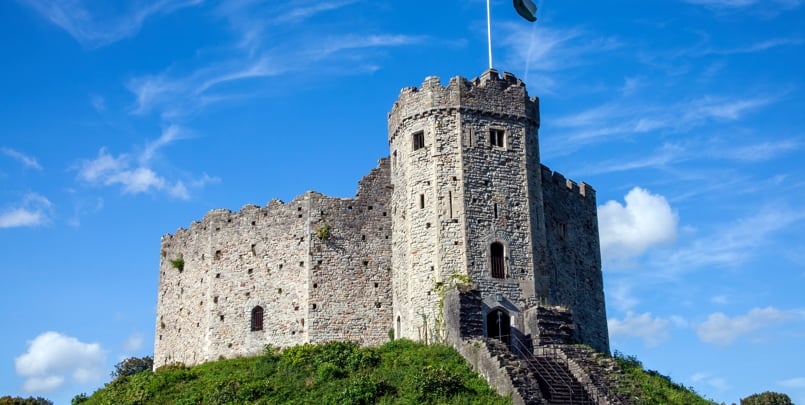
‘The Keep’, the fortified tower built within the walls of Cardiff Castle
Day 8 of this England, Ireland, Scotland & Wales tour is spent in Cardiff. We start the day by taking the ferry across the Irish Sea, and head to Cardiff, the capital city of Wales. We take a panoramic tour of the city passing many of the historic sites including the Millenium Centre, National Assembly and Cardiff Castle. There is an optional visit to the 11th-century Castle. Enjoy the richly decorated interiors; each room is decorated with exquisite murals, stained glass, gilding, and with superb craftsmanship. Walk the battlements and enjoy amazing views.
In the evening, we travel into the countryside to visit a sustainable farm run by a local Welsh family. They will demonstrate their farming techniques, meet some of the resident animals, and see their vineyard, which is the oldest and largest in Wales. Experience Welsh hospitality and enjoy a homemade meal with the family. This is included in the package.
Evening accommodation is in the Park Inn by Radisson Cardiff City Center.
Breakfast and dinner included.
Day 9 – Bath & Stonehenge
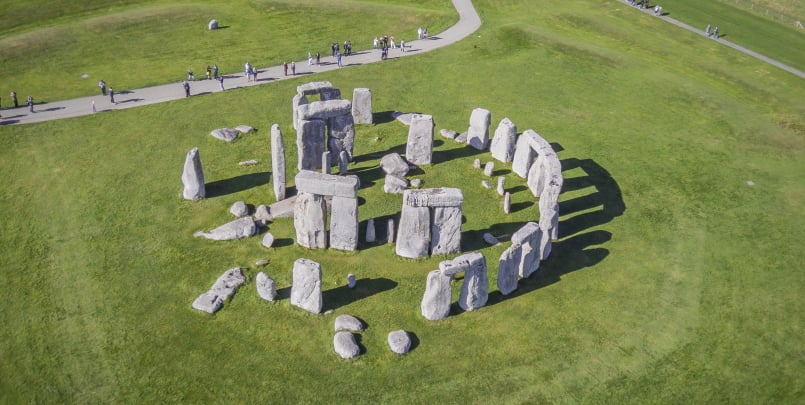
Crossing back into England, we arrive at the UNESCO World Heritage City of Bath. Admire the city’s elegant Georgian architecture and medieval Bath Abbey, which have been used as backdrops to many famous movies. Visit the 2000-year-old Roman Baths, which utilized natural warm springs to create a place to bathe and from which the city takes its name.
We then visit Stonehenge. This UNESCO World Heritage Site is one of the most mysterious places in the world. Built over 5,000 years ago, admiring the Neolithic stone circles, followed by a visit to the Neolithic Village and state-of-the-art Visitors Center.
From here, we continue on to London.
Evening Accomodation is at the Park Plaza London Riverbank, County Hall.
Breakfast included.
Day 10 – Depart London
The final day of this England, Ireland, Scotland & Wales tour – say goodbye to your fellow travellers and head home.
further details
Tour includes:
- Breakfasts every day (except day 1)
- Dinners where stated
- Transportation via luxury coach with WIFI and a ferry to and from Ireland
- Driver and a travel director
- Audio headsets
- All porterage and restaurant gratuities
Tour excludes:
- Optional experiences. These can be purchased on the day via your tour director
- On occasion, hotels of similar standard and location may be utilized.
Availability and Pricing:
- View our availability and pricing
Get in touch:
- If you have any questions please contact us
- Read Reviews
terms and conditions
You might also be interested.
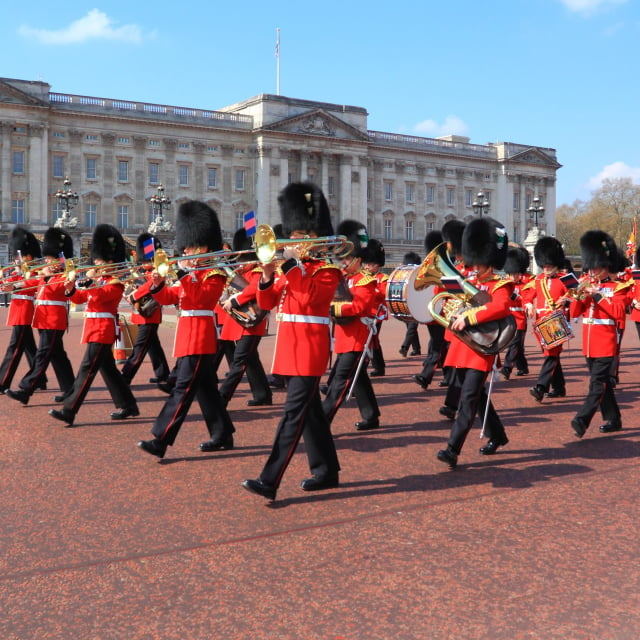
England & Scotland Tour - 10 Days
Weather & Climate
England's Airports
Top Destinations
One Week in England
Top Things to Do
Foods to Try
Top Road Trips
Best Beaches
Best Time to Visit
Best Time to Visit England
Sylvain Sonnet/Getty Images
There's no bad time to experience England, especially since the country has such a diversity of destinations, from cities to beaches to scenic countryside. England boasts moderate weather year-around (and far less rain than you might expect), and even in damp weather, there's always something to see and do. Still, there are better times of the year to visit England, bearing in mind crowds and popular events. To avoid big groups of tourists and to take advantage of the nicest weather, the best times to visit England are in the spring, from April to May, and in the fall, from September through November.
Weather in England
While England is notorious for its rainy weather, there are actually far fewer rainy days than people assume. Summers in England can be quite hot, especially in the southern parts of the country, and the winters are usually moderate, even in the more northern regions.
During the summer, the average temperature in England is 60 F (15 C), although London and the surrounding areas can go as high as 90 F (32 C), usually in August and September. The summer heat is more bearable in coastal areas, which get nice breezes, but in the cities, the high temperatures can be challenging, especially since most public transportation lacks air conditioning. The south coast tends to get more sunshine than mountainous areas like the Lake District, which is the wettest part of England.
The winter brings an average temperature of 40 F (15 C) and some light snow can be expected throughout the country. Winters are typically cloudy and wet, and travelers should pack accordingly. Expect windy and rainy conditions during the winter when visiting northern regions, especially along the coast. Don't let the colder, damper weather deter you though; winter is a great time to come to England thanks to smaller crowds and lower rates.
Spring lasts from March to May and often brings some rain, although there are usually sunny days as well. Early spring tends to be quite cold, especially in the north, and a trip in March or April can be chilly. May is a great time of year to visit England as many flowers and trees are blooming and the weather is typically nice, especially on the coast.
Fall, which lasts from September to November, is another great time of year to visit England. The weather does cool down, but September and October can bring heat waves, especially in the south.
Crowds and Peak Season in England
Summer is the peak season for travel to England, although you can expect lots of visitors in the spring and early fall as well. The Christmas and New Year holiday period is also very busy, especially in London. Spring and fall can be the best times to come if you want to avoid larger tourist crowds and high season hotel rates.
The crowds in England can depend on what part of the country you want to visit and what events are happening at the time. During the summertime, seaside towns like Brighton or Whitby can be crowded, particularly on the weekends or over bank holidays. Areas like the Cotswolds, Cornwall, and the Lake District also attract a lot of visitors during warmer weather. Smaller towns and more remote areas tend to have fewer accommodations, so it's best to book in advance when traveling during busy periods.
British school holidays can also bring crowds. School holidays occur during summer, from July through September, and at half term, which take place the end of October and in mid-February. Schools are off around the Christmas and Easter holidays as well. Many families elect to travel around the country to tourist spots during these periods, so it can be best to schedule your trip when kids are in school.
While you will need to pack a winter coat and an umbrella, January can be a great time to explore England, especially if you want to take advantage of travel deals at country hotels and on various train lines.
Events to check out:
- The annual New Year's Day Parade takes place in London on Jan. 1, with celebrations taking over Oxford Circus and Piccadilly.
- Manchester hosts the Beer and Cider Festival every year in late January. The multiple-day event showcases hundreds of British brews, with children allowed until 7 p.m. daily.
- Burns Night , an homage to Scottish poet Robert Burns, takes place Jan. 25. It's celebrated throughout the U.K. with Scottish-themed food and drink served at many pubs and some restaurants.
February can mean some crowds thanks to schools' half term, but coastal towns and country villages tend to be less crowded, especially if you're traveling without kids.
- London celebrates Chinese New Year in Chinatown with a festive parade and a lively street fair. The dates vary based on the Chinese calendar.
- Portsmouth showcases its literary heritage at BookFest in mid-February. The festival features readings from authors, events and celebrations.
- York is home to the annual JORVIK Viking Festival , the largest viking event in Europe, which draws thousands to its reenactments, marketplaces and talks.
Spring starts to come to England in March, which means picturesque scenery throughout the countryside and in the national parks.
- St. Patrick's Day brings out the fervor around England as well as Ireland, with celebrations taking place in pubs around the country. There is also the London St. Patrick's Day Festival in Trafalgar Square, which usually takes place on the weekend closest to St. Patrick’s Day.
- Poetry fans can discover the Words By the Water Festival in the Lake District in early March. The festival features literary events, readings and discussions.
- Mother’s Day arrives in March in England (the date can vary) and visitors will find mom-themed events around the country, including special afternoon teas and set menus at restaurants.
April is an ideal time to visit England thanks to a plethora of events around the country and many tourist spots starting to get going for the season. Look out for Easter travelers, who can bring crowds during the two-week school holiday.
- Watch for the London Marathon on a Sunday in April. It usually means big crowds and lots of road closures around the city.
- Head to the home of Shakespeare for the week-long Stratford-Upon-Avon Literary Festival . It's one of the U.K.'s most significant literary festivals and includes events and activities for visitors of all ages.
May brings flowers, sunshine, and crowded beaches to England, making it the start of peak tourist season, especially along the coast. There are two bank holiday weekends in May, so be sure to book accommodation in advance or look for less busy destinations.
- The Harrogate Flower Show kicks off with massive floral displays, crafts, and cooking demonstrations for a weekend.
- In London, the iconic Chelsea Flower Show is a five-day celebration of flowers and plants and is held in the upscale neighborhood of Chelsea.
- The Great Escape is a popular music festival that takes over Brighton for several days each May. It always features well-known musical acts, as well as up-and-comers, and means big crowds for Brighton and Hove during that weekend.
- If you love seafood, look for Devon's Salcombe Crab Festival , a one-day event each May. The festival celebrates the local coastal catch, with lots to eat, drink and do.
June is a busy month for travel in England, boasting nice weather and lots of events around the country. It's a particularly good time to decamp from the cities to enjoy the famous English countryside or to experience the hikes in the Lake District.
- The Queen's annual birthday parade, Trooping the Colour, takes place at Buckingham Palace in June and includes an appearance by Her Majesty herself. Be sure to buy tickets in advance (or just watch it live on the BBC).
- The famous tennis tournament Wimbledon kicks off in late June and lasts for two weeks, with tickets available for members of the public.
- England's Pride celebrations take over the country in June, with a massive parade in London. Other cities follow suit later in the summer, with Brighton's popular festivities taking place in August.
- The Royal Ascot , usually held in mid-to-late June, is a high-class horse race attended by well-dressed Brits and the queen in the Berkshire town of Ascot.
July tends to be one of the most busy months in England, as well as one of the hottest. Cities like London will be very crowded with international tourists, and holiday destinations like York and Brighton are likely to be packed as well. It's a great month for outdoorsy travelers, who can take advantage of the long daylight and sunny weather to go hiking or cycling.
- Head to Whitstable to experience the famed Whitstable Oyster Festival , which serves food and live music to a discerning crowd.
- Fan lovers fill the muddy fields at Glastonbury , a five-day music festival that is one of the world's most popular. Held in Somerset, the event usually sells out almost immediately.
- A more family-friendly festival can be found in Suffolk at Latitude Festival , which features music, yoga, theater, comedy, and activities for kids.
Like June and July, August is usually very popular for international travelers, particularly in seaside locations. There's a bank holiday each August, which can mean crowds, so book ahead.
- London's Notting Hill Carnival is one of Europe’s largest street parties, held over the Summer Bank Holiday weekend.
- Liverpool is all about the Beatles during International Beatleweek , held in the historic Cavern Club.
- Reading and Leeds is one of England's biggest music festivals, taking place over a weekend at the end of August. The event, which is technically two separate festivals in two different cities, boasts some of the biggest artists out there.
September usually features nice weather and less crowds, so it's a great time to explore destinations around England, especially more remote areas. Enjoy beaches and country villages without the throngs of tourists, or embrace the city life of London or Manchester.
- Bath hosts the annual Jane Austen Festival , which honors all things Jane Austen, in September. It's a massive undertaking, with events held over 10 days.
- Outdoorsy travelers will enjoy the Yorkshire Wolds Walking and Outdoors Festival , a 10-day event with a variety of activities from hiking to cycling to horseback riding. It's open to families and those of all fitness levels.
The weather begins to cool down in October, but so do the number of tourists, so travelers can make the most of typically busy destinations.
- The prestigious BFI London Film Festival brings a vast selections of international films every year for 10 days in October. Many of the screenings, events, and even film premieres welcome the public.
- Enjoy the 700-year-old Hull Fair , known as England's largest traveling fair. It's a true spectacle, with rides, games, food, and live events.
- Oktoberfest is a German invention, but England celebrates the annual festival as well. Look for Oktoberfest events in London, Manchester, Bristol, and Kent throughout October.
Because the U.K. doesn't celebrate Thanksgiving, November can be a great time to take advantage of smaller crowds in England. While you may need a coat and an umbrella, there's still a lot to see and do around the country, especially as the Christmas season kicks off.
- Bonfire Night , which is also known as Guy Fawkes Day, is celebrated on Nov. 5 throughout the U.K. It commemorates Guy Fawkes’ failure to blow up the House of Parliament, which all of England remembers with firework shows, bonfires and lots of drinking.
- Many Christmas festivities kick off in England in November (the British love Christmas), so look for tree lighting ceremonies, Christmas markets, and theater events throughout the country towards the end of the month. London features tons of celebrations to illuminate the various lighting displays as well.
England is obsessed with Christmas, so a visit in December means vibrant decorations and massive shopping crowds. Skip the packed streets of London and head to lesser-visited areas to make the most of your trip. Many English country hotels also offer specials and package deals around Christmas stays.
- Find your Christmas spirit at the Grassington Dickensian Festival in the Yorkshire Dales National Park. It features Victorian reenactments, performances and a Santa procession.
- London's Hyde Park gets taken over by Winter Wonderland each year in December (it sometimes kicks off as early as November). The fair has rides, market stalls, ice skating, and a lot of activities for the whole family.
- On New Year’s Eve, London puts on a big fireworks show on the River Thames with music and festivities. It's the biggest celebration in England, but many other towns and cities host their own parties and fireworks shows.
You can take advantage of decent weather and avoid the big summer groups by visiting in the shoulder season, either in April and May or September through November.
The south of England generally has slightly sunnier and warmer weather, particularly in on the coast in cities Bognor Regis and Brighton.
Although it's not the warmest month, June generally has the best weather in England because it is still quite warm and it does not rain as much as it does in July and August.
Weather Spark. "Average Weather in London, UK Year Round." Retrieved March 22, 2021
The Best Time to Visit Boston
The Best Time to Visit Washington D.C.
The Best Time to Visit Munich
The Best Time to Visit Disney World
The Best Time to Visit Spain
The Best Time to Visit Manchester, England
The Best Time to Visit Kauai
The Best Time to Visit Japan
The Best Time to Visit Morocco
9 Top Things to Do in London for Easter
The Best Time to Visit the Bahamas
The Best Time to Visit Johannesburg
The Best Time to Visit Naples, Italy
The Best Time to Visit Birmingham, England
The Best Time to Visit France
Best Time to Visit Edinburgh
Planning an England trip in 2024? Consider these 16 top places to visit

Feb 26, 2024 • 10 min read

Gracious Bath is an excellent place to immerse yourself in England’s history and beauty © gowithstock / Shutterstock
The story of England stretches back more than 5000 years (and likely many more). Which means its impossible to escape the past here.
As you wander its historic urban centers, mysterious monoliths, misty landscapes and rugged coastlines and national parks , you’ll discover a country filled with unparalleled places to visit that are are the more compelling thanks to all those who have visited them before.
As you plan a trip to England this year, here’s our list of 16 historic, exciting and all-around fabulous highlights to consider.

1. The Seven Sisters
While Dover ’s iconic white cliffs grab the most attention, the colossal chalky walls of the Seven Sisters are a more spectacular affair, a four-mile roller-coaster of sheer white rock stretching along the Sussex shore and overlooking the waters of the English Channel. It forms an impressive southern border to the South Downs National Park , and is most dramatic at the towering headland of Beachy Head . Hikes through the grassy clifftop fields provide wide sea views, breathtaking in every sense.
Local tip: Stop for a breather at the tiny seaside hamlet of Birling Gap, where the secluded beach is a sun trap popular with locals and walkers.

Oxford lets visitors feel close to the brilliant minds and august institutions that have made this city famous across the globe. This rarefied world comes to life in the cobbled lanes and ancient quads where cycling students and eccentric academics roam. The beautiful college buildings and stunning architecture have changed little over the centuries, coexisting with a lively, modern, working city. As befits a city of students and professors, Oxford is one of the last bastions of the great British pub, with irresistible old watering holes dotted all over its central lanes and alleyways.

3. Cambridge
In England’s other great historic university city, Cambridge , you can tour a college , and spend time marveling at the intricate vaulting of King’s College Chapel . But no trip to Cambridge is complete without an attempt to take a punt (flat-bottomed boat) along the River Cam by the picturesque Backs , the leafy, green lawns behind the city's finest colleges – an experience that offers the best views of the exquisite architecture. Polish off the day with a pint at one of Cambridge’s many rustic pubs.

In a nation packed with pretty cities, Bath stands out as the belle of the ball. Founded by the Romans, who established the spa resort of Aquae Sulis to take advantage of the area’s hot springs , Bath hit its stride in the 18th century, when the rich industrialist Ralph Allen and architects John Wood the Elder and John Wood the Younger oversaw the city’s transformation into a model of Georgian architecture at its most refined . Bath is awash with golden stone townhouses, sweeping green crescents and Palladian mansions, along with appealing pubs and restaurants, and you’ll take great pleasure in plunging in.

5. Hadrian’s Wall
Hadrian’s Wall is one of the country's most dramatic Roman ruins, a 2000-year-old procession of abandoned forts, garrisons, towers and milecastles marching across the wild and lonely landscape of northern England. While the Romans built the fortification to defend and control its territory, this edge-of-empire barrier also symbolized the boundary of civilized order in the ancient world: to the north of the Roman settlement lay the unruly land of the marauding Celts. Near Newcastle you can visit Segedunum , the wall’s last stronghold, for an insight into life during Roman times.
Planning tip: Hiking the full 84-mile distance coast to coast along the national trail takes around a week. If you have less time and your own car, you may want to select from a few of the wall's highlights .

With its Roman and Viking heritage, ancient city walls and maze of cobbled streets, York is a living record of English history. A magnificent circuit of 13th-century walls encloses a medieval spider’s web of “snickelways” (narrow alleys), each one the focus of a ghost story or historical character. At the city’s heart lies the immense, awe-inspiring York Minster , the biggest medieval cathedral in all of northern Europe, and one of the most beautiful Gothic cathedrals in the world. Admire feats of engineering of a more recent vintage at the National Railway Museum , the world’s largest collection of historic locomotives.
York’s long history and rich heritage are woven into virtually every brick and beam, and the modern, tourist-oriented city – with its myriad museums, restaurants, cafes and traditional pubs – is a carefully maintained showcase of that heritage.
Local tip: You’ll find some of the finest views of York from its old city walls, particularly the bucolic section behind the Minster.

7. The Peak District
Curiously, you won’t find many peaks in the Peak District . You will find blissful miles of tumbling moorland, plunging valleys, eroded gritstone crags, lush farmland and ancient pocket-sized villages. This beautiful landscape attracts a veritable army of outdoor enthusiasts – cyclists, hikers, cavers and rock climbers – on summer weekends, while those seeking more relaxing enjoyment can admire the rural market and famous puddings of Bakewell, the Victorian pavilions of spa-town Buxton, and the architectural drama of Chatsworth House – the “Palace of the Peak.”

8. Brighton
Barely an hour’s train ride from the capital, the seaside city of Brighton has a quirky character that’s completely its own. Overlooking the English Channel on England’s pebbly south coast, this is a city that's long been known for its oddball, alternative character. The warren of streets known as the Lanes is a good place to soak up the vibe, with vegan cafes, espresso bars, chaotic pubs, record stores and bric-a-brac shops. (Browsers will be in heaven at local institution Snooper’s Paradise .) You'll also find the UK ’s biggest queer scene here, and the region’s best small clubs. The highlight for the sightseeing visitor is the Royal Pavilion , a 19th-century party palace built by the Prince Regent, who kicked off Brighton’s love of the outlandish.

9. Stonehenge
Mysterious and compelling, Stonehenge is England’s most famous ancient site . Even though people have been drawn to this myth-laden ring of boulders for more than 5000 years, we still don’t know quite why it was built. An ultramodern makeover at the ancient site has brought an impressive visitor center and the closure of an intrusive road (now restored to grassland). The result is a strong sense of historical context, with dignity and mystery returned to an archaeological gem.
Most visitors gaze at the approximately 25-ton stones from behind the perimeter fence, yet with enough planning, you can arrange an early-morning or evening tour and gain access to the inner ring itself. In the slanting sunlight, away from the crowds, it’s an ethereal place. This is an experience that stays with you.


10. Stratford-upon-Avon
The pretty town of Stratford-upon-Avon is where William Shakespeare was born and later shuffled off this mortal coil. Today, its tight knot of Tudor streets form a living map of Shakespeare’s life. Huge crowds of thespians and theater lovers come to take in a play at the famous Royal Shakespeare Theatre . Bard fans will love visiting the five historic houses owned by Shakespeare and his relatives and the schoolroom where he was educated, before taking a respectful detour to the old stone church where he was laid to rest.

11. Liverpool
It’s hard not to be infected by Liverpudlians’ love for their hometown. The love endured despite decades of decay and all manner of social ills – finding its expression in a renowned gallows humor and an obsession with football. With some of the most passionate crowds in the country, taking in a game at either Liverpool FC or Everton FC is a rite of passage here.
Outside of the stadium, the rejuvenated waterfront is once again the heart of Liverpool . The focal point is Albert Dock, an iconic docklands flanked by protected buildings, including a batch of top museums. The Merseyside Maritime Museum and the International Slavery Museum ensure the good and bad sides of Liverpool’s history are explored in equal measure, while the Tate Liverpool and the Beatles Story museum celebrate popular culture and the city’s most famous musical sons (still).

12. The Cotswolds
A tangle of impossibly quaint villages of rose-clad cottages and honey-colored stone, The Cotswolds is a region that spreads over six English counties. It’s a designated Area of Outstanding Natural Beauty, and its most wonderful quality is that no matter where you go or how lost you get, you’ll still end up in a spot with a charming village green, a pub with sloping floors and fine ales, and a view of the lush green hills. Crisscrossed by long-distance trails including the 102-mile Cotswold Way , these gentle yet dramatic hills are perfect for walking, cycling and horse-riding.
Local tip: It’s easy to leave the crowds behind and find your very own slice of medieval England here – and some of the best boutique hotels in the country.

A little weird, occasionally weather-beaten and all-around wonderful, the classic northern seaside town of Whitby has haunted lanes, fossil-hunting and arguably England’s finest fish-and-chips. The huddle of 18th-century fisher’s cottages along the East Cliff are testament to its longtime role as a busy commercial and fishing port: it was here that 18th-century explorer Captain James Cook earned his sea legs. Atop the West Cliff, a sandy beach, amusement arcades and promenading holidaymakers show Whitby’s beach-resort side.
Keeping a watchful eye over the town and the River Esk that divides it is an atmospheric ruined abbey , the inspiration and setting for part of Bram Stoker’s Gothic horror story Dracula . But tales of witchery and ghostly legends have haunted Whitby ever since Anglo-Saxon St Hilda landed here to found a monastic community in 657 CE.
Planning tip: The town embraces its pseudo-sinister reputation, which culminates in two hugely successful Goth Weekends each year.

14. The Lake District
William Wordsworth and his Romantic friends were the first to champion the charms of the Lake District – and it's not hard to see what stirred them. Already the UK’s most popular national park, the Lake District also became a UNESCO World Heritage Site in 2017, in recognition of its long history of hill-farming. But for most people it’s the chance to hike the humpbacked fells and drink in the gorgeous scenery that keeps them returning year after year.
The region is filled with outdoor pursuits, from lake cruises to mountain walks – excursions that help reveal why the region has such deep literary connections. In addition to Wordsworth, writers who found inspiration here include Samuel Taylor Coleridge, Arthur Ransome and Beatrix Potter.

15. The Eden Project
A cross between a lunar landing station and a James Bond villain’s lair, the gigantic hemispherical greenhouses of the Eden Project have become a symbol of Cornwall ’s renaissance. Built in an abandoned clay pit near St Austell to mark the start of the new millennium, and now considered one of Britain’s modern architectural wonders, the Eden Project aims to explore issues of environment and conservation, and point the way to a cleaner, greener future for us all.
Exhibits cover everything from global warming to rubber production and chocolate-making. The glass-domed “biomes” recreate major world climate systems in microcosm, from the lush jungles of the Amazon rainforest (complete with treetop walkway winding through the canopy) to the olive trees, citrus groves and colorful flowers of the Mediterranean, South Africa and California. It’s incredibly impressive – not to mention educational, and inspiring, too.

Shoulder-deep in history, London ’s rich seams of eye-opening antiquity appear at every turn. The city’s architecture pens a beguiling biography, and a multitude of buildings – the Tower of London , Westminster Abbey , Big Ben – are internationally recognizable landmarks. It’s also a tireless innovator of art and culture, a city of ideas and imagination. This legacy is enshrined at world-class institutions such as the British Museum , Natural History Museum and the Science Museum , as well as such world-leading art galleries as the Tate Modern , Tate Britain , the National Gallery and the recently reopened National Portrait Gallery , all of which are free to visit.
Local tip: However you budget your time and money in London, make sure you take in a show. Big names perform on the West End (London’s equivalent of Broadway), and on the South Bank at the National Theatre and the Old Vic . Smaller theaters from the Almeida to the Lyric Hammersmith are places to discover up-an-coming talent.
This article was first published Apr 13, 2021 and updated Feb 26, 2024.
Explore related stories
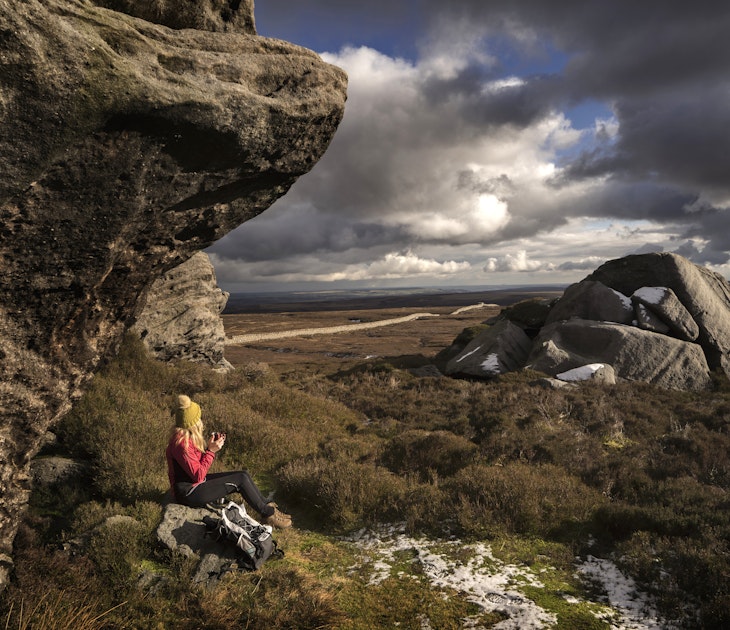
Jul 15, 2022 • 11 min read
Yorkshire is awash with scenic landscapes, historic architecture and agreeable country pubs. Here are the top things to do in God’s Own County.

Jun 26, 2020 • 6 min read

Jun 28, 2024 • 6 min read

Jun 17, 2024 • 3 min read

Jun 17, 2024 • 12 min read

May 24, 2024 • 9 min read

May 21, 2024 • 11 min read

May 15, 2024 • 7 min read

May 7, 2024 • 4 min read

Apr 19, 2024 • 8 min read

How to Plan a Trip to England, Ireland and Scotland
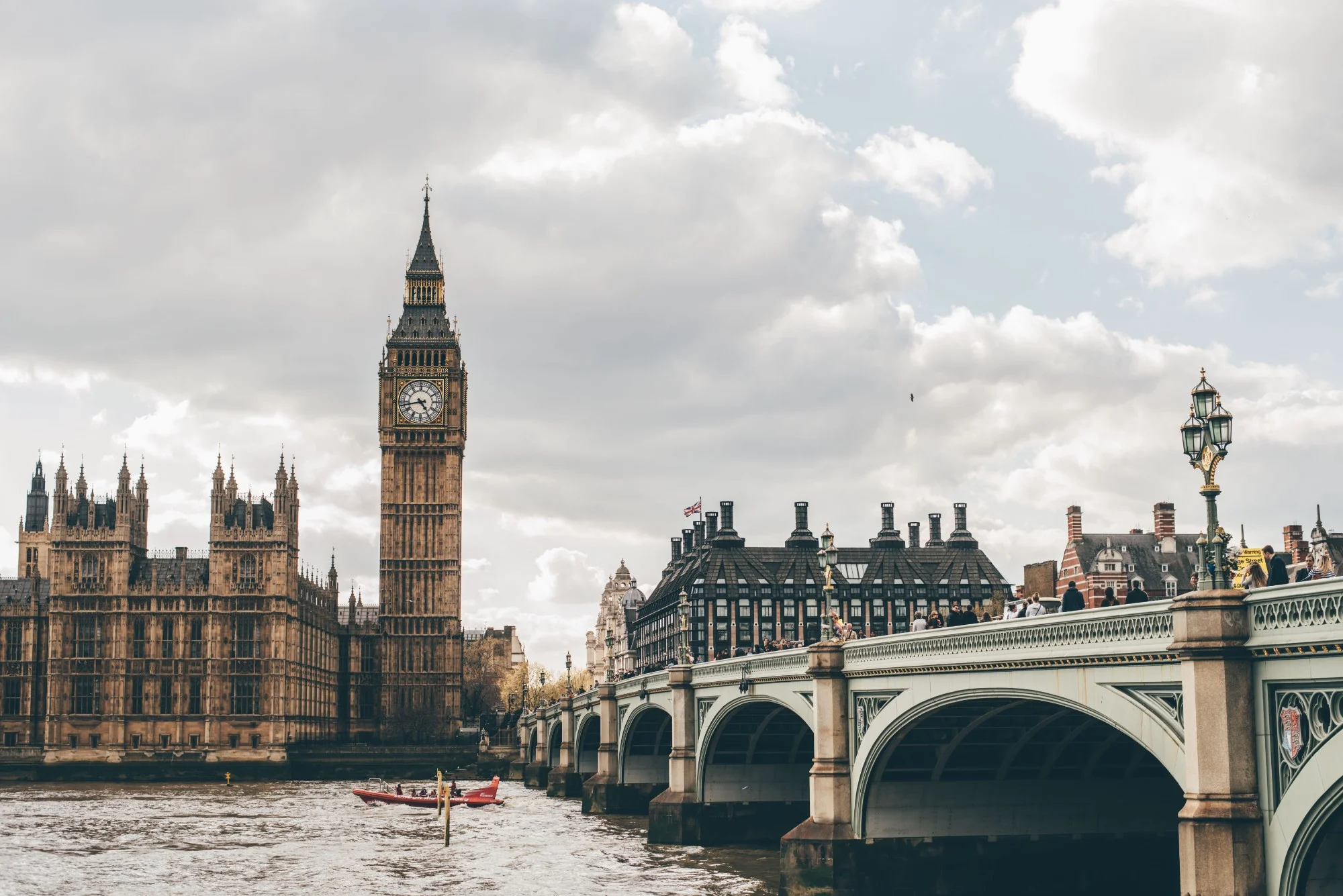
Planning a multi-city trip can be a bit overwhelming, especially if you are trying to visit an extensive territory such as the United Kingdom, full of fascinating history and trendy cities. Because we don’t want you to miss anything that the UK has to offer, we created this ultimate guide on how to plan a trip to England, Ireland and Scotland in order to have the trip of your lifetime.
Step-by-step guide on how to plan a trip to England, Ireland and Scotland
01. research the best way to see england, scotland and ireland.
The first thing you need to do to organize your trip between Great Britain’s islands is to decide which cities you want to explore during your vacation. In order to do that, we recommend you inspire yourself with:
- Lonely Planet Guides : these world-famous guides are a great place to start when trying to decide the best places to visit in the United Kingdom, and an excellent way to understand more how you can move around each place. You can buy Ireland , Scotland and England guides at Amazon for an estimated price of $15 USD.
- Pinterest : this visual search engine is not only a place for inspiration but also a useful tool for discovering new travel resources. Some boards that you should check out – Unite Kingdom Travel , UK Beautiful Places , and UK Travel Tips & Guides
- Travel Blogs : it is impossible to name all of them because you can find a thousand travel blogs covering these destinations but a good place to start is to check The Blonde Abroad , which specialized in solo female travel, or Hand Luggage Only , two guys based in the UK who blog about travelling light.
Once you start filling your bucket list with destinations, it is time to create a Google Map and pin those places that you want to include on your trip. Because you will fall in love with Scotland, England, and Ireland, and will probably want to see every little town around, we recommend you use one colour for the cities that are a no negotiable place to visit and another one for those that you would like to explore but can take off your itinerary if it is necessary:
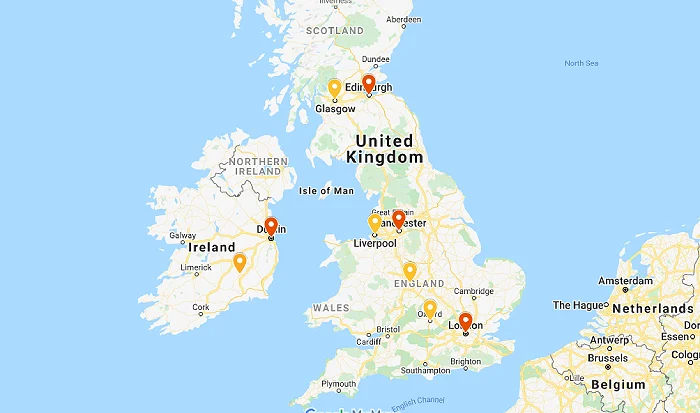
02. Decide how much time you can travel around the United Kingdom
You already know which places you would like to explore so it is time to be realistic and answer yourself “ how long can I extend my trip?”. This is a super important question because, based on your answer, we are going to cut some cities from your dream list or add more destinations to it.
How many days does it take to see Scotland, England, and Ireland?
For a trip to Scotland, England and Ireland you should consider travelling for at least 15 days. However, you can do it in 10 days if you only focus on 1 main city in each country.
03. Figure out Visa restrictions
An important part of planning a trip to England, Ireland and Scotland is figuring out if you need to request a tourist visa in advance in order to enter the UK and Ireland.
Important clarification: England, Scotland and Northern Ireland are part of the United Kindom, the rest of Ireland is not. If you are planning to include Dublin in your itinerary, for example, you will need to check out the visa restrictions for the United Kingdom and Ireland
If you are from the USA, Canada, Australia, and New Zealand you don’t need a special visa to enter Ireland and UK. In Ireland, you can stay up to 3 months as a tourist, while in the United Kingdom, you can travel around the region for up to 6 months. If you are from another country or want to check that this information is up to date, you can visit Ireland’s Department of Justice and Equality website and the Standard Visitor Visa page of the UK Government .
Even when you come from a non-visa-required country, you will still have to prove to the immigration officer at the border control that you have a reason to visit the country and that you are not planning to stay illegally for longer than what you are allowed. Because of this, we recommend you to have a binder prepared with your travel documents such as your flight back home, hotel confirmations, proof that you have the means to travel around the region (credit cards, money in your bank account, cash, etc)
04. Create an itinerary for your trip
One of the most important steps in planning a trip to England, Ireland and Scotland is to decide your itinerary around each place. After figuring out how much time you can spend in the United Kingdom, it is time to go back to your Google Maps and delete those places that didn’t make the cut.

With the final list of cities that you want to see on your vacation, you need to decide what are you visiting first and how are you going to travel around each place.
Tips to plan an England, Scotland, and Ireland itinerary
- Use google maps to estimate car and public transportation travel time from one destination to another.
- Check out the National Rail website for train schedules and fares. For bus journeys, you can check Megabus and National Express (both are the most popular companies in the UK), or Busbud website to see all the coach routes in the United Kingdom.
- If you are short on time, plan to base yourself on bigger cities and do day trips to smaller ones.
- Consider renting a car to move around each city. This option will let you explore more towns during your road trip.
- Schedule to spend more time travelling between each city than you expected. Delays, cancellations and inaccurate planning can happen so make sure that these things won’t ruin your dream vacation
- For flights, consider how much time (and money!) it will take you to travel to the airport and how many hours before your flight you must arrive. Sometimes flying feels like the easiest, cheapest and fastest choice but if you do the math it is not always like that
England, Ireland and Scotland 15-day itinerary (the ultimate two weeks UK itinerary)
As we said earlier, for a trip around England, Ireland and Scotland we strongly advise you to spend at least two weeks travelling. Below you will find a 15-day itinerary that we think is great if it is your first time visiting the United Kingdom since it covers the major touristic spots:
London – 4 days (Oxford included)
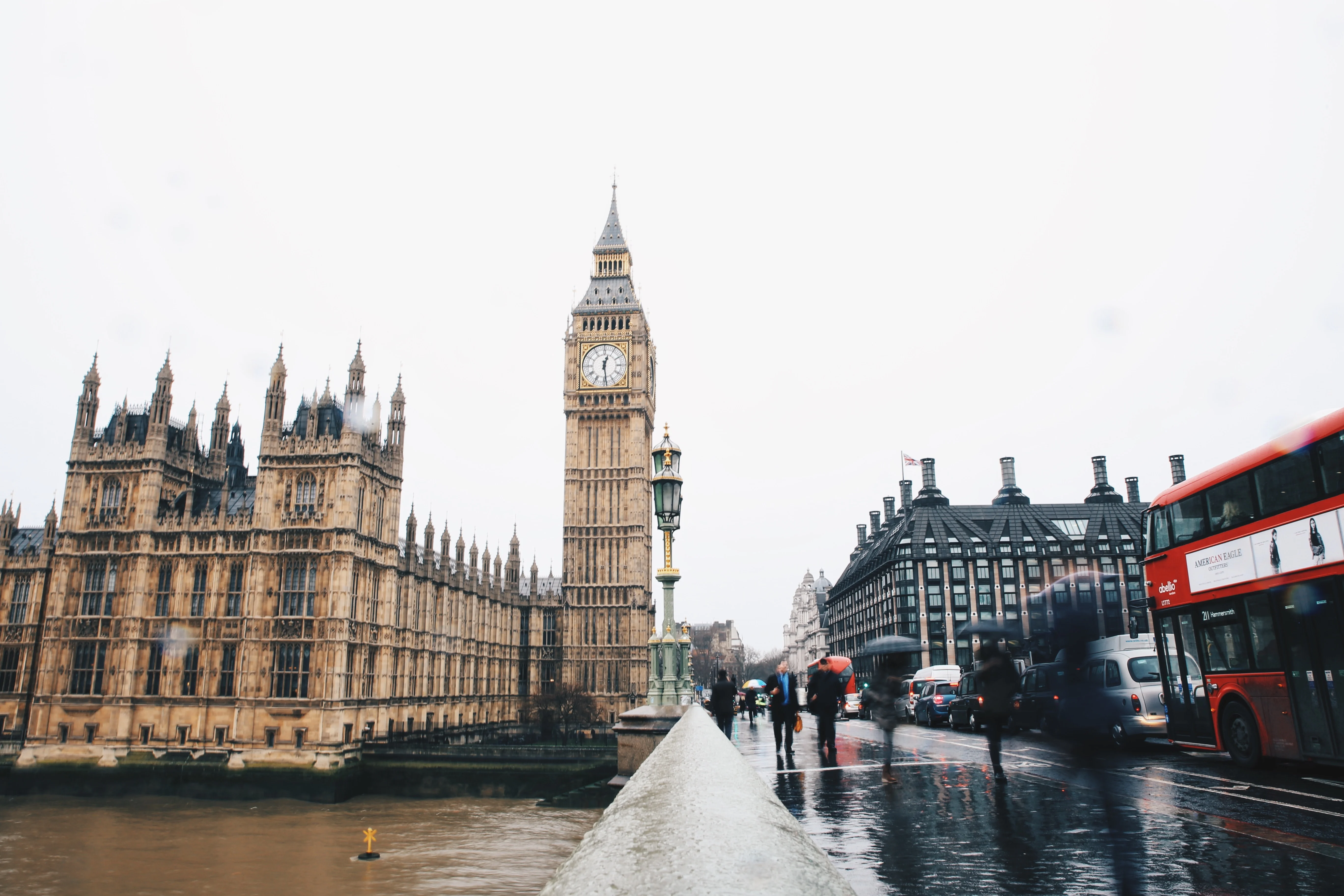
While we could easily spend a month in London without seeing everything that this incredible city has to offer, 72 hours is a good amount of time for a first approach. Some of the things that you can see on the first two days are:
- Buckingham Palace
- Trafalgar Square & the National Gallery
- Parliament Square & Houses of Parliament
- Westminster Abbey
- London Bridge & Tower Bridge
- Nothing Hill
- Camden Town
- Oxford Street
- Piccadilly Circus
For your fourth day in London, you can keep exploring one of the largest cities or do a day trip to Oxford. To get there, you can take a 1 hour, 40-minute coach ride with Oxford Tube or book one of these top day tours from London to Oxford:
Manchester – 3 days (Liverpool included)
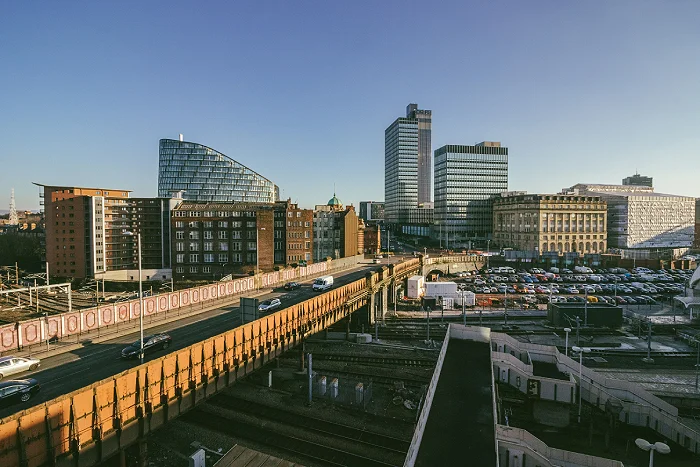
After wandering around the beautiful neighborhoods of London, it is time to move to Manchester, home of the famous football clubs Manchester City and Manchester United. You can get from London to Manchester by car (4 hours drive), train (2-3 hours depending on which train you book) or bus (between 5 and 6 hours). During your visit to Manchester, you can plan to see:
- The Northern Quarter
- Castlefield Urban Heritage Park
- Visit one of the many museums located in Manchester (National Football Museum, The Manchester Museum, Manchester Art Gallery, Imperial War Museum North, and People’s History Museum, among others)
- Manchester Cathedral
- Chetham’s Library
Because Manchester is 1 hour away from Liverpool by train, during one of your 3 days in Manchester you can do a day trip to the home of The Beatles and explore one more city in England before moving to Scotland.
Edinburgh (3 days)
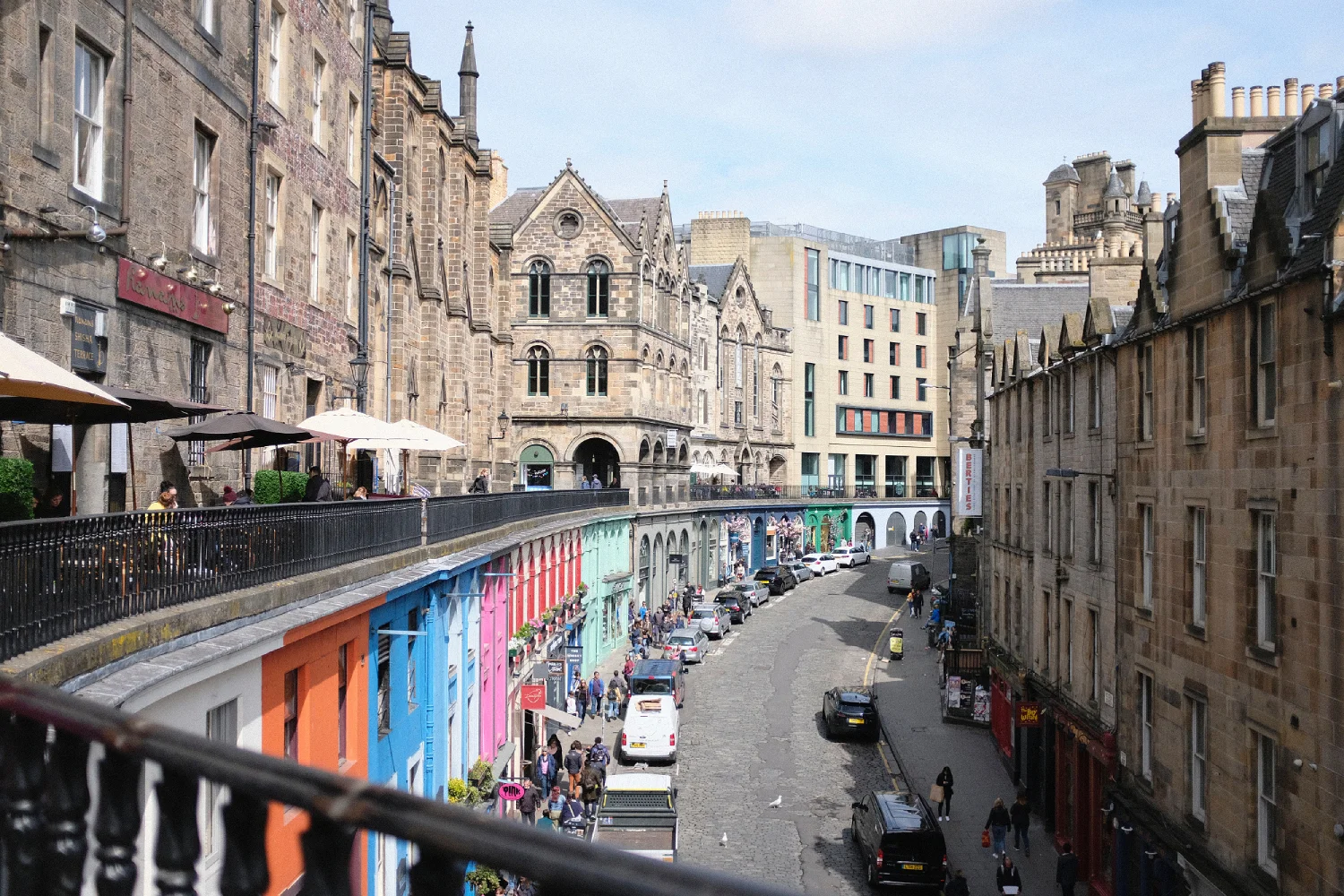
If you are a fan of Harry Potter then you are going to have a blast during your 3 days in Edinburgh exploring the many neighborhoods that inspired JK Rowling. From Manchester, you can take the Transpennine Express that takes only 3 hours to connect the England city with Manchester, drive for 4 hours if you are doing an UK road trip, or even hop into a plane for a 1-hour flight. If this is your first time visiting Scotland, these are some of the things that you can see in Edinburgh in 3 days:
- Edinburgh Old Town
- Edinburgh Castle
- Scotch Whisky Experience
- Victoria Street, the inspiration for Diagon alley
- Princess Street Gardens
- Calton Hill
- St. Giles Cathedral
If you’re just planning a trip to Ireland and Scotland, then
Glasgow (2 days)
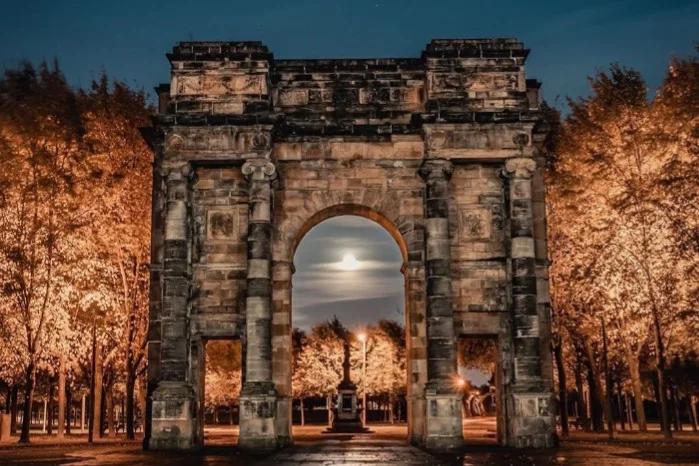
Scotland’s biggest city, Glasgow is a magnificent city to include in your itinerary when planning a trip to England, Ireland and Scotland. The city is home to several art galleries and museums, which makes it a perfect destination if you are travelling the region during winter and don’t want to spend the whole day outdoors. Our recommended things to visit during 2 days are:
- The Gallery of Modern Art
- Kelvingrove Art Gallery and Museum
- Glasgow Cathedral
- Glasgow Necropolis
- George Square
- The Lighthouse
Dublin (3 days)
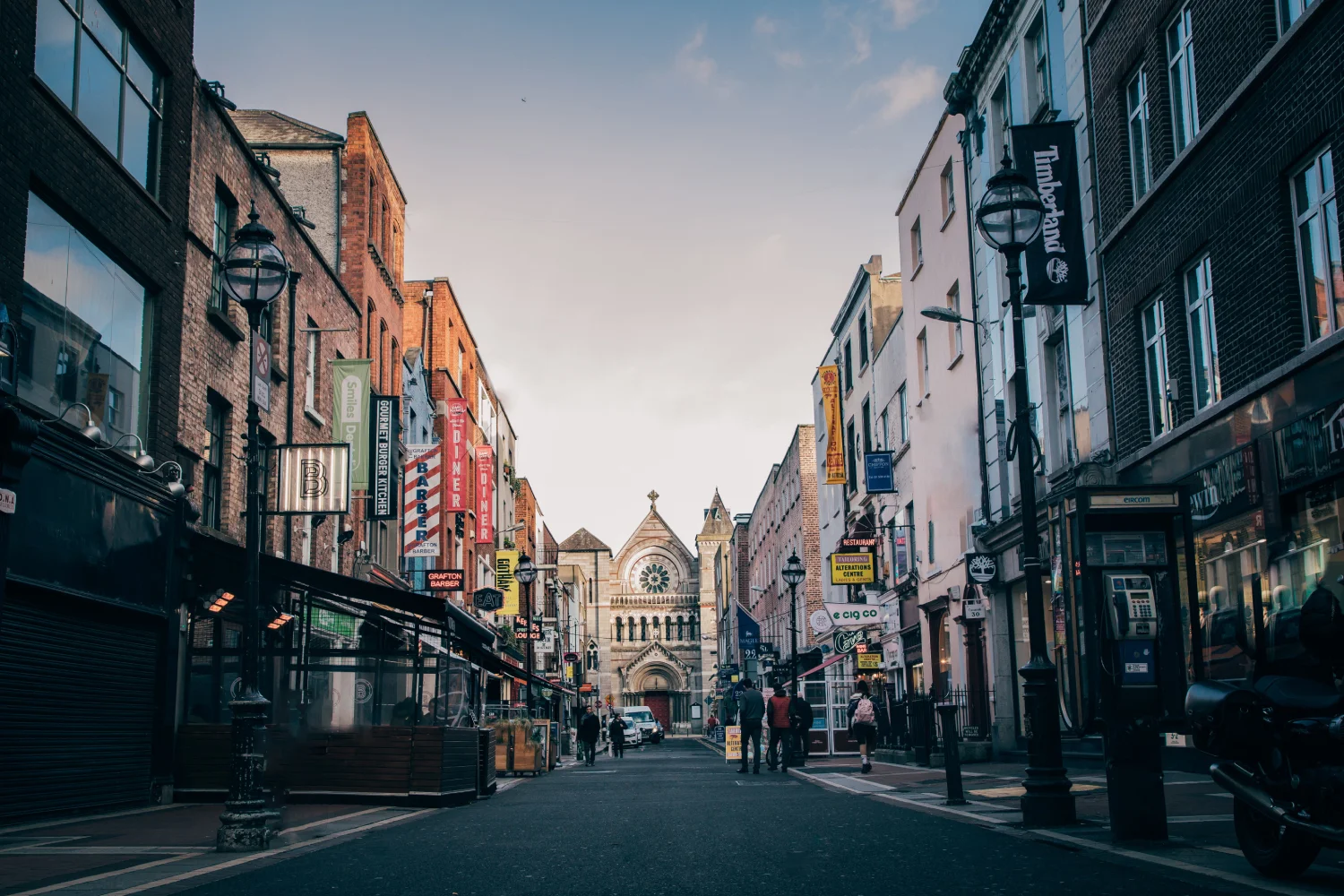
The best option to arrive in Dublin from Glasgow is flying. The flight only takes one hour and, because there are several low-cost airlines covering the route, tickets range between $15 and $50 USD. Once you have figured out your transportation, CONGRATULATIONS! You are in one of the youngest and most fun cities in Europe, so it is time to explore Dublin in 3 days:
- O’Connell Street and Henry Street
- Trinity College
- Dublin Castle
- Christ Church Cathedral
- Guinness Storehouse
- Saint Patrick’s Cathedral
- Dublin Writers Museum
05. Book your flights from home
Once you have decided on your itinerary, you can detect which are the best cities to start your trip. If you want to save money, it is always useful to spot more than one place to fly from home so you can choose the cheapest option available.
Suppose you are following our 15 days England, Ireland and Scotland itinerary. In that case, you will see that you can either start your trip in London and travel “in a circle” until you reach Dublin or you can fly to Dublin and follow the itinerary the other way around.
How do find the best flight price to England, Ireland and Scotland
Because we know that booking flights can be a hassle, we will show you step-by-step the process we follow to find the best airfare prices for your multi-destination trip.
The first step is to pick up from your itinerary two options to travel from and use Google Flights to check the round-trip fares from your hometown to those destinations. In this example, we are going to follow the England, Scotland and Ireland itinerary that we mentioned before and pretend that we are travelling out of Chicago from 07/12/2020 to 07/27/2020.
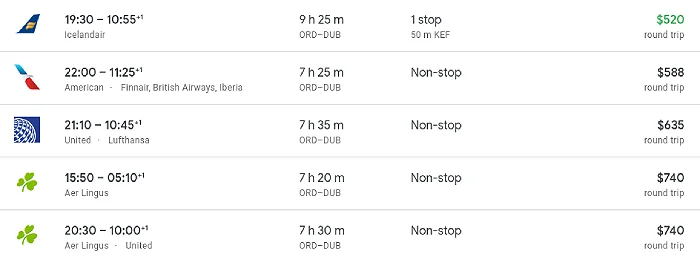
While flights from Chicago to London cost an average of $400, flying from Chicago to Dublin during the exact same dates goes from $520 to $740, with an average cost of $620. In this first instance, the cheapest option is to fly into London with British Airways for $382.
The second step is checking the multi-city flights on the same dates. In this case, we are going to check the price for the following trip: Chicago – London / Dublin – Chicago

As you can see, by taking advantage of stopovers and airline alliances, the flights from Chicago to London / Dublin to Chicago cost only $100 more than a round trip from Chicago to London on our dates. If you factor in the time you have to spend going back from Dublin to London for your flight back home, the extra airport transfer costs ($9 average cost from Dublin city center to the airport), and the cost of the extra flight (expect to pay between $25 and $60 for a flight from Dublin to London + baggage fees), then this option not only is the most convenient but it also costs barely the same than the first one.
06. Book transport tickets to move around each destination
Now that you have decided on your itinerary and secured your flights to get from and to your hometown, it is time to decide how you are going to move around the three countries. You can choose between:
Car Rental:
England, Ireland and Scotland is a great region to jump into a road trip, and this option will allow you to explore smaller towns while you travel between one of your main destinations to another. However, it is important to keep in mind that you will have to drive on the left and that most of the cars in the UK and Ireland are manual, which means that hiring an automatic one can usually cost more.
Resources: RentalCars.com can help you compare prices between many car rental companies in UK. This guide to UK toll roads can be also helpful when trying to estimate toll fares for your itinerary.
Train connections through Ireland, Scotland, and England are one of the most extensive in all of Europe. This option is one of the most convenient in terms of comfort since trains are the fastest and if you plan the itinerary accordingly, you won’t need to change stations between one destination and another. The downside is that the train is also one of the most expensive ways to travel around the UK and Ireland, so it is advised to book your tickets as soon as you can so you can access discounted fares.
For travelling around England, Scotland and Wales, you can also consider purchasing a Britrail Pass that will allow you to travel across the entire National Rail network of Great Britain. If you plan carefully your itinerary, purchasing a pass for 2, 3, 4 or 8 days can save you a good amount of money.
Resources: Rail Europe is a great place to compare different train prices and they are also one of the few official sellers of the Britrail Pass. Checking UK’s National Rail website and the Irish Rail homepage is also recommended.
While buses are the cheapest alternative to moving from one destination to another, in terms of time, they are the slowest option if you compare them to renting a car or taking the train. Depending on your itinerary, sometimes the good thing about taking the bus is that they can serve some direct routes that trains won’t.
Resources: Megabus , Stage Coach Bus and National Express are some of the most known services that offer routes around this area.
England, Ireland and Scotland are served by many budget airlines. A flight from one point to another in this region won’t take you more than 1 hour and a half, and you can find fares for as low as $20. However, it is important to factor in the time and cost of moving from your hotel to the airport, arriving 2 hours before and then moving from the arrival airport to your accommodation again.
Resources: Google Flights is a great place to start when looking for air tickets. You can compare many providers and book directly from the airline.
What is the best option to travel around England, Ireland and Scotland?
There isn’t a unique answer on how to travel around England, Ireland and Scotland because it depends on your itinerary, the length of your trip and if you are planning to travel on a budget or if you prefer to spend more on comfort. However, the best option for travelling around the UK and Ireland will probably involve a combination of trains, buses, and flights.
Once you have your itinerary around the area figured out, the smart thing to do is to compare prices and timetables between each transportation option and book it as soon as you can, considering that when you book earlier you can get deep discounts fares, especially on trains and buses
07. Book your accommodation in Scotland, England, and Ireland
When doing a multi-city trip, we always advise booking your transportation first because you will be able to know if you need to look for an apartment or hotel with early check-in, if you are going to travel overnight and skip a hotel night, etc. Once you know this, it is time to book your accommodation.
While it is true that the UK and Ireland are not the cheapest destinations, there are many hostels, hotels, beds, and breakfast and apartment rentals to pick from, which means that if you do your research you will be able to find accommodation for your trip that suits your budget.
Tips for booking accommodation in Scotland, England, and Ireland
- Do a quick look of prices in Agoda and calculate the average cost of a night in your destination. This will help you to set a base price and recognize when a specific hotel/apartment/hostel is a bargain and when it costs a little bit more.
- If you are backpacking and want to keep the costs of accommodation down the first place you should check is HostelWorld. This does not mean that you shouldn’t check hotels too, sometimes when travelling with friends the cost of splitting a hotel room ends up being the same as booking multiple beds in a hostel, so don’t limit yourself just because you are on a budget.
- If you are travelling with your family or a large group consider looking for an apartment at Airbnb instead of a hotel. Most of the time, the cost of a two-bedroom rental is less than booking two different hotel rooms.
- Sometimes you will be tempted to stay outside of the city center in order to save in accommodation. This option only makes sense if you factor first the cost of daily transportation to the center, so make sure to do the math, otherwise, you may end up paying the same and losing more time transferring from zone to zone.
- If you are doing a road trip check parking costs around your accommodation. If you are looking to rent an Airbnb it is worth asking your host where is the cheapest place around the apartment to park your car.
08. Pack your suits and have fun!
No guide about how to plan a trip to England, Ireland and Scotland should be complete without some useful information about what to pack for a trip to Ireland and the UK. Once you have everything sorted out it is time to pack your suits and head to the airport before doing so, it is important to check the weather forecast one week before departing home so you can pack accordingly. Even when visiting the UK and Ireland in summer, you can expect rain and cold weather so keep that in mind when deciding what to bring to your trip.
Packing list: what you can’t miss when travelling to England, Ireland and Scotland
- Windproof umbrella: while there is the truth that people have exaggerated about the amount of rain that the UK region gets, it is true that if you are travelling around England, Ireland and Scotland during any part of the year, chances are that you will have at least one rainy day during your trip. In order to be prepared and avoid having to change your plans due to the rain, it is wise to carry a small and windproof umbrella with you every time you go out.
- Rain coat: as stated above, you won’t escape the rain during your trip, so be prepared with a raincoat. According to your style, you can choose to go for a more sporty one like this Levi’s lightweight anorak or choose a more stylish trench raincoat that will help you blend among locals when visiting more upscale bars and neighbourhoods.
- International travel adapter : from your smartphones to your hair styling tools, you will need to charge your belongings while travelling so make sure to bring the proper adapter with you. While there are adapters made specifically for England, Scotland and Ireland, we recommend you buy an interna t ional adapter instead since it will cost almost the same and will be useful for future trips.
Recap: how to plan a trip to England, Ireland and Scotland
- Research the best places to see in the United Kingdom
- Decide how much time you can travel around the United Kingdom
- Figure out Visa restrictions
- Create an itinerary for your trip
- Book your flights from home
- Book transport tickets to move around each destination
- Book your accommodation in Scotland, England, and Ireland
- Pack your suits and have fun!
Similar Posts

10 Best Hostels in Asia for the Luxury Backpackers
Are you planning your next holidays and wondering which are the best hostels in Asia? If Leonardo Di Caprio and The Beach is the first thing that comes to mind when considering Asia on a budget, then fear no more! And read this helpful guide to choose your backpacker accommodation wisely. In the past few…
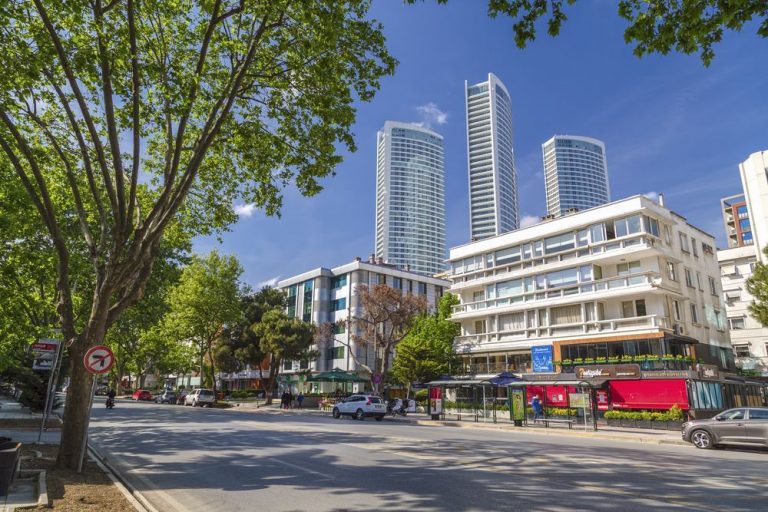
13 Best Things to Do in Kadikoy, Istanbul Asian Side
Kadikoy is a diverse neighbourhood on the Asian side of Istanbul. It is known for its cultural experiences and is popular among locals and expats. We’ve listed the top 13 things to do in Kadikoy, including historical and trendy art spots. Consider staying in Kadikoy during your visit to Istanbul to explore the area fully….

14 Best Things to do in Buenos Aires Argentina
Incredible food, lively nightlife and thousands of free things to do are some of the reasons that make Buenos Aires one of our favourite cities in the entire world. Whether you are backpacking around South America or just want to keep the cost down, there are many interesting places to see without spending a dime…

How to get from Ezeiza to Palermo, a complete guide
It is undeniable that Buenos Aires is one of the most beautiful cities in the world and, while it is easy to transfer between Ministro Pistarini Ezeiza, its international airport, and the center of the city, there are many other beautiful and touristic areas where visitors from abroad usually stay that are a little more…
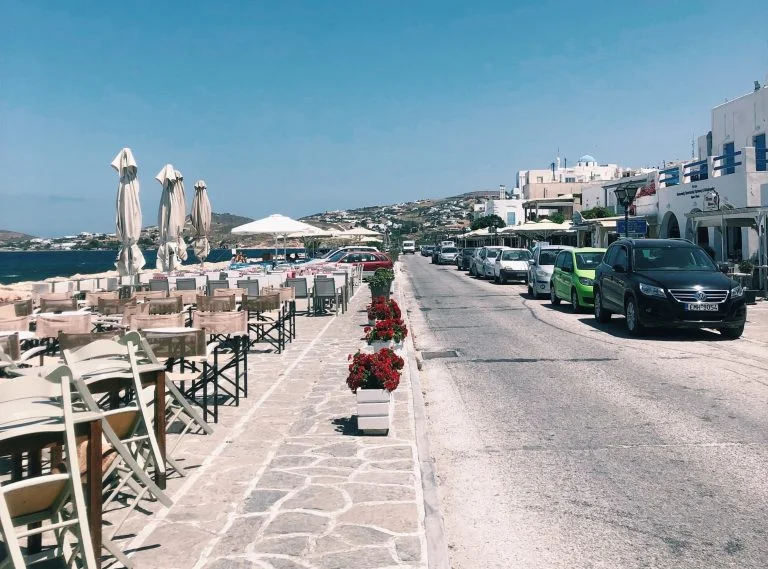
Parikia or Naoussa? – Which Place is the Best to Stay in Paros
Choosing Parikia or Naoussa is one of the hardest things to do when deciding the best place to stay in Paros. All of the villages on Paros island have their charm. We have gathered reasons to stay in the two main town centers of the island so you can decide where to stay in Paros,…
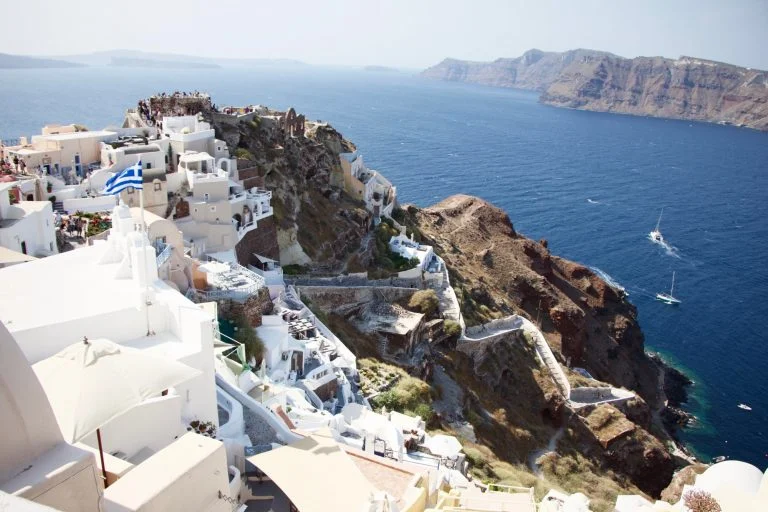
3 Days in Santorini – How Much is a Trip to Santorini Greece?
Whether you are planning a romantic getaway for a honeymoon in Santorini or trying to organize a trip to the famous greek island with your best friend, the cost of vacationing in Santorini is often an issue that comes to the mind of travellers that are looking to spend some time in this paradise. Because…
Leave a Reply Cancel reply
Your email address will not be published. Required fields are marked *
Save my name, email, and website in this browser for the next time I comment.

How to Plan a Trip to England, Ireland and Scotland
Thinking of visiting England, Ireland and Scotland but don’t know where to start when it comes to planning? This guide will help you put together a fuss-free trip.
When it comes to preparing for a trip, especially to three countries, there are so many different things to keep in mind – what to do, where to go, accommodation, how you’re going to get around… the list goes on. To make it easier for you, I’ve put together a guide to organising your travels around England, Ireland and Scotland.
Keep reading for the ins and outs on planning a trip to England, Ireland and Scotland.
Disclaimer: Hi! this post may contain affiliate links which will take you to online retailers that sell products and services. If you click on one and buy something, I may earn a commission, see my Affiliate Disclosure for more details.
England truly has it all – charming little villages, thriving cities, dramatic coastline and expansive countryside. There’s also plenty of history, culture and heritage to explore everywhere you go.
Planning What to Do & Where to Go
Many people make the mistake of going to England and only visiting London. There is so much more to England and if you take the time to explore it, you’ll find plenty of fascinating history and culture.
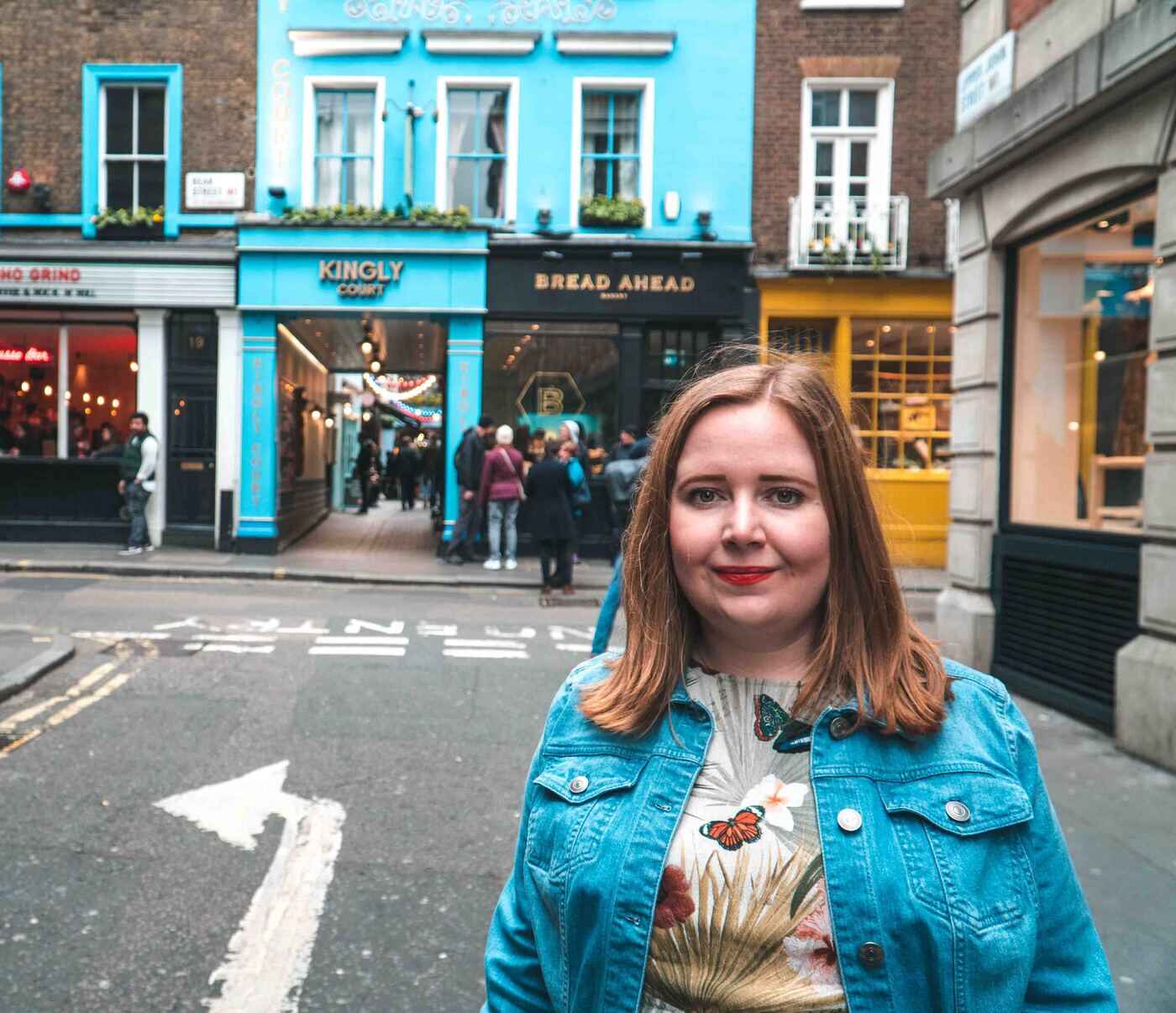
England has some fantastic cities that offer plenty of things to see and do. You’ll find vibrant food and drink scenes, world-class attractions and cultural activities. In the South West, you have cities like Bath, Bristol, Plymouth and Exeter which offer history, cultural attractions and plenty of outdoor activities. In the South East, find super-cool Brighton, historic Oxford and nautical Portsmouth.
Towards the East of the country, you’ll find the famous Cambridge, home to the world’s fourth oldest university. Although it doesn’t get as many tourists as southern cities, Central England and the Midlands has some exciting cities to visit. It’s home to England’s second largest city, Birmingham, where you’ll find Victorian architecture and heritage museums. Head to Lincoln for the medieval Cathedral Quarter, and Nottingham for the famous Robin Hood trail.
It’s definitely worth visiting the North of England. In the North West, there is the Roman city of Chester, vibrant Manchester and cultural Liverpool. In the North East, find cities like Leeds, Newcastle, York and Durham, all offering a mix of history, culture, food and drink, museums and sports.
But despite how amazing the rest of England is, London is still a fantastic place to visit. It’s a vibrant, world-class city with a lot going on. London is made up of many different neighbourhoods, each with their own vibe.
The great thing about London is that there’s something for every kind of traveller. Whether you’re a backpacker or a luxury traveller, whether you’re into tourist sites or discovering history, you’re bound to find something up your alley.
Sometimes the best way to get a feel for a city is to get off the tourist trail and experience it the way locals would. Check out this guide to what to do in London as a local .
Countryside

It wouldn’t be England without the rolling green hills, misty moors, forests and lakes. If you’re keen to get outdoors, England has plenty of forest and woodland walks .
England has 10 National Parks, each offering a beautiful diversity of landscapes. There are plenty of activities within these National Parks, including walking, hiking, horse riding, cycling, rock climbing, stargazing, sailing and water sports.
Whether it’s exploring dramatic caves in North Yorkshire, discovering beautiful lakes in the Lake District, or riding on heritage railways through different counties, England truly is a haven for lovers of the outdoors.
Coastal towns
While you wouldn’t necessarily think of England as a great destination to relax on the beach, you’d be surprised at how stunning some of the coastal areas are. England is home to some charming coastal towns and fishing villages, as well as exciting seaside resorts. No two parts of the English coast are the same, so wherever you go, you’re bound to find something different.
You’ll find some of the warmest spots around the South West, where counties like Cornwall, Dorset, Devon and Somerset boast warm weather, blue seas and family-friendly beaches. Thrill-chasers looking to experience a traditional English seaside holiday should visit Brighton, Scarborough, Blackpool, Weymouth, Margate, Falmouth, Southport and Tynemouth.
The beaches and coastal towns in England have plenty of activities, whether it’s arcades, coastal walks, fossil hunting or watersports. Not to mention the choice of fresh seafood on offer!
Some useful resources to help you plan:
- Visit England is a really useful site. As the official tourist board for England, you’ll find a whole ton of information on places to visit, things to do and practical information and advice. What’s useful is that you can explore England by county, making it so much easier when putting together an itinerary.
- English Heritage is a charity that takes care of over 400 historic buildings, monuments and sites all over the country. On their website, you can find information of the different places to visit throughout the country. If you’re interested in visiting a bunch of different historic sites, you can purchase an Overseas Visitors Pass which is better value for money than if you were to pay entry prices at each individual place. Valid at over 100 places, you can choose between 9 or 16 day passes. If you’re on a budget, you can also find a whole range of days out for under £20 for the whole family.
- National Trust is also an independent charity, focusing on environmental and heritage conservation. It owns over 500 heritage properties which include historic houses and gardens, social history sites and industrial monuments. On their website, you can find information about the range of days out, whether it’s outdoors, houses and buildings, or parks and gardens.
- The National Trust also has a wide selection of accommodation, whether it’s campsites, holiday cottages, hotels or bothies and bunkhouses. Like English Heritage, you can also get an Overseas Visitors Pass which can save you money and time when visiting National Trust sites. You can purchase either a 7 or 14 day pass which gives you free entry to over 300 historic houses and gardens.
How to Plan Accommodation
If you’re visiting during the holiday season, it’s best to book your accommodation well in advance. England is a very popular tourist destination, with most tourists visiting during the summer months, which is between June and August. The peak season tends to peter out in September, so you may find more options around that time.
When it comes to choice, you won’t find it difficult to find your dream accommodation. England has a great range of accommodation to suit every kind of budget and traveller, whether it’s hostels, B&Bs or luxury hotels. You can even find more unusual types of accommodation, such as castles, canal boats and farms. If you’re the outdoorsy type, you might even be interested in camping, caravanning or glamping (if the weather’s decent!).
If you’re travelling on a budget, you might want to consider staying in hostels, as you can get some pretty good deals. Websites such as Hostelword and Hostelbookers are some of the best known sites. YHA is a charity that provides over 150 youth hostel accommodations in England and Wales. You can find high quality and low cost hostels, camping and glamping which are suitable for both families and backpackers. Here’s a general guide I put together to how much you should budget for a week in England .
Budget hotel chains
Budget hotel chains are always handy if you’re looking for comfortable and affordable accommodation. Some of the most common ones you’ll find throughout the country include Premier Inn, easyHotel, Holiday Inn Express, Ibis, Travelodge and Point A Hotels in London.
For anywhere mid-range to luxury, your best bet is to find accommodation using websites like Booking.com, Trivago, TripAdvisor, Agoda, Expedia and Kayak. If you’re the type of person to leave things to the last minute, LateRooms is great for finding last minute deals.
Staying with locals
A large part of travelling is getting to know the country beyond its famous sights, meeting locals and immersing yourself in the culture. A great way to do this is by staying with locals. You get to know more about the country you’re visiting, and get precious insight to the best places to eat, drink, shop and hang out! There are paid accommodation sites like AirBnb and Homestay, but you can also find free accommodation on sites like Couchsurfing and Trustroots.
Camping, glamping and caravanning
During the warmer months, it’s pretty fun to camp in England. The country is a treasure trove of camp spots, whether you head into the remote woods, set up your campervan by the beach or load up your touring caravan and bring your whole family to a holiday park. There are some very helpful websites you can use to find campsites throughout the country, including Camping in the Forest, Pitchup and Campsites.
How to Plan your Arrival
If you plan on arriving in London, it might be useful to point out that London has six airports (London City, London Gatwick, London Heathrow, London Luton, London Stansted and London Southend). All of these airports are well connected to central London.
If you’re planning on being based in the North, then the best airport is Manchester Airport. As the main international gateway for the north of England, you can easily get to anywhere in the North from here. The airport has a coach and train station with links to other major northern cities.
If you’re arriving from Europe, you may consider arriving by Eurostar. Travelling through the Channel Tunnel, you’ll arrive at St Pancras International in London.
Planning Travel Logistics
First things first, we need to talk safety. In this guide I put together, you can read up on why getting travel insurance for your trip to the UK is a good idea.
Now that we’ve got the boring stuff out of the way, let’s get travelling! A great thing about England is that it’s so easy to get around. To give you an idea of the places you can see, have a read of this guide to the best places to visit in England without a car .
If you’re going to be spending time in London, then Transport for London (TfL) is the main transport network you’ll encounter. Whether you use buses, the Tube or the Overground, London is well-connected and in general, you get anywhere within the hour. To get into stations and on buses, you can tap your contactless card to pay.
Alternatively, you can get an Oyster card and top it up with credit, which you then tap at the pay points. There’s also the option of getting an Oyster Visitor card which is a quick and easy way to pay for travel. It’s convenient because you can get it delivered straight to you before you even arrive in England.
The great thing about London is that it’s super easy to get around on foot. Walking is one of the best ways to take a city in and to soak up the atmosphere. If you plan on doing a lot of walking while in London, check out this guide to the best places to stay in London for walking .
England has a great rail network . While it’s considerably more expensive than other countries in Europe, there are fantastic connections and they do generally run on time. Trains are one of the easiest ways to get around the country. It’s also a scenic and relaxing way to discover England. Why not find some inspiration with this guide to the best places to visit in England by train .
To book tickets, I would recommend using Trainline . It’s an independent ticketing platform where you can search train times and buy tickets . Be aware that individual train companies like TransPennine Express and LNER can sometimes have flash sales, so it’s worth checking their websites.
If you’re on a budget and aren’t pressed for time, I would suggest using coaches to get around. They’re so much cheaper than trains, and you can still get to major cities around the country. However, they don’t generally go to smaller towns so you’ll need to use local public transport connections if you do plan on going a little more rural.
There are two main coach companies that operate in England: National Express and Megabus. National Express has a nationwide network of over 1,200 destinations. Megabus links 90 locations around the UK, and even offers tickets from as little as £1!
A transport tip for budget friendly travellers is to book in advance. Anything up to two weeks in advance (especially on trains) can save you a significant amount of cash.
Hiring a car is a great way of getting round, especially if you’re travelling with younger family members or plan on visiting remote, rural areas. Some of the most popular car hire companies are Avis, Budget, Enterprise, Europcar and Sixt. If you want to shop around first, websites like Kayak and Travel Supermarket are handy when it comes to comparing different companies to get the best deals.
Ireland & Northern Ireland
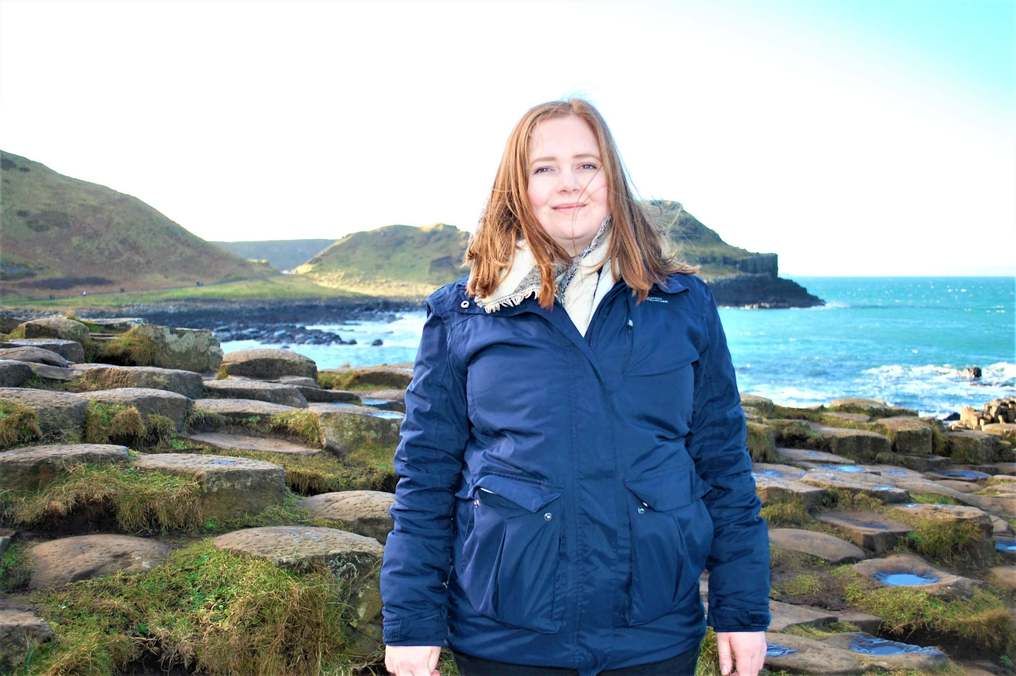
Ah, the Emerald Isle. Not to be confused with Northern Ireland, the Republic of Ireland is a country independent to the UK. This green, friendly island attracts millions of people each year to experience the breathtaking scenery and magical culture.
Planning What to Do & Where to Go
Ireland and Northern Ireland have a variety of places to visit, whether it’s landmarks, vibrant cities, mountains, beaches and countryside.
It goes without saying that no visit to Ireland is complete without a trip to Dublin. This rowdy city is home to Guinness-fuelled pubs, beautiful Georgian architecture and exciting attractions. Whether you’re looking to live it up at Temple Bar, learn how Guinness is made at the Guinness Storehouse, delve into history at Dublin Castle and Malahide Castle or relax at the National Botanic Gardens, there is plenty to do here.
You can also take a trip to Cork, Ireland’s second largest city. This lively, fun-loving city has tons of coffee shops, traditional pubs and historic attractions. Another must-see city is Galway City. Once a Medieval trading port, this city is an artsy, bohemian destination with plenty of history to explore. Although tourists don’t tend to visit Limerick, it’s worth stopping by if you’re interested in castles, cathedrals and museums. It’s also a fabulous place for foodies, with a great selection of artisan food markets and street food.
Belfast is definitely a hidden jewel of the UK. The city and country has had a turbulent past, called the troubles but now that has settled it has allowed the country to grow. The city became popular to visit after Game of Thrones! I highly recommend visiting Crown Liquor Saloon, grabbing some food at St Georges Market, enjoying the nightlife in Cathedral quarter and wandering around the Botanic Gardens.
Ireland is known for its breathtaking vistas and natural wonders. If there’s only one thing you do in Ireland, make sure you head out into the countryside. An entire list of beauty spots would be exhaustive, but a good place to start is National Parks. Ireland is home to six National Parks, each offering stunning views, lakes, mountains, woodlands and wildlife. Visit any of them and you won’t be disappointed.
One of the country’s most famous natural attractions, the Cliffs of Moher, stretch for five miles along the west coast of Ireland, and reach up to 702 feet high in some parts. Let’s just say the views from here are inconceivable. If you’re feeling up for a challenge, take a boat ride out to Skellig Michael.
This towering, emerald green island is home to the remains of a 6th century monastery – but you’ll have to climb the 600-step staircase to get there! If you fancy a scenic drive, the Ring of Kerry is a must. The trail runs through 120 miles of southwestern Ireland’s most incredible landscapes. As well as glacial lakes, lush meadows and rugged mountains, the trail also passes iconic landmarks like the Beara Peninsula and the Kerry Way.
With over 1,450km of coastline surrounding the island, there’s bound to be some fantastic coastal destinations. If you want to visit the seaside but don’t want to travel too far from Dublin, the beautiful little town of Skerries is a great place to visit. With pastel coloured shops and cafes along the seafront, stunning scenic walks and a variety of watersports, it’s an ideal place for a quick day trip.
Tramore is a seaside village in County Waterford that has become one of Ireland’s most popular tourist destinations – and for good reason. Take a stroll along the promenade, or relax on the 5km stretch of beach and sand dunes. There are plenty of leisure activities for the whole family to enjoy, including surfing, horse riding and visiting sites like Reginald’s Tower.
If you’re travelling with your family, you might consider visiting Enniscrone in County Sligo. This small seaside town has sandy beaches and campsites, and is popular with families. Try adrenaline-fuelled activities like surfing or horseback riding, or unwind in the Enniscrone Seaweed Baths.
- Ireland.com is the official tourism website for the country. It’s a really handy tool that you’ll want to keep referring to on your trip. There is information on different destinations in the country and things to do depending on what you’re interested in (eg. cycling, food and drink, sports, literature).
- If you’re not really sure where exactly you want to go, or if you’re interested in seeing a bit of everything, they’re even put together different trip ideas where you can journey through the most beautiful parts of Ireland. Whether you’re after culture, coastal views, film locations, or want to get off the beaten track, you’ll find something to suit your interests. There’s even a Game of Thrones trip where you can visit the different filming spots! On the website, you can also find a range of accommodation, and get help and advice about travelling within Ireland.
- Discover Ireland is another great site that you should take advantage of. This website is geared towards things to do, and you’ll find activities grouped by theme, for example cities, surfing and cruises, as well as Viking Adventures, Medieval Mysteries and Mighty Kingdoms. If you’re interested in exploring the country by region, you’ll find a guide to different areas, including Ireland’s Hidden Heartlands, Wild Atlantic Way, Ireland’s Ancient East and Dublin.
Like England, Ireland’s peak season is in the summer months, which is between mid-June and mid-September. If you’re visiting during this time, I’d recommend you book your accommodation well in advance to avoid any disappointment. If you want to avoid the tourist crowds but still want to catch some of the good weather, it’s a good idea to visit during the shoulder season which is April, May, early June and early October. Plus, prices tend to be cheaper around this time so you may bag some great deals.
Ireland offers a wide variety of accommodation for every kind of budget and traveller. From hostels and budget hotels for the cash conscious traveller, to staying in local homes and sleeping on the road.
Hostels
If you’re on a budget, then you may want to stay in a hostel. Aside from saving money, staying in hostels also allows you to meet like minded travellers and make new friends!
You’ll find plenty of choice on websites like Hostelworld and Hostelbookers. Additionally, you can try independent sites like Hostels Ireland, or Independent Hostels Ireland. An Óige is the Irish Youth Hostel Association. They have 22 youth hostels located around the country that offer safe and comfortable accommodation for families, groups and individuals of all ages.
If you’re the kind of traveller who is out exploring all day and only comes back to the hotel to sleep, then you may want to consider staying at a budget hotel. They’re comfortable and affordable, and are usually quite centrally located. You’ll find the same budget hotel chains in Ireland as you would in England: Premier Inn, easyHotel, Holiday Inn Express, Ibis and Travelodge.
To experience the delightful Irish hospitality, there is a huge choice of hotels to stay at, from one star to five stars. The easiest way to find hotels is by using accommodation booking websites like Booking.com, Trivago, TripAdvisor, Agoda, Expedia and Kayak. Ireland Hotels is also pretty useful as it gives you advice and information based on region, type of accommodation and type of holiday.
The Irish are a friendly bunch, and a great way to get to know them better is by staying with them. Sites like AirBnb and Homestay let you find paid accommodation where you can stay with an Irish host. If you’re on a tight budget, you can try websites like Couchsurfing and Trustroots where you can stay for free.
As Ireland is full of stunning natural spots, it makes sense to camp if you can. Bring your tent, touring caravan or motorhome to experience the freedom of Ireland’s landscape. To find campsites, use websites like EuroCampings and Pitchup.
For something a little fancier, try glamping. Ireland Glamping is a handy tool to find the best glamping spots around the country. If you enjoy the freedom of camping and caravanning but prefer something a little comfier, self-catering accommodation could be the right choice for you. Imagine Ireland have a fantastic choice of holiday cottages all around the country.
Before arriving in Ireland, you should take into consideration where you would like to arrive and where you’ll be spending the most time. Ireland has five international airports: Dublin Airport on the east coast, Cork Airport on the south coast, Shannon Airport on the west coast, Knock Airport in the North West and Belfast Airport in Northern Ireland.
If you’re arriving from Scotland, England or Wales, there is also the option to take a ferry. The main Dublin ferry port offers the most convenient location. It also has great connections to the M1 motorway if you wish to travel up North. If you’re planning on travelling further south of the country, Dublin’s second ferry port of Dun Laoghaire is located in the southern suburbs near Blackrock. It’s also the better choice if you want to avoid the traffic of central Dublin.
Ireland’s compact size means it doesn’t take long to get around the island. In fact, driving across the country from Dublin to Galway only takes two and a half hours which makes the perfect place if you’re on a tight schedule. As well as driving, you can also travel around by boat, train and coach.
Ireland is home to numerous islands, rivers, lakes and canals which are worth exploring by boat. Most of the islands can be visited by ferry, depending on the weather. Some ferry companies only operate seasonally between June and August, so make sure to check timetables in advance!
Iarnród Éireann (Irish Rail) is the main rail network in Ireland. It’s not very extensive, and only serves larger cities and major towns. If you’re planning on travelling to rural, remote areas, I’d recommend using the local bus services instead. If you decide you’ll be travelling by train, you may want to consider using Iarnród Éireann’s Explorer Tickets which give you different travel options and cheaper deals. If you’re spending most of your time in Dublin, I’d recommend purchasing a Dublin Explorer Ticket for the DART (Dublin Area Rapid Transit), the electric rail system that lets you get around Dublin quickly and easily.
Getting around Ireland by coach is a great way to take in all the sights. Bus Éireann is the main coach company in Ireland and has routes all around the island. There are also many private coach tour operators which run city to city trips, airport transfers and themed trips. There are numerous tour companies in Ireland that going through them all would be exhausting. Tourradar makes it easier to decide as you can filter by age range, price, destination and duration.
The best way to get outdoors and see the rural side of Ireland is by car. You’ll have more luck finding car hire companies in airports and cities. There are different options when it comes to booking, including travel booking sites like Kayak and direct websites like Hertz, Enterprise, Avis, Six, Europcar and Budget. If you prefer to shop local, choose the Irish owned Irish Car Rentals.
There’s a lot more to Scotland than haggis, bagpipes and the Loch Ness Monster. Scotland is full of historical attractions, cultural experiences and breathtaking natural beauty. Whether you want to explore the cities or head out into the wilderness, this country offers something for everyone.
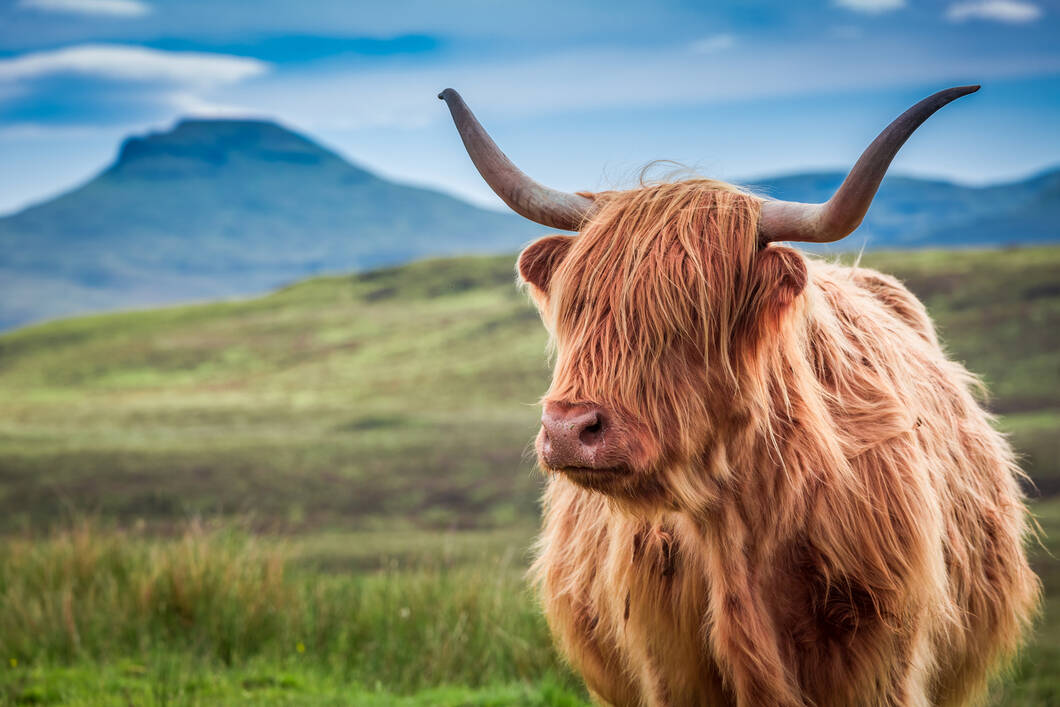
Edinburgh is Scotland’s capital city and one of the top spots for tourists. To immerse yourself in history, head into the Medieval old town and discover sites like Edinburgh Castle and Mary Kings Close. Hike up Arthur’s Seat, an extinct volcano boasting panoramic views over the city. Make sure to visit Glasgow, Scotland’s largest city.
If you’re a shopaholic then you’ll feel right at home here, as it’s known for being a great shopping destination. Glasgow also has a fantastic music scene (with a status as UNESCO City of Music) with plenty of music venues each offering something different. Dundee is another fabulous city, and is the UK’s first UNESCO City of Design. All year round there are exciting events, including the Jazz Festival and Scotland’s biggest food festival.
Its compact streets are packed with treasures like old bookshops, artisan cafes and architectural delights. Believe it or not, Scotland does get its fair share of sun, although most of it seems to shine down on Aberdeen. Regularly named the UK’s sunniest city, Aberdeen is the best place to spend some time if you’re looking for a mix between city and outdoor activities. With beautiful beaches dotting its coastline, it’s an ideal place for a relaxing getaway.
Heading further north you’ll find Inverness, a cathedral city in the Scottish Highlands. It’s the perfect base if you’re going to be exploring Scotland’s magnificent outdoors. But the city itself doesn’t disappoint. With a vibrant culinary scene, fantastic shopping opportunities, and art, history and heritage events and festivals.
Renowned for its mountains, lochs and glens, Scotland truly is a special place when it comes to the outdoors. A definite must is a trip to the Scottish Highlands. This mountainous region in northwest Scotland boasts majestic views and wild scenery everywhere you look.
Go in search of the famous Loch Ness Monster, or follow in Harry Potter’s footsteps on the West Highland Line across the Glenfinnan Viaduct. If it’s castles you’re after, Eilian Donan Castle is arguably the most iconic and photogenic castle in Scotland. There’s also the fairytale Dunrobin Castle, Ardvreck Castle, Cawdor Castle and Castle Varrich, to name a few.
If you’re a serious climber, why not challenge yourself to hike up Ben Nevis, the UK’s tallest peak. Scotland has two National Parks – Cairngorms National Park and Loch Lomond and The Trossachs National Park. You’ll find plenty of walking routes for all abilities, as well as other activities like cycling, rock climbing, mountain biking, pony trekking and even skiing! If you have the time, you should consider taking a trip to the Isle of Skye. With incredible spots like The Storr and Quiraing, the island is just full of epic landscapes.
Scotland isn’t a place that screams beach destination, think again. This country has numerous seaside towns and villages that offer beautiful views, exciting activities and rest and relaxation. Plockton, also known as the ‘Jewel of the Highlands’ is a picturesque Highland village set on the shores of Loch Carron Bay.
There are many water activities to get involved with, as well as cycling and hiking. Or if you just feel like relaxing, the harbour is a peaceful place to sit and watch the boats and come and go. Aberdour is a lovely seaside town in Fife. Featuring two beaches, a harbour, a 13th century castle, a golf course and plenty of shops and cafes, the town is a great place to bring the family.
For somewhere with a little more going on, head to North Berwick which isn’t too far from Edinburgh. From fancy hotels and spas, to restaurants and funky coffee shops, the lively town has plenty to keep everyone occupied. Relax on the sand and enjoy views across the water to Bass Rock, an island described by David Attenborough as “one of the 12 wildlife wonders of the world”.
- Visit Scotland is the official website of Scotland’s national tourist board. The website is an incredibly useful tool when planning your trip to Scotland, as it has information on pretty much everything you need. There are sections on all the top destinations, as well as interactive maps which make it easier to plan your itinerary. Things to see and do are divided into different categories, from ancestry and castles, to film locations and island hopping.
- You can also find information based on the type of holiday you’re interested in, whether it’s budget stays, city breaks, family breaks or romantic breaks. If you’re pressed for time (or need a little help), the website also has a bunch of itineraries ready to go. There are itineraries for every part of the country and to suit every interest. There is also information on different types of accommodation, as well as practical resources like how to get there and getting around the country.
- Scotland.org is another helpful tool. It’s more generalised than Visit Scotland, and also has information on working, studying and living in the country. However, the Visit section is really useful, and has a lot of information that can help you put together a great trip. Find inspiration on things to do, or whet your appetite with the inside scoop on the food and drink scene. You can also find out about the different kinds of accommodation and essential information about getting around the country.
Like England and Ireland, Scotland’s peak season is in the summer months when the weather is warmest, from July to August. If you’re visiting during the summer, then try to book your accommodation well in advance to avoid any disappointment. Having said that, the best time to actually visit Scotland is in spring (between May and June) and autumn (between September and October). This is when the weather is most likely to be dry and pleasant, plus you won’t have to deal with huge crowds of tourists.
Scotland offers a wide variety of accommodation so you’re bound to find your dream stay. Whether you’re on a budget and in need of a hostel, or whether you want to make the most of the Scottish Highlands, there’s something for everyone.
It’s really easy to find a hostel in Scotland. Plus, they’re not just for the young. Hostels welcome everyone including solo travellers, groups, families and backpackers. You’ll find plenty of choice on websites like Hostelworld and Hostelbookers. You can also try Hostelling Scotland , a non-profit charity who have been welcoming visitors in 1931!
If you want to level up from hostels but don’t want to spend too much, budget hotel chains are your best bet. Scotland has the same hotel chains as England and Ireland, including Premier Inn, easyHotel, Holiday Inn Express, Ibis and Travelodge.
There is a huge choice of hotels in Scotland which range from one star to five stars. The easiest way to find hotels is by using accommodation booking websites like Booking.com, Trivago, TripAdvisor, Agoda, Expedia and Kayak.
The Scots have a reputation for being some of the friendliest bunch in Britain. So what better way to get to know them than to stay in their homes with them? Sites like AirBnb and Homestay are great for finding local hosts you can stay with. If you’re on a tight budget, check out websites like Couchsurfing and Trustroots where you can stay with people for free.
Scotland is a playground for camping enthusiasts. Camping is permitted on most unenclosed land, so bring your tent, touring caravan or motorhome and enjoy Scotland’s natural landscapes. Plus, it’s a good option if you’re on a budget! To find campsites, use websites like Pitchup where you can find campsites with facilities like showers and kitchens.
Glamping is also a fun option if you’re looking for something a little more comfortable than a sleeping bag. There are glamping spots all around Scotland, from forests to lakes to coasts. For somewhere that feels a little more homely, self-catering accommodation is a good choice for a home away from home. Embrace Scotland is a good site to find cottages around the country.
Scotland has five international airports: Aberdeen, Edinburgh, Glasgow, Glasgow Prestwick and Inverness. The airports are all served by flights from European and long haul destinations. Glasgow Prestwick is the only airport which is served by its own station, but if you’re travelling to any of the others, there are numerous buses, coaches and taxis that you can get.
If you’re arriving from England and Wales, you can also take a train. Glasgow and Edinburgh have frequent and direct services from London with operators like LNER, Avanti West Coast and the overnight sleeper services. If you’re arriving from other cities outside London, there are a number of services like Avanti West Coast, CrossCountry and First TransPennine Express.
If you’re arriving from Ireland, there is also the option of taking a ferry which arrives in ports such as Cairnryan, Port Ellen and Campbeltown. All ferries take between one and two hours, depending on the route.
What I love about Scotland is that it’s a relatively small country, with most places being pretty accessible. Travelling to all the main tourist spots is pretty straightforward, and you’ll find that even getting to remote places isn’t all that difficult.
Scotland has an extensive and well-developed train network. There are six main companies: ScotRail, LNER, CrossCountry, TransPennine Express, Avanti West Coast and the Caledonian Sleeper. Although there may seem like plenty of choice, it’s best to focus on the particular route you want to take rather than which company you want to travel with.
The best way to look up routes is by using Trainline, an independent ticketing platform. You can also look up coaches on the app. If you think you’ll be travelling by train a lot, it might be worth using a travel pass to save extra cash. ScotRail offers flexible travel passes depending on how far you want to go.
The Spirit of Scotland Travelpass gives you unlimited train travel within Scotland, and you can even use it on some buses and ferries. There is also the Highland Rover and Central Scotland Rover which offer unlimited train travel, as well as the Rail and Sail which combine train and ferry tickets. If you’re travelling in Glasgow, a cheap and efficient way to get around is by the ‘Clockwork Orange’, Scotland’s only subway.
A good way of saving money getting around is to travel by coach. Bear in mind that coaches take much longer than trains, but you can travel for a fraction of the price of a train ticket. To save the most money, make sure to book in advance to get the best deals. Scotland has the same coach companies as England: Megabus and National Express which have routes to all the major destinations in Scotland.
In my opinion, the best way to get around Scotland is by car. It gives you so much more freedom in visiting remote places, and you can set your own pace and stop wherever you like. Visit Scotland has a handy section on driving in Scotland , where you can read up on rules and get useful tips. Hiring a car in Scotland is pretty straightforward. Websites like Kayak and Travel Supermarket are great for comparing different companies. You can find all the same car hire companies like in England and Ireland: Avis, Budget, Enterprise, Europcar and Sixt.

Kat Hi, I'm Kat, an Australian that moved to London in 2013 to start a new adventure. What a roller-coaster that was! I love helping others move to the UK and people explore the world ! I’d be honoured if you’d say, “Thanks!” with a £3 coffee on Ko-fi.

This site uses Akismet to reduce spam. Learn how your comment data is processed .

The Best Time to Visit Ireland (Pros + Cons of Each Month)
By Author Keith O'Hara
Posted on Last updated: April 26, 2024

There is no single best time of year to visit Ireland, and I’m saying that having lived here for 35 years.
‘Best’ is dependant on you . For example , if you want to visit when the weather in Ireland is likely to be good. ‘Best’ will be summer.
Below, you’ll find the pros and cons for each month to help you decide the best time to visit Ireland based on your likes and dislikes .
But first, a quick overview:
- Summer (Jun, Jul + Aug): Warmest months. Crowd/flight prices are at peak
- Winter (Dec, Jan + Feb): Coldest months. Crowd/flight prices are lower
- Autumn (Sept, Oct + Nov): Days long in Sept + Oct. Short + wintery in Nov
- Spring (Mar, Apr + May): Tends to be rainy in Mar + Apr. Summery in May
The best time to visit Ireland
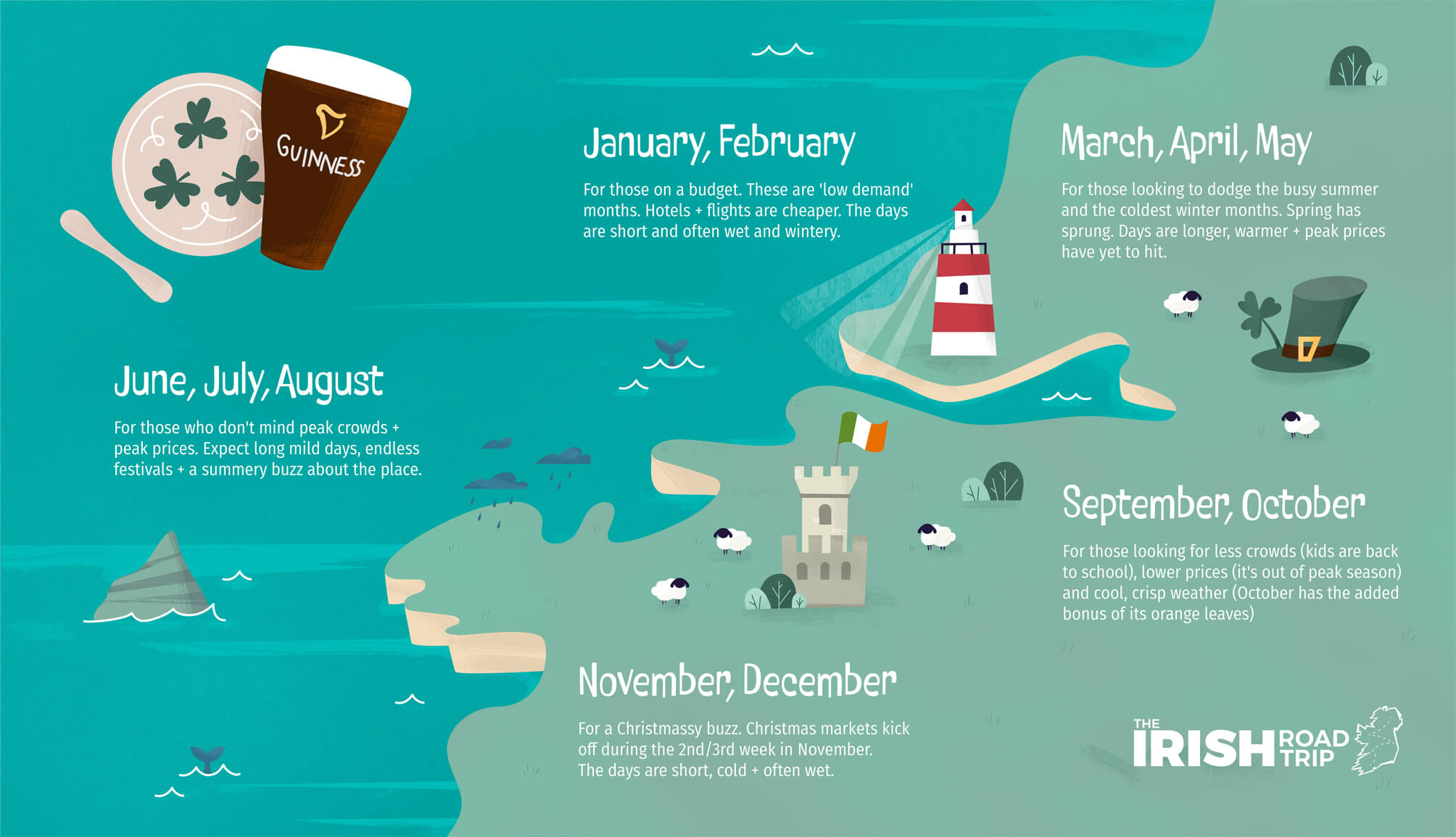
If you take 20 seconds to look at the illustration above, you’ll get a quick insight into the months in Ireland and what to expect from each.
Below, you’ll find an overview of each month with info on average temperatures, festivals, what to wear in Ireland during that month along with travel tips for Ireland .
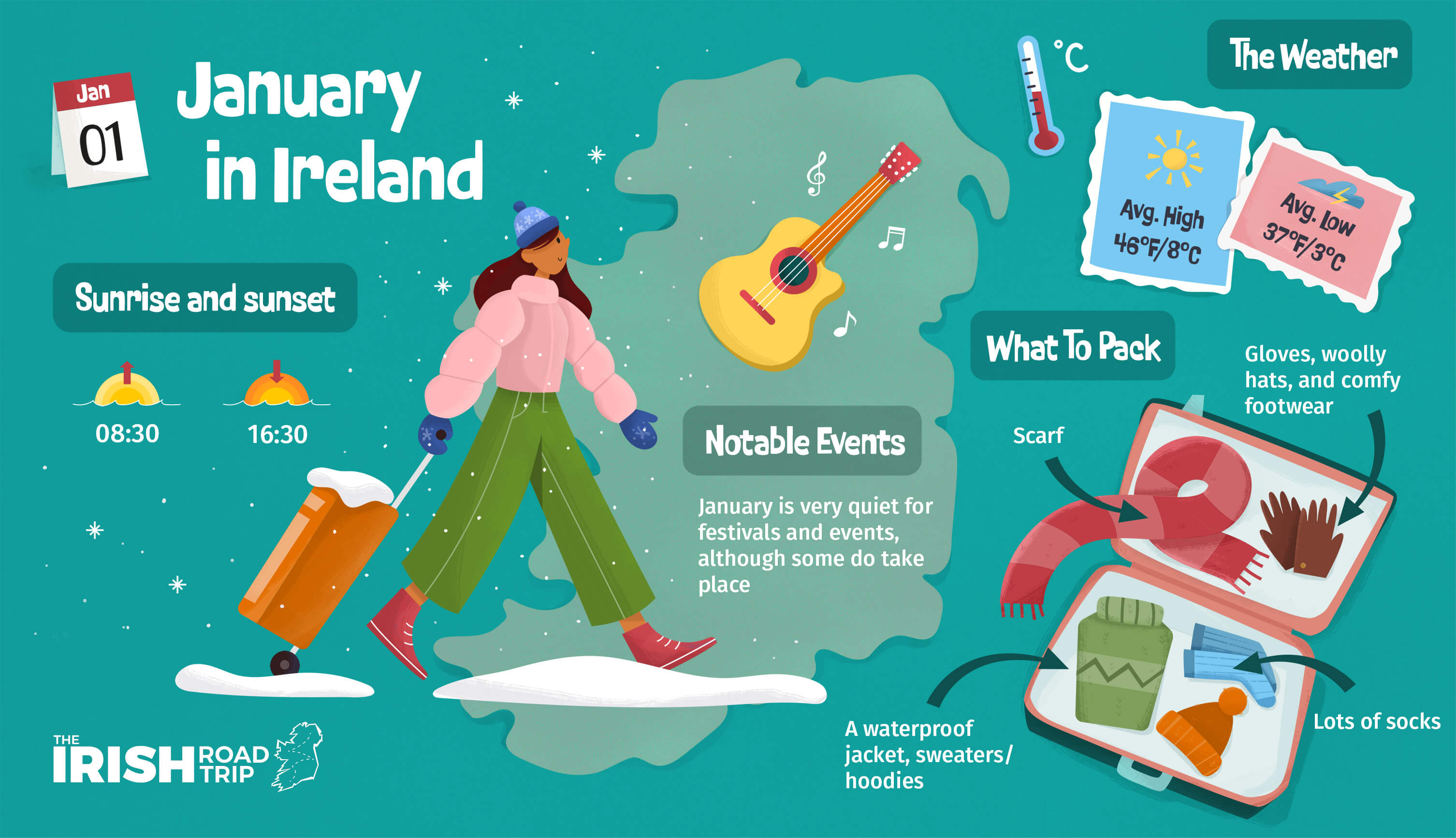
Click to enlarge image
Ireland in January can be very hit and miss. The average temperature in January is 7°C/44.6°F with average lows of 3°C/37.4°F.
January is the best month to visit Ireland if you are working with a tight budget and you are willing to take a gamble with the weather.
- Prices : If you’re visiting Ireland on a budget , flights and accommodation are cheaper
- Crowds : The popular attractions in Ireland will be quieter, as this is off-season
Disadvantages
- The weather : The days tend to be cold, wet, and windy
- Daylight : The sun rises from 08:29 and sets from 16:38
- Closed attractions : Some seasonal attractions will be closed

Visiting Ireland in February can also be risky weather wise, with average highs of 8°C/46.4°F and average lows of 2°C/35.6°F.
Spring is still far from the horizon and the days are short and chilly. In the past, we’ve had heavy snow fall, flooding and stormy weather in February.
February is the best time of year to go to Ireland if you have a limited budget and you aren’t too phased by potentially poor weather conditions.
- Prices : February is off-season in Ireland, so flights and accommodation are cheaper
- Crowds : Ireland’s usually busy attractions will be quieter (the Guinness Storehouse and Giants Causeway will always draw crowds, though)
- Weather : Similar to January – cold, wet and windy
- Daylight : The sun rises at 07:40 and sets at 17:37
- Seasonal attractions : Some seasonal attractions will remain closed

Many people want to visit Ireland in March to attend a St. Patrick’s Day festival or to soak up the buzz surrounding March 17th.
March marks the arrival of spring in Ireland. In years past, we’ve had heatwaves in March and stormy weather.
March is the best time to go to Ireland if you have a sizable budget and want to experience St. Patrick’s Day festivities. Spring has sprung, the days are longer and the weather isn’t as cold as the previous months.
- Weather : March marks the start of spring. There are average highs of 10°C/50°F and average lows of 4°C/39.2°F
- Long ish days : The sun rises at 07:12 and sets at 18:17
- Prices : The period around March 17th sees prices skyrocket. The end of the month (Easter) can be pricey, also
- Weather : The weather can be very changeable. Over the last five years, we’ve had snow storms, heavy rainfall and scorching weather
- St. Patrick’s Day crowds : Crowds are at their peak (it’s for this reason that, for many, March won’t be the best time to visit Dublin )
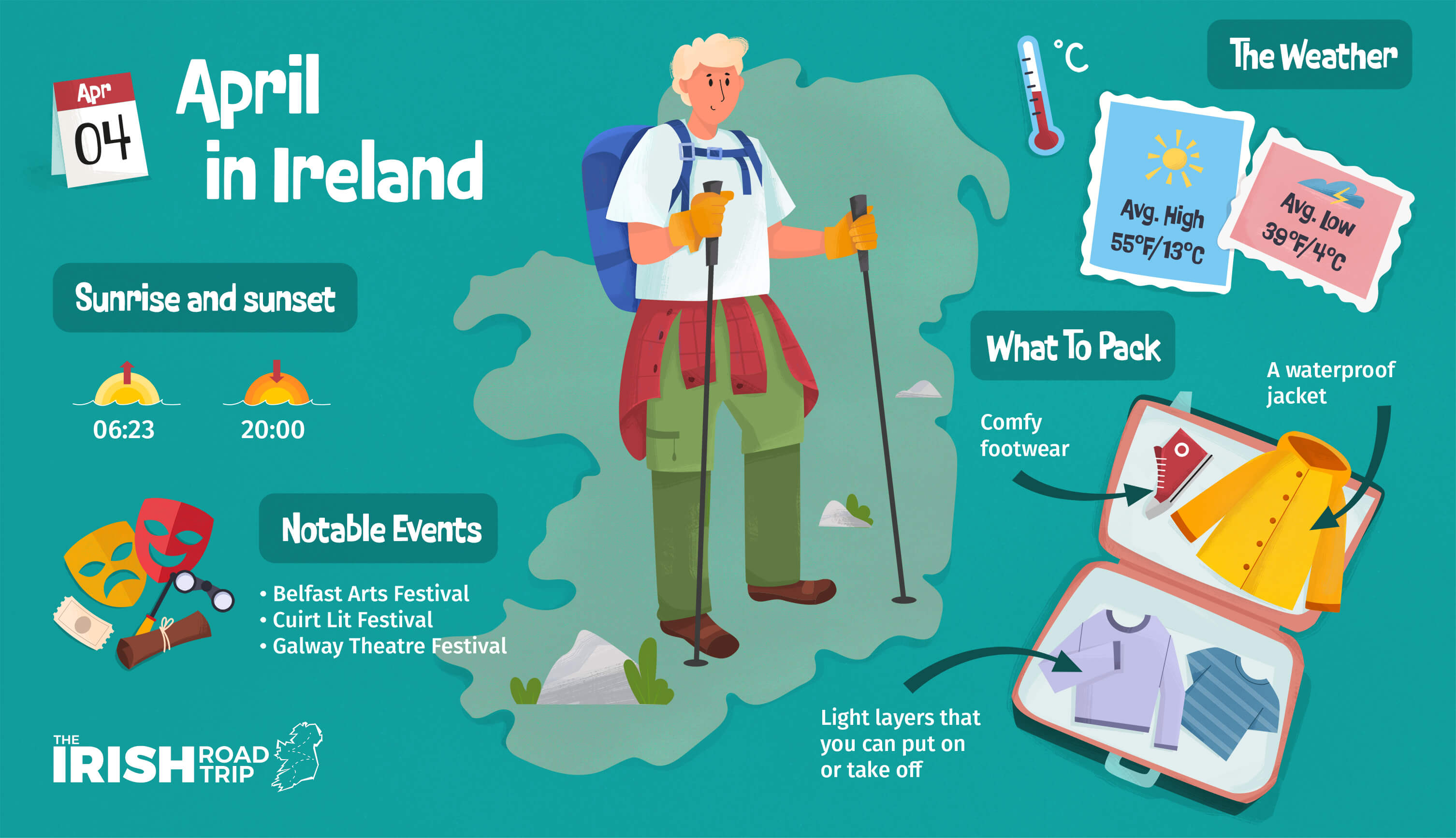
in April, the weather has picked up, the days are longer and there are average highs of 13°C/55°F and average lows of 4°C/39.2°F.
The only issue with April, aside for the potential for bad weather, is that schools get two weeks off, which results in a shortage of accommodation in some places.
April is best time of year to visit Ireland if you’re working within a budget (after Easter) but want plenty of daylight hours to explore the island.
- Flights : The cost of a trip to Ireland is much less in April, thanks to lower flight prices
- Long days : The sun rises at 06:23 and sets at 20:00
- Weather : The weather can to be nice and mild
- Easter holidays : Schools get 2 weeks off around Easter, which can drive up the cost of accommodation
- Weather : The weather can also be terrible (see our April weather guide )
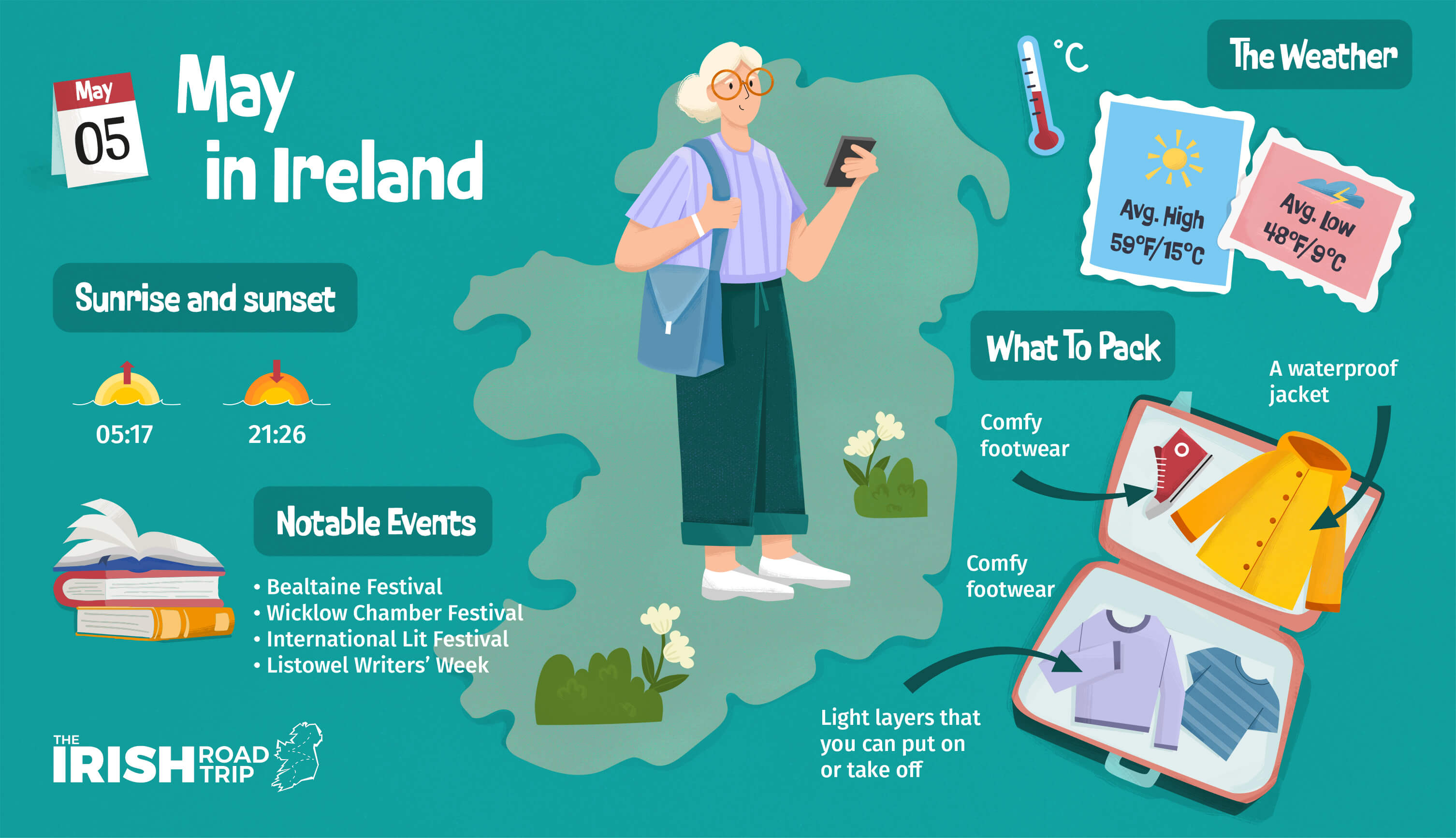
Along with September and October, May is the best time to visit Ireland. This is the shoulder season and the weather is mild, the days are long and both prices and tourist numbers are yet to skyrocket.
I.e. the weather is mild, the days are nice and long and we’ve haven’t yet reached the summer holidays, so places aren’t too busy (see our guide to Ireland in May for more).
- Weather : The weather in May can be good, with mean temperatures ranging between 9.0°C/48.2°F and 13.0°C/55.4°F
- Long days : The sun rises at 05:17 and sets at 21:26
- Summer buzz : Long, mild days and the incoming summer tends to bring a lively atmosphere to many towns and villages
- Festivals : This is when they really start kicking off (see our Irish festivals calendar)
- Weather : Yep – it’s a pro and a con – the weather in May can also be awful (it was last year!)
- Prices : Accommodation and flights will be near peak level price-wise
- Crowds : Better weather and long days means more people tourists
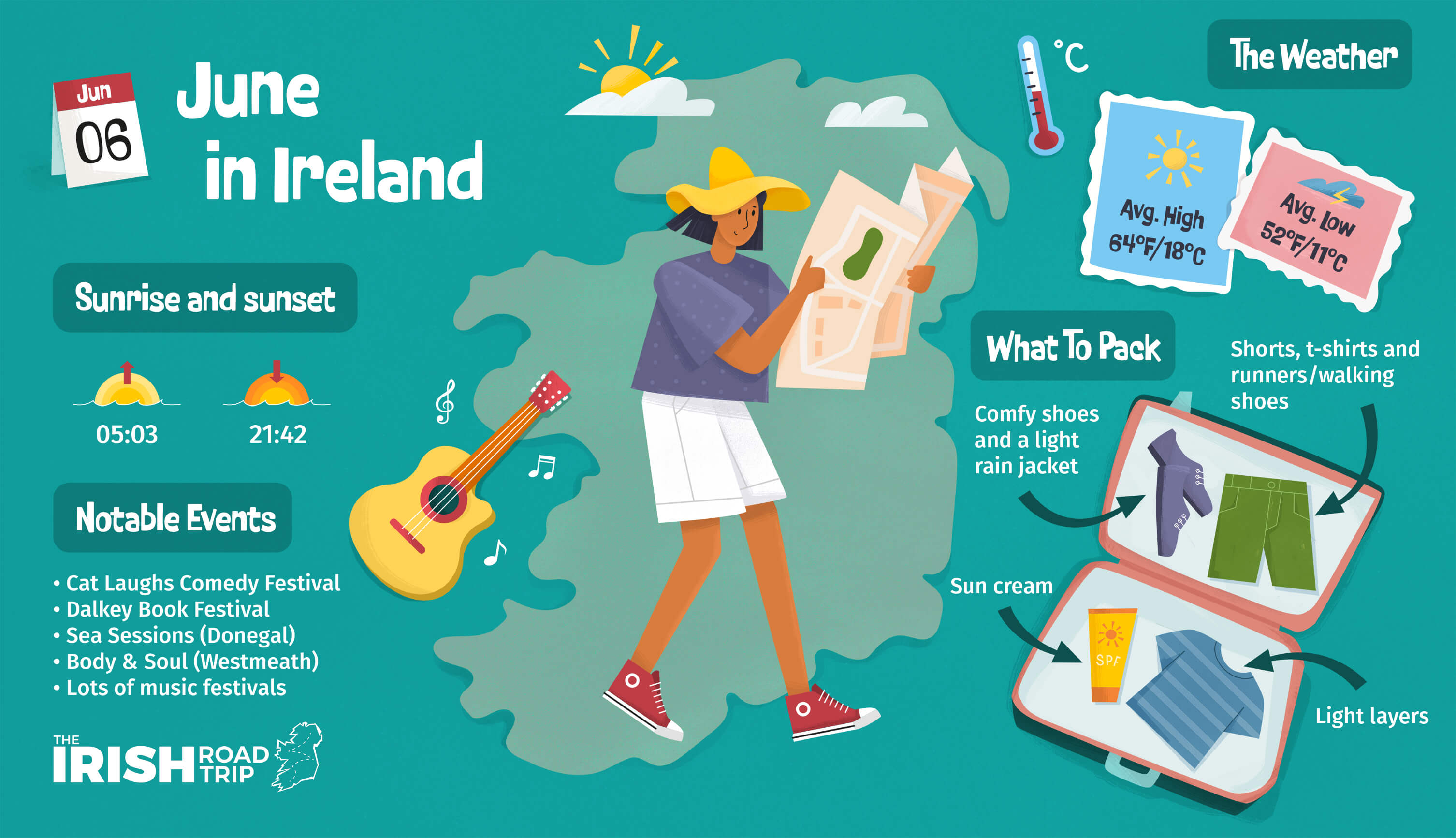
June in Ireland marks the arrival of summer, bringing with it warm and often dry weather and average highs of 18°C/64.4°F and lows of 11.6°C/52.88°F.
This is peak season in every sense – tourist numbers jump as do the price of flights and hotels.
June is regarded as the best time to travel to Ireland by many visiting tourists as the weather tends to be good, temperatures are mild and there’s plenty of daylight hours.
- Weather : Weather tends to be dry and warm with highs of 18°C/64.4°F and lows of 11.6°C/52.88°F
- Long days : The sun rises at 05:03 and sets at 21:42
- Festivals : Numerous music festivals in Ireland take place during June
- Prices : Demand is at its highest, so you can expect to spend more for flights and hotels
- Crowds : As June is peak season in Ireland, expect places to be more crowded
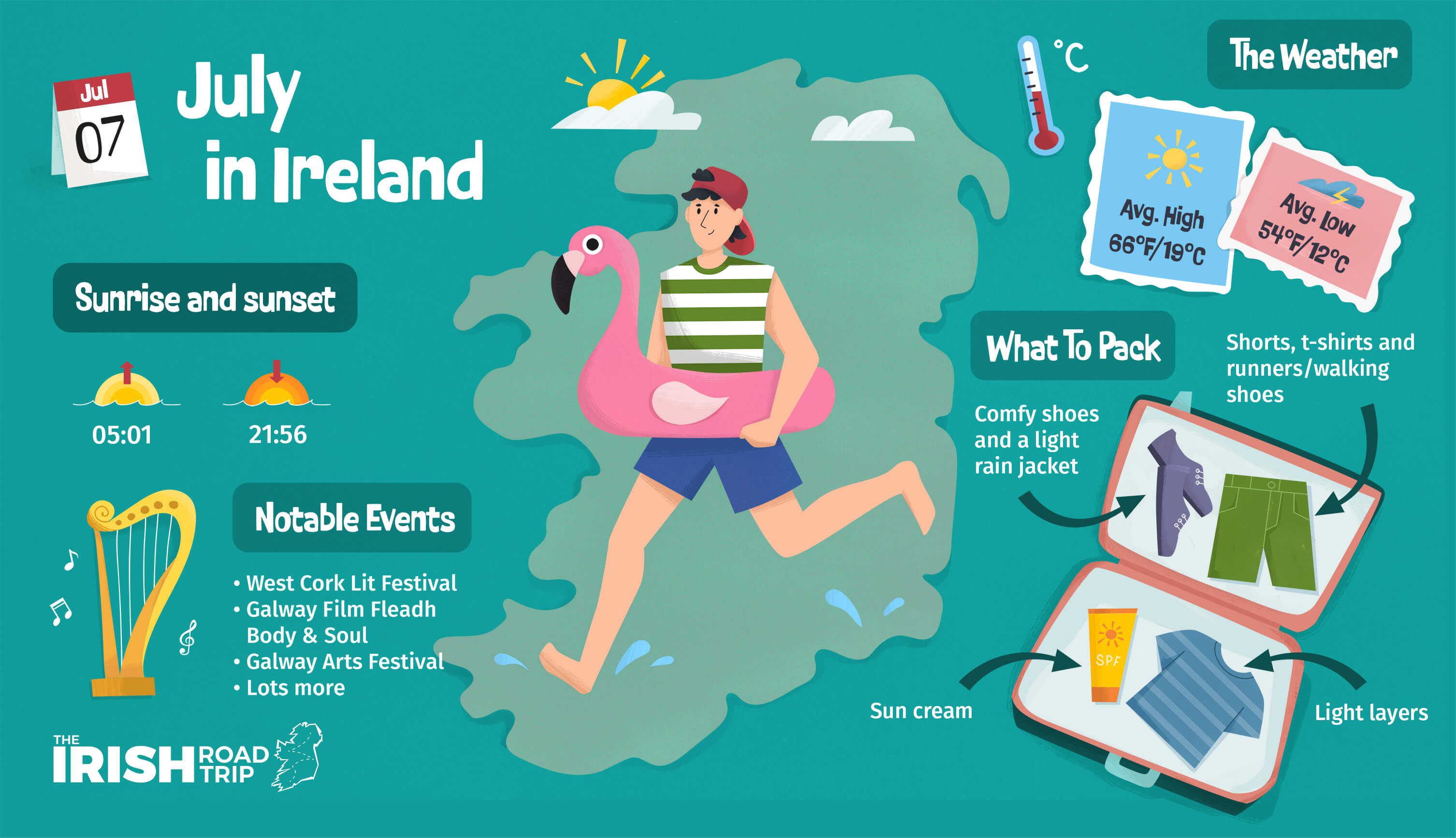
July is the best time to go to Ireland if you’re looking for good weather. Although it’s not guaranteed, it’s more likely to be fine in July than during many other months.
Personally, I head away for one week in Ireland every mid-July and, for the most part, we always get decent weather (see our guide to Ireland in July for more info).
- Weather : We get average highs of 19°C/66.2°F and lows of 12°C/53.6°F
- Long days : The sun rises at 05:01 and sets at 21:56
- Summer buzz : Long, balmy days tend to bring tourists and a lively atmosphere to many towns, villages and cities
- Prices : Summer is peak season, so you’ll be paying more for hotels, B&Bs and Airbnbs
- Crowds : As the schools are out for the summer, expect more crowds travelling around the island, especially to the likes of Killarney and the Dingle Peninsula
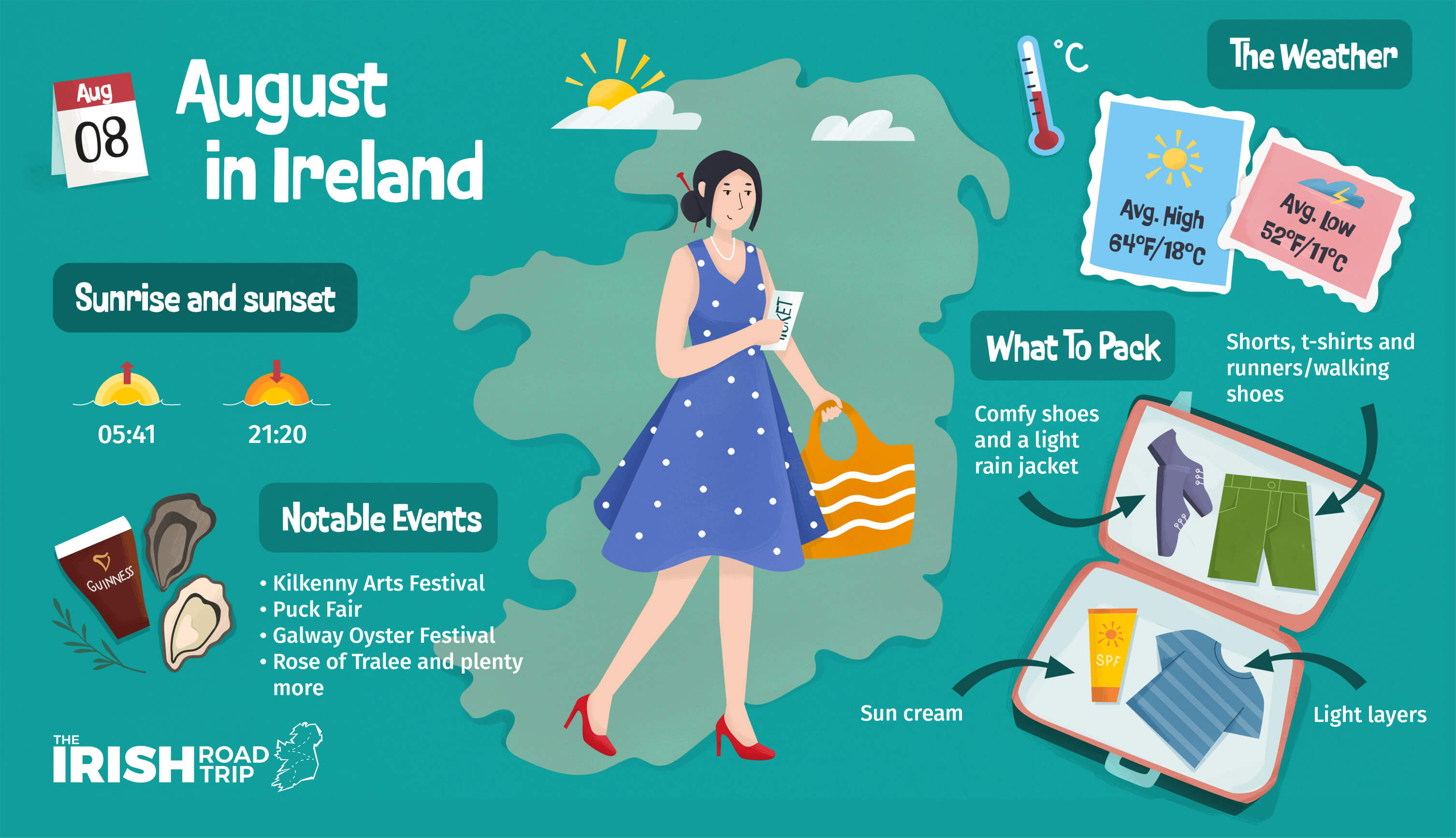
August boasts long days, warm weather and plenty to see and do (see our counties hub for endless places to visit).
As was the case with July, there’s several pros and cons for visiting Ireland in August , many of which revolve around the demand for accommodation and crowds.
August is the best time to go to Ireland if peak prices and crowds don’t bother you. The trade off is mild weather, long days and a busy festival calendar.
- Weather : It’s usually good with highs of 18°C/64.4°F and lows of 11°C/51.8°F
- Long days : You’ll have 16 lovely hours of daylight to wander
- Summer buzz : Again, the summer months bring a buzzy atmosphere to many towns
- Prices : Yep – prices are still at peak levels
- Crowds : The likes of the Dingle Peninsula , the Inishowen Peninsula , the Ring of Kerry and other tourist hot-spots will be very busy
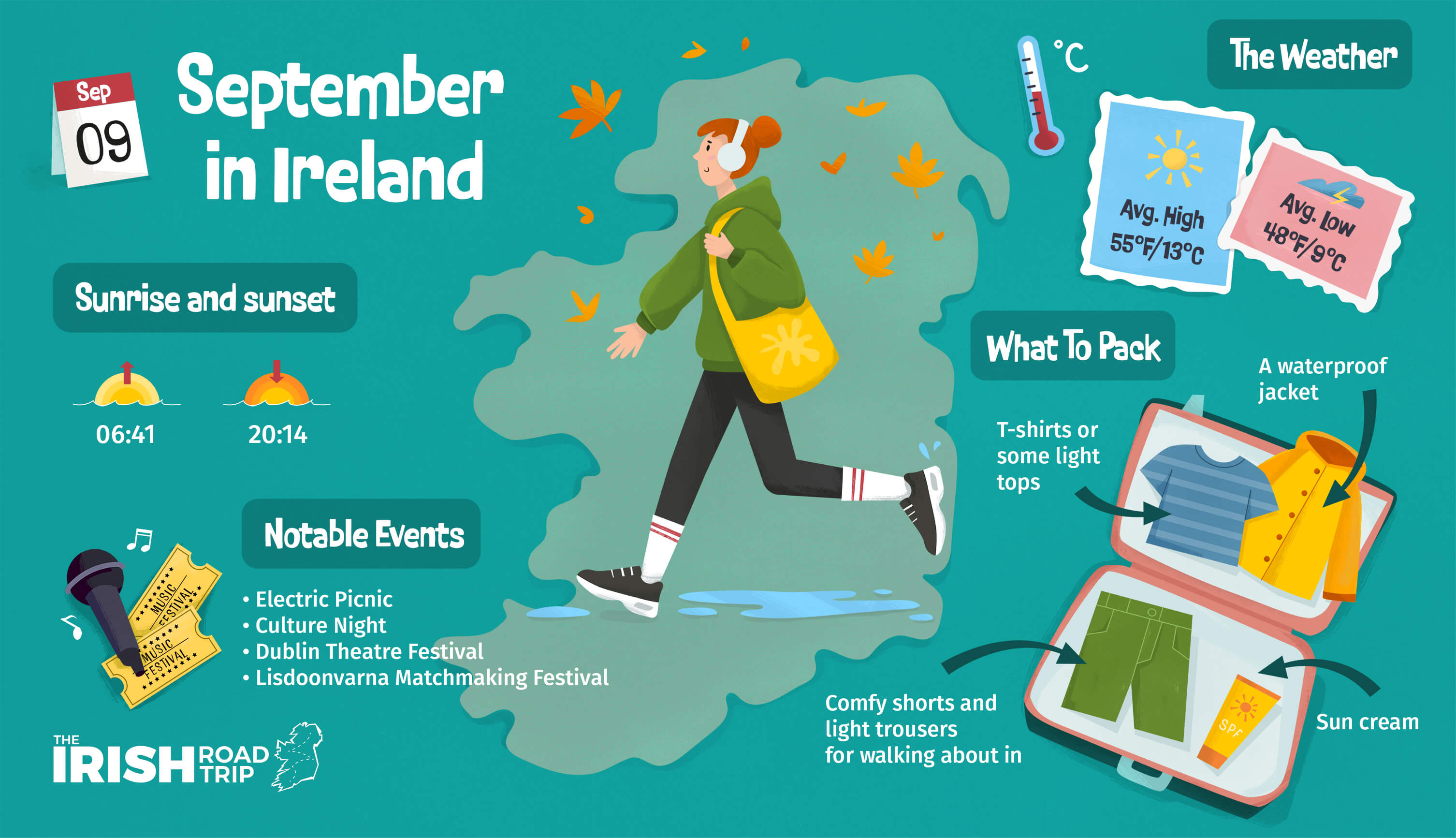
Ireland in September is when the shift from a busy summer season takes place. Tourist numbers drop and the kids go back to school.
This is Ireland’s shoulder season (the season between peak season and the off season) and it’s a great time to explore.
September, along with May and October, is the best time to visit Ireland as prices drop, the days are long, the weather is mild and there’s less crowds.
- Crowds : As kids have gone back to school, there’s less crowds
- The weather : The average high temperature tends to hover between 13°C/55.4°F and 16°C/60.8°F
- Flights : Flights should be a little cheaper as this is the shoulder season
- Long days : The days are starting to shorten, but the sun still rises early at 06:33 and sets at 20:15
- Weather : Yep, a pro and a con. The weather, as always, is unpredictable. With that being said, we’ve had some great Septembers recently
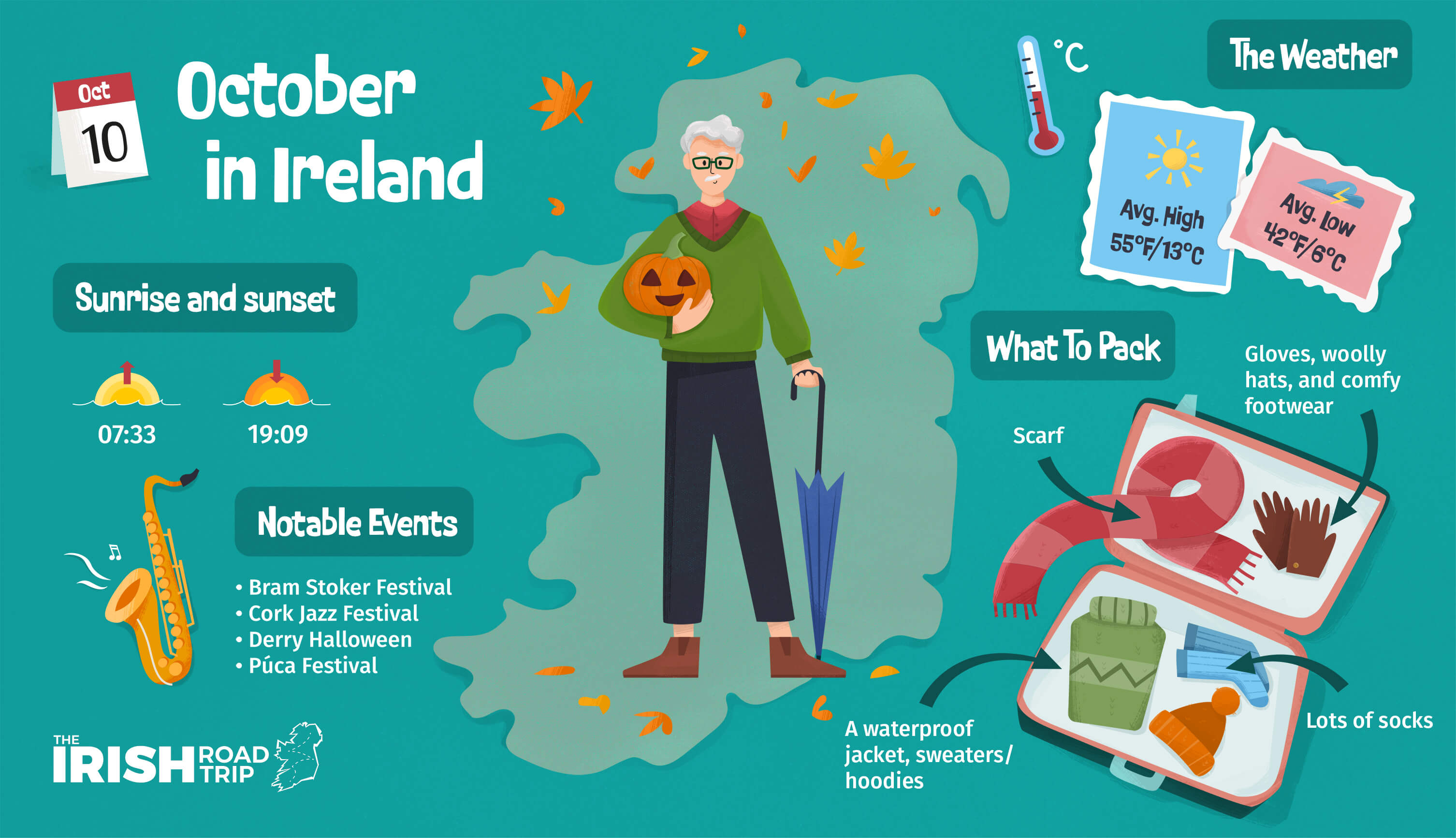
October in Ireland is Autumn and you’ll find many places blanketed in orange leaves and the weather is cool and crisp.
Ireland experiences average highs of 13°C/55°F and average lows of 6°C/42°F during October
October, along with May and September, is the best time to go to Ireland thanks to lower flight and hotel prices, relatively long days and its often dry days with cool temperatures.
- Weather: We often get Octobers that are sunny, crisp and dry
- Crowds: Ireland’s usually busy attractions will be less crowded as we’re no longer in peak-season
- Prices: Accommodation in the more off-the-beaten-track locations will be cheaper (you won’t notice a huge difference in the hot-spots)
- Prices: You should find that flights are cheaper than in peak-season
- Shorter days : By mid-October, the sun won’t rise until 08:00 and it sets at 18:40
- Weather : The weather in Ireland in October is unpredictable (see our October weather guide )
- Mid-term : Schools break in Ireland at Halloween for a week and hotel prices jump

Visiting Ireland in November comes with its pros and cons. On the plus side, many towns and villages come alive with Christmas markets from mid-month.
On the con side, it’s winter , so the weather can be all over the place. November tends to be cool and crisp with an average temperature in Ireland in November between 12°C/53.6°F and 9.5°C/49.1°F.
November is the best time to travel to Ireland for a city break. Many cities (Galway, Dublin, Cork and Belfast) holding Christmas markets.
- Crowds : You’ll encounter fewer crowds at the usually busy attractions (although places with Christmas markets will be busy)
- Prices : Accommodation in the more off-the-beaten-track towns in Ireland will be more affordable
- Flights : Should be cheaper as we’ll be in the depths of the off-season
- Short days : The sun doesn’t rise until 07:23 and it sets early at 16:53
- Seasonal attractions : Some seasonal attractions in Ireland’s quieter villages in towns will be closed
- Weather : The weather could be wintery. We’ve had mild, stormy and freezing cold Novembers in the past few years
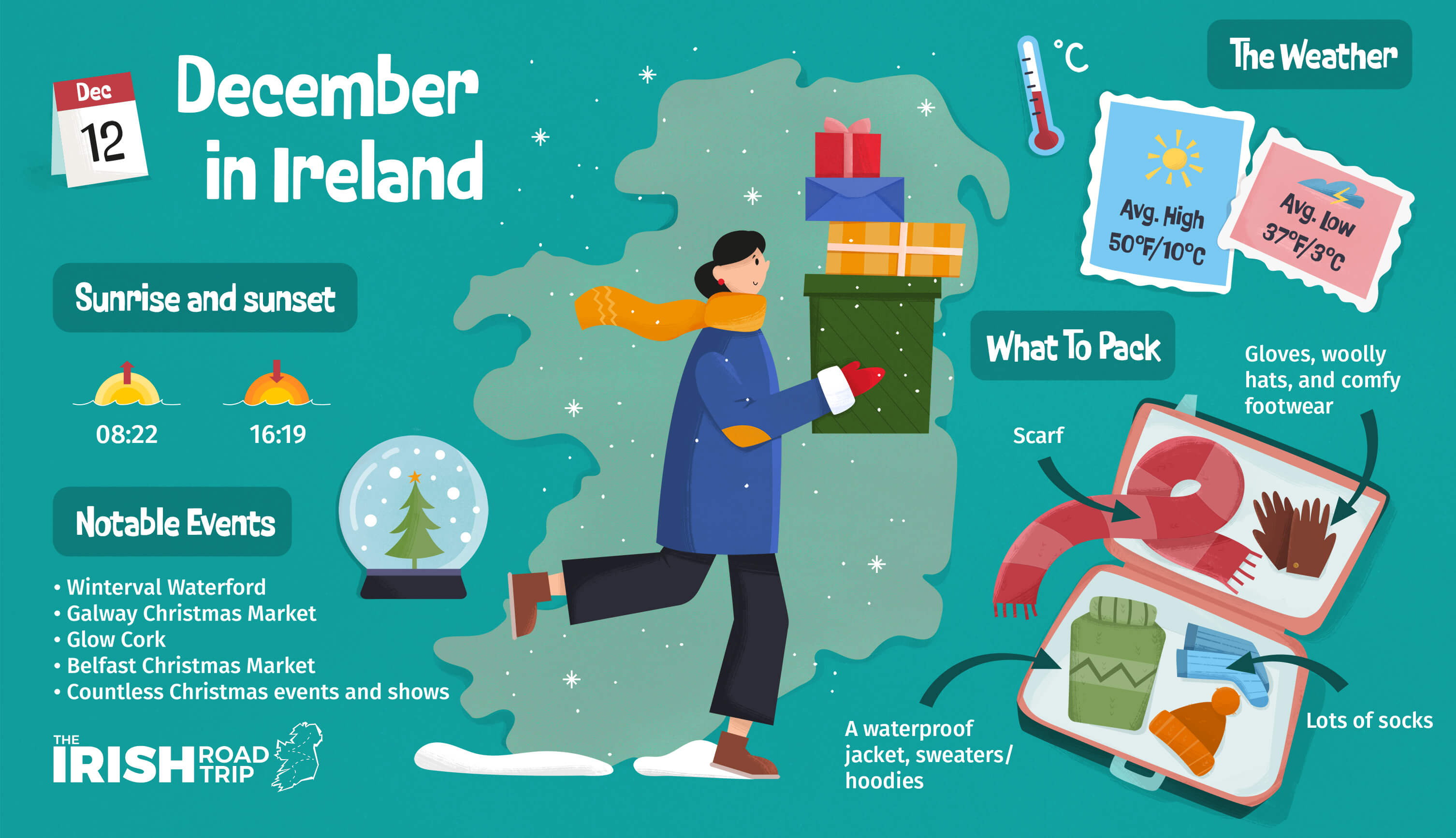
December marks the arrival of Christmas in Ireland and you’ll find most towns and villages alight with fairy lights.
The average temperature for Ireland in December tends to be similar to November, coming in at around 5°C/41°F, but this can vary.
December is the best time to visit Ireland if you’re happy to chance the weather and you want to experience Christmas markets, cosy pubs with big open fires and less crowds.
- Festive buzz : Most towns and villages in Ireland will be decked out in Christmas lights
- Crowds : You’ll encounter fewer crowds at the usually busy attractions
- Prices : Accommodation in the more off-the-beaten-track towns and villages will be cheaper
- Flights : Flights can be pricey with people flying home for Christmas
- Short days : Sun rises at 08:16 and sets around 16:10
- Weather : The weather in December has been mild for several years, but there’s also a good chance of rain and strong winds
The best time to go to Ireland climate wise
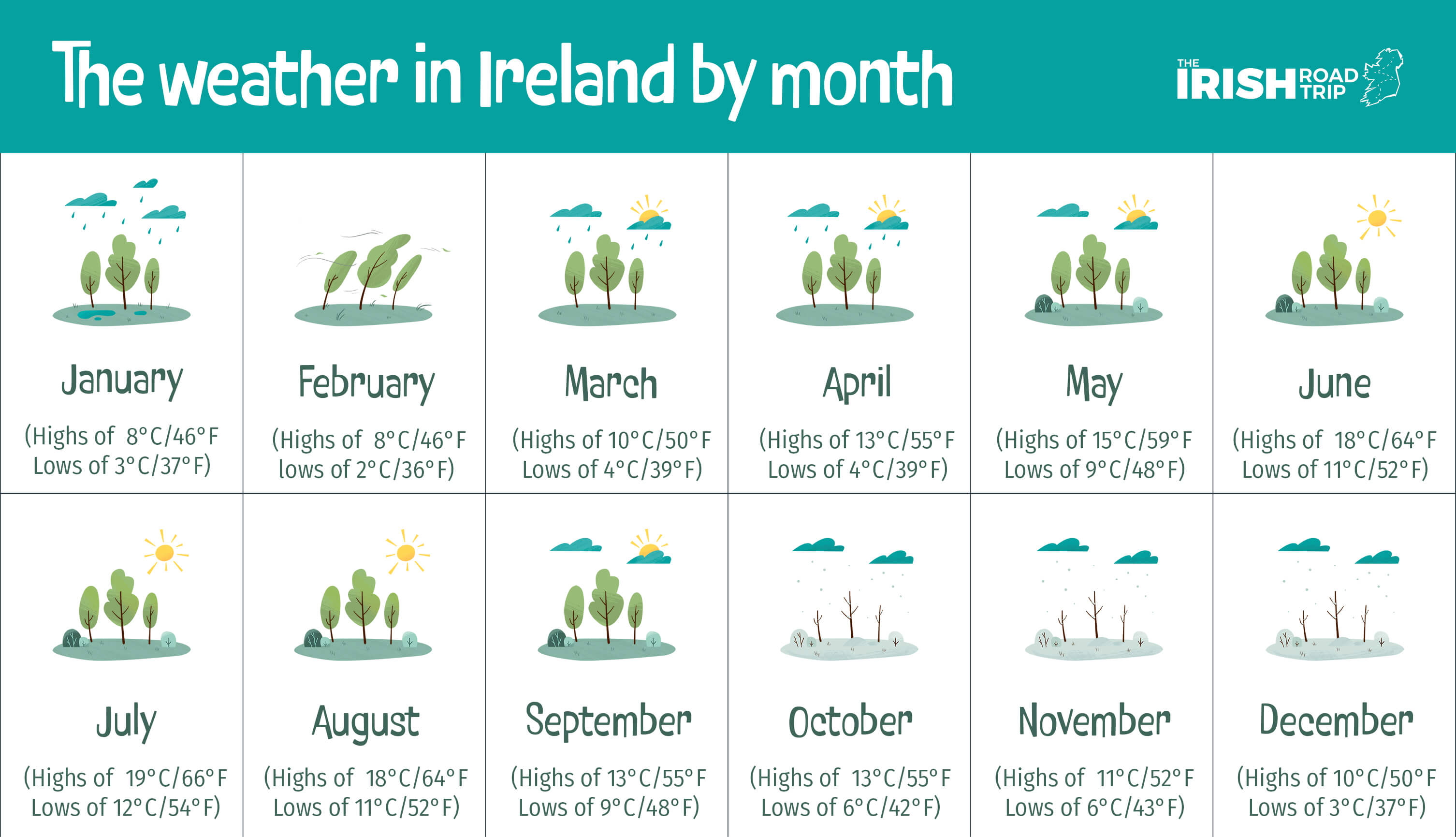
For most, the best months to visit Ireland will be the ones where the weather is at its best. For those planning a trip to Ireland on a budget, it’ll likely be the off-season months.
Below, I’ll give you an overview of the climate in Ireland by month in some of the tourist hot-spots, like Killarney. This data comes from Met Eireann , the Irish Meteorological Service.
Need help with your Ireland itinerary ? We recently published the world’s largest library of Irish Road Trip guides (and it’s free!)
Summer (June, July and August)
Autumn (september, october and november), winter (december, january and february), spring (march, april and may).
Keith O’Hara has lived in Ireland for 35 years and has spent most of the last 10 creating what is now The Irish Road Trip guide. Over the years, the website has published thousands of meticulously researched Ireland travel guides, welcoming 30 million+ visitors along the way. In 2022, the Irish Road Trip team published the world’s largest collection of Irish Road Trip itineraries . Keith lives in Dublin with his dog Toby and finds writing in the 3rd person minus craic altogether.
This site uses Akismet to reduce spam. Learn how your comment data is processed .
Monday 8th of March 2021
Hi! Thank you so much for all of your wonderful tips! My husband and I are planning to bring our adult daughters (24 and 29) to visit at the end is September. We are very excited! Should we stay in Dublin and then take our guided tours from there? We will have 9-10 days. Thank you! Janine
Thursday 27th of February 2020
We just booked a trip to southern Ireland for November. I am very excited. Can you recommend some must do's while we are there?
Wednesday 4th of March 2020
If you hop into our guide to the counties of Ireland you'll find heaps of things to do!
Thursday 30th of January 2020
Hi Keith Thankyou for the great read. My daughter and I are wanting to travel to Ireland for Xmas from Australia. As it will be cold n rainy which doesn’t really bother us, but worried we mighten get to see a lot of attractions would many be closed? Cheers Toni ?
Saturday 1st of February 2020
If you pop in the name of the attraction into Google and visit the official site you should get an idea of whether or not they'll be open or close when you're visiting.
Everywhere will be closed on Christmas Day with many places also staying closed on December 26th, but that can change from attraction to attraction.

17 Days in England, Ireland, & Scotland: An Itinerary
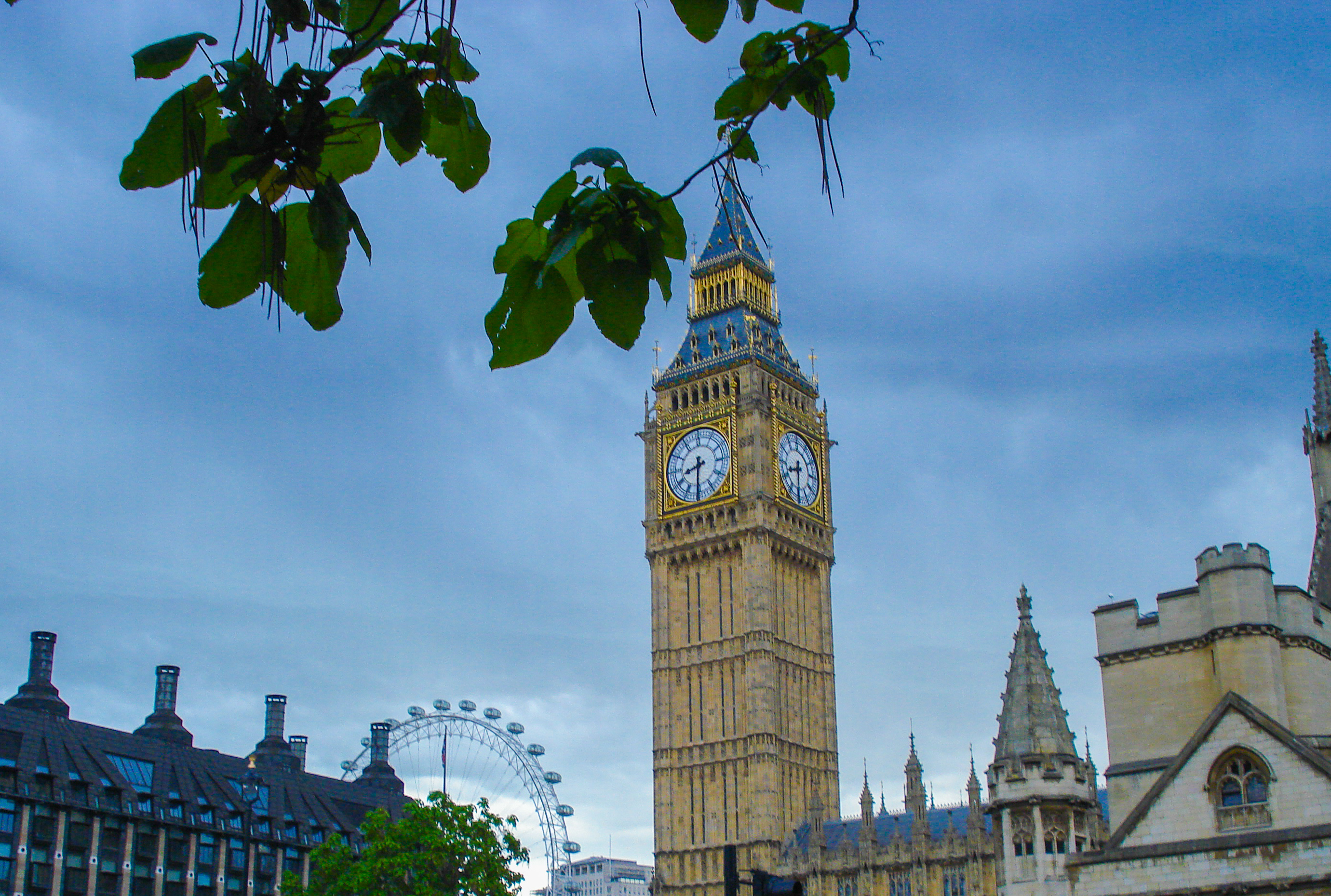
My husband and I had an amazing honeymoon last March (in 2019)! We spent 17 days traveling (travelling 😉) around England, Ireland, and Scotland. I planned the entire trip myself, which included planes, trains, buses, and some taxis. I wanted to share my entire itinerary including where we stayed, what cities we visited, and what side tours we booked!
As always, I wrote everything down in my travel diary so I can reminisce and remember our amazing trip. Hopefully this will inspire you to plan your own adventure!
Just to give a brief background before I begin. Our trip ran from March 6 th through March 24 th . The weather was obviously chilly (between 48°F to 60°F depending on where we were) but less tourists and crowds during March. The prices were also cheaper, and I booked all our flights, trains, hotels, and tours between September and January (this way you get the cheapest prices by booking ahead).
So, without further ado, here was the breakdown of our trip:
- London – 4 nights
- Oxford – 2 nights
- Cork – 2 nights
- Dublin – 3 nights
- Edinburgh – 2 nights
- York – 2 nights
- Nottingham – 2 nights
Table of Contents
London: Buckingham Palace, St. James Park, Westminster Abbey, Big Ben and Houses of Parliament, and Notting Hill

After our 10h 30min Virgin Atlantic flight (a favorite airline of mine) to London Heathrow airport, we arrived at 9:10am! After getting our luggage and passing customs (which took about an hour) we boarded the Heathrow Express train to take us to London Paddington station. I love the Heathrow Express because it is only a 15 min train ride into London whereas if you decide to take the tube, it takes about an hour to get into central London.
We stayed in the lovely Citadines Trafalgar Square Apart’Hotel which is located off Northumberland Ave near Trafalgar Square. I have stayed here before and it is wonderful! It is an apartment-style hotel with a full kitchen and sitting room. They have an amazing breakfast every morning for £7 per person and the hotel is walking distance to just about everything, including Buckingham Palace!
After getting settled, we walked down The Mall toward Buckingham Palace. We continued our walk down Birdcage Walk through the beautiful St. James’s Park. The Daffodils were in bloom which made the park absolutely stunning. We continued our walk to Westminster Abbey, Big Ben, and the Houses of Parliament.

We then decided to visit the Notting Hill area so we jumped on the tube at Westminster Station and took the Circle line to Notting Hill Gate. We walked up Portobello Road and saw the gorgeous multi-colored buildings that this area is known for. I am a huge fan of the movie ‘Notting Hill’, so we walked past The Travel Book Shop and the home with the blue door where the character William Thacker lived (both are on Portobello Road).The famous Portobello Market is along Portobello Road also but sadly it was already packed up when we arrived in Notting Hill.
Stonehenge, Avebury, Lacock, and Bath Tour

Today was the day for our first tour! I booked a tour of Stonehenge, Avebury, Lacock, and Bath through England Experience Tours and it was incredible! To read more about this tour, check out my tour post here . It was a long touring day but definitely worth it!
Brighton: The Royal Pavilion, Brighton Palace Pier, and the Lanes
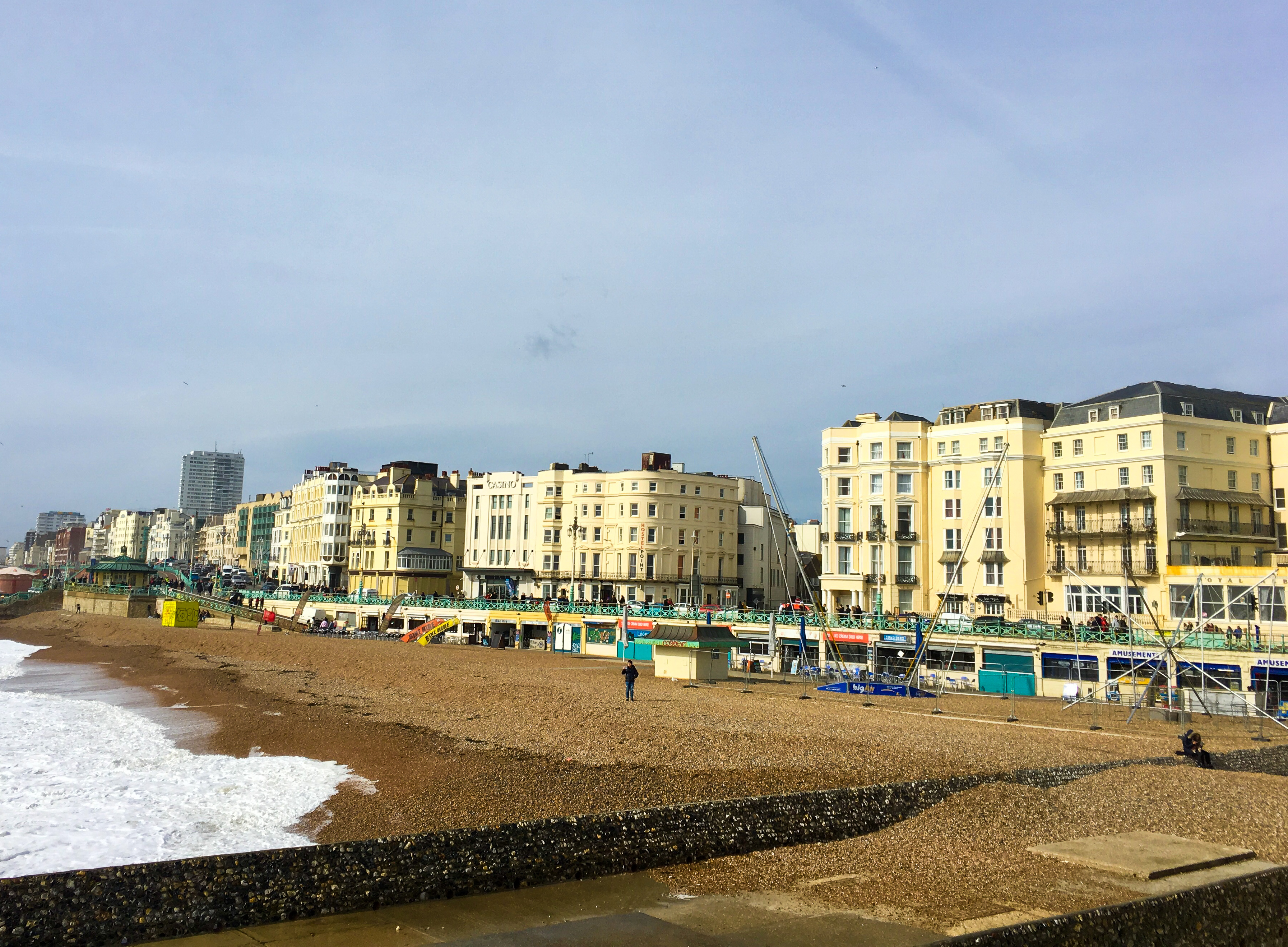
It has always been a dream of mine to visit the seaside town of Brighton! We decided to take a day trip outside of London and visit Brighton. We boarded a train at 9:29am from Blackfriars train station and it was a quick hour train ride into Brighton. The weather was quite windy and chilly as it was March, by the beach, but well worth the visit.
We toured the beautiful Royal Pavilion, which is an asian-style palace built for King George IV. Walking around I could only imagine being invited to his grand parties! We walked out to the Brighton Palace Pier, which had carnival rides and a large arcade, and spent time walking around The Lanes, the pedestrian shopping area. The Brighton shoreside along the English Channel was very rocky, in contrast to my sandy SoCal beaches, but gorgeous nonetheless. To read more about what to do in Brighton, check out my post here .
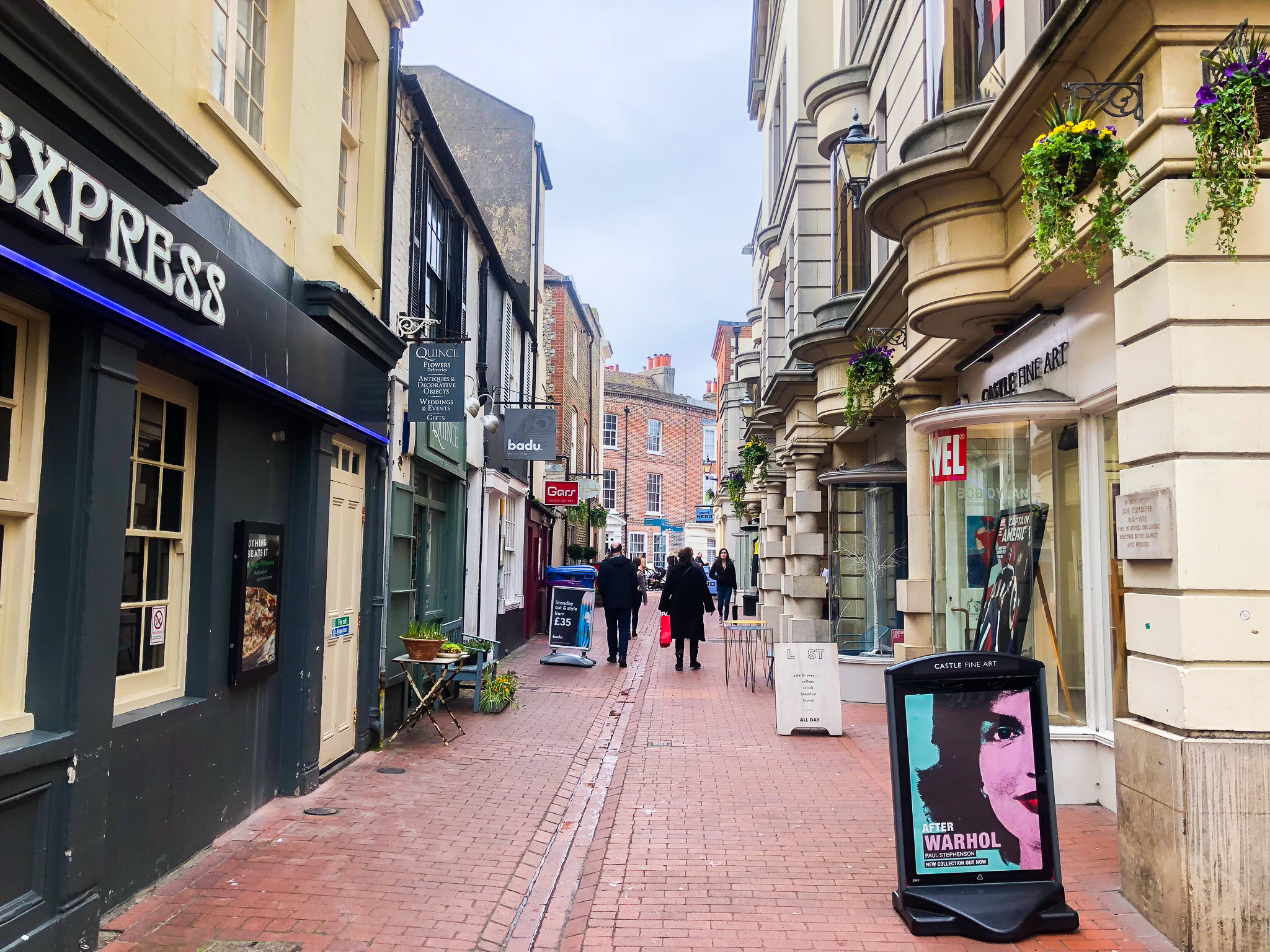
Brighton is a very easy walkable city and we spent about 7 hours total exploring. Brighton is perfect for that half-day trip from London. We took the 4:26pm train back to London and still had some time to explore London before dinner. We took the tube to Harrods and walked around this amazing department store! We were feeling hungry so we took the tube to Piccadilly Circus to see the nightlife and eat dinner. Piccadilly Circus always reminds me of Times Square in New York City because of the large lit banners and crowds. We ate dinner at Cicchetti, which is one of my favorite Italian restaurants in London. It is located in Piccadilly Circus and offers amazing wine and Italian tapas.
London: National Portrait Gallery, Charles Dickens Museum, an Arsenal Pub, and a Football Match

Today was my husband’s favorite day because it was the Manchester United and Arsenal Football match. We had time to explore London in the morning as we visited the National Portrait Gallery and the Charles Dickens Museum. The National Portrait Gallery has over 11,000 portraits including the Brontë sisters, Jane Austen, and William Shakespeare’s most famous self-portrait. We spent about 1.5 hours in the National Portrait Gallery, which is nearly not long enough. Afterward, we walked up the street and caught the tube to the Charles Dickens Museum, since I have always wanted to visit. Read my blog post about some of my favorite London Highlights if the National Portrait Gallery and Charles Dickens Museum don’t strike your fancy.
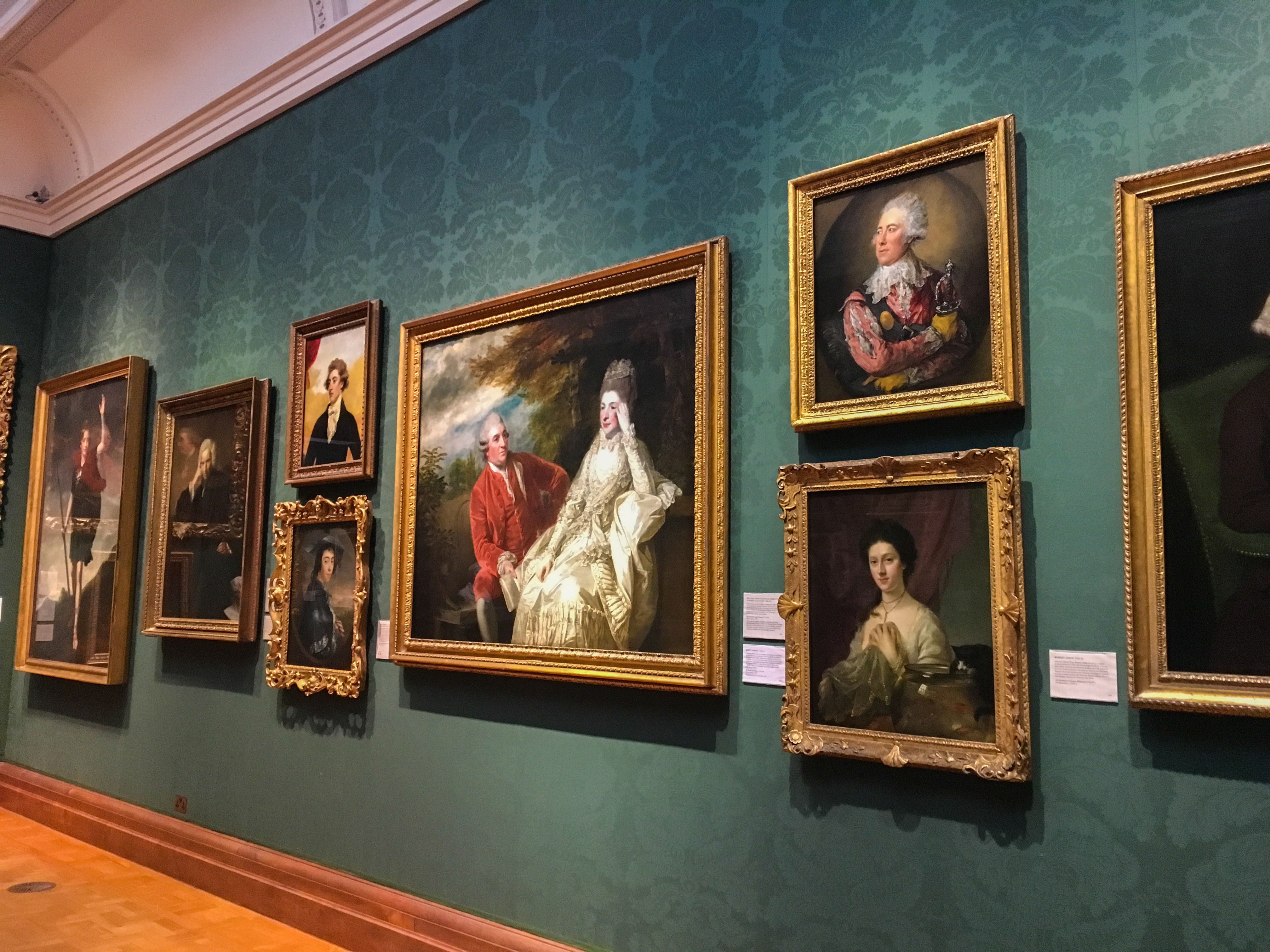
After spending the morning in London, it was now time for the Manchester United and Arsenal Football match. The match started at 4:30pm so we had plenty of time to head to Emirates Stadium and go to The Tollington Arms to grab a couple of pints before the match. The Tollington Arms is an Arsenal Fans only pub and you have to show your Arsenal membership cards or match tickets to get inside. The pub and the football match were absolutely thrilling!
Oxford: Covered Market, Radcliffe Camera, Christ Church, Bodleian Library, and afternoon tea at the Old Parsonage Hotel
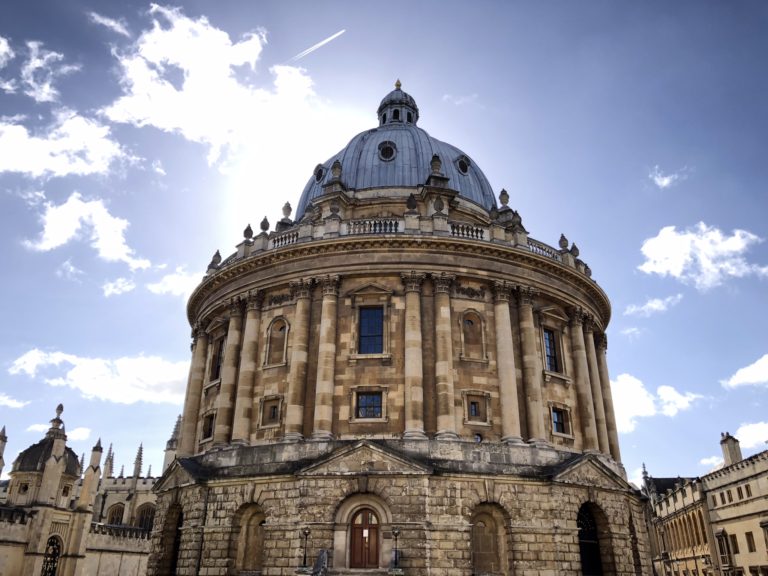
We left London and took the 8:11am train to Oxford where we spent two nights at Malmaison. Malmaison is a boutique hotel converted from the prison in Oxford Castle! It was absolutely stunning and an easy walk into the center of Oxford.
We walked the Oxford covered markets and enjoyed the shops as they were opening for the day with a hot coffee and pastry. We saw the Radcliffe Camera (pictured) and then booked tickets to the 12:30pm tour of the Bodleian Library because of the Harry Potter filming locations. We then made our way to Christ Church and purchased tickets for a tour because, of course, Harry Potter filming locations! In all honesty, the tour of Christ Church was not worth the ticket price and I would just admire the amazing church from the outside. However, the tour of Bodleian Library was definitely worth it! Despite being associated with Harry Potter, the tour takes you upstairs to this gorgeous library that has every single printed UK book since the 1600s. I’m talking possible first editions of very famous authors like Jane Austen or Shakespeare!
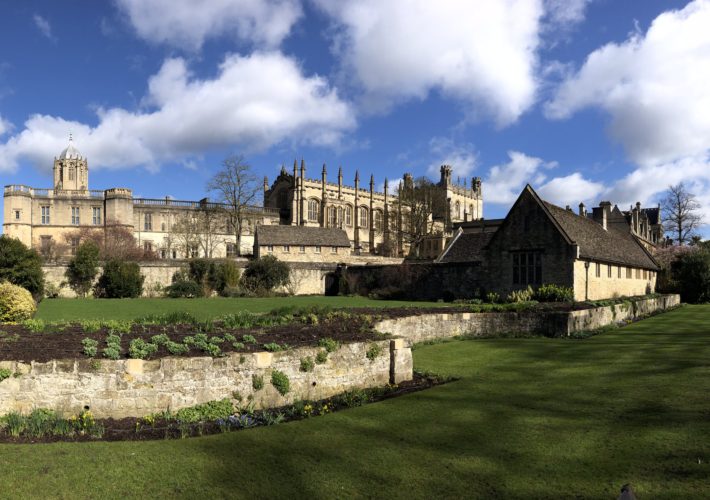
After the tour we walked to The Eagle and Child Pub to have a pint. This is the same pub that C.S. Lewis and J.R.R. Tolkien once drank at (can’t you tell I’m into literature)! After enjoying a cold one, we walked to the Old Parsonage Hotel at 2:30pm for afternoon tea and an early dinner. Before my trip I had googled afternoon tea locations in Oxford and this spot did not disappoint. Since the weather was chilly, we had to sit inside the hotel restaurant but outside on the patio is the actual prime location for afternoon tea. I was served a delicious 3-tiered plate with champagne and coffee and it was spectacular. This pretty much ended our day since we left London early that morning.
Famous Cotswolds Highlight Tour

I have always wanted to visit the Cotswolds and since we didn’t have a car, we booked a tour through Cotswolds Guided Tours. This tour was absolutely amazing and we visited Upper and Lower Slaughter, Bourton-on-the-Water, Stow-on-the-Wold, a secret Jane Austen village, and Great Tew. If you want to know more about this tour check out my blog post here .
Cork, Ireland: Saint Patrick’s Street, Cork Covered Market, and Saint Finbarre’s Cathedral

We spent a large part of our day traveling from Oxford to Cork. Just in the pre-planning phase it took a while to get the logistics of our trip correct because of the football match and St. Patrick’s Day. The easiest approach I found was taking public transportation from Oxford to Reading, Reading to Bristol Parkway, Bristol Parkway to Bristol Temple Meads, and then taking a bus from Bristol Temple Meads to the Bristol Airport. Now this may sound absolutely crazy (and it definitely was!) but I booked all 3 train rides and 1 bus ride together on Trainline .
Trainline is my favorite website when traveling around the UK and all I needed to do was type in Oxford to Bristol Airport and it found the route for me. I have the app on my phone and it was so convenient to already have our electronic tickets for all our train rides.
Our flight out of Bristol Airport was at 12:50pm so we left Oxford at 7:30am. We flew Aer Lingus on a tiny prop plane, that freaked my husband out, and arrived safely in Cork, Ireland at 2:15pm. After grabbing our baggage, we took the 226A bus from the Cork Airport to Kent Station-Parnell Place which was where our hotel was located. The bus ride was only €2.80 per person which was much cheaper than taking a taxi into the city centre. We stayed two nights at the Jury’s Inn Cork, partly because of the location to the city centre and the fact that it was so inexpensive! It was a great chain hotel and one that I would definitely stay at again.

We explored Cork and walked up Saint Patrick’s Street which has a ton of retail stores on a quaint street. We visited the English Market (which was more of a farmer’s market with a lot of fresh fruits, veggies, and butchers) and then walked all the way to Saint Finbarre’s Cathedral. This was a stunning church that was built in 1863 and was massive! Sadly, we couldn’t go inside because it was closing up when we arrived but we did explore the beautiful grounds (pictured). My husband and I really enjoyed Cork and loved the quaint city feel!
Cliffs of Moher, The Burren, Doolin, and Bunratty Castle Tour
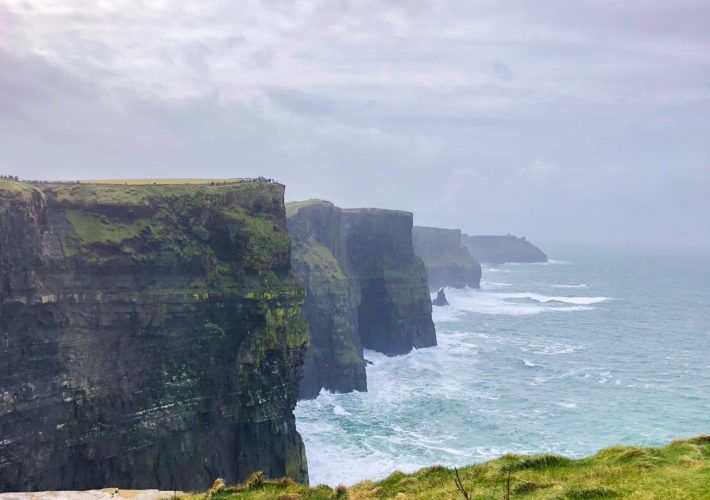
When in Ireland you have to visit the Cliffs of Moher, which was actually why we were staying in Cork. We booked the Cliffs of Moher Day Trip from Cork and visited Limerick, the Cliffs of Moher, Doolin, The Burren, and Bunratty Castle. If you want to know more about this tour check out my blog post here .
Blarney Stone and Dublin
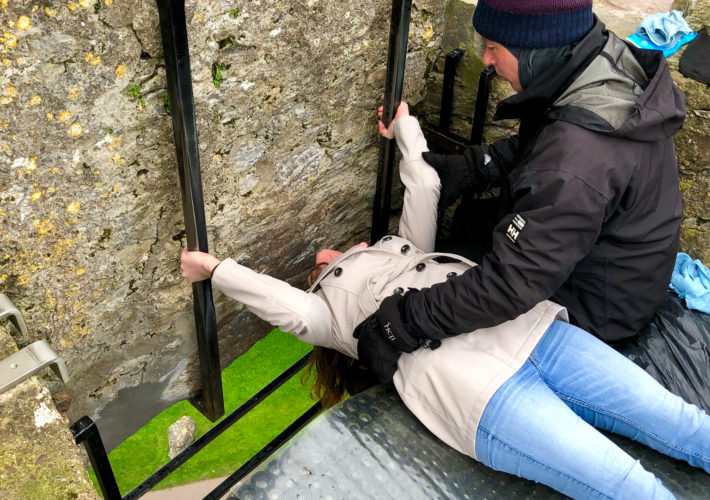
Now from this point in our trip you may think I am already crazy with our semi-tight timelines but you have seen nothing yet!
We were leaving Cork today to travel to Dublin and our train left at 11:25am from Cork Kent station. A sane person would just think to have a relaxing morning and walk around Cork but oh not me….I wanted to see Blarney Stone and Castle!
Just a short distance away from Cork (6mi/10.3km) is Blarney Castle and I wanted to tour the castle in the morning and then catch our train to Dublin at 11:25am. I pre-booked a taxi the night before from our hotel receptionist (as Uber/Lyft does not exist in Ireland) and the taxi picked us up at 8:30am. We arrived just before 9am to Blarney Castle and were the second people to enter the Castle and kiss the Blarney Stone! I absolutely loved touring Blarney Castle in the morning because literally no one was around. If you want to read more about my time at Blarney Castle click here .
We called for a taxi back to our hotel just before 10:30am. It was not nearly enough time to explore Blarney Castle but we had a schedule to keep.
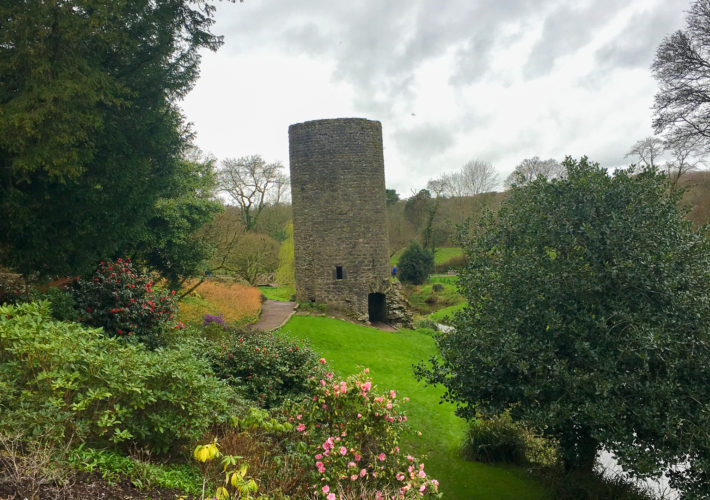
Our train arrived in Heusten Station in Dublin at 2:00pm and we caught a taxi to our Airbnb. We stayed in the Portobello area (southwest of St. Stephen’s Green) which was only about a mile walk to Dublin city centre. If you have already lost track of the dates it’s March 15th (2 days until St. Patrick’s Day). We stayed in Dublin for three days and since we were there for St. Patrick’s Day, hotel prices were outrageous!
After checking in to our tiny studio apartment, we grabbed a taxi and went to the Guinness Storehouse. I talk more in depth about our St. Patrick’s Day festivities here so I will briefly mention how amazing the Guinness Storehouse was! Guinness hosts their St. Paddy’s Day entertainment from March 14th through the 18th and it is well worth a visit during this time. There was live music on all seven floors and Irish dancers performing all night. You get a free Guinness with your admission price and definitely visit the Gravity Bar on the top floor!

After the Guinness Storehouse closed we took a taxi to Dublin city centre and walked around Grafton Street. There are a ton of cart vendors selling St. Patrick’s Day merchandise but definitely wait for Carrolls Irish Gifts as they had the best St. Patrick’s Day gear for very inexpensive prices!
Kilkenny, Wicklow Mountains, and Glendalough Tour

This tour was honestly my favorite tour of our entire trip! You may be thinking ‘what a weird and random tour to go on’ but one of my friends recommended that we visit the Wicklow Mountains and it was definitely worth it! We booked our tour through Wild Rover Tours and visited Kilkenny, Wicklow Mountains, and Glendalough. Read more about this tour here .
Dublin: St. Patrick’s Day

Today was St. Patrick’s Day! The festivities of the day kicked off with the St. Patrick’s Day parade at 12:30pm so I booked 12:00pm tickets to see the Book of Kells. This was actually a pretty poor decision but 12:00pm was the first tour time of the day and since this was our last day in Dublin, this was something I wanted to see. The Book of Kells was written in 800 AD and because it was St. Patrick’s Day, there wasn’t too many people squashed around to see it. We also saw the Long Room which was a huge library and definitely worthwhile to see. At about 12:25pm we walked out into the streets and were greeted with about 500,000 people! This was why seeing the Book of Kells beforehand was a pretty poor decision because there was no way we were going to push our way through 500,000 people and position ourselves to see the parade. So we didn’t. Instead we pushed our way through the crowds for about 2 blocks and just gave up and went into the first pub we could find…which turned out to be the best St. Patrick’s Day ever! If your interested in reading more about our day of pub hopping click here .
We really didn’t do much sightseeing in Dublin at all and I felt like it was just another big city but we did get to walk around the city a bit, so that was fine for me. In all honestly, I enjoyed seeing Cork much more than Dublin.
Edinburgh, Scotland: Edinburgh Castle, Elephant House, Greyfriars Kirkyard Cemetery, High Street, and the Royal Mile

We said goodbye to Ireland and made our way to Scotland! Instead of taking the bus to the airport we opted for a taxi because we were just so tired and needed to be at the airport by 7:45am. We boarded our Aer Lingus flight to Edinburgh at 10:00am and landed smoothly at 11:30am. We hopped on the Airlink bus from the airport to the city centre, as we were staying in the lovely Apex Grassmarket Hotel located in the historic Old Town of Edinburgh. The Grassmarket is a pedestrian square featuring restaurants, pubs, and shops right underneath Edinburgh Castle. I opted to pay a little more for our room and landed with a view of the Castle right outside our window. It was spectacular and worth the tiny increase in price!
After a quick Italian lunch in the Grassmarket, we walked up to Edinburgh Castle. The city is extremely hilly so keep that in mind and wear sturdy shoes! The ticket price to enter Edinburgh Castle was definitely worth it because we saw the Crown Jewels, the Stone of Scone, the castle’s prison, and where Mary Queen of Scots birthed her son, King James VI. The castle is huge with so much to see and do but because we were on a time crunch to see Edinburgh in less than a day, we only hit the highlights that were listed on the castle map.
These next sightseeing attractions are all about Harry Potter because I am such a huge fan. We walked to West Bow Street, which is said to be the street where JK Rowling got her idea for Diagon Alley. The street is curvy, narrow, very colorful, and full of Harry Potter inspired shops, especially one called The Boy Wizard. We then walked to the Elephant House to see the literal birthplace of Harry Potter. This was where JK Rowling sat by the window, looking up at Edinburgh Castle, and wrote her book. The line was very long just to grab a seat so I snuck in and went into the ladies room to check out all the fan writings on the wall. Just up the road from Elephant House is Greyfriars Kirkyard Cemetery, where it is said that JK Rowling walked around to get inspiration for character names. This cemetery is supposed to be one of the most haunted cemetery’s in the world so I ran in to see Tom Riddle’s gravemarker and left as quickly as possible! If your looking for more magical Harry Potter locations in Edinburgh, read my post here .
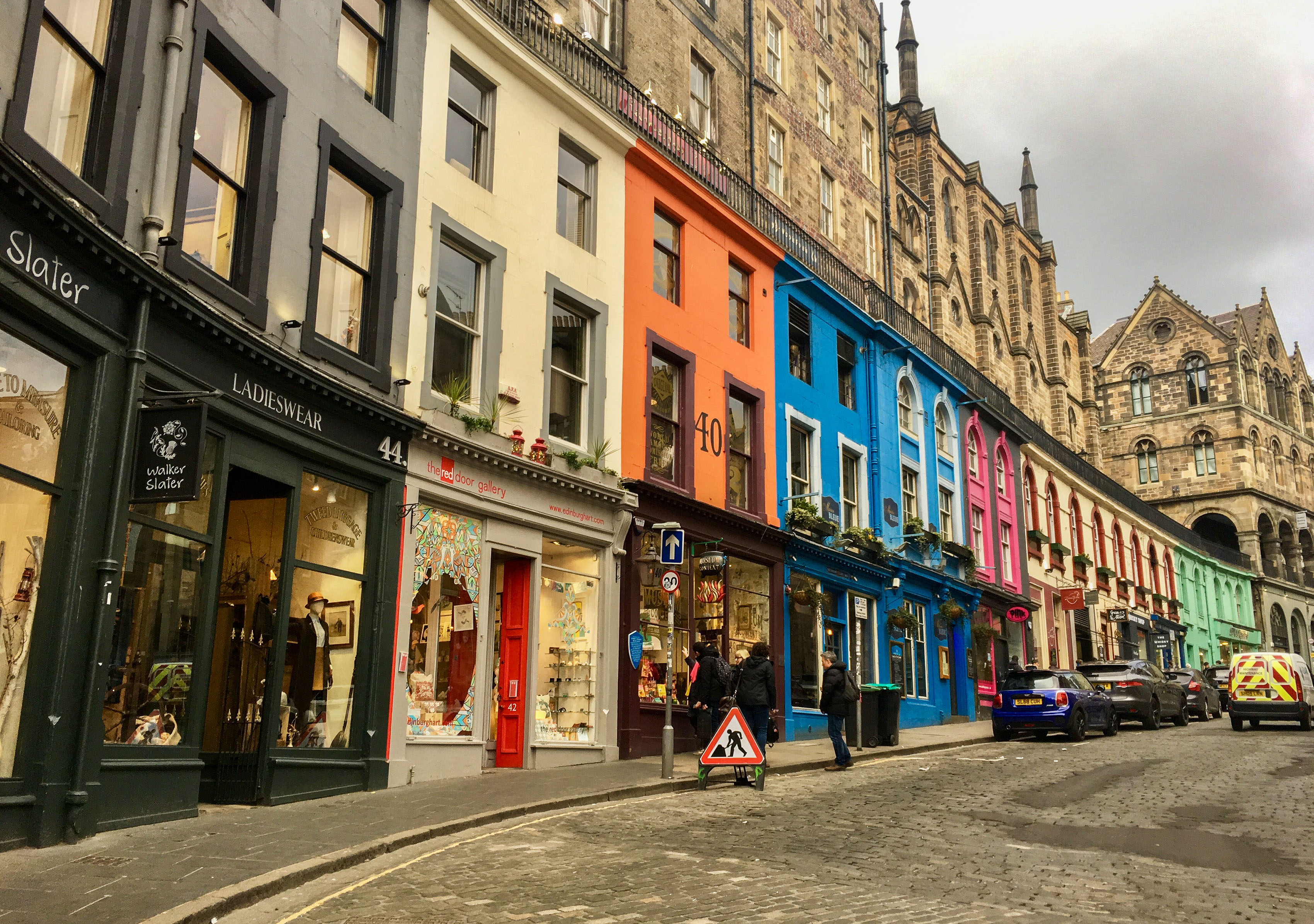
It was getting late so we walked down High Street and the Royal Mile all the way down to the Palace of Holyroodhouse. Unfortunately, by the time we walked the Royal Mile it was already closed, so we returned back up toward the Elephant House where we spotted a really cool Frankenstein pub and went in to grab a couple of pints. Later that night we returned to the Grassmarket area for a Sticky Toffee Pudding at a pub across from our hotel. If you’re interested in what else there is to do in Edinburgh, read my post here .
Day Thirteen
Loch ness, glencoe, and the scottish highlands tour.

One of the things I wanted to do while in Scotland was see the Scottish Highlights, so I booked a tour with Rabbie’s Trail Burners to see Loch Ness, Glencoe, and the Scottish Highlands. To read more about this tour, check out my tour post here .
Day Fourteen
York, england: micklegate bar, shambles street, york minster, st. mary’s abbey, york city walls, and a local pub.

We sadly left Scotland and took the 11:30am train to York, England. We arrived at 2:00pm and walked from the train station to our amazing B&B (bed & breakfast) called Holmwood House. I absolutely loved York and it was probably one of my favorite cities we visited on this trip. We walked into the city center and walked through the Micklegate Bar entrance, which is a gorgeous fortress entry point into the York City Walls. York is surrounded by a medieval wall that was originally built by the Romans in 71 AD!
To read more in-depth about everything we saw in York, read my post here .

We walked the medieval streets and walked down Shambles Street to the beautiful York Minster. York Minster is a massive church built in the 14 th century. We opted not to go in because there was still so much to see and do in York. We walked to the ruins of St. Mary’s Abbey that was built in 1088 and then later destroyed in 1539. The York Museum gardens surrounded the abbey ruins and we walked around until they kicked us out and closed the gates. We then made our way along the River Ouse walkway and found an access point to get up on the York City Walls. The wall is very narrow and only allows for one-way traffic so we exited the wall when we made it back to Micklegate Bar.
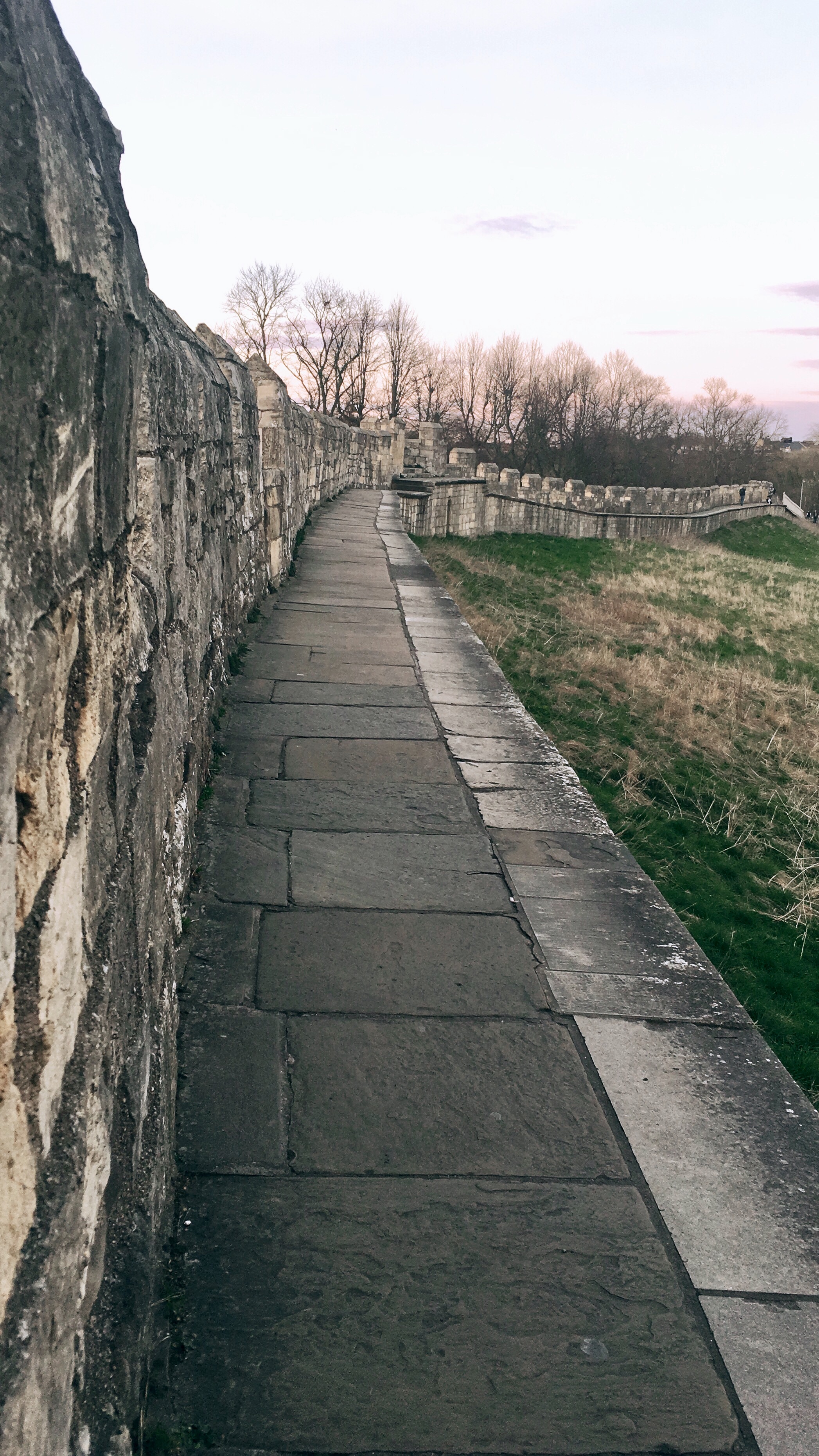
We walked back toward our B&B and found this small, homey pub called Crystal Palace that was definitely a local watering hole. Everyone knew each other and before long the locals invited my husband to a game of Blackball, which is the same as pool. He won some and lost some, but we had so much fun chatting with the locals!
Day Fifteen
York: jorvik viking centre, clifford’s tower, fairfax house, and shambles farmers market.

We spent another day in York, which was plenty because we ended up running out of things to see! We enjoyed our complimentary homecooked breakfast from our B&B and walked back to the city centre to the Jorvik Viking Centre. The Vikings were a big historical part of York and they created this museum (basically an awesome Disneyland-esque ride) that showed you what York (or Jorvik) looked like when the Vikings inhabited the city in 960 AD. Like any Disneyland ride, it ended in the museum and gift shop! I would highly recommend visiting the Jorvik Viking Centre because it was very cool and informative! We then walked to Clifford’s Tower which was once a part of York Castle. It stands on a large hill and is the only portion that still remains of York Castle that was built by William the Conqueror.

At this point in our day we were running out of things to do that actually interested us so we ended up going to the Fairfax House. This is a Georgian townhome that was built in the 1740s and is still intact with furniture from the Georgian period. This might seem like a strange “museum” to tour but it was absolutely stunning and the ticket price was worth it! Afterward, we made our way back to Shambles Street and went to the Shambles Farmers Market to fill up the rest of our day. I loved exploring York and two days is all you need in this beautiful city!
Day Sixteen
Nottingham, england: nottingham castle, robin hood statue, city of caves, and ye olde trip to jerusalem.
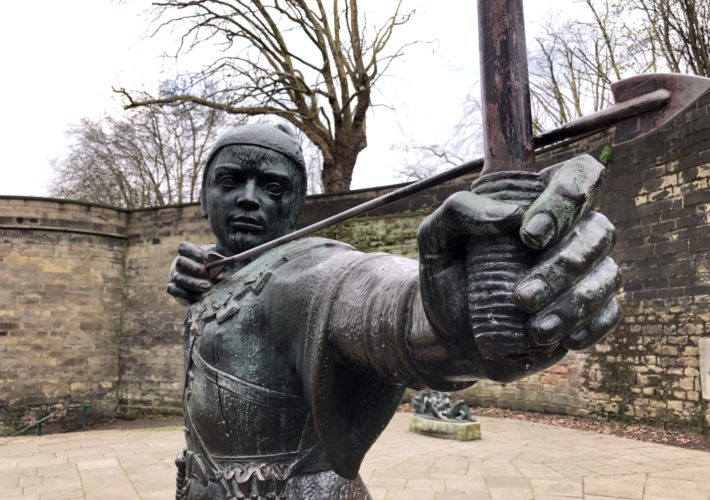
We left York and ventured down to Nottingham on the 8:30am train. It was a quick trip so we arrived at 10:30am and checked-in to our hotel Mercure Nottingham City Centre, which was a cool old boutique hotel but definitely haunted. We were staying two nights in Nottingham and the first night around o-dark-thirty the lights in the bathroom started flickering on and off multiple times. Faulting bathroom wiring? Probably not. The next night I was so paranoid that I closed the bathroom door and refused to sleep facing the door!
Anyways, back to Nottingham. Nottingham seemed so cool to visit with the legend of Robin Hood, but in fact it was just a big dirty town. I was actually really disappointed in Nottingham and have no desire to go back but we did see some interesting things…
After checking-in we walked to Nottingham Castle, but surprise, it was closed for refurbishment. It was quite a long walk so that was a disappointment. We did get to see the statue of Robin Hood outside of Nottingham Castle so that was pretty cool. We walked all the way back towards our hotel to the City of Caves. Since there was not much to see and do in Nottingham besides shopping (which my husband refused to do) we paid for a 12:00pm tour of the City of Caves which turned out to be the highlight of this city. The City of Caves is about 850 underground caves build in sandstone under the city. We put on our hardhats and walked underground for the tour. The caves were first dug around 900 AD and were used for family housing, beer cellars for pubs, leather tanning, and bunkers during World War II for the air raids. An interesting fact is the medieval tannery was built underground in 1250 and is the only one that still exists in England today. Tannery workers did not end up catching the plague back then but they did die around the age of 25-30 because of all the noxious gases and chemicals they were breathing in.
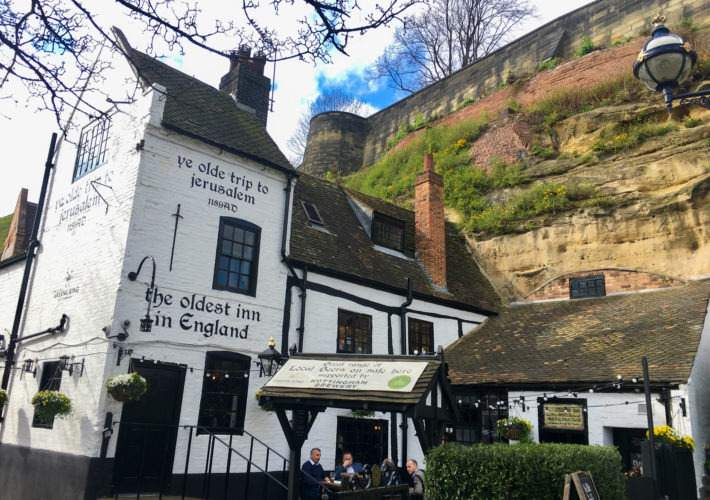
I had read about the Ye Old Trip to Jerusalem which is the oldest inn in England from 1189. The pub is built into the side of a sandstone cliff and the food was okay but I can now say I visited the oldest inn in England?
As you can see our time in Nottingham was only okay and not worthwhile. If we had another day here, I would probably have liked to do a Robin Hood tour or go out to Sherwood Forest.
Day Seventeen
Chatsworth house.

One of the main reasons we even stayed in Nottingham was because it was the largest, historical-ish city near Chatsworth House.
Chatsworth House is a huge private residence near Bakewell in the Peak’s District that was used as Pemberley in the 2005 Pride & Prejuidce movie. Yes, yet another of my fascinations apart from Harry Potter.
Getting to Chatsworth House from Nottingham using public transporation made for a long day but it was the cheapest option. We took the 9:19am train (9:47am actually with our first train delay) from Nottingham to Sheffield. Then from outside the Sheffiled train station, we boarded the Peak Line 218 bus to Chatsworth House. The bus ride was an hour long because of all the stops but it was the fastest bus to our final destination and traveling through the Peak’s District was lovely.
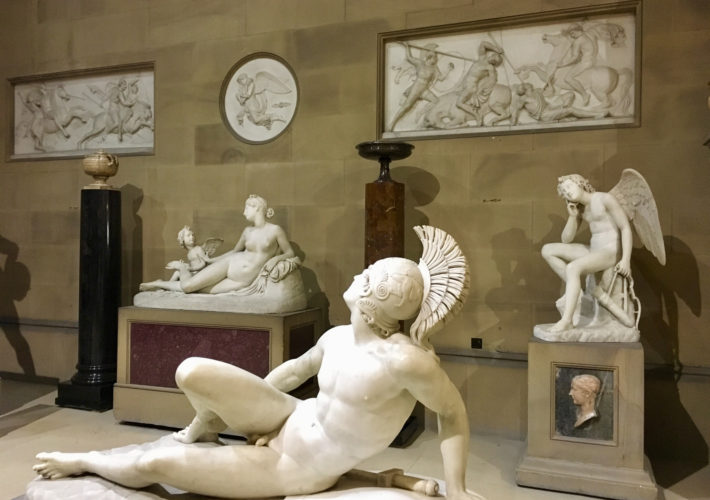
I had pre-purchased our tickets beforehand which saved us a lot of time getting inside the House because we were able to get into the pre-booked line. The House was absolutely stunning and it was a self-guided tour with a helpful handheld informational listening device. Some of the highlights were the Painted Hall, the library and music room, the sculpture room, the dining room, and many bedrooms. We spent about 3.5 hours total seeing the House and walking the gorgeous gardens.
One of my favorite things that happened was while we were in the music room, a random stranger sat down at the piano and started playing a famous song from the 2005 Pride & Prejudice movie. It honestly gave me chills and made me so happy to be visiting this gorgeous House.
Day Eighteen
Nottingham to heathrow airport.

This was our last day and was dedicated to traveling from Nottingham to Heathrow Airport in London. This was the only time during our entire trip where nothing went according to how I planned it…and of course this was the day where we needed to catch our flight back home!
We boarded our train at 7:30am that was supposed to take us from Nottingham to London St. Pancras train station. We sat on the train for about 10 minutes not moving when I discovered that all trains into London were cancelled for the day because of some overhead wires that were blocking the tracks. The conductor told us that the train would take us as far as Luton (about 36 miles from Heathrow Airport) and buses were going to be arranged at the Luton train station to take us into London. We figured nothing else could go wrong as the train had arranged transportation for us to get to London. That was until we arrived in Luton and saw about 100 other people from different trains all waiting for the London-bound buses.
After an hour of waiting and still not getting on a bus, we decided we needed another way into London or else we were going to miss our 2:35pm flight home. I ended up just calling an Uber for $75, which doesn’t seem like much except I had already spent $85 on our original train tickets. I had the Uber take us to London Paddington instead of Heathrow Airport because I already purchased our Heathrow Express tickets ahead of time and figured we might as well use them.
We made it to the airport in time and thankfully that was the only mishap that happened on our entire 17-day trip!
Until next time,

« Kilkenny, Wicklow Mountains, and Glendalough Tour
The ultimate guide to christmas in new york », you may also like, stonehenge, avebury, lacock, & bath tour.
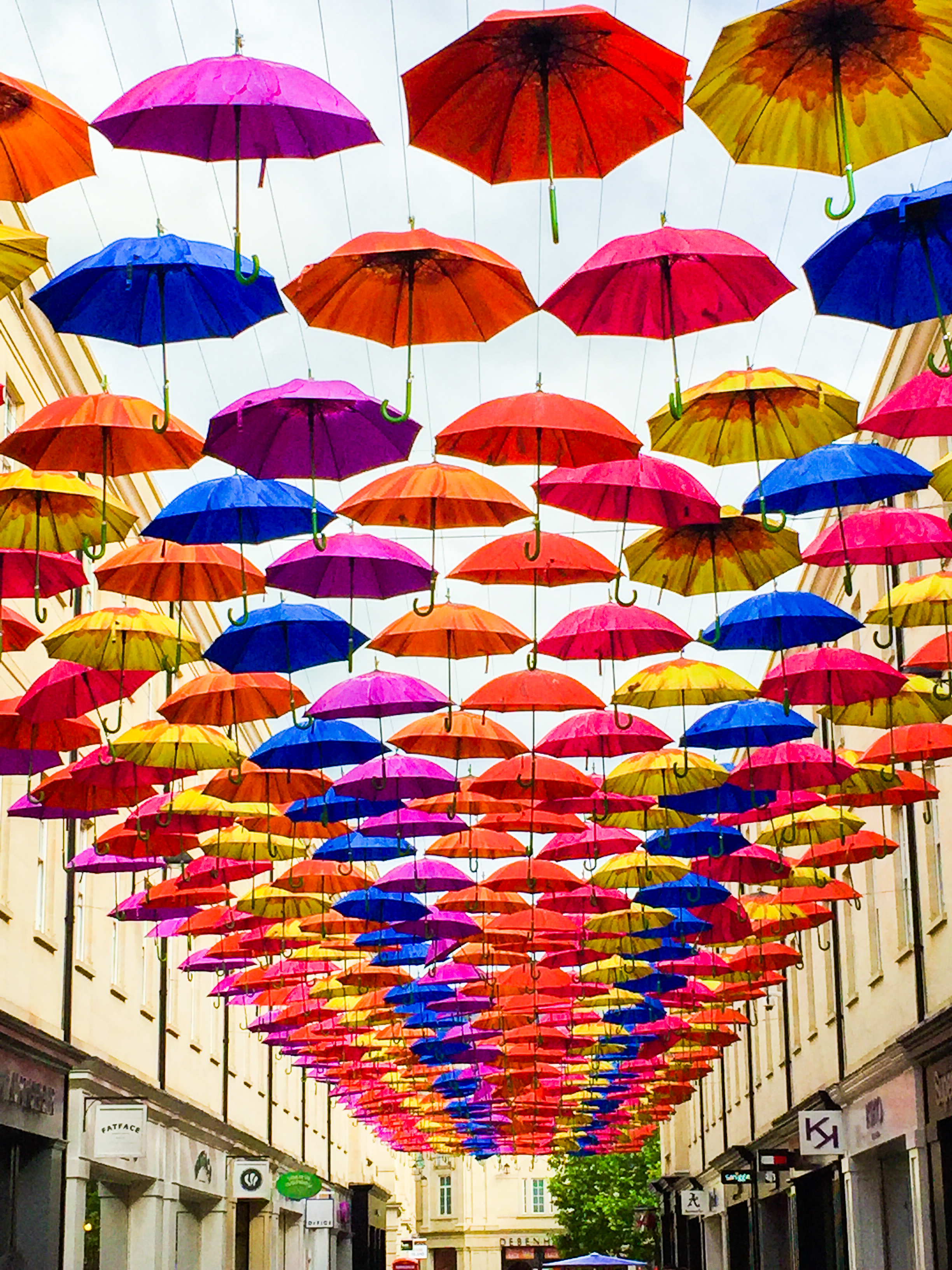
My Ultimate Guide to Bath

London Highlights
Leave a comment cancel reply.
Your email address will not be published. Required fields are marked *
Copyright 2020 A Girl's Travel Diary
Best Time to Visit England, Ireland, and Scotland
Customers rate Zicasso's travel referral service 4.9 on a scale of 1 to 5 based on 1557 reviews on Trustpilot
We match you with top tour companies that specialize in the trip you want, whether it's a customized private tour or a group tour.
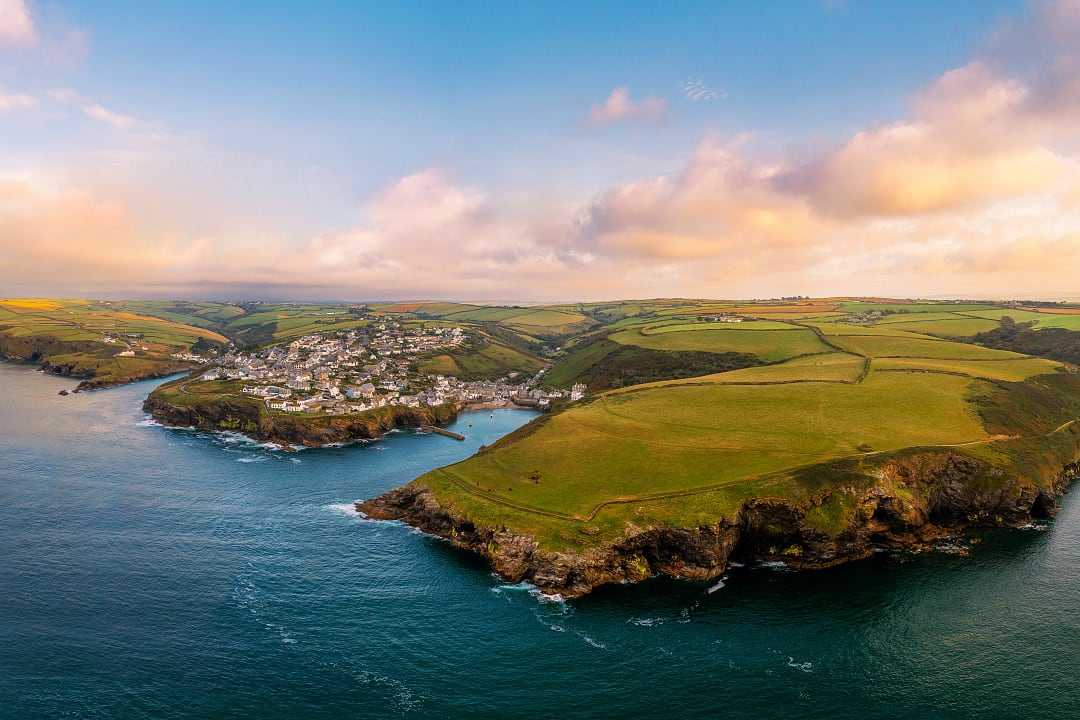
Port Isaac in Cornwall, England
Discover the wonders of fascinating and diverse countries when you travel during the best time to visit England, Ireland, and Scotland.
In all three, castles, quaint seaside towns, and countryside villages offer visitors the chance to step into bold, beautiful worlds. You can carefully plan each step of your journey or explore the charms of the countryside and treasures of the cityscapes on a whim.
Lush landscapes, ancient history and traditions, and boundless, flavorful cuisine display their timeless splendor, so giving yourself adequate time to uncover the ins and outs of England, Ireland, and Scotland will ensure you enjoy your desired experiences and more.
Best Time for Sightseeing
Best time for classic events, best time to avoid the crowds, best time for seniors, best time for couples or honeymooners, best time for families with children, best time for spring & summer activities, best time for fall & winter activities, book for the best time to visit england, ireland, and scotland.
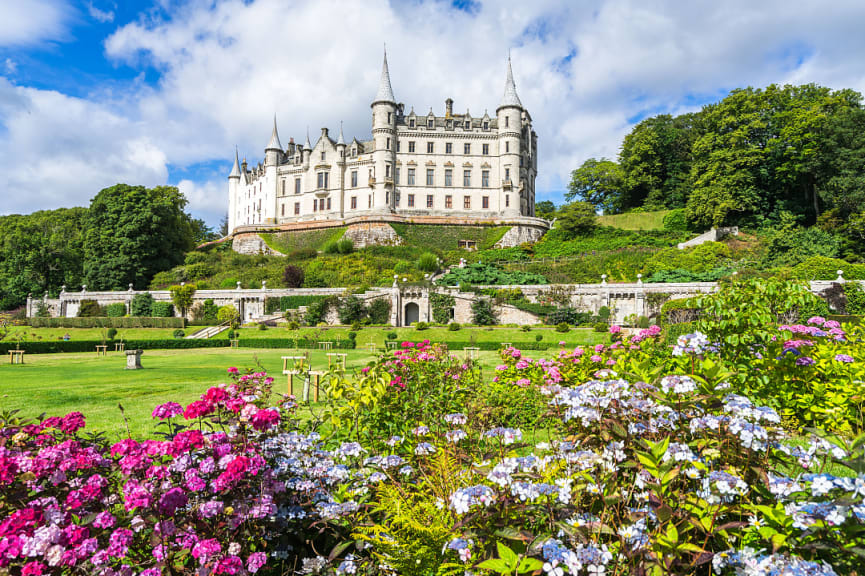
Dunrobin Castle, Scotland
Best Months: May • June • September • October
The best time to visit England, Ireland, and Scotland for sightseeing is any time from late spring to early fall, enabling you to make the most of mostly clear skies and warmer weather, especially between May and June and September and October.
Castle gardens are flourishing and indoor and outdoor museums are filled with inquisitive visitors. City squares and parks buzz with travelers taking in local tastes and talent, or simply sitting and enjoying their surroundings.
May to the end of June and September to October see visitors to England, Ireland, and Scotland walking cobbled streets or admiring famous monuments as they absorb the fabulous sights at their pace.
Learn more: Best Places to Visit in England • Best Places to Visit in Ireland • Best Places to Visit in Scotland
Expert Tips for Discerning Travelers

London, England
Best Months: April • May • June • July • August • September • October • November • December
From celebrating the monarch’s birthday to lively concerts, the magic of international festivals to the authentic allure of local ceremonies, there are many classic events to celebrate England, Ireland, and Scotland from April to December.
Plan your visit to any of these incredible countries’ city centers, castles, and lush corners, all of which host unmissable events and displays, as well as smaller celebrations that form part of the quintessential experiences.
Learn more: Top Things to Do in England • Top Things to Do in Ireland • Top Things to Do in Scotland
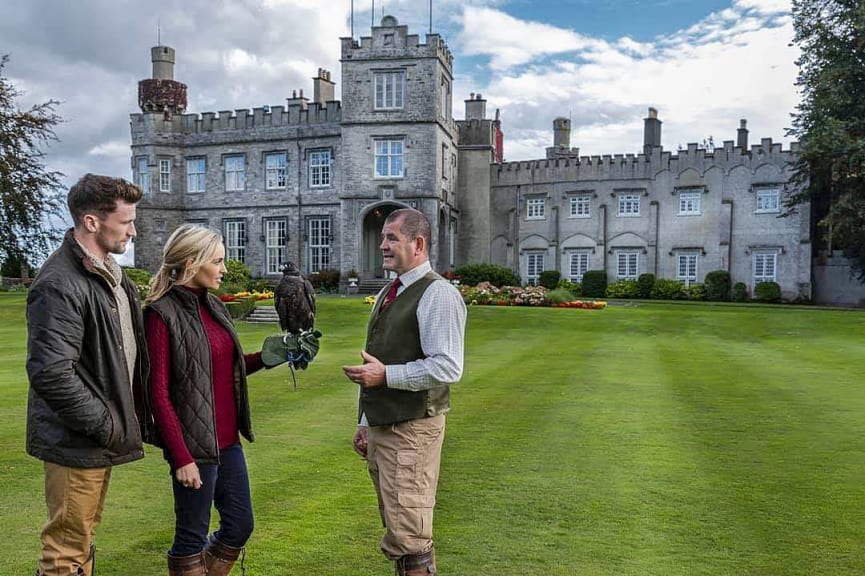
Luttrellstown Castle in Dublin, Ireland. Photo courtesy of Dublin Falconry
Best Months: March • April • May • September • October • November
To ensure you get that ideal spot on a viewing platform or the chance to discover a piece of history without packed rooms or overcrowded lakesides, it is best to consider traveling out of season to England, Ireland, or Scotland, specifically between March and May or September and November.
Many exciting venues, such as museums, castles, and art galleries, can be enjoyed no matter the time of year, while other activities, from falconry to the Scottish Highlands, may be more accessible in the warmer months. By traveling during the shoulder season months, you can enjoy authentic local charms and avoid crowds.
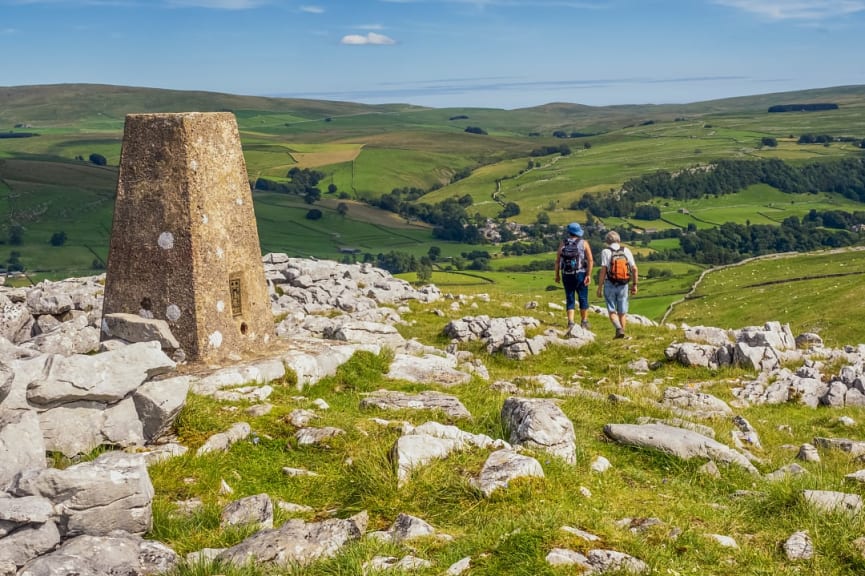
Yorkshire Dales, England
Best Months: April • May • June • September • October
Enjoy the diverse culture, history, and breathtaking scenes that make up the charming scenery that sweeps from villages to coasts from April to June and September to October. When visiting in spring and early fall, you can ensure the experience is comfortable and the path to all sights clear.
Enjoy the quiet streets in the springtime and take in the glorious blooms at palaces and parks, or take advantage of the early summer openings of museums, churches, and popular settings in the cities and their surroundings. Settle into a cozy cottage in a crisp country haven in the fall and truly indulge in the beauty these countries share.
Learn more: England Tours for Seniors • Ireland Tours for Seniors • Scotland Tours for Seniors
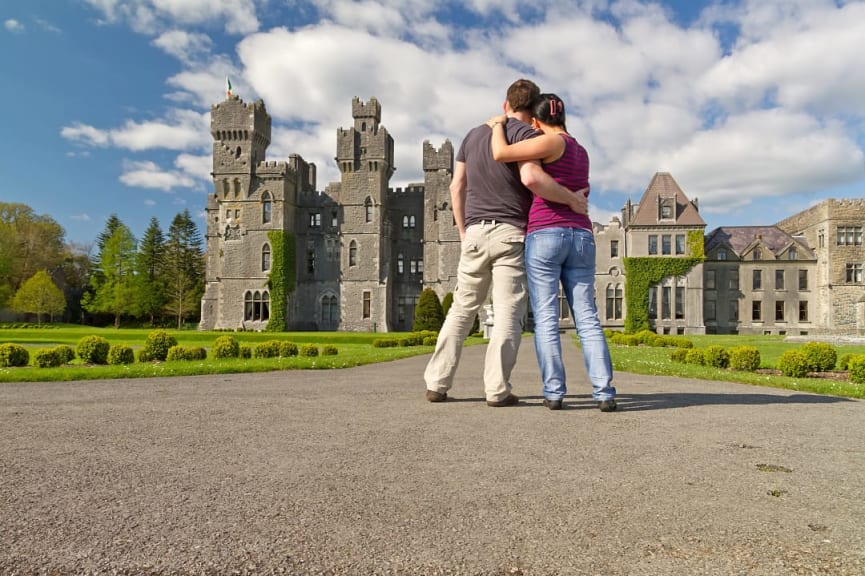
Ashford Castle in Conge, Ireland
Stepping away from the hustle and bustle of city life, honeymooners and couples seeking that romantic getaway can enjoy the quaint and quiet in the simply stunning English, Irish, or Scottish countryside. To ensure the weather is on your side, late May and June will give you the freshness of the countryside and quiet streets in cities and villages.
Escape to romantic destinations in all three countries as you embrace local charm and picturesque settings each step of the way to find magic in the crisp autumn air.
Learn more: Most Romantic Places in England for Couples • Most Romantic Places in Ireland for Couples • Most Romantic Places in Scotland for Couples

Stonehenge in Wiltshire, England
Best Months: April • May • June • July • August • September
England, Ireland, and Scotland have so much to share with family members of all ages, and experiencing what’s on offer together can make all the difference when traveling between April and September.
Bring the adventure of each country to life during the more pleasant seasonal weather as you explore places like Stonehenge or Buckingham Palace, the streets of Edinburgh or the Titanic Museum in Belfast.
Learn more: England Family Vacations • Ireland Family Vacations • Scotland Family Vacations
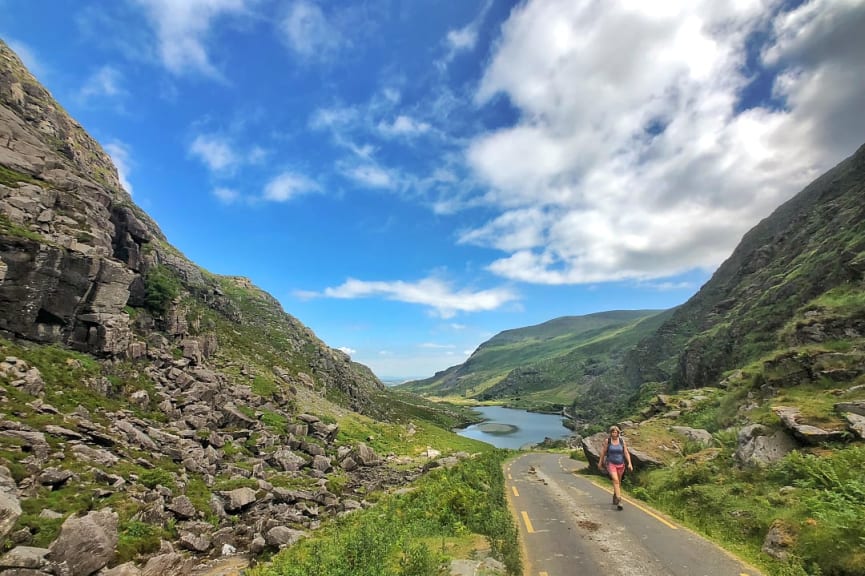
Gap of Dunloe, Ireland
Best Months: April • May • June
Watching flowers bloom in picturesque settings, while castle and palace grounds blossom with new life as birds come out to play, makes visiting England, Ireland, and Scotland delightful.
The air is fresh and rains light or non-existent, and outdoor venues start to open their doors. Take a brisk hike or drive through beautiful countryside villages, making the most of the longer days.
Spring and summer set the scene for the perfect playground for visitors to absorb the culture, breathtaking beauty, and vibrant ambiance that comes as the warmth turns up adventure in the outdoors.
Activities: Museums • Mountain Hikes • Coastal Walks • City Walks • Monument Visits • Country Excursions • Outdoor Concerts
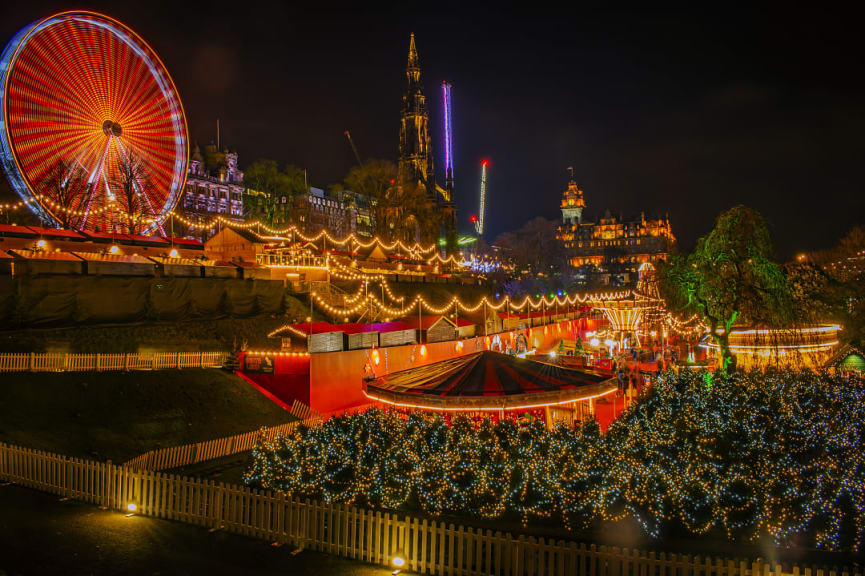
Christmas market in Edinburg, Scotland
Best Months: September • October • December
Enjoying a brisk walk through fall colors in massive parks or castle grounds is invigorating as September becomes October and the rush of summer dissipates, the winter throes of December providing a distinctive atmosphere.
Venture to the countryside bundled up and ready for the crisp air to complete the autumn ambiance. Indoor venues offer fascinating examples of culture, cuisine, and ancient history.
Winter brings with it a holiday feel and suddenly it is Christmas. The days get shorter and cozying up next to a crackling fire seems very appealing. Snow may dictate activities in the wonderland that settles across the countries.
Activities: Museums • Castle and Palace Visits • Cozy Lake Getaways • Skiing • Winter Sports • Christmas Markets

Urquhart Castle on Loch Ness, Scotland
There is so much to discover and enjoy in England, Ireland, and Scotland, and planning your experience around what interests you can make all the difference. Knowing when key sights will be open, how to avoid lines, and when to travel for that ultimate romantic adventure makes creating your journey easy and exciting.
Discover our featured England, Ireland, and Scotland tours , or explore the ways to spend 10, 14, and 21 days in England, Ireland, and Scotland for more ideas to inspire your travels.
Life-Enriching Travel Designed Just for You
Trips curated by the world’s top destination experts
Concierge-level service leading up to and during your trip
Unique, exclusive experiences and insider access
Help Me Plan My Trip
Get Top Travel Specialists to Help Plan Your Trip

Are you sure you want to sure you want to leave the feed?
Oops... something went wrong!
Looking for inspiration? Planning a trip? Or just want to scroll yourself happy? We'll show you an Ireland that's tailor-made for you.
- #Landscapes
- #CultureandHeritage
- #OutdoorActivities

Oops, no internet connection
While offline, you can still add items to ‘My Board’. New travel reccomendations will only show up once you’re back online.
See what Ireland has in store for you
Items without a physical location are not shown in map view.
Looks like your board is empty
Look out for the little heart icon around Ireland.com, simply tap the icon to start adding items to your board!

Board settings
Collection cover image.
Visible to people you share your board with
Share Board
Share a link to your ‘My Ireland’ board and inspire friends, co-travellers and family. Only you can add or remove items from your board.

Forgot your password?
Create an account.
Access My Ireland across all of your devices by logging in.
Sign up Not got an account?
Terms of use | Privacy policy
Login Got an account?
Location access
- View offers and deals nearby you
- Get travel inspiration based on your location
- Local weather warnings and useful travel information
Enable location access
Location access on ios.
- 1 Open the website settings for this website in your browser
- 2 Select Location settings
- 3 Choose “Allow
- 1 Open the My Ireland website

- 2 Select the Icon below

- 3 Select “Website Settings

- 4 Change “Location” to “Allow”

Notifications
Travel times.
Tell us when you are going to be travelling Ireland, and we will show you tailored recommendations for the duration of your trip.

- Tips for events happening during your stay
- Helpful travel reminders and updates
You have unsaved changes. Save before leaving?
We take your privacy very serious and only ever process your data with your persmission. If possible this is handled anonymously and we will never store your data for longer than is required. For more information on how we handle your personal data please read our Privacy Policy.
Remove Data
To securely remove all data associated with your profile please contact our Data Protection Officer.
Reset your Board
This will remove all the items you have previously liked from your board. Please note, you can’t undo this action.
Are you sure you want to reset your board?
This will completely reset your board and all associated data permanently. This cannot be undone.
- Created date 07 June 2024
Delete account
Sorry you’re leaving. But you gotta do what you gotta do. Just a reminder, if you delete your account, you won’t be able to post in Community. And it’s permanent so you can’t “undo” it in the future.

Ireland.com
Official website of Tourism Ireland for visitors to the island of Ireland.

Wild Atlantic Way Uncovered

The original cottagecore
Escape to one of Ireland's iconic thatched cottages

Mind, body, spirit... Ireland
Wellness experiences to soothe your soul

Ireland's secret sights
Discover hidden treasures off the beaten track

Ireland in your inbox
Sign up to receive free email newsletters from Tourism Ireland, including vacation ideas, insider tips, news, and events.
We will use your email address to send you personalised content straight to your inbox based on how you interact with this website and our advertisements on other websites.
Something went wrong...
Success! Thank you for subscribing to our Newsletter!
I understand that by signing up, I will receive personalised email content based on my use of Tourism Ireland’s website, emails and Tourism Ireland’s advertising on other websites, cookies and tracking pixels. You can unsubscribe at any time by clicking 'unsubscribe' in our emails. Find out more information on "How we handle your personal data" in our privacy policy .
I would like to receive information and special offers by email from carefully selected travel partners. For more information please see our privacy policy .
Where to go
One amazing island. Six unique regions

Soaring cliffs, buzzing little towns and a way of life forever inspired by the sea, that's what you'll find on the world’s longest defined coastal touring route.

Amazing cliff-walks, Game of Thrones® adventures, Titanic attractions – let Northern Ireland stir your soul.

A UNESCO City of Literature, a historic powerhouse and a super-cool capital that’s been named Europe’s friendliest city twice by TripAdvisor.

Did you know that there are over 5,000 years of history hidden amidst these lush landscapes, winding rivers and glorious gardens?

Cutting-edge food, traditional pubs and incredible Titanic history take Belfast to the next level – welcome to one of Ireland's most exciting cities.

With charming riverside towns and villages, majestic forests and sparkling waterways, Ireland’s Hidden Heartlands is slow-travel perfection.
Amazing places to see
Don't miss these iconic sights and hidden gems around the island

Cliffs of Moher

Destination
The Mourne Mountains

Skellig Islands
The Skellig Islands-Na Scealga

Giant's Causeway

Blarney Castle and the Blarney Stone

Carrick-a-Rede rope bridge

Guinness Storehouse

Titanic Belfast

Powerscourt Estate

Explore the Marble Arch Caves
Enniskillen

Brú na Bóinne

Discover historic Dunluce Castle

Rock of Cashel

The Book of Kells and Trinity College

Explore the Cuilcagh Boardwalk
Top things to do.

Plan your Ireland trip

Causeway Coastal Route
6 days 92 miles
The Causeway Coastal Route is one of Northern Ireland's greatest adventures.
From Belfast To Derry~Londonderry
- #NorthernIrelandEmbraceAGiantSpirit

48 hours in Derry~Londonderry and the Causeway Coast
2 days 84 miles
Explore the very best of Northern Ireland from the heart of the Walled City!
From Causeway Coast To Derry~Londonderry
- #FillYourHeartWithIreland
- #CityBreaks

Donegal's northern headlands
4 days 267 miles
Take a journey to the edge of the world...
From Inishowen To Killibegs
- #WildAtlanticWay

Surfers' paradise
2 days 99 miles
Sea and land combine to create a vista of pure poetry on the Wild Atlantic Way.
From Donegal To Mayo

Great Western Greenway
4 days 78 miles
Uncover the west of Ireland's most dramatic sights.
From Westport To Achill Island

Cliffs and coves
4 days 198 miles
Be wowed with panoramic views from atop the Wild Atlantic Way's most dramatic cliff edges.
From Galway To Limerick
- #WalkingandHiking

A trip around the Ring of Kerry
2 days 114 miles
Experience Ireland at its wildest.
From Killarney To Killarney National Park

Cycling the Waterford Greenway
2 days 50 miles
Grab your bike and take in the sites of this stunning cycling trail.
From Waterford city To Dungarvan
- #IrelandsAncientEast

Ireland's Ancient East from County Wexford
4 days 213 miles
Explore gorgeous landscapes and dramatic histories around Ireland's Ancient East.
From Rosslare To Kilkenny city

Explore Ireland's Ancient East on Dublin's doorstep
3 days 248 miles
Cinematic – that's the only word to describe what lies on Dublin's doorstep.
From Wicklow To Meath

Ireland's Hidden Heartlands
5 days 301 miles
Five days. 11 counties. One big adventure...
From Cavan Burren Park To Mitchelstown Caves
- #IrelandsHiddenHeartlands
Let Ireland inspire you!

Dublin city: top attractions
First time in Dublin? Here are some uniquely Dublin attractions you shouldn’t miss.
Dublin City

10 top Northern Ireland experiences
Fantastic food tours, Titanic trails and even walking on water!
Northern Ireland

5 ways to tour the Wild Atlantic Way
Get your feet wet or hit the tarmac: how to explore the Wild Atlantic Way.

Charming towns of the Causeway Coastal Route
Get set for a glorious adventure amongst picturesque towns and scenic fishing villages.

Take our fun St Patrick's quiz
Do you have the luck of the Irish? Test your St Patrick knowledge with our quirky quiz.

Belfast: top 9 attractions
Explore Belfast’s world-class museums, rich history, varied art scene and parkland

Hidden gems of Ireland’s Ancient East
Wherever you go in Ireland’s Ancient East, you’ll find unbelievable experiences.

Camper van holidays in Ireland
Here's everything you need to know about camper van hire, road rules and more.
- #CaravanandCamping
- #GettingAround

Derry Girls
Love the hit comedy series, Derry Girls? Here's how you can have your own adventure.
Derry-Londonderry

Ireland's 9 most haunted tales
From Satanic cults and a medieval ghost river to a tragic bride-to-be.

7 gorgeous spots for wild swimming
Take a dip in the crystal clear lakes and rivers on the island of Ireland.

Irish genealogy resources
Tracing your Irish roots? Here are some useful resources that can help you join the dots.
Ireland: need to know
Visas and passports
Here's what you need to know about Ireland’s visa and passport requirements.
Ireland: frequently asked questions
Find answers to all your Ireland questions.
Customs and borders
Learn about Ireland's customs and border regulations, duty-free allowances and more.
Bringing your pet to Ireland
Here's what you need to know if you're bringing your furry friend on holiday!
Discover all you need to know about Ireland's currencies, cards and bank services.
Emergency contacts
Make a note of the numbers to contact in case of emergency in Ireland.
Thinking of a trip to Ireland?

Getting here
Ireland from the air – what's not to love? We can help you find the perfect flight or ferry route for your Ireland trip.

Getting around
Ireland is compact, friendly and easy to navigate. So all you need to worry about is picking the right travelling companion.

Sustainable Ireland
From accommodation to activities, find out how to explore our beautiful island in a sustainable way.
UK Edition Change
- UK Politics
- News Videos
- Paris 2024 Olympics
- Rugby Union
- Sport Videos
- John Rentoul
- Mary Dejevsky
- Andrew Grice
- Sean O’Grady
- Photography
- Theatre & Dance
- Culture Videos
- Fitness & Wellbeing
- Food & Drink
- Health & Families
- Royal Family
- Electric Vehicles
- Car Insurance Deals
- Lifestyle Videos
- UK Hotel Reviews
- News & Advice
- Simon Calder
- Australia & New Zealand
- South America
- C. America & Caribbean
- Middle East
- Politics Explained
- News Analysis
- Today’s Edition
- Home & Garden
- Broadband deals
- Fashion & Beauty
- Travel & Outdoors
- Sports & Fitness
- Sustainable Living
- Climate Videos
- Solar Panels
- Behind The Headlines
- On The Ground
- Decomplicated
- You Ask The Questions
- Binge Watch
- Travel Smart
- Watch on your TV
- Crosswords & Puzzles
- Most Commented
- Newsletters
- Ask Me Anything
- Virtual Events
- Betting Sites
- Online Casinos
- Wine Offers
Thank you for registering
Please refresh the page or navigate to another page on the site to be automatically logged in Please refresh your browser to be logged in
Donald Trump’s felony conviction now means he’s banned from a host of countries including Canada and UK
There are nearly 40 countries that bar felons from entering, even to visit., article bookmarked.
Find your bookmarks in your Independent Premium section, under my profile

Sign up for the daily Inside Washington email for exclusive US coverage and analysis sent to your inbox
Get our free inside washington email, thanks for signing up to the inside washington email.
Now that Donald Trump is a convicted felon, his list of countries to visit has gotten much shorter.
Trump was found guilty on Thursday of 34 counts of falsifying records in an effort to keep adult film star Stormy Daniels quiet about an affair that occurred in the 2000s. That means certain freedoms Mr Trump once enjoyed may be out of his reach — and could have a serious effect on his ability to carry out his presidential duties, including travelling to foreign countries.
Nearly 40 nations - including Canada and the UK - have strict policies when it comes to allowing individuals with criminal records across their borders, and barring a special accommodation, Trump would be held to those same standards. It’s unclear if he would be allowed to visit if he wins the presidential election in November, but remains a felon.
Here are just five of the over 35 nations that can now ban Trump from entry now that he's a felon:

Despite Trump once retweeting someone who referred to him as the "King of Israel" and bragging that he moved the US embassy in Israel to Jerusalem, Trump may not be able to visit the nation now that he's a felon.
Israel reserves the right to refuse entry to anyone with a criminal record, including felonies. Border control forces in Israel have the authority to bar entry for anyone suspected of committing a crime or with a record, and Trump meets both of those qualifiers.
According to the Canadian government's tourist hub, any "US Citizen or permanent resident that has a felony conviction on their criminal record may be deemed inadmissible to Canada for the purposes of immigrating, or even if they're merely coming to Canada to visit."
Canada even retains the right to bar individuals "arrested or accused of a felony crime ... even though you have not been convicted," meaning Trump would have faced issues visiting the US's northern neighbor the moment he faced charges.
The government notes that "a felony will likely result in inadmissibility."

Japan is fairly strict with its immigration and visitation rules, including laws preventing convicted criminals from entry.
Under Japanese law anyone convicted of a violation of "any law of regulation" of any country and who has been sentenced to "imprisonment with or without work for one year or more, or to an equivalent penalty" can be barred from entry.
Japanese law does note that individuals convicted of a "political offence" are not subject to those rules. In Trump's mind, at least, he could qualify to visit under those terms. It's unclear if Japan would buy his version of events.
Under UK law, a felon can visit England, Wales, Northern Ireland, and Scotland with some restrictions and requirements in place. However, Britain can bar access to convicted felons.
Unless an “Immigration Officer is satisfied that admission would be justified for strong compassionate reasons,” they can refuse access to any convicted felon so long as the crime they committed would also be punishable by imprisonment in the UK.

China has strict policies when admitting anyone over its borders. Chinese officials conduct character assessments for anyone applying for a visa, and that includes a criminal history check, including felonies.
Even minor offences can get someone barred from entering China, so Mr Trump may not be able to chide the Chinese in person if he were ever so inclined.
Countries and territories that restrict visits from felons
- Dominican Republic
- New Zealand
- Philippines
- South Africa
- South Korea
- United Arab Emirates
- United Kingdom
Join our commenting forum
Join thought-provoking conversations, follow other Independent readers and see their replies
Subscribe to Independent Premium to bookmark this article
Want to bookmark your favourite articles and stories to read or reference later? Start your Independent Premium subscription today.
New to The Independent?
Or if you would prefer:
Want an ad-free experience?
Hi {{indy.fullName}}
- My Independent Premium
- Account details
- Help centre
'London Pride 2024 was my first — I wish I'd experienced it sooner and I'll be back next year'
I am a 23-year-old straight woman and London Pride 2024 was my first ever Pride parade. From now on, I will attend every year

- 21:17, 29 Jun 2024
- Updated 21:57, 29 Jun 2024
As a straight woman I have never felt compelled to go to London Pride, but after attending for the first time this year, I can confirm that I will now go every year.
London Pride 2024 really exceeded my expectations. As I stepped foot on the Tube at Clapham Common station, the presence of Pride was apparent. Glints of rainbow coloured accessories were scattered throughout the carriage, and with each stop closer to Charing Cross, the carriage only became brighter with colour.
For someone who hadn't been to a Pride event before, let alone London Pride, I didn't really know what to expect. But from the moment I left the stuffy hot carriage and heard the grumbling roar of a crowd, I knew that Pride was no small feat.
Was this your first Pride or one-hundredth? Email us at [email protected]
Entering Trafalgar Square was like stepping onto the set of my very own Disney movie. People everywhere were smiling, donned with rainbow face paint and multi-coloured costumes. For a city often known for its grumpy commuters who don't smile or make eye contact, Trafalgar Square couldn't be more different.
Trafalgar Square was the heart of the whole London Pride festival and had a grand stand with performers constantly dancing or singing, food stalls littered at its edges, and an array of community stalls championing the L GBTQIA+ community.
There was so much going on in the square alone that I nearly missed the parade of thousands of people occurring just behind me.

Already set in full swing, the parade was a party for the eyes. Similar to Trafalgar Square, everyone was happy and smiling. Dancing, singing, cheering, you name it — the parade was doing it.
From Co-op and Coca Cola to Deloitte and HP, the constant flow of people representing clubs, companies, groups and different nationalities was empowering to see. In particular, Coca Cola's bus completely covered in red glitter was a moment that has made be believe that every London bus should be decorated that way.
And yet, whilst the weather scorched the crowds, people were not deterred from dancing and singing along to each floats' music.
For so many years I believed Pride was exclusive to the LGBTQIA+ community, but today made me realise I could not have been more wrong.
From tiny toddlers running around with rainbow ribbons in their hair, to heterosexual couples screaming at the top of their lungs when the parade started playing Taylor Swift, I couldn't have felt more included. This wasn't just a celebration of LGBTQIA+ people, but a celebration of what they have achieved, their history and support from allies.
It made me proud to be a Londoner.
The different stages scattered around the square mile also showcased and celebrated every single part of the LGBTQIA+ community. From a cabaret stage to a stage celebrating LGBTQIA+ women and non-binary individuals, the talent performing and the crowds enjoying themselves was equally entertaining and inspiring.
Surrounding bars, restaurants and shops had also pulled out all the stops. Store fronts had been dressed with flags and multi-coloured balloons, bars had especially created Pride themed drinks, and restaurants offered Pride inspired menus.
The tiny iced cans of Coke Zero being handed out were a very welcome refresher.
Even though all of this was incredible to witness and be a part of, what I will remember from my first Pride is seeing the crowds enjoying themselves and feeling welcomed into a community I don't necessarily belong to.
The atmosphere felt like the embodiment of 'I am unashamedly being myself' — a sentiment that made me emotional and made me determined to behave the same.
It is for that reason London Pride will proudly be marked on my calendar every year moving forward.
Check out more of Daily Mirror's latest travel stories by signing up to our free weekly newsletter.
MORE ON Pride London Sexuality Pride Month LGBTQ+ LGBTQ+ rights Activity holidays
Can we send you the mirror travel newsletter with weekly travel news and inspiration.
- Coffee House

A visit to ye olde Ireland
- From magazine issue: 29 June 2024

Melissa Kite

Melissa Kite has narrated this article for you to listen to.
The £80 million super-yacht with a helicopter on the upper deck sat in the harbour, and we sat outside the ice-cream parlour in an old banger that had broken down.
Our dear next-door neighbour in Ireland had taken us to chi-chi Glengarriff in the Beara peninsula and had insisted on driving us, because she has her car crammed full of essential clobber, like her walking sticks and a shopping basket nicked from the local supermarket in which she stashes her supply of duty-free cigarettes.
The sheep-shearing, diddly-dee Ireland they have, very cleverly, preserved for the Americans
We made a motley crew, the builder boyfriend and me and this doughty Irish lady who drove her old banger along while shouting out the open window at anyone who annoyed her, such as a driver in front indicating to turn right then slowing down to make the turn. ‘What the feck are ye doing? Ye eejit!’ she yelled.
Hurtling along, as the BB and I clung to our seats for dear life, she swerved and shouted her way to a little restaurant in the bay of Ballylickey, where lunch was delicious.
But then the good lady decided she would like to show us Glengarriff, another few miles along the coast.
As we approached, we caught sight of a yacht so big that the BB, a keen yachtsman, recognised it from an article he had read. He was telling us all about the billionaire who owned it as we swung into the main street, veering from side to side as our septuagenarian friend let rip at all the tourists daring to try to cross the street in front of her. ‘Get out of the way, ye feckin’…’
Glengarriff reminded me of nothing so much as a themed village at Disney World. Swing-door shops selling what the world would like to think Ireland is about, along with cute cafés and brightly painted bars outside of which sat young people with fiddles playing what the BB calls diddly-dee music.
Most popular
There’s one place in spain that hasn’t turned against tourists.
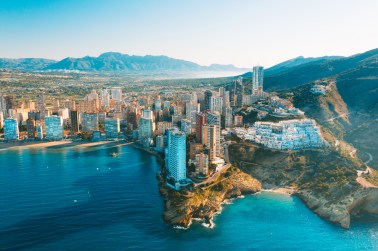
It was heaving with tourists, mostly Americans, who must have thought they had died and gone to heaven. This is what Ireland is like in the mind of someone with Irish ancestry who lives in New York or Florida or the Midwest. This is not what Ireland is like, obviously.
If the Americans came to where we live, they would be a bit stuck unless they fancied a mooch round the charity shop where stained curtains can be purchased, a microwaved burger from the Pizza Palace or deep-fried chicken balls from a Chinese restaurant which once served the BB spare ribs with a piece of metal wire, and he said that was the least offensive thing about it.
As for traditional Irishness, if you ask our verbally dexterous friend what she thinks of the beautiful Irish language, or listening to fiddle music, she’d look at you like you’d gone mad. She’s looking forward to a trip to Benidorm and some more duty-free cigs.
The sheep-shearing, diddly-dee Ireland they have, very cleverly, preserved for the Americans, however.
And our neighbour wanted to show it us for a laugh. So after screeching into Glengarriff she swerved over the wrong side of the road to park where she fancied, blocking the oncoming traffic and, when the driver of a German camper van that couldn’t get past wound his window down and screamed at us, she screamed back: ‘Feck off! Eejit!’
Then she demanded an ice cream.
I went into a pretend ye olde organic Irish ice-cream parlour to get them and we sat in the car slurping them, and all the while she had the key turned in the ignition, which we found out once she tried to start it up again.
Then we sat in this broken-down old banger with our dripping cornets and floaty dressed tourists, including the super-rich from their yachts, walking by staring at us, and backed-up camper vans pipping their horns, and our friend announced she was going to get out and flag someone down to jump-start us.
Whereupon the BB said enough was enough, slurped the last of his ice cream and jumped out. Standing behind the car, he shouted at her to turn the key, put it in gear and take the handbrake off.
As the builder b pushed the old banger forwards down the wrong side of the road, the oncoming traffic had nowhere to go.
‘Stop! Stop! Stop pushing for feck’s sake!’ screamed our friend. I couldn’t do anything. I was doubled up in the back seat laughing.
The BB kept pushing as she shouted. The oncoming cars loomed closer. She screamed and swore. I shut my eyes. And then with only inches before we hit the car in front of us, the engine started.
The BB jumped back in the car and told her to drive. Drive! As the gawping American tourists stood staring, she let out a volley of expletives that would strip paint, screaming at everyone to get out of her way and, as the car screeched across the road, the BB waved at them all and shouted: ‘Welcome to Ireland!’
Democrats have led America to the brink of the abyss

Because you read about america
No tips please, we’re British

Also by Melissa Kite
Have I finally found the most incongruous leftie?

Why is Starmer starting rows before the election?

Comments will appear under your real name unless you enter a display name in your account area. Further information can be found in our terms of use .

Can England win the Euros by playing like Martin O'Neill's Ireland?
BEFORE Euro 2024 began, England were the favourite of most bookmakers to triumph.
It’s hard to remember a previous example of when the most hotly-tipped team to win a major tournament looked so technically limited.
The irony is that today’s 1-1 draw with Denmark all but assures the Three Lions’ place in the knockout stages, but the downcast mood and fans booing at full-time told a different story.
The frequent joke about Martin O’Neill’s Ireland was that they scored “too early”.
Many times over the years, particularly under O’Neill, Ireland went ahead in games and tried to batten down the hatches, consequently always getting overrun by technically superior teams like Georgia.
It happened during the nadir of O’Neill’s Ireland reign, a 5-1 defeat by Denmark when a Shane Duffy goal after six minutes had given his side false hope.
England were not quite as bad as the Boys in Green that night, but with better players, they have been deploying a similar game plan for years.
It was true of their 2018 World Cup semi-final defeat against Croatia when Kieran Trippier’s free-kick put them ahead after five minutes only to lose 2-1.
It was also the case in the Euro 2020 final at Wembley, when Luke Shaw scored after two minutes only for the Italians to dominate for much of the remaining contest before winning on penalties.
And it was evident against Serbia the other night when Gareth Southgate’s side more or less shut up shop after Jude Bellingham’s 13th-minute opener.
And there was another repeat showing this afternoon.
The biggest difference between the Serbia and Denmark games was the latter played with more self-belief.
In the first 13 minutes especially, you got the sense the Serbs had bought into the England hype and lacked any real conviction in attack, struggling to trouble their defence despite dominating the play.
Serbia coach Dragan Stojkovic acknowledged as much afterwards.
“Against England, we started playing with too much respect for them, like they came from another planet,” he said.
“It should not be like that. We’ve played better against them later in the match and that’s how we’ll play against Slovenia.”
Serbia arguably deserved a draw on the balance of play, and similarly today, Denmark could easily have turned a point into three.
However, Kasper Hjulmand’s side — who looked considerably more threatening with seven shots on target to four — seemed happy enough with the result. Would they have substituted Christian Eriksen and goalscorer Morten Hjulmand with just over 10 minutes remaining in a knockout game?
They were a technically superior, better-organised team and ended the game much stronger.
Gareth Southgate’s men, by contrast, looked bereft of ideas and were ultimately reduced to constantly knocking hopeful long balls up the pitch — a sure sign that a team has lost faith in its game plan assuming there was a clear one to begin with.
Declan Rice might have been forgiven for feeling like he was back playing for O’Neill’s Ireland, for whom he won three caps in 2018 (a 1-0 loss to Turkey in the game directly after the Denmark mauling, a 2-0 defeat by France and a 2-1 win over USA).
Rice’s former teammate James McClean received plenty of flak online for claiming the Arsenal star is overrated and not world-class .
“I don’t think he gets in the Man City side ahead of Rodri,” the ex-Ireland international added. “I know Toni Kross is now retiring, but Toni Kroos is world-class to me. He dictates the game, Rodri dictates the game, I don’t think Declan Rice does that.”
The comments were harsh but there is some truth to them.
Rice is brilliant at many aspects of the game. Physically, there are few superior players at the elite level. But technically, he is somewhat limited, struggles on the half-turn, and is usually happy to play the ball backwards or sideways — these flaws tend to be especially notable at major tournaments, where the football is much slower and more methodical compared with the Premier League.
At Arsenal, he plays alongside Jorginho and Martin Odegaard, two players who can compensate for Rice’s deficiencies.
Southgate was hoping Trent Alexander Arnold could do the same for England.
Yet the Liverpool star has been substituted relatively early in both group games for the more industrious Conor Gallagher, and it appears this experiment has failed.
The midfield remained England’s biggest problem for much of the 90 minutes, so Southgate’s bold decision to take off his attacking trio of Harry Kane, Bukayo Saka and Phil Foden felt irrelevant.
It was not addressing the main issue, which continued to impact the side, as Ollie Watkins, Jarrod Bowen and Eberechi Eze were similarly isolated owing to the midfield’s inability to knit the play together with the likes of Eriksen, Hjulmand and the excellent Pierre-Emile Højbjerg winning the battle in that area of the pitch.
However, England should not be written off based on today’s game.
Interestingly, their defence, which some critics cited as their biggest weakness going into the tournament, has been the most impressive aspect of the opening two games.
And competency in this position is invariably what wins teams tournaments — Spain were victorious in all their knockout games 1-0 at the 2010 World Cup and France kept clean sheets at four out of seven matches on their way to glory in 2018.
Yet at the moment, the relatively solid-looking backline coupled with a couple of individual players capable of producing a moment of magic out of nothing is all Southgate is relying on.
Their midfield has not been good enough for this level and those people who bought into the hype and backed England to end 58 years of hurt surely are having second thoughts now.

Aer Lingus cancelled flights: Latest list of services disrupted due to industrial action
Most affected flights are for destinations in the uk and mainland europe.
Aer Lingus confirmed on Friday that it would cancel some 122 services between Wednesday, July 3rd, to Sunday, July 7th
Aer Lingus confirmed on Friday that it would cancel some 122 services between Wednesday, July 3rd, to Sunday, July 7th, to preserve as many flights as possible in the face of the pilots’ action.
This is in addition to flights it previously cancelled .
Below is the list of the flights cancelled on Friday.
FLIGHTS DEPARTING IRELAND
Wednesday, july 3rd, flights resume after aer lingus pilot strike disrupts journeys affecting 17,000 passengers.
:quality(70)/cloudfront-eu-central-1.images.arcpublishing.com/irishtimes/5FDEGPGX2FG6LEMXL3Q4TH2FDQ.JPG)
Taylor Swift in the Aviva review: ‘You know this but nobody does it like you Dublin’
:quality(70)/cloudfront-eu-central-1.images.arcpublishing.com/irishtimes/5TGNQ3Q5OZH3XFC6TUYF3UQ4MQ.JPG)
Irish renters living in fear: ‘We can’t get mortgages, even though I’ve been paying rent for 12 years’
:quality(70)/cloudfront-eu-central-1.images.arcpublishing.com/irishtimes/ZJSOHZPORRCJBLLGOOACO6YFBA.jpg)
What I Read This Week: Shauna Bowers - Miriam Lord articulates what every woman in Ireland was thinking
:quality(70)/cloudfront-eu-central-1.images.arcpublishing.com/irishtimes/UU4NLBY63FHJDBLXBHEXSOKFCA.jpg)
London/Heathrow (LHR) EI0724 – 8.30pm
Amsterdam (AMS), EI0602 – 6.15am
Berlin/Brandenburg (BER), EI0332 – 6.40am
Birmingham (BHX) EI0276 – 7.20pm
Brussels (BRU), EI0638 – 5.55pm
Dusseldorf (DUS), EI0698 – 5.30pm
Frankfurt (FRA), EI0656 – 4.45pm
London/Heathrow (LHR) EI0162 – 11.15am
London/Heathrow (LHR) EI0182 – 7pm
Manchester (MAN) EI0208 – 12.50pm
Munich (MUC) EI0352 – 7.10am
New York (JFK), EI0105 – 11.05am
Paris (CDG), EI0526 – 1pm
Thursday, July 4th
Brussels (BRU) EI0638 – 5.55pm
Geneva (GVA), EI0680 – 6.15am
Manchester (MAN) EI0208 – 12.50
New York (JFK), USA EI0105 – 11.05am
Paris (CDG, EI0528 – 6.20pm
Vienna (VIE), EI0660 – 6.10am
Friday, July 5th
Amsterdam (AMS) EI0602 – 6.15am
Dusseldorf (DUS) EI0698 – 5.30pm
Frankfurt (FRA) EI0656 – 4.45pm
New York (JFK) USA EI0105 – 11.05am
Paris (CDG) EI0526 – 1pm
Munich (MUC), EI03520 – 7.10am
Saturday, July 6th
Amsterdam (AMS) EI0610 – 6.15pm
Berlin/Brandenburg (BER) EI0332 – 6.40am
Birmingham (BHX) EI0262 – 6.30am
Geneva (GVA) EI0680 – 6.15am
Hamburg (HAM) EI0392 – 10.15am
Heathrow (LHR) EI0176 – 5pm
Lyon (LYS) EI0552 – 12.55pm
Paris (CDG) EI0528 – 6.20pm
Sunday, July 7th
Lyon (LYS), France EI0550 – 6.15am
Paris (CDG) EI0524 – 9.50am
FLIGHTS DEPARTING UK
Wednesday, july 3th.
Birmingham (BHX) Dublin (DUB) I0277 – 8.50pm
.London/Heathrow (LHR) Cork (ORK) EI0725 – 10.25pm
London/Heathrow (LHR) Dublin (DUB) EI0163 – 1.25pm
London/Heathrow (LHR) Dublin (DUB) EI0183 – 9.10pm
Manchester (MAN) Dublin (DUB) EI0209 – 2.25pm
Birmingham (BHX) Dublin (DUB) EI0277 – 8.50pm
London/Heathrow (LHR) Cork (ORK) EI0725 – 10.25pm
Heathrow (LHR) Dublin (DUB) EI0163 – 1.25pm
Birmingham (BHX) Dublin (DUB) EI0263 – 8.15am
.London/Heathrow (LHR) Cork (ORK) I0725 – 10.25pm
London/Heathrow (LHR) Dublin (DUB) EI0177 – 7.10pm
Manchester (MAN) Dublin (DUB) EI0209 – 2.25PM
FLIGHTS DEPARTING EUROPE
Amsterdam (AMS), Dublin (DUB), EI0603 – 9.35am
Berlin/Brandenburg (BER), Dublin (DUB), EI0333 – 10.40am
Brussels (BRU), Dublin (DUB), EI0639 – 9.20pm
Dusseldorf (DUS), Dublin (DUB), EI0699 – 9.05pm
Frankfurt (FRA), Dublin (DUB), EI0657 – 8.40pm
Munich (MUC), Dublin (DUB), EI0353 – 11.25am
Paris (CDG), Dublin (DUB), EI0527 – 4.30pm
Brussels (BRU), Dublin (DUB), EI0639 – 9.25pm
Geneva (GVA), Dublin (DUB), EI0681 – 10.15am
Paris (CDG), Dublin (DUB), EI0529 – 9.50pm
Vienna (VIE), Dublin (DUB), EI0661 – 10.40am
Amsterdam (AMS), Dublin (DUB), EI0611 – 9.40am
Hamburg (HAM), Dublin (DUB), EI0393 – 2.00pm
Lyon (LYS), Dublin (DUB), IEI0553 – 4.50pm
Berlin/Brandenburg (BER), Dublin (DUB), IEI0333 – 10.40am
Lyon (LYS), Dublin (DUB), EI0551 – 10.10am
Paris (CDG), Dublin (DUB), EI0525 – 1.20pm
FLIGHTS DEPARTING NORTH AMERICA
New York (JFK), USA, Dublin (DUB), EI0104 – 4.55pm
New York (JFK) , USA, Dublin (DUB), EI0104 – 4.55pm
- Sign up for push alerts and have the best news, analysis and comment delivered directly to your phone
- Join The Irish Times on WhatsApp and stay up to date
- Listen to our Inside Politics podcast for the best political chat and analysis
IN THIS SECTION
Ryanair rejects claims of price hikes as aer lingus customers scramble for flights, union overseeing pilots’ group tells other aer lingus staff to work as normal, aer lingus pilots’ dispute grounds another 20,000 passengers, ‘we are not going to say we are going to get over his loss because we won’t’, mick wallace tells son’s funeral, luas services disrupted after ‘reckless motorist’ left van on tracks, ‘the experience is almost otherworldly’: at taylor swift with the tortured dads department, i saw a video of my ex-girlfriend on a porn site but i don’t think she knows, galway knock dublin out of the all-ireland in second half thriller, latest stories, a truth and reconciliation commission in northern ireland would require a high level of mutual trust, germany storm past denmark into quarter-finals after wild night in dortmund, man (41) appears in court charged with murder of brother in co kerry.
- Terms & Conditions
- Privacy Policy
- Cookie Information
- Cookie Settings
- Community Standards

IMAGES
VIDEO
COMMENTS
The verdict. The decision of whether you should visit England or Ireland is a tough one, especially since both countries offer plenty of cultures to learn about, traditional food to eat, and beautiful landscapes to explore. But, if we simply had to choose one, we'd go with Ireland by the length of a tiny leprechaun.
The UK and Ireland are great places to visit for backpackers and budget travelers. The UK is a very popular country for backpackers and budget travelers. The overall price of travel in the U.K. can be quite high, so backpackers and budget travelers will need to plan ahead to find affordable accommodations and entertainment options.
Average high temperatures in England and Ireland in winter clock in around 5-7ºC (41-45ºF) and 0-5ºC (32-41ºF) in Scotland. Winter in Britain and Ireland can be miserable, however, many do like to travel around Christmas time in order to enjoy the decorations and markets scattered throughout the cities. Cities like London and Edinburgh have ...
Day 6: Blarney Castle, the Rock of Cashel, and Cahir Castle. On Friday, we took a guided Blarney Castle day tour around the southern counties of Ireland to see some castles. Stops on this trip included the Rock of Cashel, Blarney Castle, and Cahir Castle. For anyone looking to get from Dublin to Blarney Castle to kiss the Blarney Stone, this is ...
July and August are peak season throughout England, Scotland, and Wales — with very long days, the best weather, and the busiest schedule of tourist fun. May and June can be lovely anywhere in Britain. Except during holidays and festivals, prices and crowds don't go up during peak times as dramatically in England and Wales as they do in much ...
The summer is a lovely time to visit, as the weather is very agreeable, although the region can get quite a bit of rain. There is between 15-16 hours of daylight during the summer. Temperatures average 16 °C (61 °F), so hiking and camping would be fantastic during this time, as would any coastal family trips.
10 best England and Ireland tour packages. Compiled by. Nina England and Ireland travel expert at TourRadar. England, Scotland and Ireland end Dublin. Aonghus Youth. Best of UK & Ireland. Britain and Ireland Experience (15 Days) Essential Britain & Ireland. Britain and Ireland Explorer (19 Days)
In England and Scotland, a handshake is common, while in Ireland, a warm smile and a friendly "hello" are commonly exchanged. It's always polite to use "please" and "thank you" in interactions. 3. Tipping: Tipping is customary in restaurants, bars, and for services like taxis or tour guides.
If you're still not sure what the best time to visit the UK and Ireland is for you, we're always happy to help you decide. Discover the best of the UK and Ireland on a private and tailor-made tour with us. Popular Trips to the UK and Ireland England and Scotland: Historical Cities 17 Days from $11,990 / person. Places:
Available on selected dates from $ 2,950 per Person. Britain & Ireland Highlights. Ask a Question >. Our 10-day England, Ireland, Wales & Scotland tour gives you the opportunity to immerse yourself in the rich culture, history, and heritage of these ancient lands as well visiting historic villages, towns, and cities, We'll travel through the ...
May is a great time of year to visit England as many flowers and trees are blooming and the weather is typically nice, especially on the coast. Fall, which lasts from September to November, is another great time of year to visit England. The weather does cool down, but September and October can bring heat waves, especially in the south.
Rick's Best Three-Week Trip to England by Car. This 20-day itinerary covers the top sights in England. Day 1: Arrive in London, connect to Bath (sleep in Bath) Day 2: Bath (sleep in Bath) Day 3: Pick up car, visit Stonehenge, Wells, and Glastonbury (sleep in Bath) Day 4: Avebury, Blenheim Palace (sleep in Oxford) Day 5: Oxford, to the ...
6. York. With its Roman and Viking heritage, ancient city walls and maze of cobbled streets, York is a living record of English history. A magnificent circuit of 13th-century walls encloses a medieval spider's web of "snickelways" (narrow alleys), each one the focus of a ghost story or historical character.
03. Figure out Visa restrictions. 04. Create an itinerary for your trip. Tips to plan an England, Scotland, and Ireland itinerary. England, Ireland and Scotland 15-day itinerary (the ultimate two weeks UK itinerary) 05. Book your flights from home. How do find the best flight price to England, Ireland and Scotland.
Ireland and Northern Ireland have a variety of places to visit, whether it's landmarks, vibrant cities, mountains, beaches and countryside. Cities. It goes without saying that no visit to Ireland is complete without a trip to Dublin. This rowdy city is home to Guinness-fuelled pubs, beautiful Georgian architecture and exciting attractions.
Glencoe valley in the Scottish Highlands. Embark on an epic adventure of classic England, Ireland, and Scotland by dividing your time between the three countries over 10, 14, and 21 days. Explore rich English heritage in key cities such as London and York, then venture into the Scottish Highlands, where cows and sheep roam free in breathtaking ...
Many people want to visit Ireland in March to attend a St. Patrick's Day festival or to soak up the buzz surrounding March 17th.. March marks the arrival of spring in Ireland. In years past, we've had heatwaves in March and stormy weather. March is the best time to go to Ireland if you have a sizable budget and want to experience St. Patrick's Day festivities. Spring has sprung, the days ...
on May 10, 2020. My husband and I had an amazing honeymoon last March (in 2019)! We spent 17 days traveling (travelling ) around England, Ireland, and Scotland. I planned the entire trip myself, which included planes, trains, buses, and some taxis. I wanted to share my entire itinerary including where we stayed, what cities we visited, and what ...
Discover London's history and pageantry on a tour of the trendy West End. In Stratford-upon-Avon trace the footsteps of Shakespeare, England's most famous poet. Travel to the medieval city of York with its rich history, dating back to the Romans. Visit Scotland's Edinburgh Castle high above the city; view the magnificent crown jewels.
Best Months: May • June • September • October. The best time to visit England, Ireland, and Scotland for sightseeing is any time from late spring to early fall, enabling you to make the most of mostly clear skies and warmer weather, especially between May and June and September and October. Castle gardens are flourishing and indoor and ...
Ireland has tightened its entry requirements for all visitors. With countries around the world adjusting entry rules and travel testing requirements in the face of the omicron variant, Ireland has ...
With charming riverside towns and villages, majestic forests and sparkling waterways, Ireland's Hidden Heartlands is slow-travel perfection. Go with the flow. Amazing places to see. Don't miss these iconic sights and hidden gems around the island. Attraction. Cliffs of Moher. Clare. Destination. The Mourne Mountains.
Or, you could visit London for 3-days and use the other days to explore some of the best the south of England has to offer. If not, I would use a week to visit Ireland. You can easily do the highlights in a week in Ireland. Both the UK and Ireland are incredible countries with phenomenal geography and some of the best history in the world.
Under UK law, a felon can visit England, Wales, Northern Ireland, and Scotland with some restrictions and requirements in place. However, Britain can bar access to convicted felons.
Receive up to 40% off available accommodation bookings in the US including AK, HI, Puerto Rico, and US Virgin Islands and bookings for international travel. Discount is applied to price of room before taxes and any fees, including additional fees collected by the property at check-in. Reservations can only be made up to eleven months in advance ...
I am a 23-year-old straight woman and London Pride 2024 was my first ever Pride parade. From now on, I will attend every year
A visit to ye olde Ireland Copy link Copied Linkedin Messenger Email The £80 million super-yacht with a helicopter on the upper deck sat in the harbour, and we sat outside the ice-cream parlour ...
Declan Rice might have been forgiven for feeling like he was back playing for O'Neill's Ireland, for whom he won three caps in 2018 (a 1-0 loss to Turkey in the game directly after the Denmark ...
Most affected flights are for destinations in the UK and mainland Europe Expand Aer Lingus confirmed on Friday that it would cancel some 122 services between Wednesday, July 3rd, to Sunday, July 7th
This gilded England generation have thus far learned to avoid most of the failings to which their predecessors succumbed, although on the eve of Euro 2024 they came close to the sort of self ...